2013 Dodge Dart SXT Rallye: What's It Like to Live With?
Read the latest updates in our long-term road test of the 2013 Dodge Dart SXT Rallye as our editors live with this car for a year.
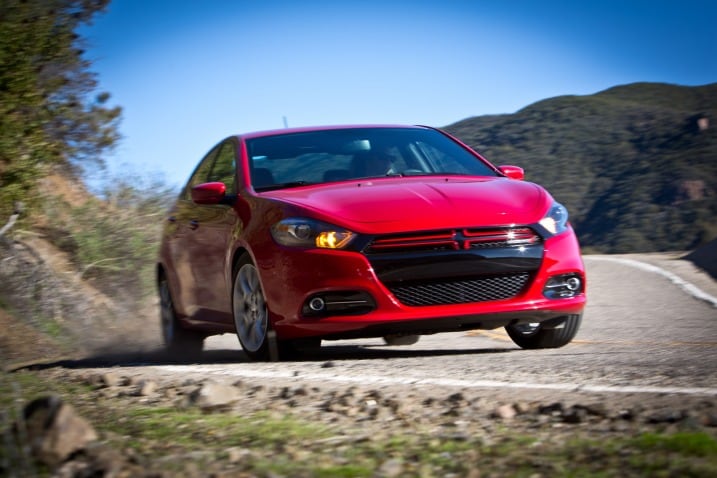
What do you want to know about?
- Introduction
- DDCT Transmission Is Substandard
- Track Test
- I Just Can't Get Comfortable
- Unnecessarily Complicated A/C Controls
- The Transmission Second Opinion
- Plenty of Utility for a Small Sedan
- Driver Seat
- Fuel Economy Update for January
- Mildly Useful Storage
- Rides Like a Big Car
- Best Navigation System in the Class?
- Slick Voice Control Interface
- Initial Annoyance Gives Way to Begrudging Acceptance
- Front Seat
- Easy Bluetooth Streaming Audio
- Not Your Traditional Owner's Manual
- A Look Underneath
- No Premium Gas Needed
- The Exhaust Note
- Redeeming Transmission Qualities
- The First (and Last) Road Trip
- Beware of Trunk Spikes
- Same Name. Why?
- Fuel Economy Update February
- Driver Seat Comfort
- Satelliteus Interruptus
- Questionable Build Quality
- Front Seat
- Door Locks and the Horn
- Audio System
- Hair Raiser
- Nice Audio Feature
- Deep Storage Cubby
- GPS Speed Limit
- Interior Measurements
- Wide Rear View
- Distinctive Exterior Styling
- Fuel Economy Update March
- Opinion on the Car's Handling
- I'd Wait For The GT
- 5,000 Miles Cleared
- Coldish or Warmish?
- 700-Mile Family Road Trip, Part One
- 700-Mile Family Road Trip, Part Two
- 2013 Dodge Dart: Dart Helps a Brother Out
- This Is How You Drive
- I Love You, Nav
- Dodge Dart Registry Wins Award for Best Social Media Campaign
- Sunroof Love
- No Cargo Net
- A/C Fail?
- Beats and Branding
- Fuel Economy Update for April
- Auto-Start Is Not Just for Cold Climates
- We Found a Vintage Dodge at a Nearby Museum
- Oil Change Due
- Small But Powerful Engine
- Range Anxiety
- Rear Visibility
- Lousy Backup Camera at Night
- 10,000 Miles and a Milkshake
- Looks Good in Rallye Trim
- Plug-In Preferences
- 10,000-Mile Service
- Fold-Down Rear Seat
- Fun to Drive
- Steering Wheel Tilt Range
- Fuel Economy Update for May- 2013 Dodge Dart SXT Rallye Long-Term Road Test
- Bringing Up the Rear
- Mysterious Windshield Crack
- Pack Lightly
- Clever Advertising
- Can You Tow It Behind a Motorhome?
- Engine Stall Recall
- Flimsy Door Handle
- Pop That Trunk
- How Much for Those Tires?
- Replacement Windshield AWOL
- These Sun Visors Have the Side Windows Covered
- Trunk versus Dog Food
- Finally, a New Windshield
- Fuel Economy Update for June
- Knuckle Sandwich
- Touchy Brakes
- New Windshield Makes a Better Door
- Shifter Noise
- Touchy Tire Monitor
- Tire Inflation
- Missing Fender Clip
- Overselling MPG
- Fuel Economy Update for July
- Flimsy Center Bin Latch
- Audio System Lists Song Composers
- I Don't Care If They're Fake
- Lighting With a Purpose
- Not an Open-and-Shut Case
- Fuel Economy Update for August
- Fussy Speedometer Graphics
- Short Gearing
- Secret Crumb Storage
- Tire Pressure Monitor Display
- Front Seats - Weird But Good
- Needs More Motor
- Good Interior Storage
- Taking the Good With the Bad
- Manual Shift Logic
- Real Fuel Costs
- Trunk Accessories
- Elevation Display
- Superbike Road Trip, Part One
- Fuel Economy Update for September
- Superbike Road Trip, Part Two
- Throttle Malfunction
- Audio Impressions
- 15,000 Miles
- Has a USB Cord Pass-Through
- Improvised Sun Visor
- Yep, You Can See Out Of It<
- Mostly Quiet on the Highway
- Respectable Moving Companion
- Easy To Check the Oil
- Fuel Economy Update for October
- Two Speedometers
- Laguna Blue Is a Factory Color
- Touchscreen Visibility
- 500-Mile Range
- Lonely Buttons
- This Angle Looks Good
- Updates for 2014
- Fuel Economy Update for November
- Impressions Nine Months Later
- Wants Oil
- Oil Change Service
- The Potential Is There
- Obvious Ambient Temp
- Fuel Economy Update for December
- Halfway to Nowhere
- Limping to the Bay
- Wrap-Up
Introduction
The compact sedan segment is one of the most important, yet often unexciting, segments in the automotive world. These sedans are rarely sexy, or fast, or desirable. Instead, they're popular for their ability to start every time and do their best to be as inoffensive and accommodating as vehicularly possible.
But what happens when the Italians get involved?
Such is the case with our newest long-term car, a 2013 Dodge Dart SXT Rallye. Dodge worked with new parent company Fiat to make its new small sedan a little more appealing than your average econobox.
It's (loosely) based off of an Alfa Romeo, looks like it was styled by someone with name-brand sunglasses and does its best to stand out from an otherwise anonymous crowd. It wins on the catwalk, but can it compete in the real world? We added a 2013 Dodge Dart Rallye to our long-term test fleet to find out.
What We Got
While not the cheapest compact sedan currently sold (that honor belongs to the $15,545 2013 Volkswagen Jetta), the Dart starts off at a totally reasonable price of $15,995. For your nearly $16 large you get the chassis from an Alfa Romeo Giulietta, stretched and pumped up for the American market with a base 2.0-liter four-cylinder kicking out 160 horsepower and a six-speed manual transmission. In base trim you also get 16-inch wheels, power windows and a four-speaker stereo with CD player and aux jack.
Our car is not the base model. We've got the midgrade SXT model, which includes 17-inch wheels (in lieu of the 16s), upgraded cloth seats, 60/40-split folding rear seat and upgraded IP. This model starts at $17,995 and feels well worth it. Further, our car is equipped with the Rallye package that adds foglamps, unique exterior/interior trim and a leather-wrapped steering wheel.
We also decided to ditch the standard 2.0-liter base engine in favor of a more modern, punchier, more fuel-efficient engine which in the Dart comes in the form of the turbocharged 1.4-liter MultiAir engine. This engine produces the same 160 hp as the base motor, but twists out 184 pound-feet of torque (a 40 lb-ft increase) and, with the six-speed dry-clutch automatic manual (an $1,100 option) returns 3 mpg more for a final EPA rating of 27/37 and 31 mpg combined. The 1.4 took away 0.6 liter of displacement and increased the cost by $1,300.
Our 2013 Dodge Dart is also equipped with a $495 UConnect system that includes an 8.4-inch touchscreen. We also got a $495 Alpine stereo, satellite radio ($195), sunroof ($895) and the cool "racetrack" rear lights ($225). Finally, we added the $295 Popular Equipment Group, which comes with remote start, a tire pressure monitoring display, front seatback pockets, overhead console, 12-volt aux outlet in the center console and illuminated cupholders and vanity mirrors.
With a total price of $25,385, it's obvious that we strayed a ways from its affordable starting price, but this array of options will let us test nearly every function offered by Dodge.
Why We Got It
The 2013 Dodge Dart represents a fundamental shift in Dodge's small car philosophy: It's designed to be good.
Not only has Dodge focused an extreme amount of time and energy in its latest bid to build a small car for retail sales and not rental fleets, but this car is one of the first products out of the new Chrysler Group to make extensive use of its new Italian ties.
In our first Dodge Dart road test back in June we said that it "may be a little late to the compact sedan party, but it just gave the segment a second wind."
Will that wind fill our sails for the next 12 months and 20,000 miles, or will the 1.4 run out of air when we have to live with it day-in and day-out? Follow along on our Long-Term Road Test page to keep up on our new Dodge Dart.
Current Odometer: 1,184
Best Fuel Economy: 30.0
Worst Fuel Economy: 24.8
Average Fuel Economy (over the life of the vehicle): 26.6
The manufacturer provided Edmunds this vehicle for the purposes of evaluation.
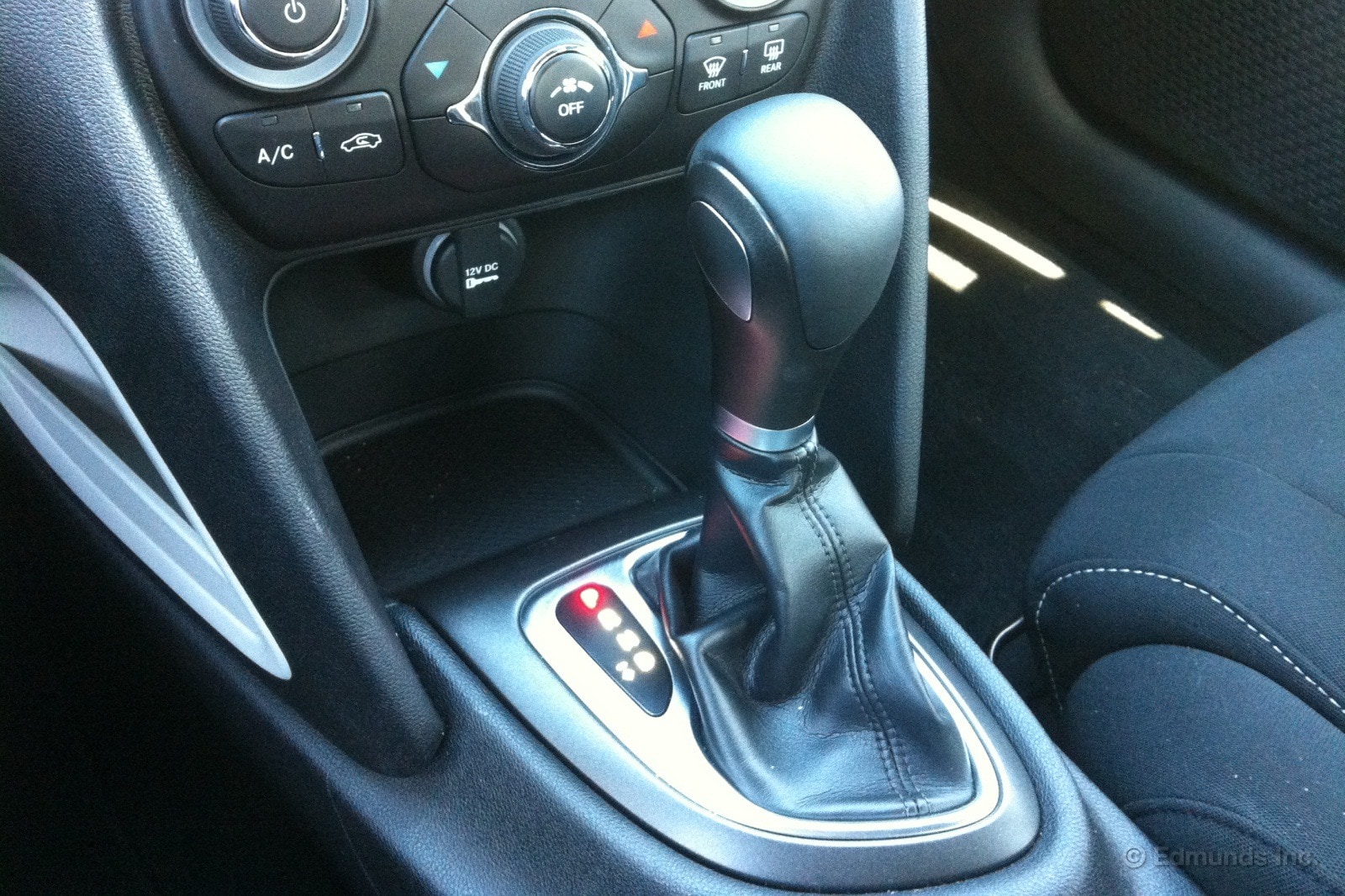
Our long-term 2013 Dodge Dart is equipped with the optional automated manual transmission. Chrysler calls it DDCT (Dual Dry Clutch Transmission). It is the sole gearbox available with the 1.4-liter turbo engine other than the row-it-yourself manual. And it is...how do you say...not good.
It's down to its molasses-slow (albeit very smooth) shifts and an easily-confused calibration. Go ahead, DDCT, complete that gear change. Aaaany time you're ready. It's not quite Smart ForTwo bad, but it's bad. If you floor the gas, you're waiting a good couple of one-thousands until it finally realizes "oh, you wanted to go?" and goes on safari to hunt down a suitable cog. And it gets tripped up easily in conditions that involve slowing down and then briskly speeding back up.
Taking matters into your own hands by slotting the lever into manual mode doesn't solve it, either. Too slow to respond to commanded shifts, and then you still have those belabored gear-change speeds.
It is unfortunate that the gearbox tends to overshadow the things the Dart does well. I am fairly certain you'll be hearing many DDCT-related gripes in the ensuing months.
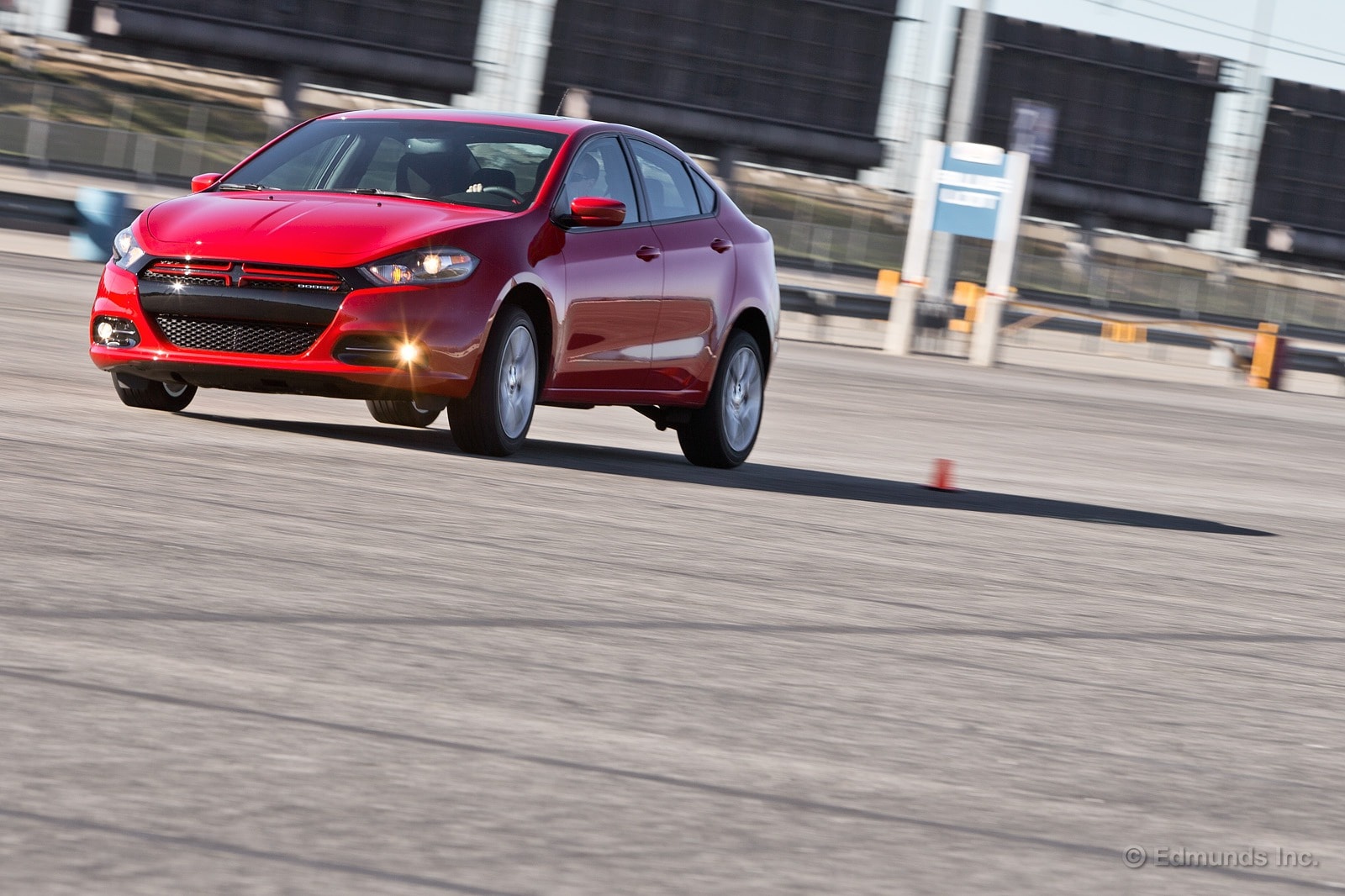
Our long-term 2013 Dodge Dart has the optional, $1,300 1.4-liter turbocharged four-cylinder that makes 160 horsepower and 184 pound-feet of torque paired with a six-speed dual-clutch automated manual transmission.
While we're still exploring how this combination handles the rigors of day-to-day use, we don't have to wait any longer to see how it performs on the track.
Track Test: 2013 Dodge Dart SXT Rallye
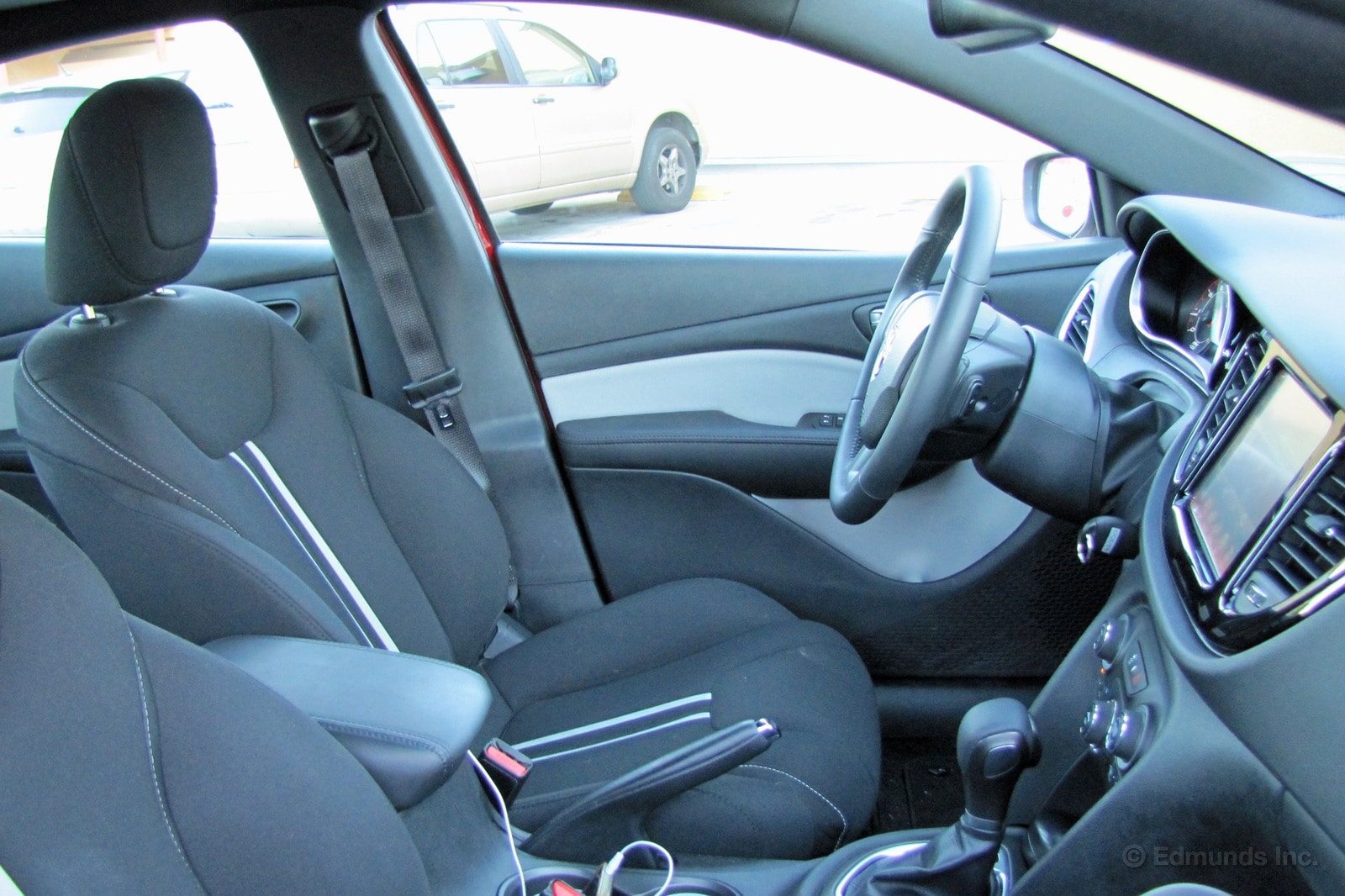
I just can't get comfortable in our new long-term Dodge Dart. The first problem is the driving position. Our car's six-way manual, height-adjustable driver seat is mounted too high, or rather, it does not go low enough. I cannot push the seat down far enough, which would not only grant my long legs sufficient room, but also extricate my noggin from its current location of 2 cm from the roof.
However, even if the seat could in fact go down more, the steering wheel's positioning would remain an issue. Actually, it would be worse since even when I'm perched atop Mount Dart, the wheel doesn't tilt low enough.
Then there's the seat itself.
See the area above the side bolsters? The outer areas bubble forward and push into my shoulder blades. They drove me nuts on the first drive event for the Dart and they still do today. As such, I end up either hunched over while driving like my Aunt Dianne or setting the seat back to the full Fat Joe (lean back). The latter just brings me back to the steering wheel issue.
I realize at 6-foot-3, not every vehicle is going to fit me like a glove. However, the seats in the Focus, Elantra and Cruze adjust to suit me far better and aren't uncomfortable, either.
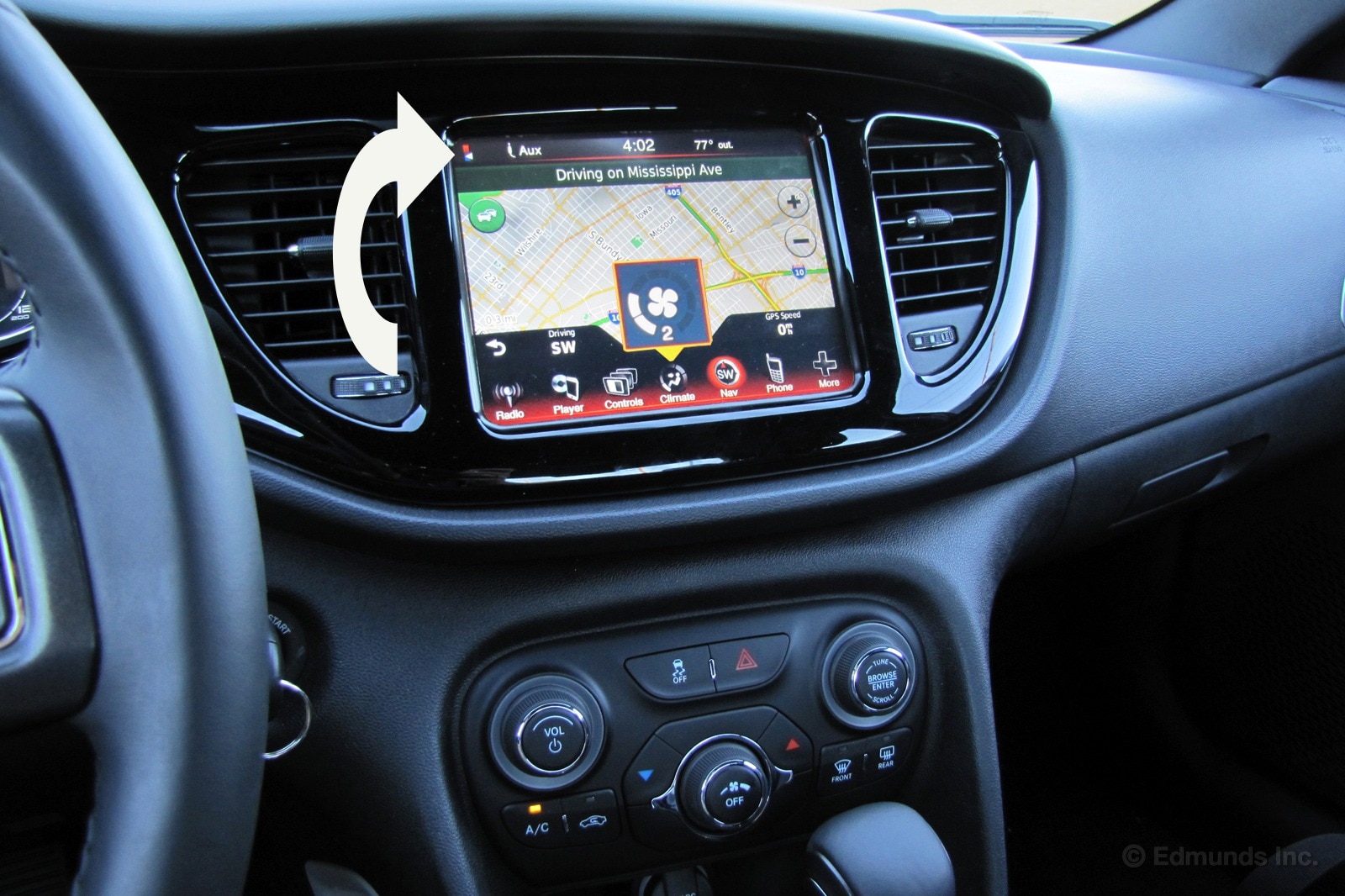
When I drove the Dodge Dart on its national press launch last year, the vehicle in question featured the dual-zone automated climate control that features physical buttons with the read-out included within the large master screen. The system worked and although I suppose the separate display in the Ford Focus is superior, I was OK with it.
Our long-term Dart has manual controls paired to that same large screen, and I'm not OK with them.
Dodge simply removed three buttons (auto, passenger cold/hot) from the automatic system to create the manual one and called it a day. When you want to increase the A/C or heat you must repeatedly press either the cold or hot buttons, which is more annoying and less convenient than simply turning a knob. To know your current hot/cold setting, there is a tiny icon in the upper left portion of the large screen (indicated by arrow), which gets bigger when you press the hot/cold button.
To increase fan speed, turn the fan knob, which brings up an icon into the middle of the large screen (pictured). It then disappears, which means you only know what your fan speed is when you're changing it. If you want to change air flow direction, you have to press the climate button on the screen and then the Mode Man icon you desire.
Needless to say, this is an unnecessarily complicated solution to manual climate controls. However, you will note that I said our Dart has the manual controls paired to the large central screen. There is in fact a third option. Should you get a base Dart with the more conventional audio head unit (which looks like a Crown Victoria-inspired afterthought), the manual climate controls are of a more basic and more sensible three-knob design. They would almost certainly work better and Dodge should seriously consider making these the standard manual A/C control interface.

Flummoxed. That's the best word to describe our Dodge Dart's dual-clutch automated manual transmission, because I'm not sure if it realizes what it's actually supposed to do. "I know I have gears and there's an engine bolted to me, but what is my goal here again?"
Jay Kavanagh already described quite well this transmission's issues. In short, it's slow to respond, gets caught in the wrong gear and exhibits some downright strange behavior. At one point when stuck in traffic Friday, the tach was racing at 4,000 rpm and the engine was growling in its unflattering dieselesque tone, and yet there was absolutely no semblance of forward motion as a result. It was like I had the clutch pedal in.
These aren't the same complaints levied against the Ford or VW dual-clutch transmissions. Those are mostly a matter of an automated manual transmission behaving differently than a traditional automatic. Things like creeping into a parking spot or movement on a hill. You may get used to it, you may end up deciding you don't like it, but you probably won't be left wondering, "what's wrong with this thing?"
Now, as Jay said, it's not quite as bad as single-clutch automanuals and I'm quite certain it puts the power down better in a simple gun-it acceleration run than a torque converter automatic would. However, there are problems here, and the news today that Dodge is planning a nine-speed automatic for the Dart sounds like its replacement could be on the way.
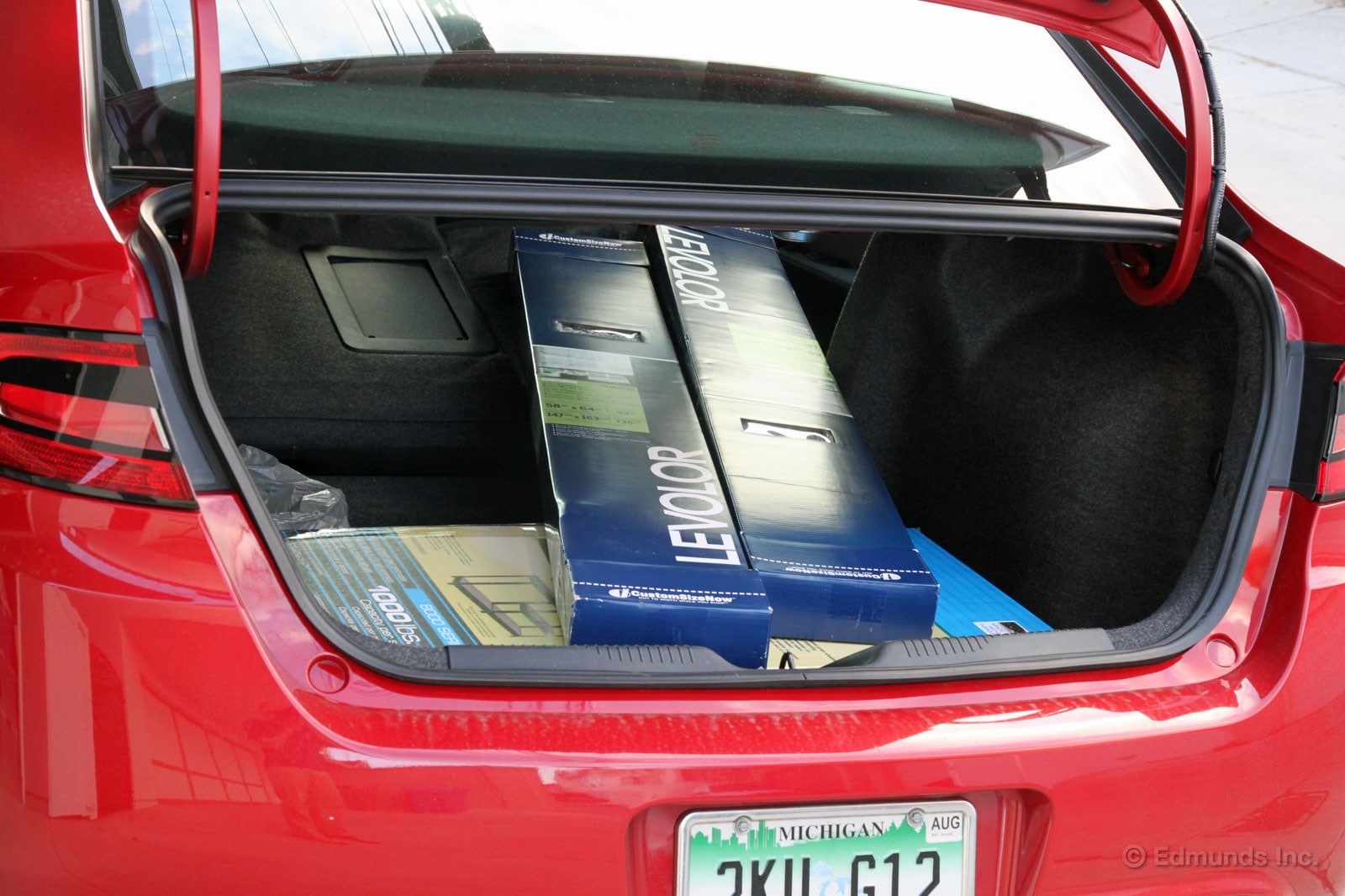
Enough about the transmission already, let's talk about the Dart's trunk shall we? What could be more exciting than the trunk of a compact sedan?
In this case, there's plenty to talk about. For one, the Dart's rear seats fold down, so when you have to carry something awkward home it's not a problem at all. These boxes for new blinds were just under five-feet long and they fit easily. They might have even fit horizontally in the trunk, but I had a storage rack box already taking up space there.
The seats themselves are easy to fold. There's no latch, just a cloth loop on each side that you pull to get them down. The headrests do rub the front seats, though, so it might require a trip up front to make enough room.
Getting things in and out of the trunk is fairly easy given the wide opening and modest liftover. If there's one thing to pan it's the hinges. They arc down into the cargo space, but I did notice that they hug the sides of the space close enough that you're not likely to put anything in their path anyway. Overall, it's a nice setup for a small sedan, one that will rarely leave you needing additional room unless you're taking home something really big, in which case you might as well just borrow a bigger vehicle anyway.
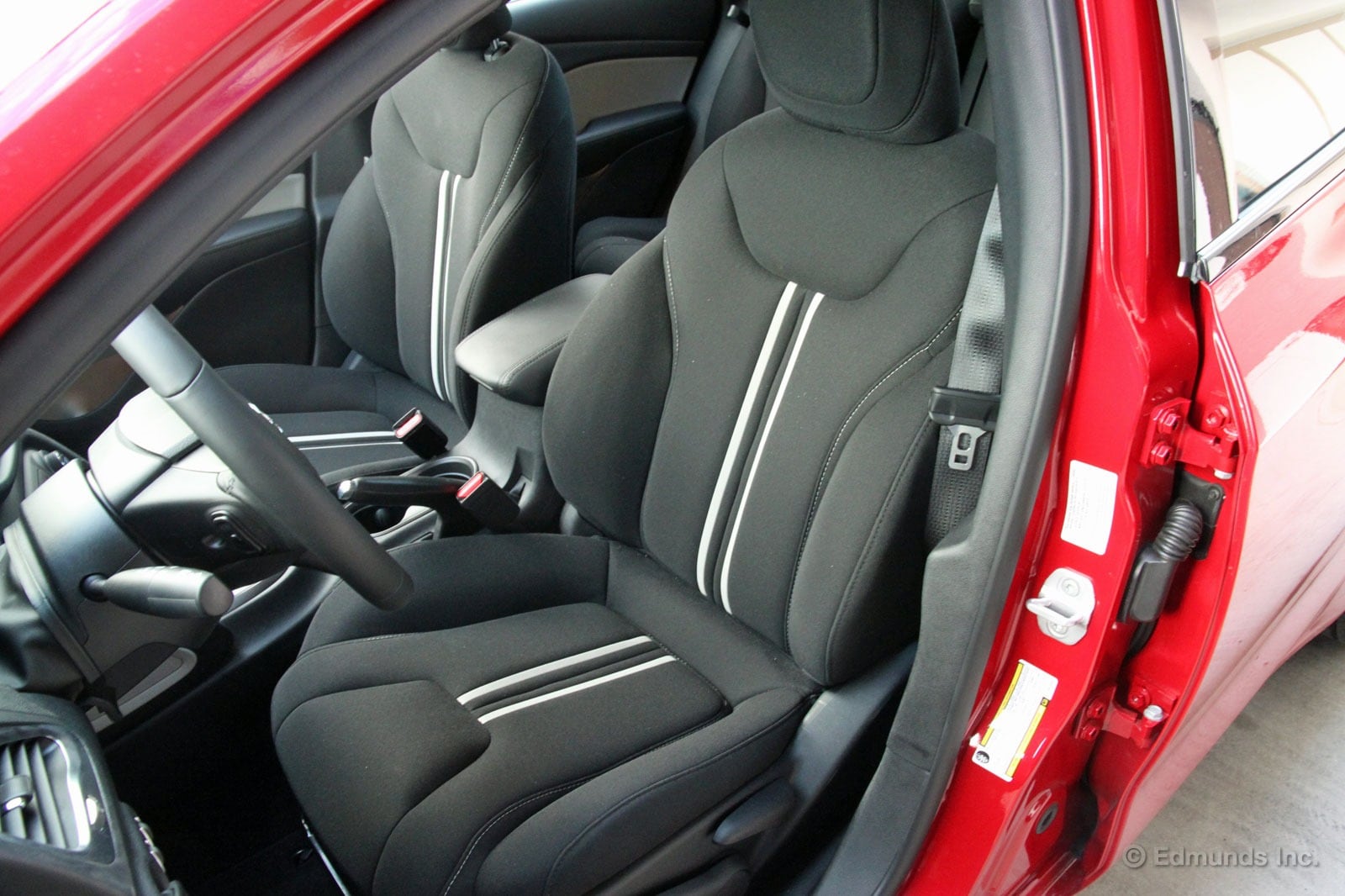
With their spongy feel and basic trim, the seats in our Dart don't look, or feel, like much at first. In fact, fellow editor James Riswick doesn't think much of them all.
Oddly enough, although I'm about as tall as James, I don't find the seat in the Dart uncomfortable at all. And this is after driving the Dart for consecutive days that had me in and out of the car on and off for hundreds of miles.
The cloth-covered seats are definitely not what you would call firmly contoured. Sure, there are noticeable side bolsters, but they're not the kind you lean on through corners. No, this is more of what I would call a "universal" seat, one that trades precise support for general comfort. It's a tricky line to walk, but these manually adjustable seats do a good job of providing support without needing to be in the "perfect" position. I might change my mind after a longer trip in the Dart, but so far I don't mind these seats at all.
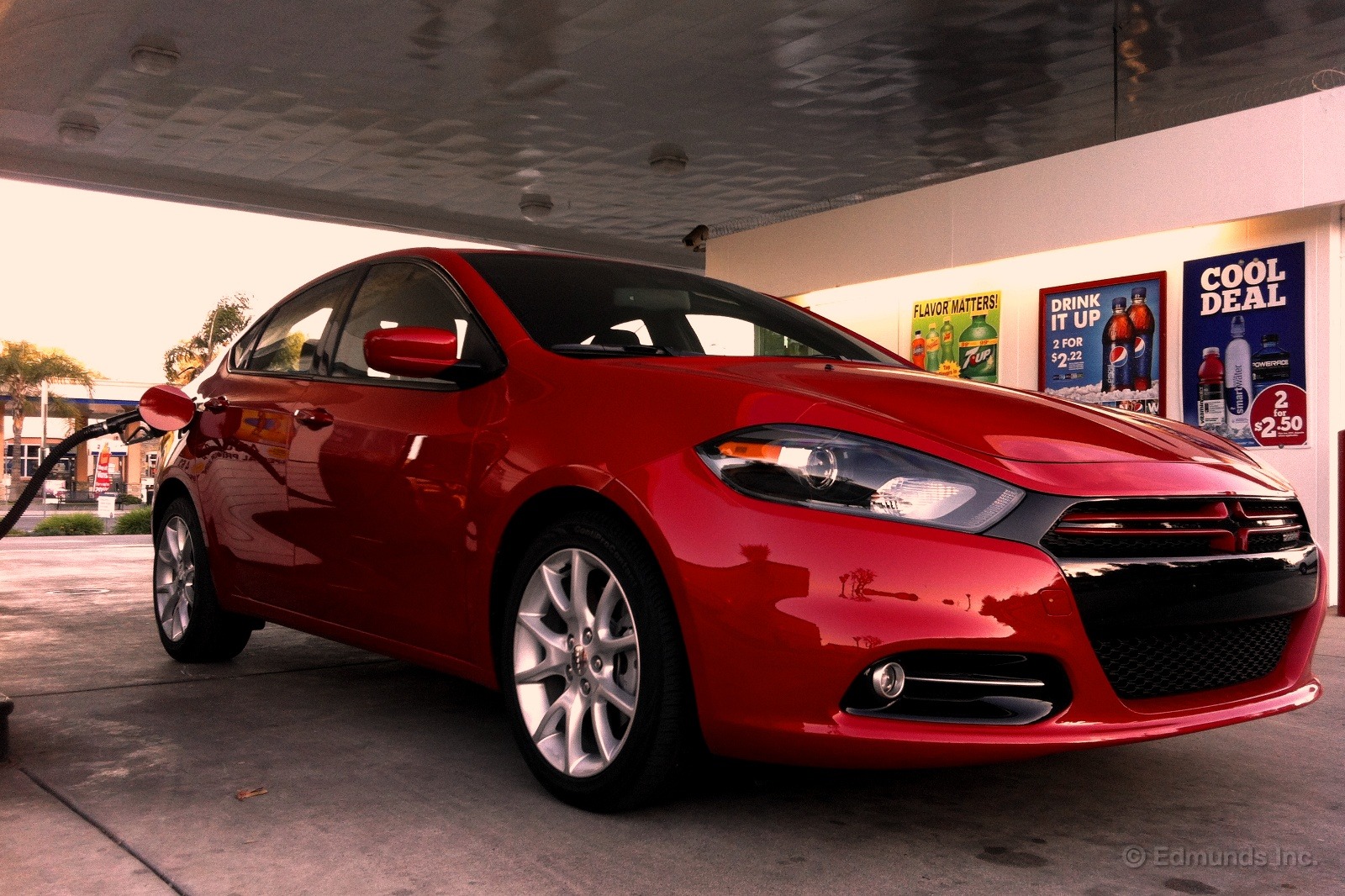
After our first month of mixed driving in our brand new 2013 Dodge Dart SXT, one fill-up occurred after a mere 67 miles and the longest came after 368 miles. After 2,400 trouble-free miles, the preliminary fuel economy verdict is in. Where the EPA officially rates our particular Dodge Dart with the optional 1.4-liter turbocharged four-cylinder engine at 27 mpg City, 37 mpg Highway, and 31 mpg Combined, our lead-footed staff achieved disappointing results.
With an average 26.2 mpg, we're 5 mpg shy of the EPA's combined estimate? That's not a good sign. Maybe our staff are still in the "Let's see what this thing's got" stage. Maybe the much-maligned DDCT automated-manual transmission is so frustrating that elicits aggressive throttle use (heh-heh).
Whatever the case, it's also interesting that the EPA's figures were the result of using premium fuel (that's 91 octane here in Santa Monica, CA), and the majority of our refueling was with 87 octane gasoline. The blank fuel door isn't explicit about the type of gasoline that should be used, but the owner's manual reads "87 octane acceptable" and "91 octane recommended." Stay tuned for more fuel updates in the coming months.
Worst Fill MPG: 20.7
Best Fill MPG: 30.3
Average Lifetime MPG: 26.2
EPA MPG Rating (City/Highway/Combined): 27/37/31
Best Range: 368 miles
Current Odometer: 2,435 miles
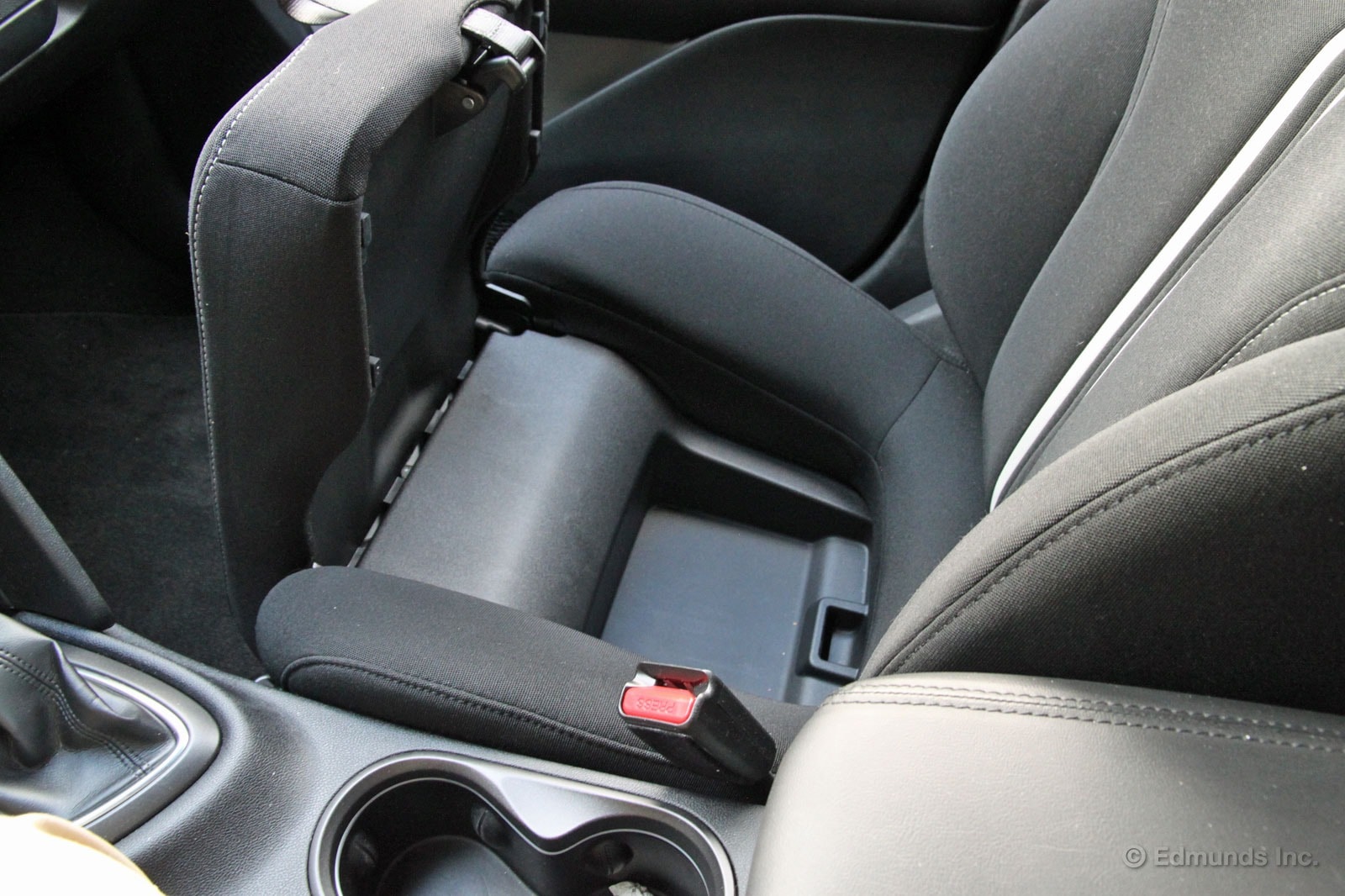
There are plenty of ideas that look good on paper, but then fail to deliver much in the flesh. The Dart's underseat storage bin might be one of those ideas.
I say "might" because I have yet to find a use for the hidden compartment under the front passenger seat compartment. That doesn't mean it's useless, but I'm struggling to figure out what it's good for.
Given its location, the hidden compartment seems like a good place to put something you want out of sight. Seems logical enough, but if I have something truly valuable like a wallet or phone that I want to leave behind I would rather put it in the locked glove box. The storage bin might be bigger, but not by much.
There's also the odd issue of getting to whatever you put in there. You pretty much have to be driving by yourself since you're not going to want to ask your passenger to get out of the car so you can retrieve your wallet.
Thankfully, we have this car for a while, so a practical use might reveal itself in the months ahead. For now, however, it's an interesting idea without a practical purpose.

It's no understatement to call our long-term 2013 Dodge Dart SXT Rallye a big car for its class. Among economy sedans, it's the longest (183.9 inches) and widest (72.0 inches), even if its wheelbase (106.4 inches) is right in line with the Hyundai Elantra and Nissan Sentra.
After commuting to work in the Dart for the better part of a week, I think it lives up to that big footprint. Specifically, it rides like the small midsize car that is and feels substantial going down the road, something Dan noted in our first drive and Jay in our full test of a conventional manual-shift SXT Rallye.
Together, the suspension calibration and 225/45R17 Continental all-season tires strike a good balance between compliance and control. The Dart soaks up impacts neatly without resorting to the floatiness you get in some competitors. At the same time, it rarely crashes over ruts and it copes with the rain-grooved/washboard sections of the I-405 freeway without feeling busy. It reminds me a bit of our long-term Chevy Cruze in this regard, and I prefer it to our Subaru Impreza.
Along with that, the Dart's cabin stays quiet over most pavement, which makes it easier to enjoy my commute. Honestly, there are now several cars in the economy sedan class that offer a serene ride, but it's nice to see Dodge paying attention to this detail because the Neon and Caliber were noisy and unpleasant on the highway. Actually, the second-generation Neon had a pretty nice ride quality by the standards of the year 2000, but it had so many other problems (a three-speed automatic transmission, cheap interior materials and the list went on) that this virtue easily got lost.
The Dart has its own challenges, of course, but happily, ride quality is not one of them.
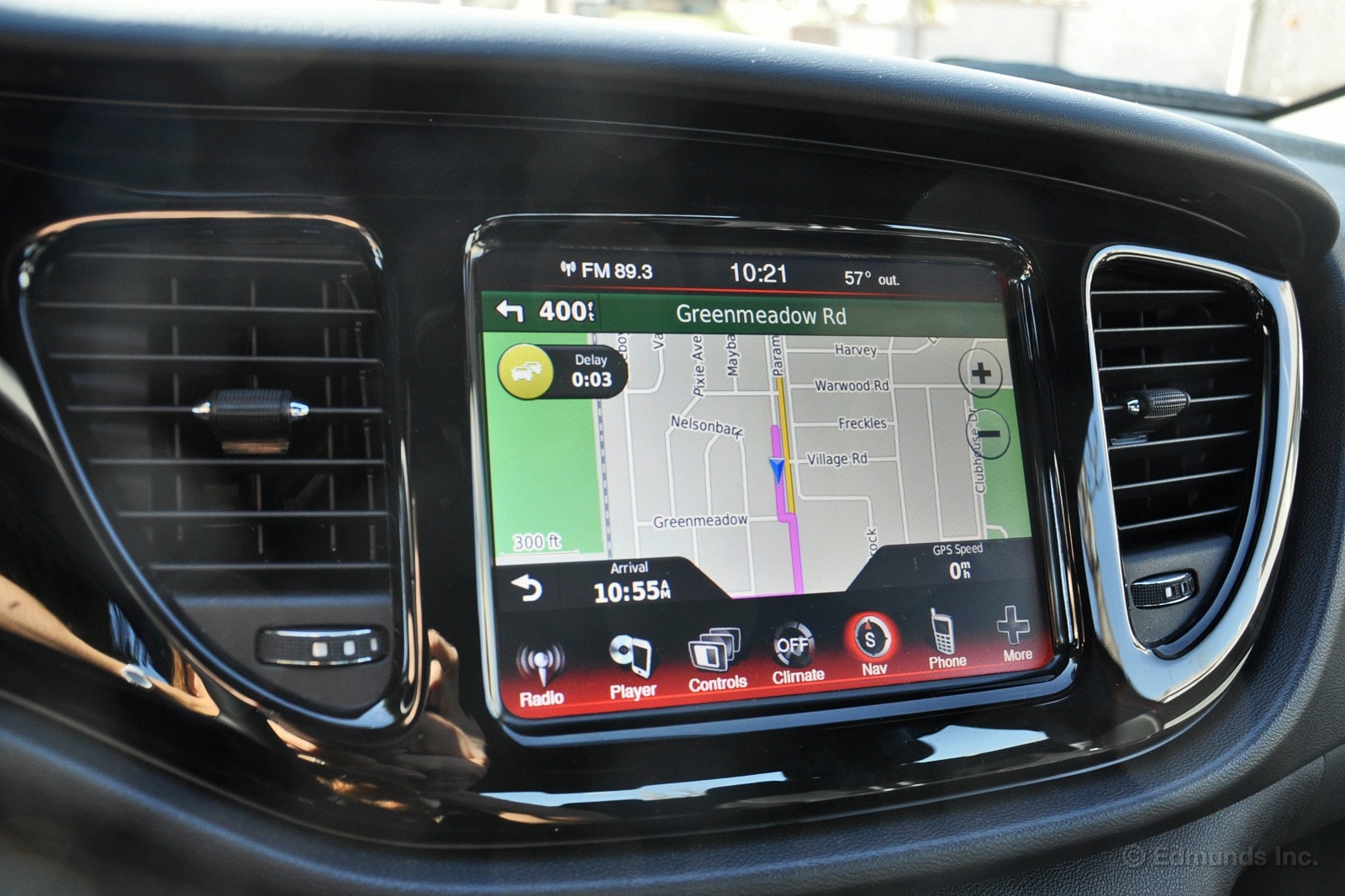
I'm not sure where a factory navigation system falls in the order of priorities for real-life economy sedan buyers, but the system in our long-term 2013 Dodge Dart SXT Rallye is excellent.
The interface is a large, high-resolution, 7-inch touchscreen, and it integrates various different functions, including navigation, audio, phone, climate and myriad settings. As James mentioned, the integration of the climate controls is a little clumsy (especially since it's just single-zone, manual A/C), but the nav and phone features work really well.
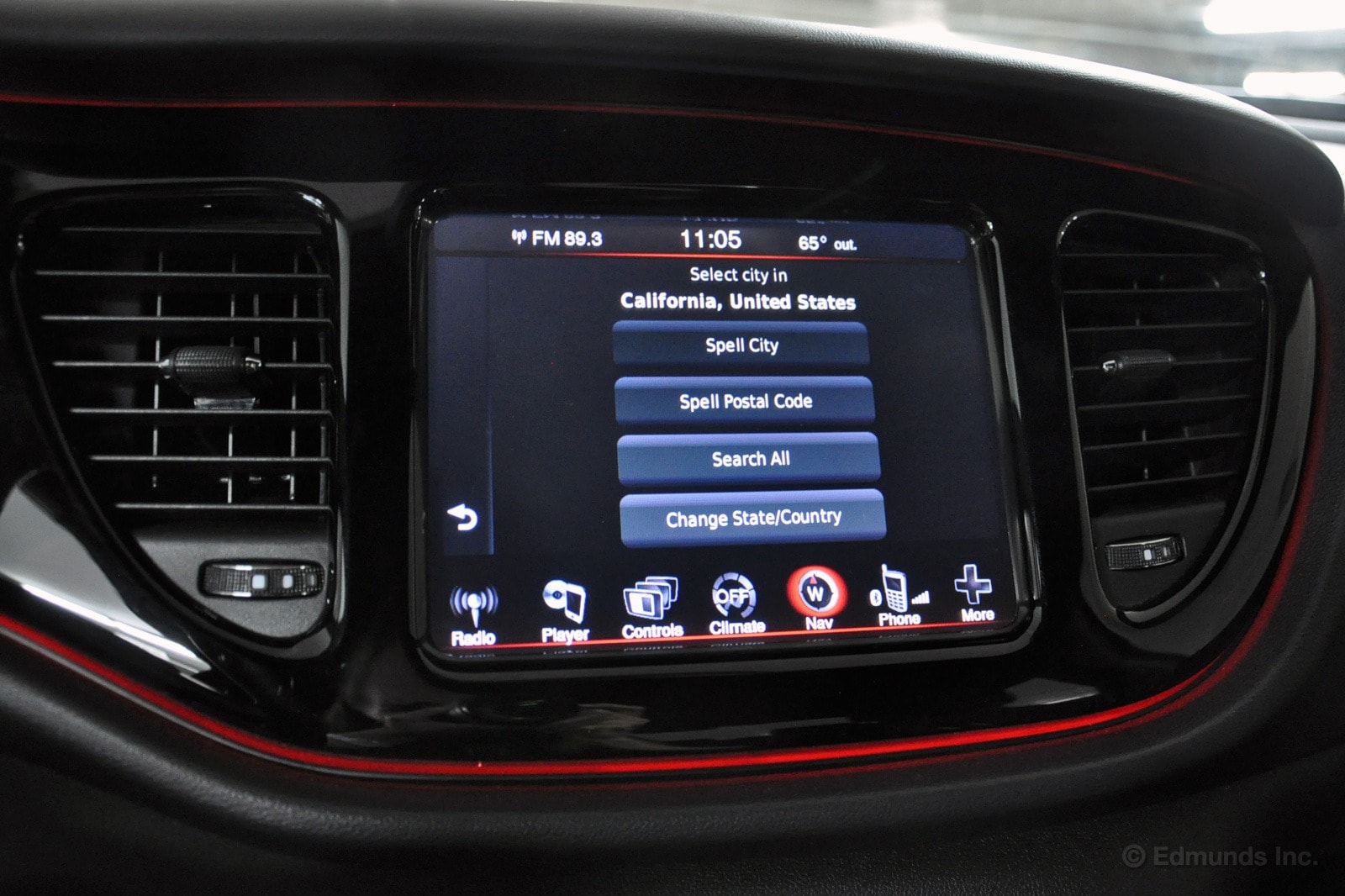
To start, this screen has large on-screen buttons and they exhibit appropriate sensitivity to human touch, unlike the interfaces in our Ford Focus ST and Subaru Impreza.
Processing speed is lightning-quick for a nav system in a budget car. Keying in addresses takes very little time, and then the system is quick to calculate a route to your destination. I'm averaging about 30 seconds from address entry to the start of voice guidance, which feels quicker than every other nav-equipped car in our fleet (hey, there's a story idea: I should put a stopwatch on myself as I enter the same address in every long-term car with a nav system). It really helps that the system defaults to a QWERTY keyboard and that numbers (for entering a zip code instead of a city, or a street name with numbers in it) are on the same screen so you don't have to toggle back and forth.

Once you're en route to your destination, the Dart's nav zooms in when it's logical to do so, showing you which lane you need to be in, where to turn, etc. Plenty of other systems auto-zoom when providing guidance, but oftentimes, especially in this price range, their behavior is inconsistent. More importantly, when you deviate from the selected route, the Dodge's system is quick to recalculate and doesn't keep insisting that you make a U-turn.
The map graphics are obviously by Garmin and slightly cartoony as a result, but this doesn't bother me in a $25,000 vehicle, especially since the maps are otherwise clear, colorful, well labeled and easy to read.
For me, the only other factory navigation system in this class that comes close for screen size, resolution and overall functionality is the one in the Hyundai Elantra. Perhaps it's time for a cabin electronics comparison test.
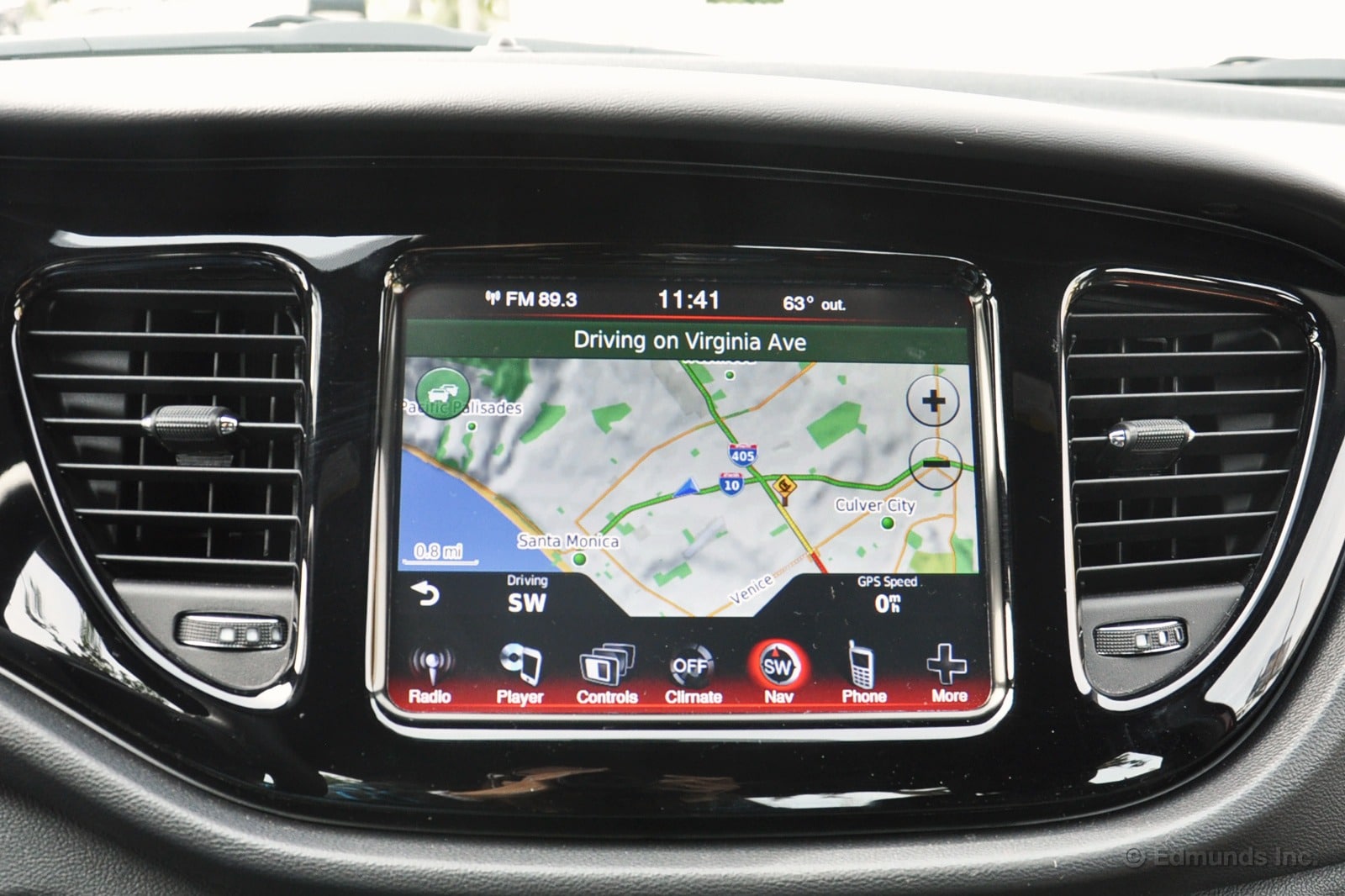
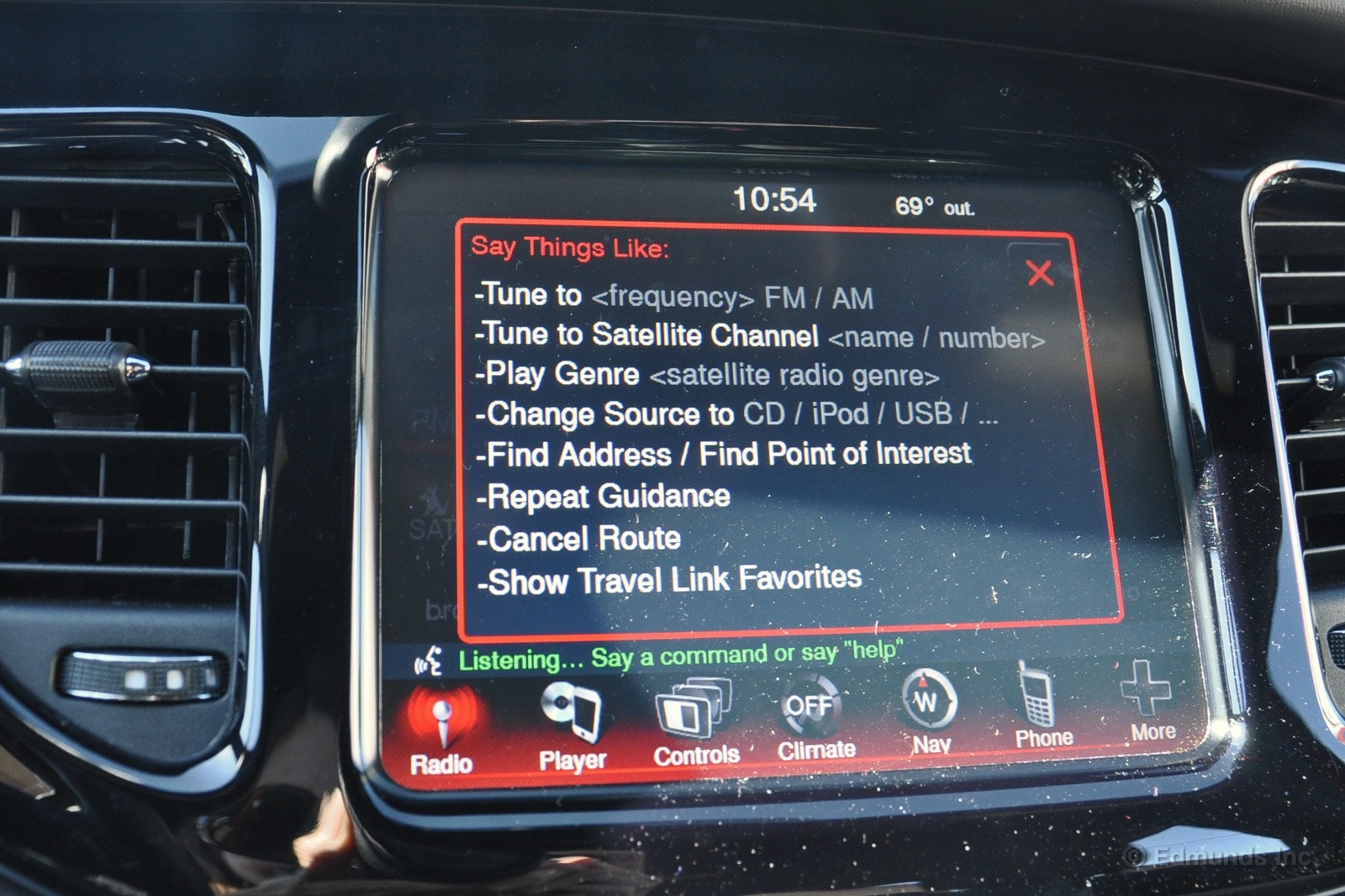
I already told you how much I like the navigation system in our long-term 2013 Dodge Dart SXT Rallye. In sum, the interface is simple, it processes requests quickly and the graphics are sharp with good street labeling. Well, since then I've used the voice control interface and it's equally excellent, so much so that I plan to make to make regular use of it.
Here's what makes it so good: You press the voice control button on the steering wheel, say "find address" and then it directs you to enter the entire address, yes, house number, street, city and state, all at once. That's right, you say the whole address just as you would if you were talking to a real person.
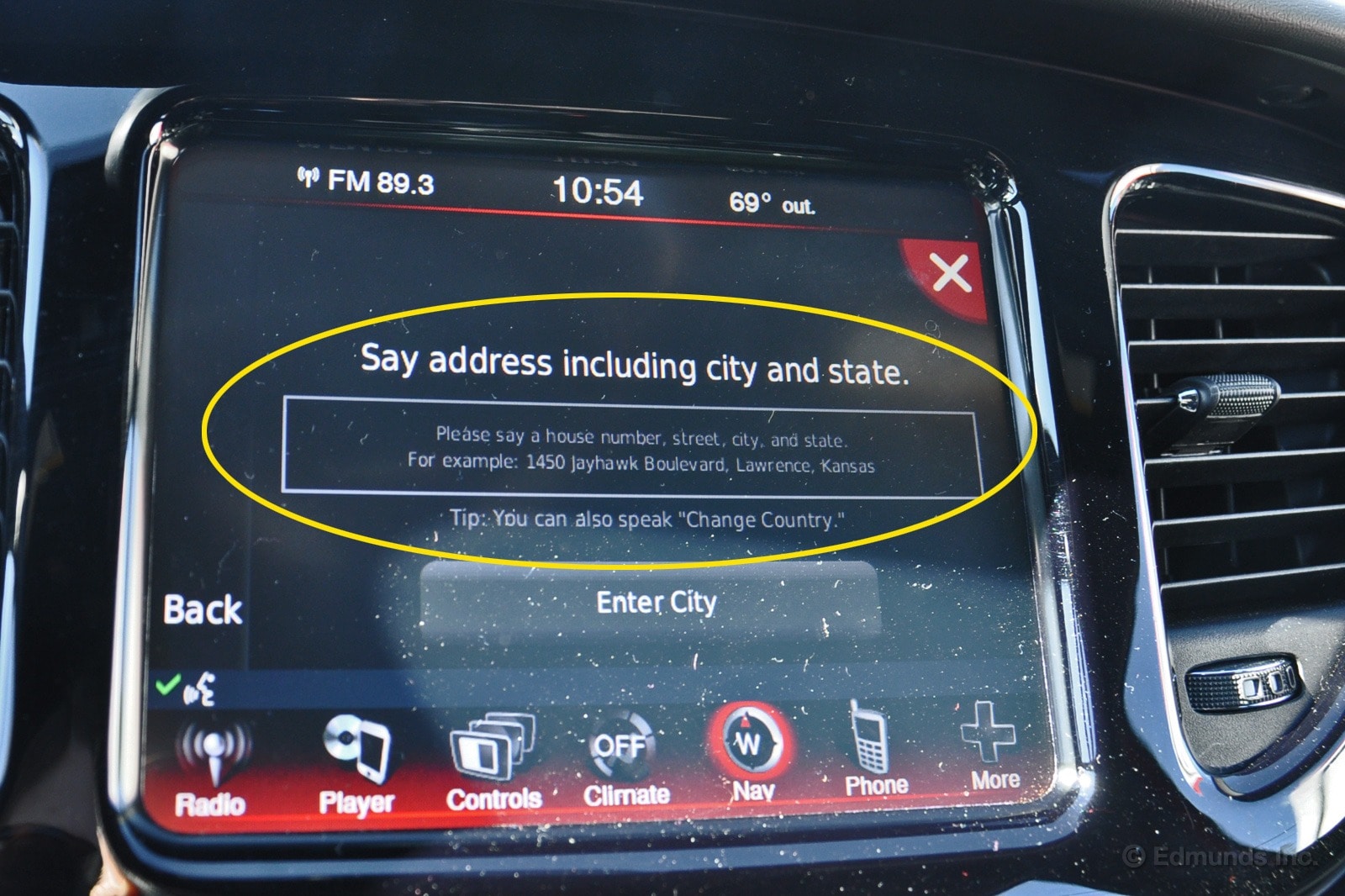
It quickly brings up a list of possibilities on the Dart's 7-inch touchscreen for what you said, and for both of the addresses I looked up, the correct address was at the top of the list. Actually, I didn't even have to look at the list, because the system also read the address back to me and asked me if that was correct.
Once it gets a yes, it finds the address on the map and then asks you if you want directions to that location. Give it another audible yes or press the "Yes!" button on the screen and you're in business.
Usually, entering addresses by voice with a factory navigation system is slow, slow, slow, because you have to enter each part of the address separately and, quite often, the speech recognition technology isn't that sophisticated so you have to fuss with choosing line numbers or repeating what you just said. The Dart's voice control system has neither of those flaws and actually offers added convenience, rather than just a last-resort workaround when a system locks out address entry on the fly.
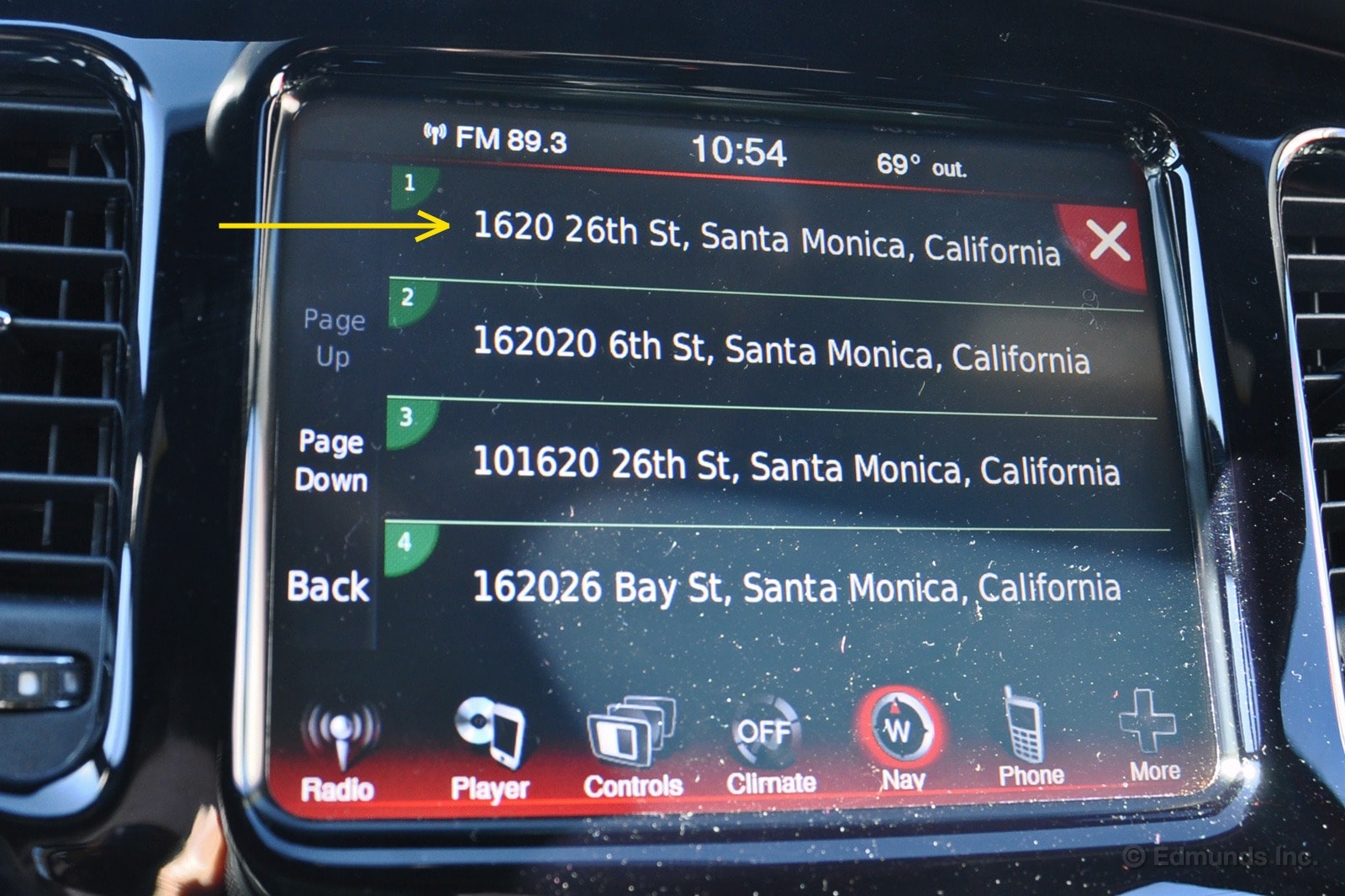
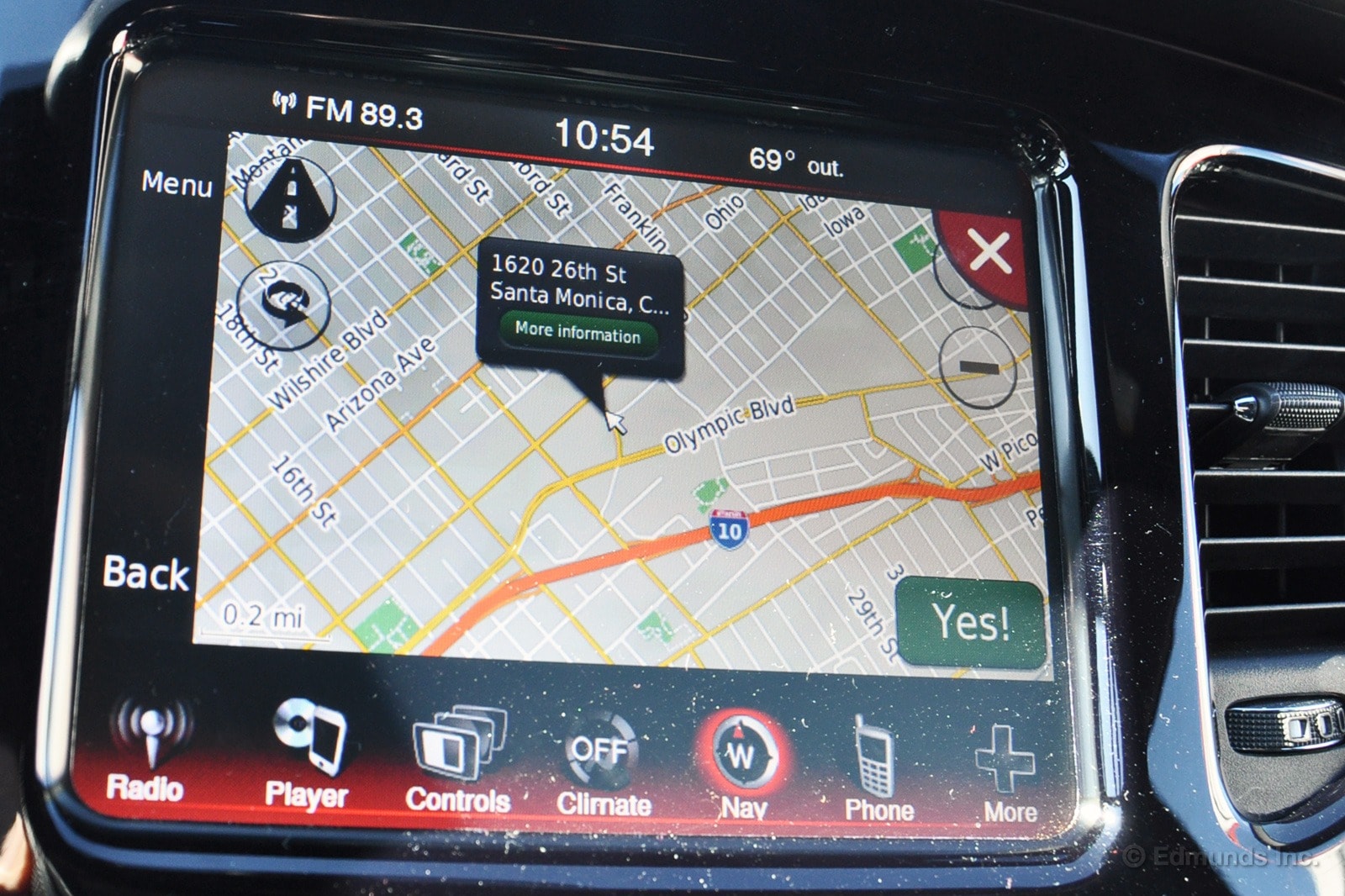
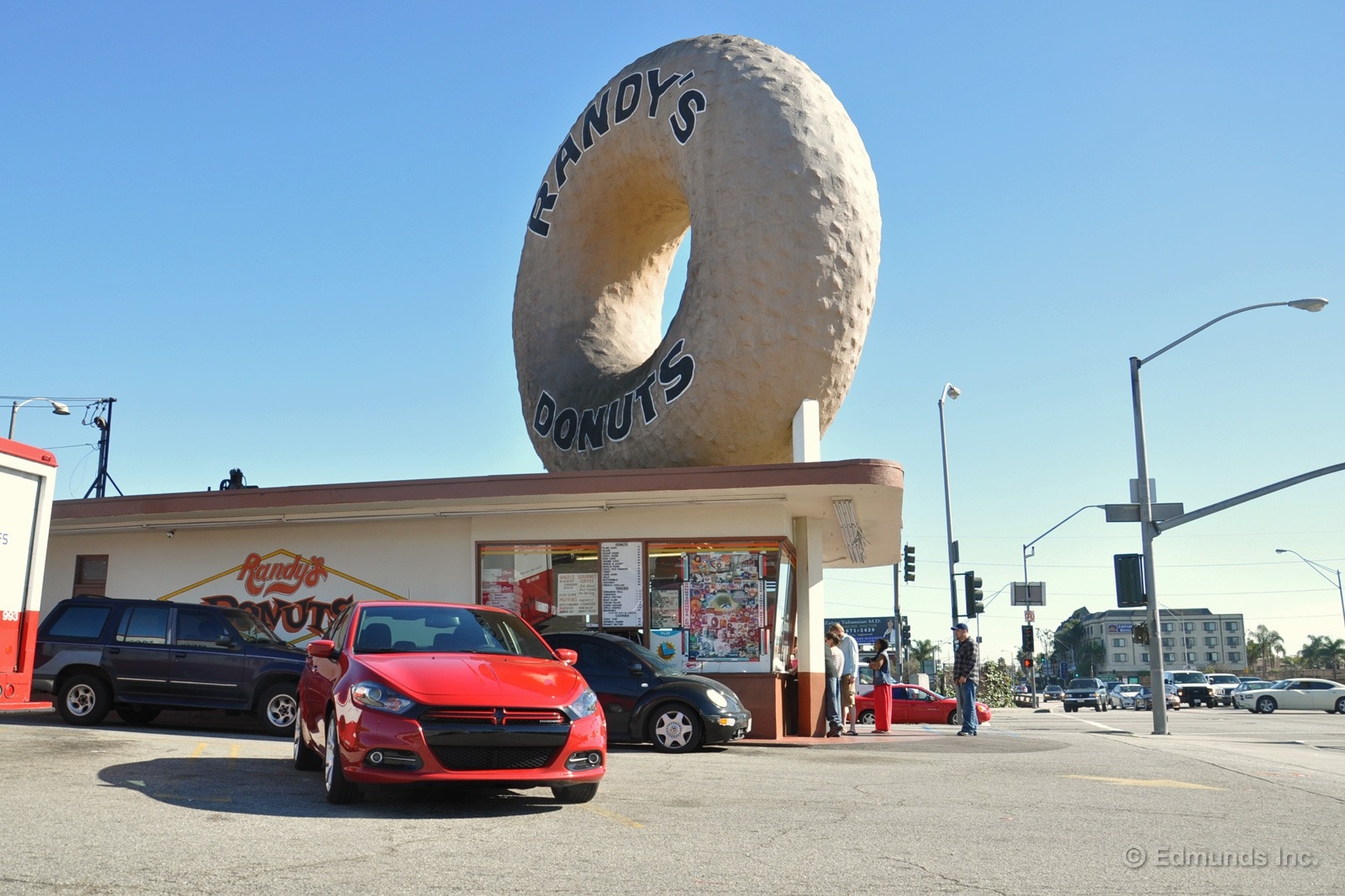
After my first night in our long-term 2013 Dodge Dart SXT Rallye, which combines Fiat's turbocharged 1.4-liter four-cylinder with a six-speed dual-clutch automated manual transmission, I had the same reaction as Jay and James. This transmission simply doesn't feel well calibrated to the engine. This small-displacement turbocharged engine needs revs to make decent power. But between the transmission's early upshifts and slow gear changes, it's hard to stay in the power in cutthroat commuter traffic.
At least, that's how I felt after one day in the Dart. Now four days on, I feel like I've made peace with the drivetrain's peculiarities and, overall, the experience isn't any worse than a commute in our CVT-equipped Subaru Impreza. Honestly, once you're up to 70 mph, the Dart feels better than our Impreza, because its engine has more mid-range torque, so once you coax the transmission into the right gear, executing a passing maneuver is pretty much turnkey.
That said, when commuting, I am almost always feathering the gas pedal in our Dart, especially in stop-and-go traffic. This approach would likely annoy passengers (I haven't had any yet), but steady throttle doesn't work for me in this car. See, if the transmission gets any inkling that you're not trying to accelerate anymore, it upshifts. And then, the next time you need to catch a hole in traffic, you've got nothing, and other drivers smell weakness and close that hole right up.
This might sound like a totally unrelaxing way to spend a commute, but frankly, knowing that I'm keeping the power available when I need it improves my disposition. I just pretend I'm patting a small terrier to keep it from panicking and hiding under the bed.
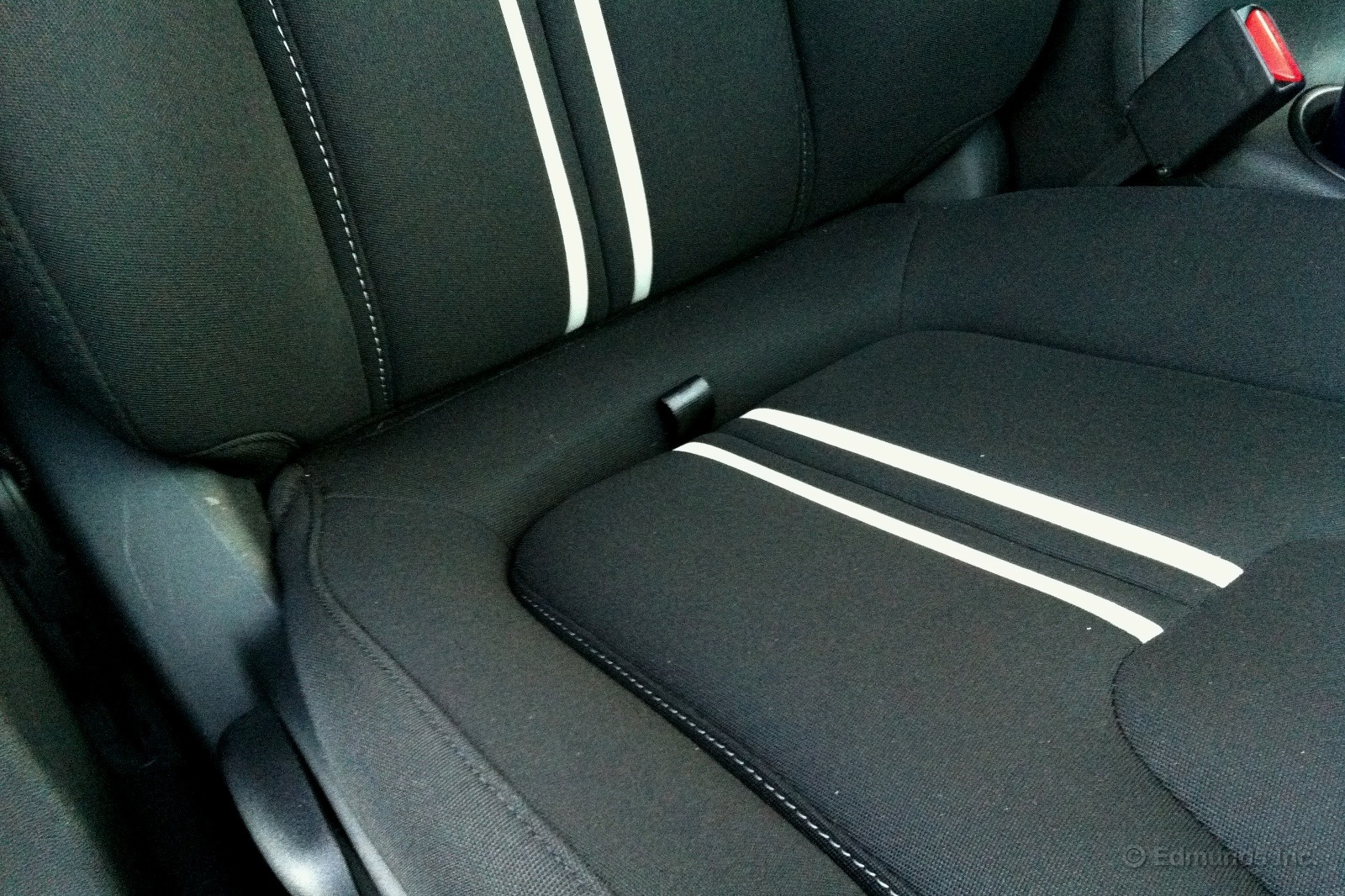
A few days ago, I noticed that little tab sticking out of the front passenger seat and wondered what it's intended to do. So I tugged on it and found an odd little storage compartment. The owner's manual says nothing of its intended use, just that "some models may be equipped with storage under the front passenger seat cushion. Pull upward on the seat tether to open the storage compartment."
I found a use for it.
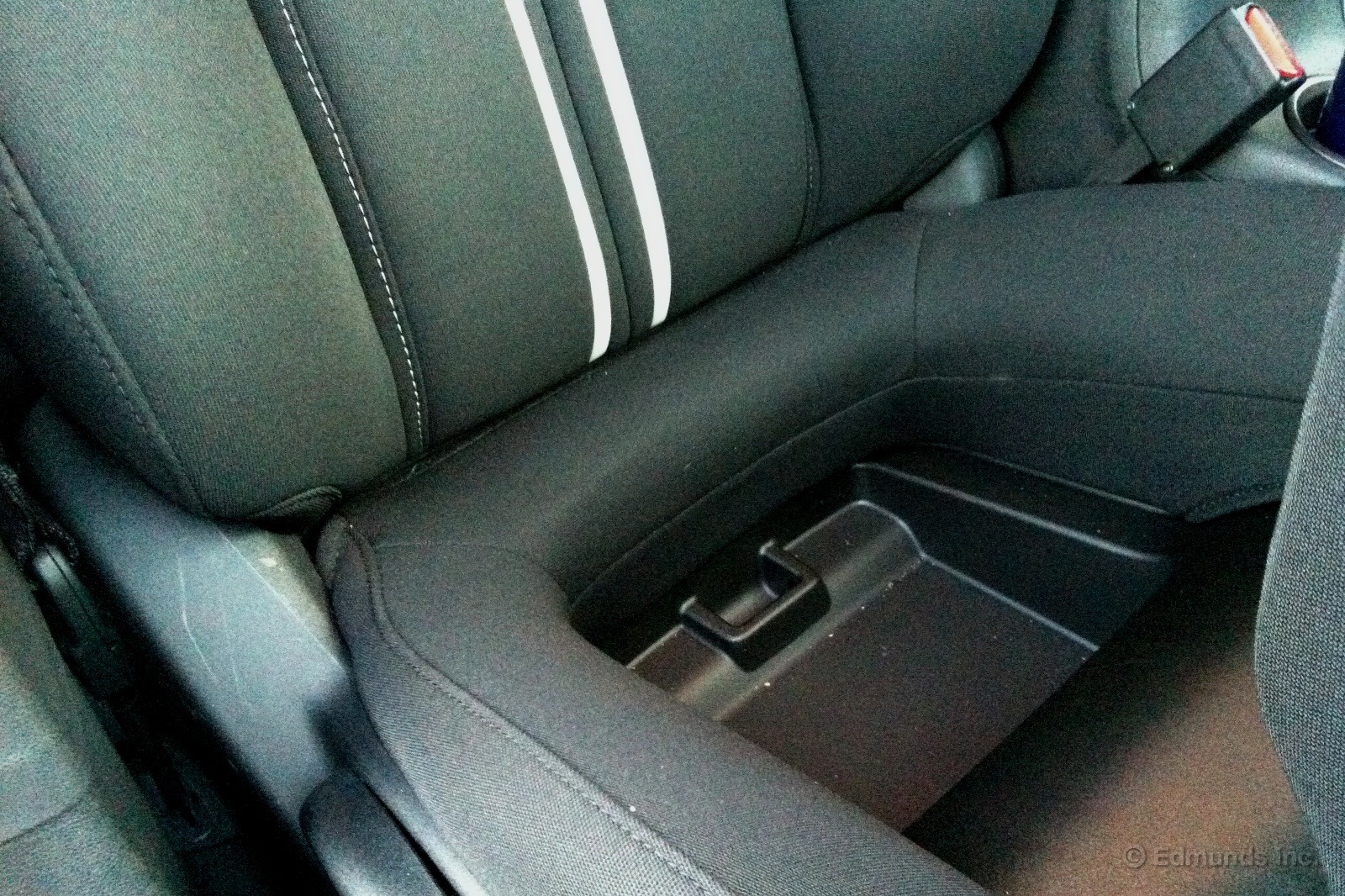

My super market offers a deep discount when shoppers buy six bottles of wine at a time, but that nifty bag is tippy and I'd rather not lay the whole thing down either. Problem solved. The whole thing fits snugly in the front seat thanks to the molded plastic compartment hidden within.
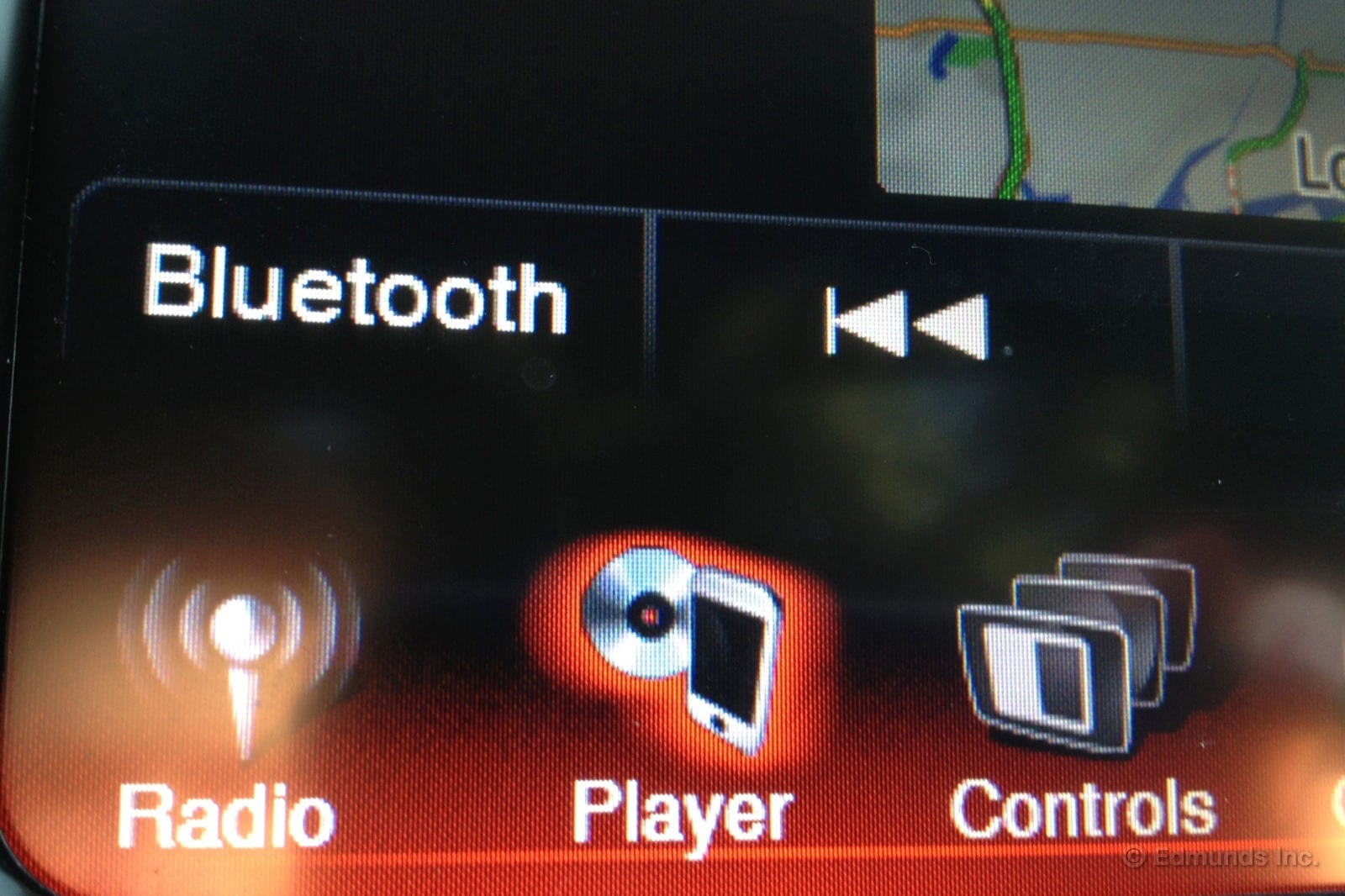
More and more, cars are passing the no-manual-needed rule when it comes to initial phone pairing. That's the case with the 2013 Dodge Dart. Touch the phone icon on the screen, pick "settings" then "paired phones" and "add device." There's the parallel process on the phone for finding the Uconnect system and adding the pin, and that's easy to do as well.
What I didn't expect was that Bluetooth streaming audio would be ready to go without any more fuss. When I touched "player" on the screen, the audiobook I had been listening to on my iPhone kicked right in. What a pleasure. In my own car (a 2011 BMW 328i), the initial set-up of Bluetooth streaming audio was less than intuitive. It's also no fun that I have to reset it if I should need to connect my iPhone via USB for charging. Believe it or not, BMW, that does happen from time to time.
I was less thrilled with the Dodge Dart's phone system after the initial set-up. It didn't seem to recognize that I had already paired a phone, and repeatedly asked if I wanted to add one. A visit to Chrysler's Uconnect System Mobile Device Support page on the Web helped resolve the issue. (Why not check the user's manual, you ask? More about that in another post.) The phone must be unlocked before the car's Bluetooth system starts hunting around for it. That was easy enough to do. Now back to Chapter 6 of "State of Wonder."
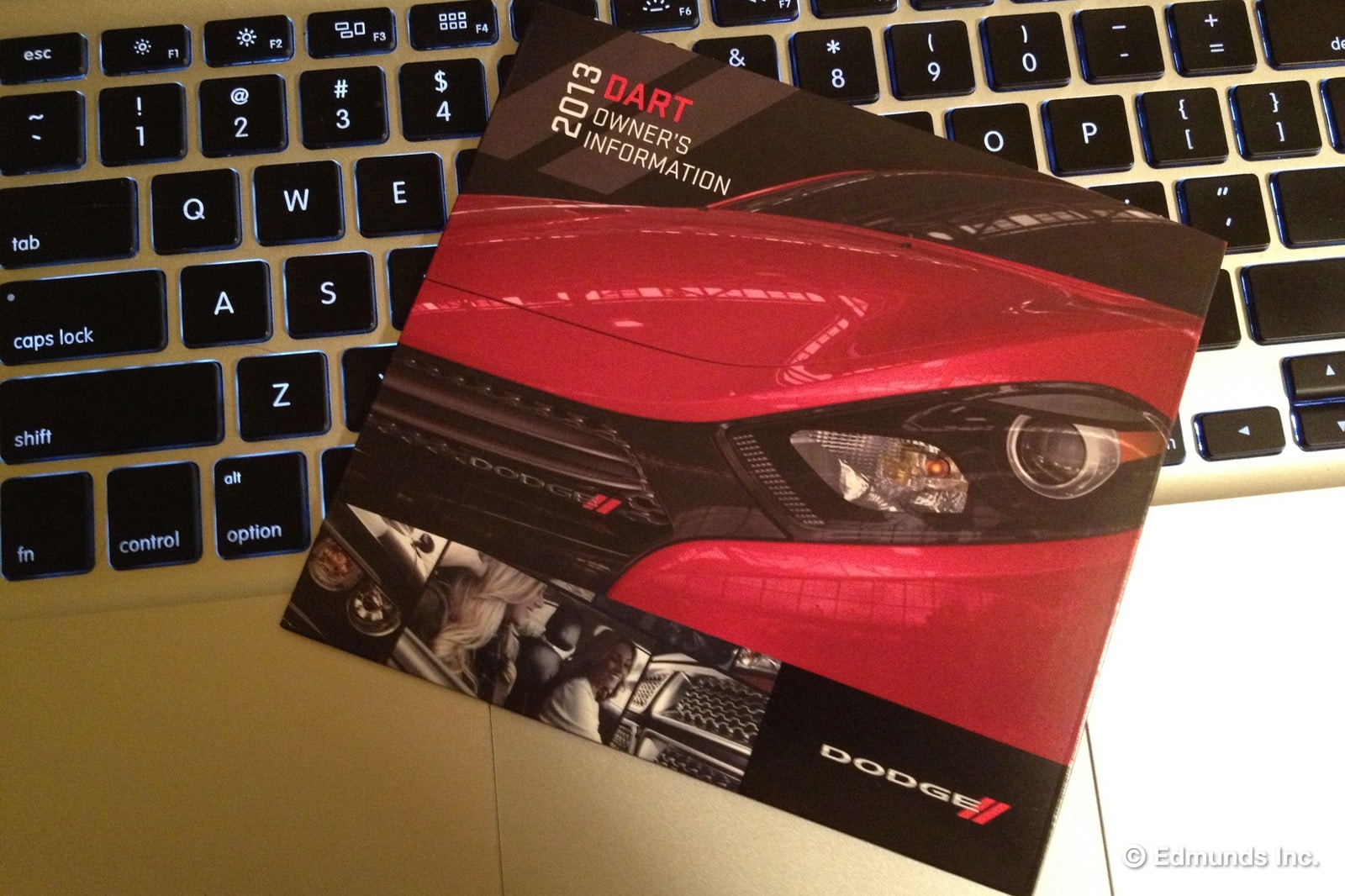
I wanted to troubleshoot phone-pairing in the 2013 Dodge Dart. Muscle memory impelled me to click open the glovebox, where I expected to find an owner's manual and/or a manual for the Uconnect system. I felt around for the familiar, fat paper guide, but instead I found a thin vinyl pouch that contained an owner's manual on DVD. (There was also a trim glossy "user guide" in the pouch, but in my determination to find the car's unabridged sacred scripture, I overlooked it. Shame on me.)
The DVD initially seemed unhelpful for in-car assistance, unless you could play it on the screen. A hunt for the CD player ensued. It lives in the center console: a CD player location I hadn't encountered before. I popped in the DVD.
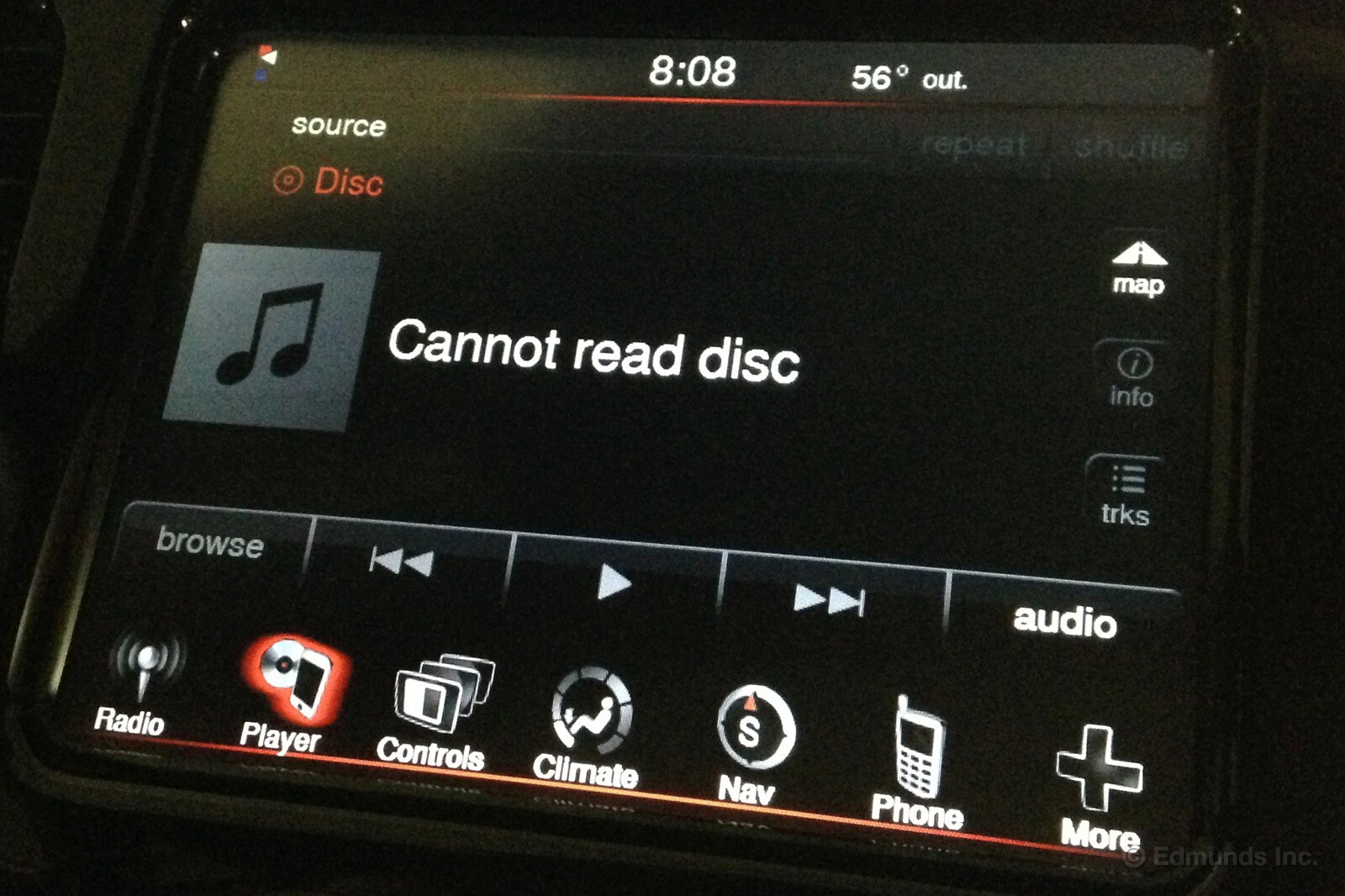
The CD player couldn't read it.
This is why paper manuals are really, honestly much more useful than new media info systems. If you are the "first registered retail owner" of a Dart, as the DVD sleeve puts it, you can ask the Dodge dealer to give you a printed owner's manual, free of charge. You can also order a free manual by phone. Or you can download PDFs of the owner's manual, Uconnect system guide and other documents from the "owner's" tab at the Dodge site.
For day-to-day use, the user guide is helpful enough. It's thinner than a true owner's manual, but covers more ground that the pamphlet-sized quick guides that some new cars have for those who don't want to wade into owner's manual minutiae.
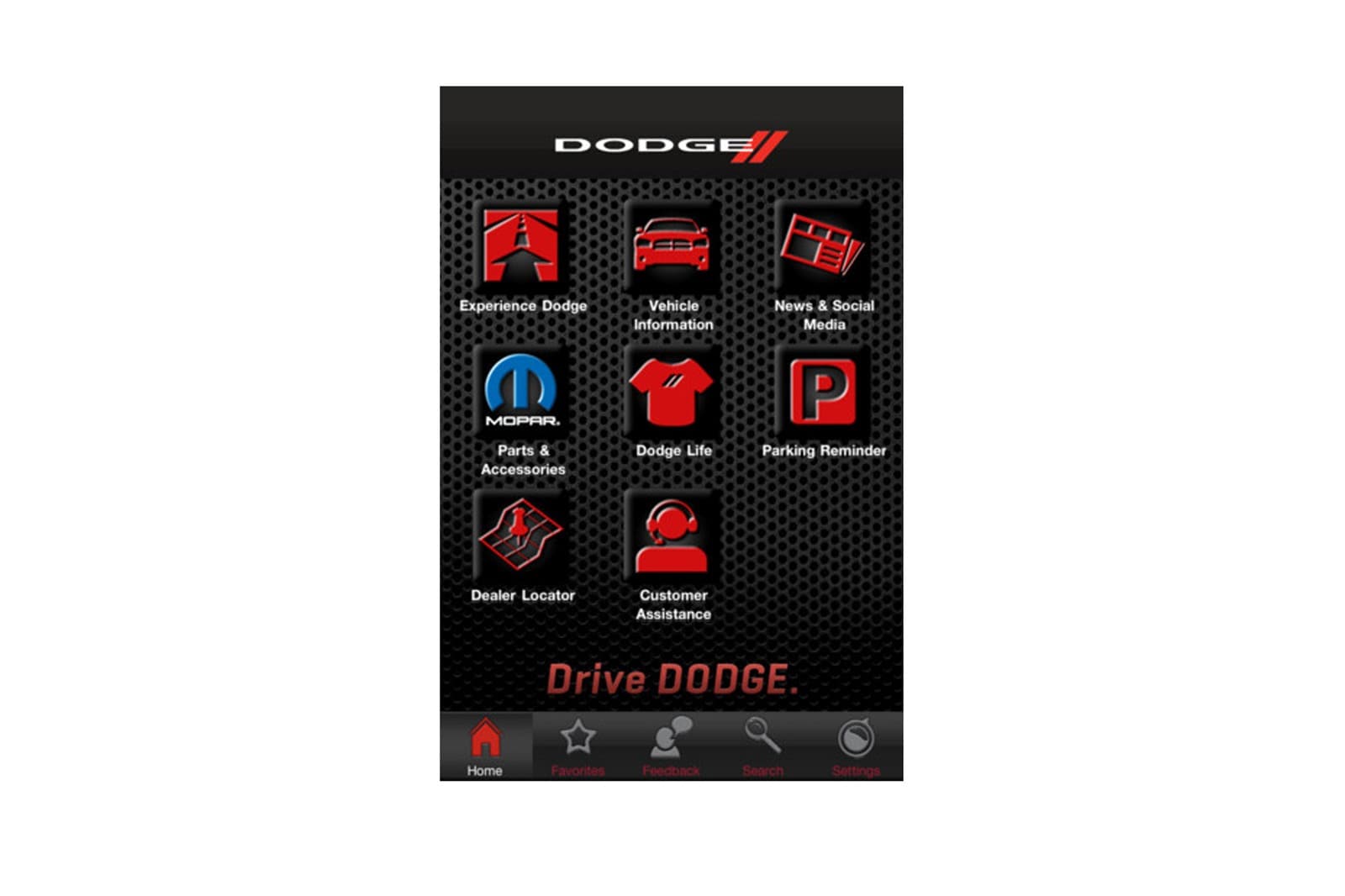
Of more utility, perhaps, is the Drive Dodge app, which the user guide mentions on its back cover. I downloaded it from the iTunes store, and found it had what most drivers would ordinarily need. There's one for Android devices, too.
But if I were buying this car, I'd order up a traditional paper manual. There's something reassuring about having one onboard, just in case there's an emergency in which both the car and phone are dead. And you'd rather not join them.
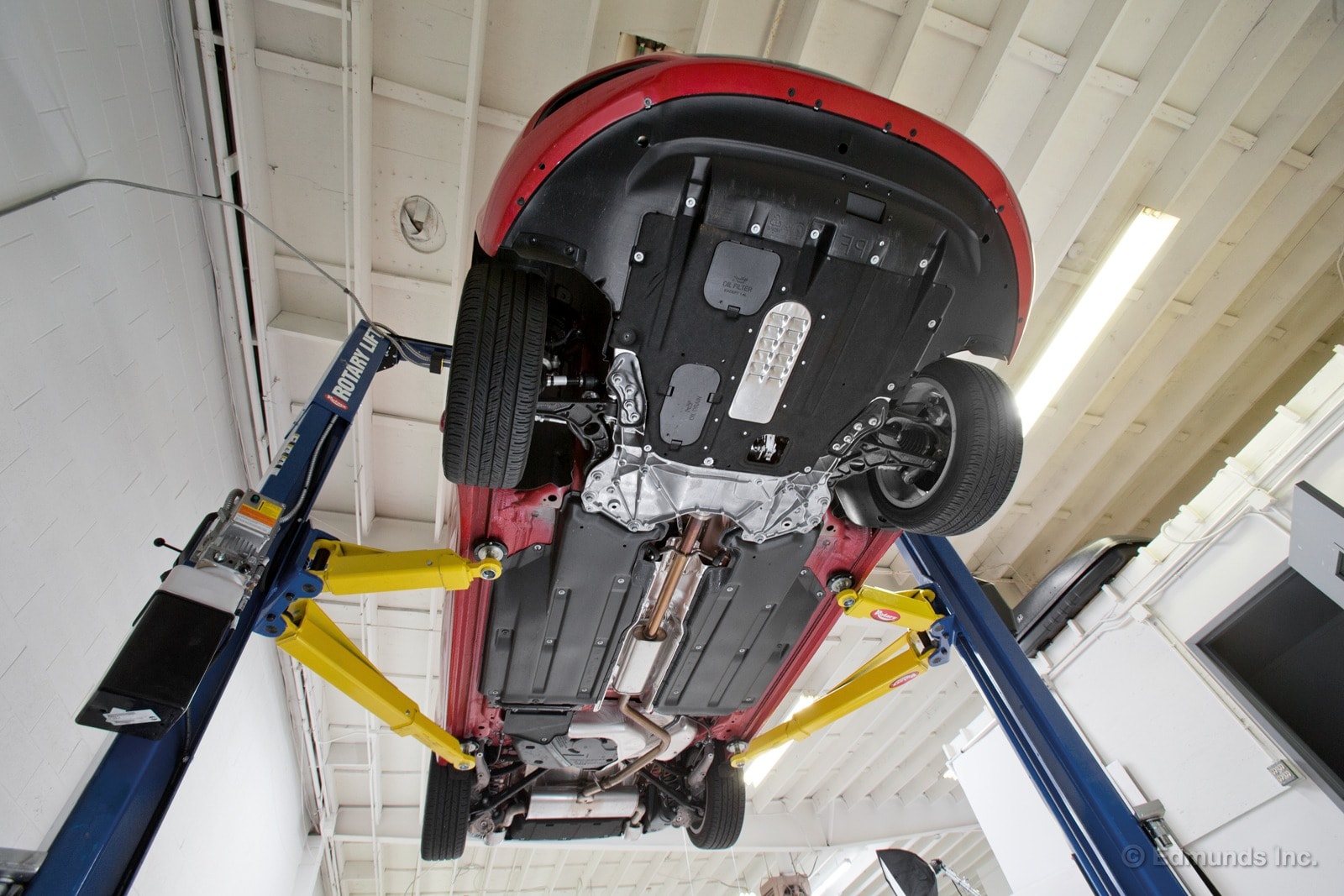
Our 2-post Rotary Lift has always afforded us unique views of our long-termers. This time around, our 2013 Dodge Dart gets the treatment. We're especially impressed with how aerodynamically clean the underside is, and the access panels for oil changes are a nice touch.
More pictures after the jump.
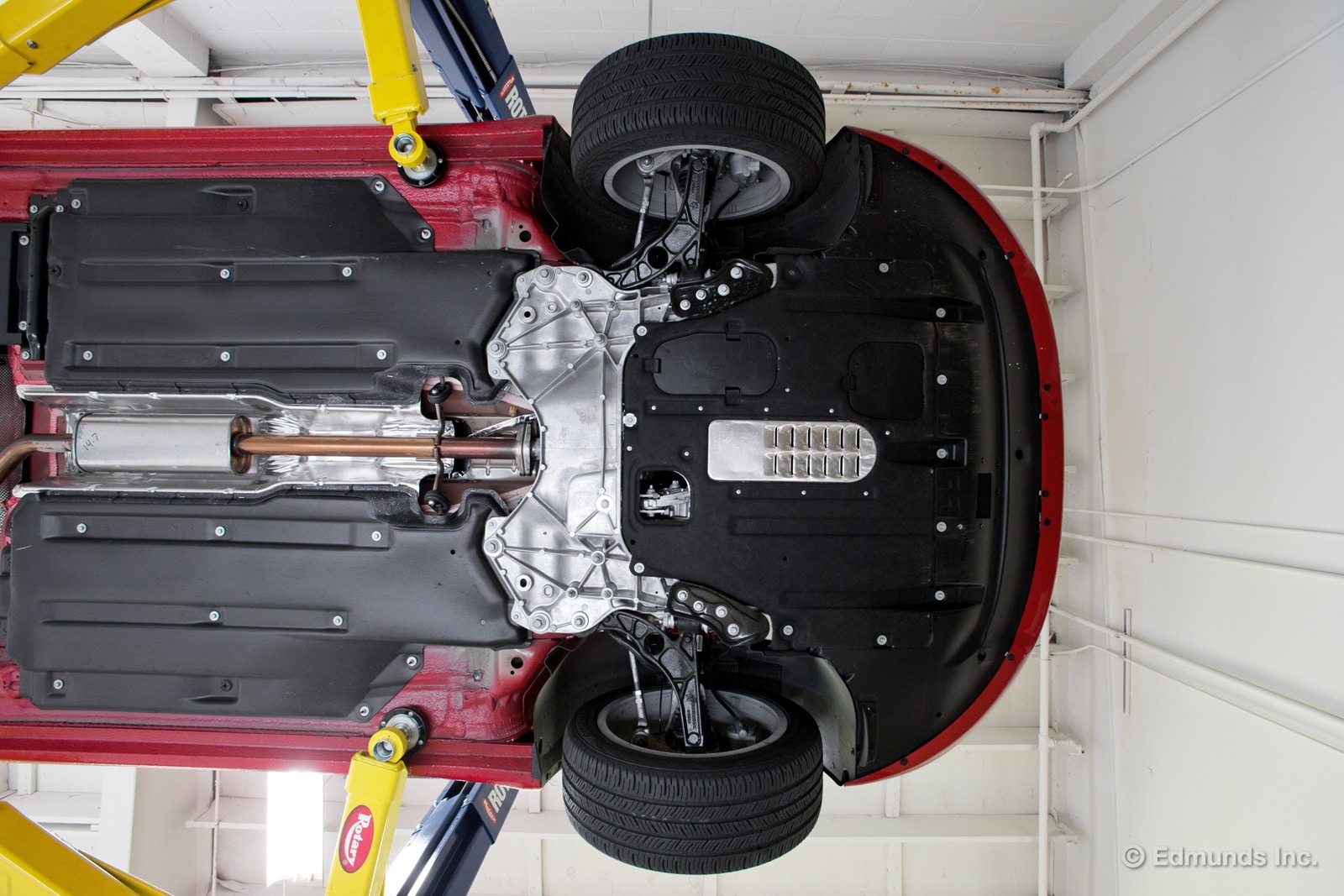

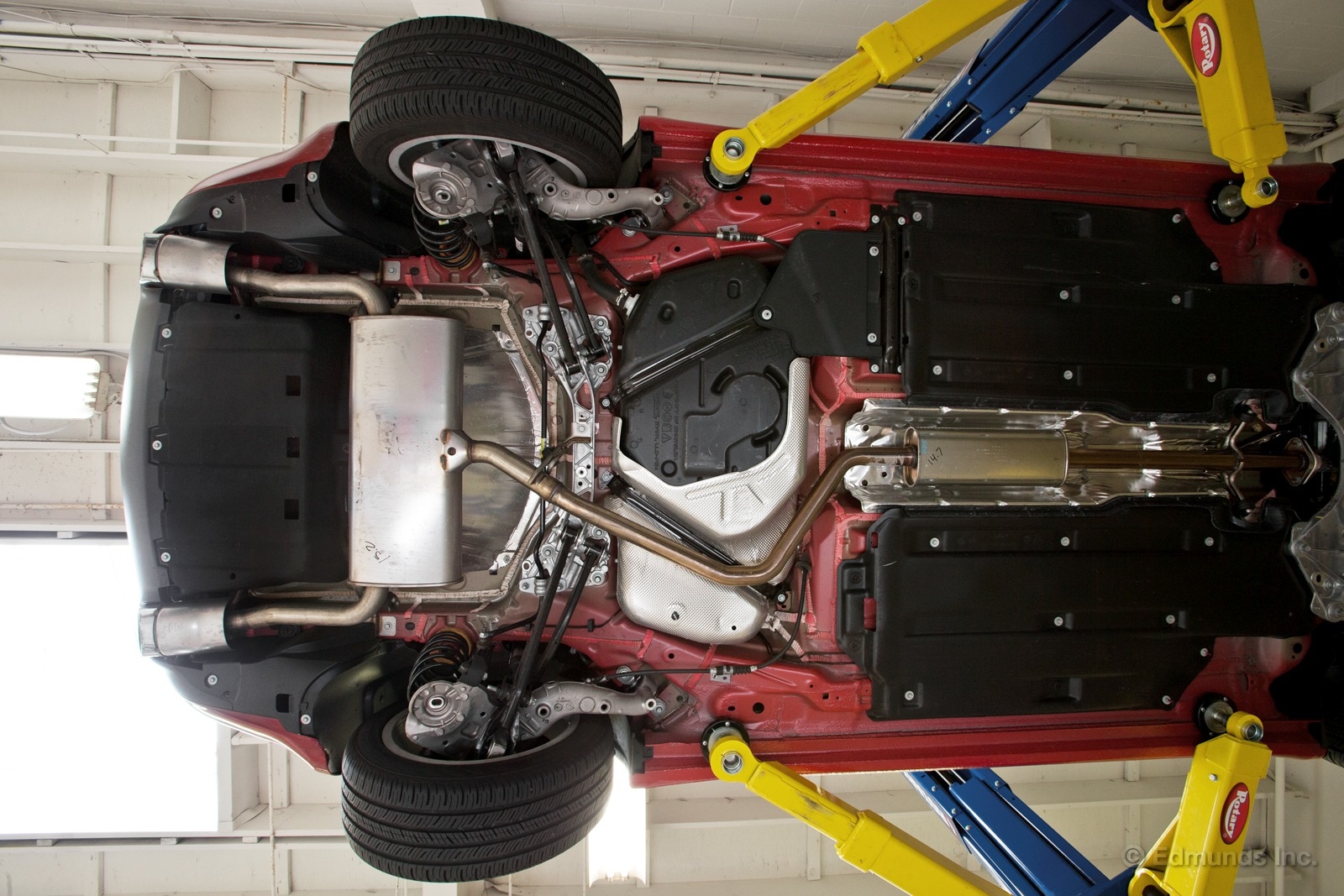
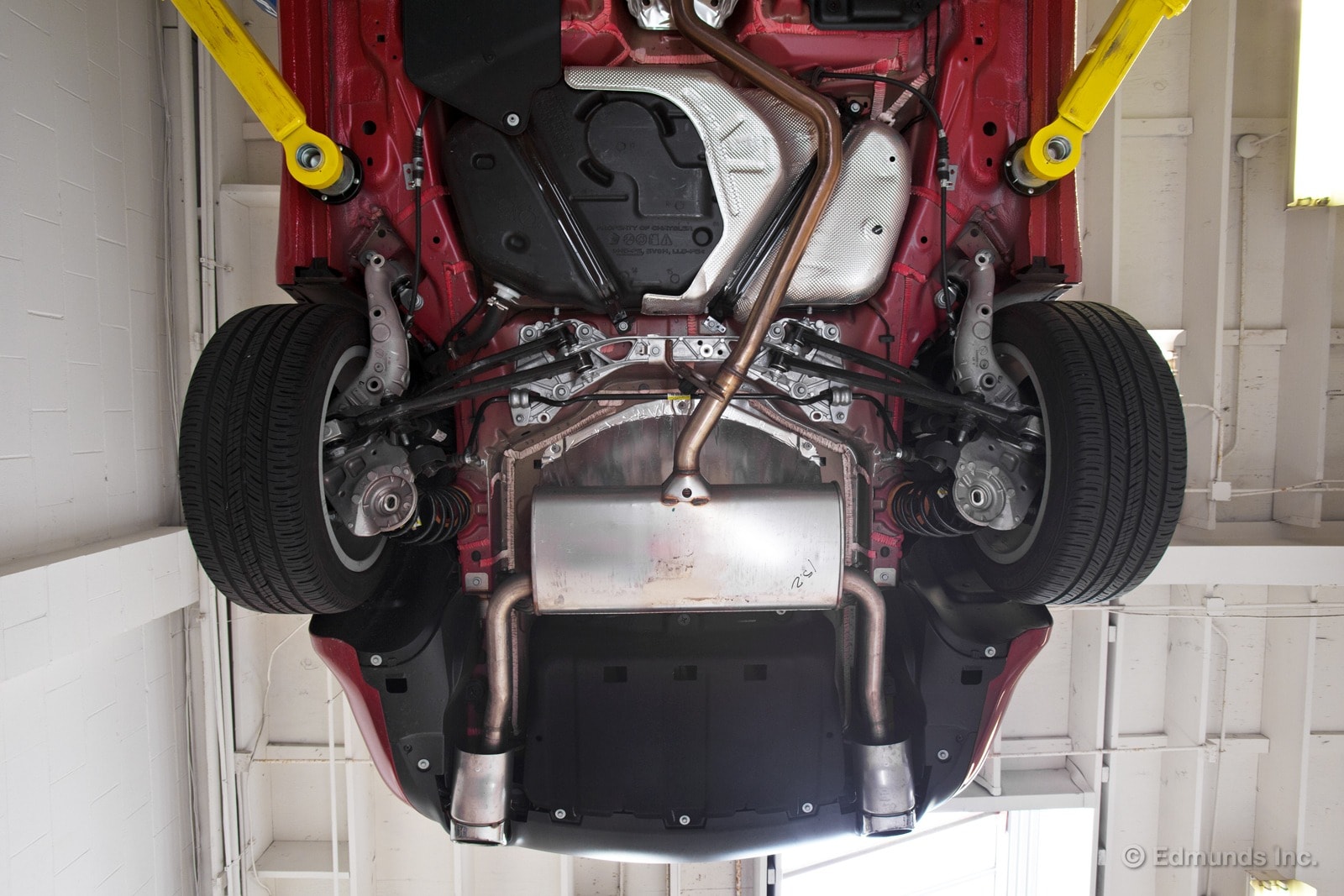
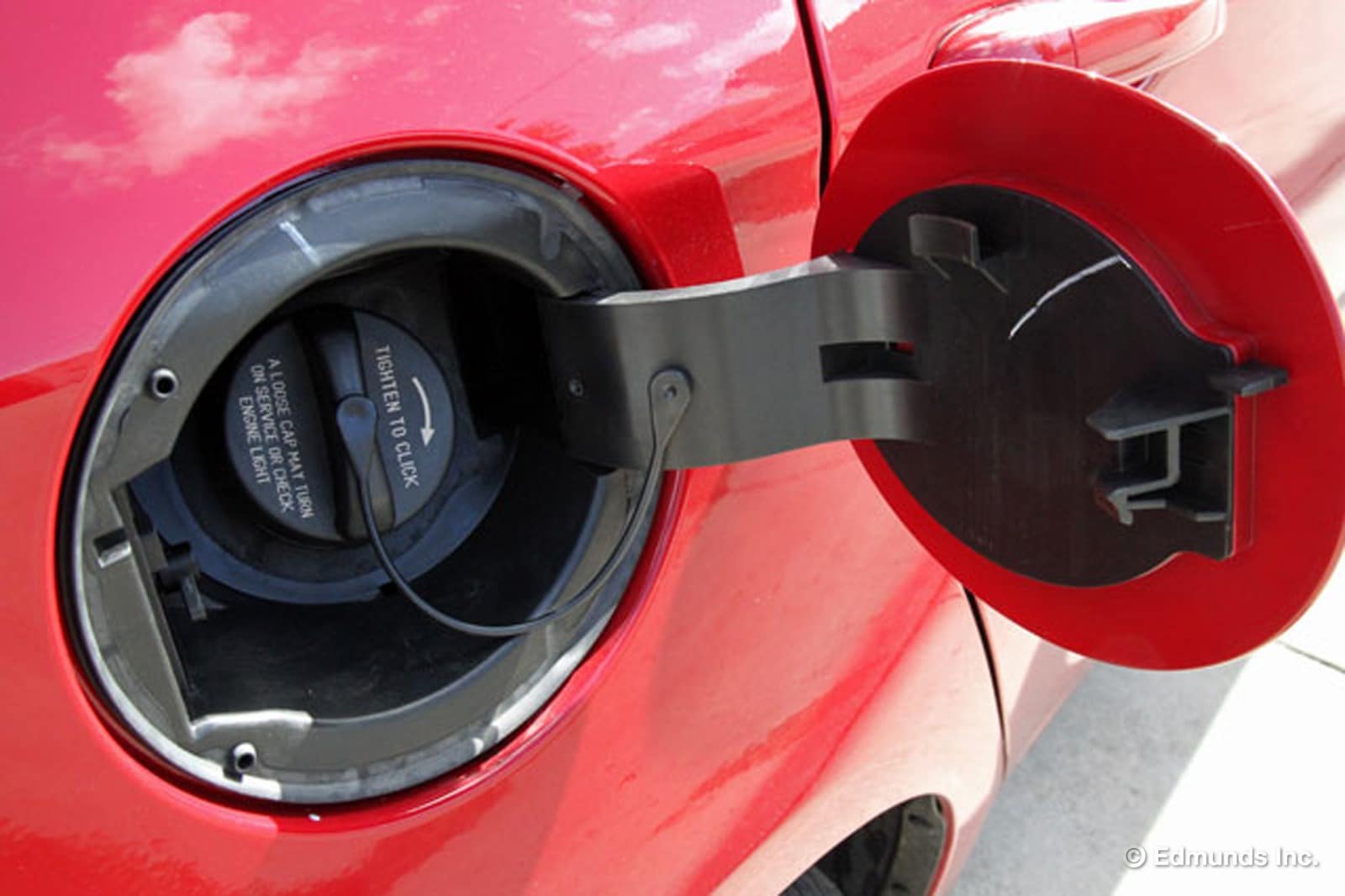
This is the gas cap for our 2013 Dodge Dart. You might notice that it makes no recommendation as to which kind of gas the engine prefers "for best performance" or any such nonsense.
It's a bit strange given that our Dart has the optional 1.4-liter turbocharged engine. Or at least it's strange to anyone who grew up driving a turbocharged car that required premium swill just to keep it from detonating itself to death.
Makes sense, though, given the Dart's price range. After all, what's the point of getting good gas mileage if you have to pay more for the gas itself?
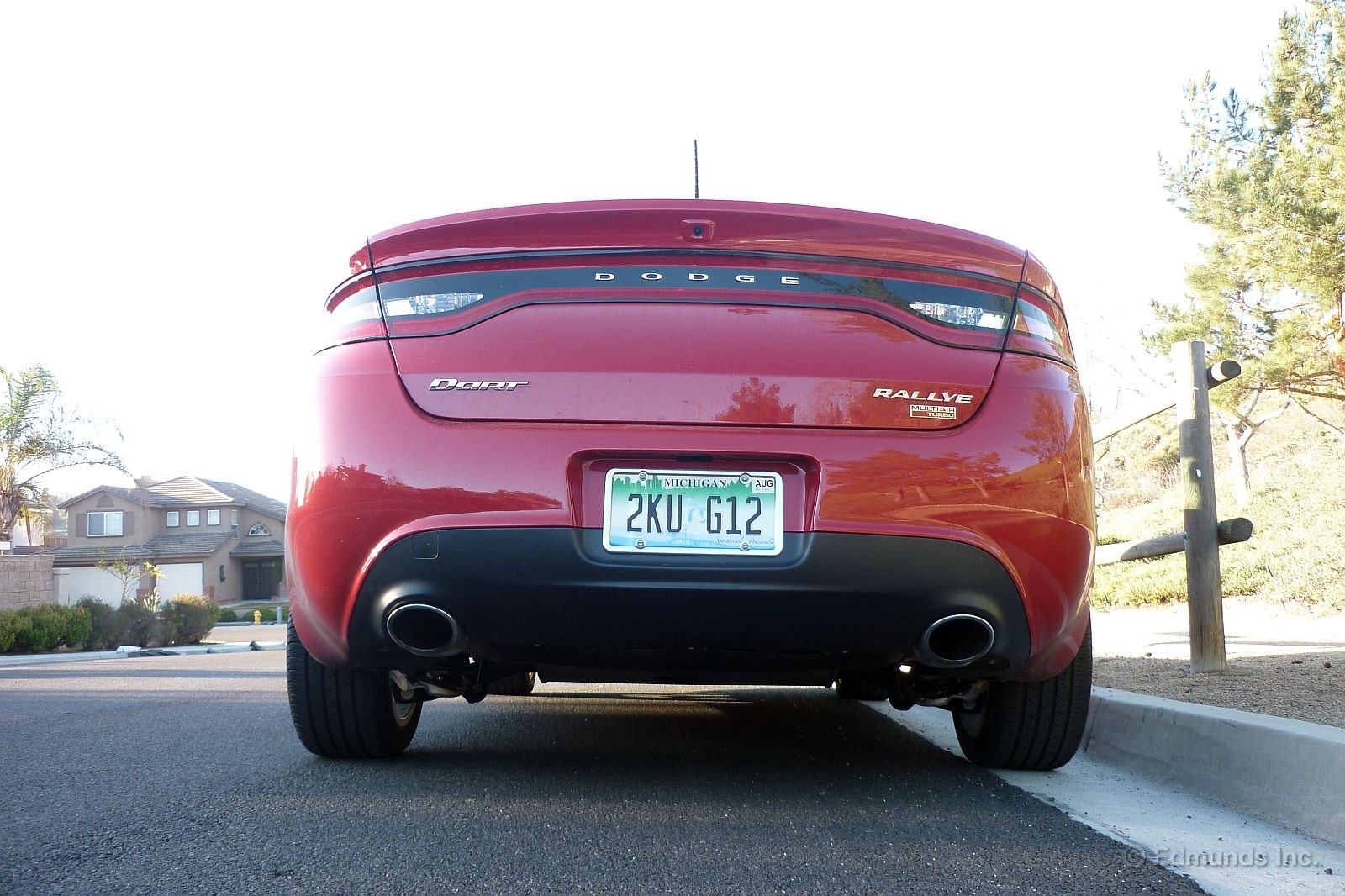
I need to get something off my chest. I kinda dig the rumbly, slightly agricultural note that emanates from the twin-outlet exhaust system on our 2013 Dodge Dart SXT Rallye long-term car.
I'm not saying it's a beautiful sound. But the deep burbling as you trundle around at low revs sounds mean. Especially with the windows down.
The other reason I'm drawn to the Dart's sound is because it reminds me of a detuned version of the Dodge Neon SRT-4. That car's un-muffled turbo-four was somehow cool in an industrial, we-just-packed-a-ton-of-power-into-this-little-crapbox kinda way.
Now whether the Dart's note is what non-SRT-4 lovers are looking for may be another story.
But I like it.
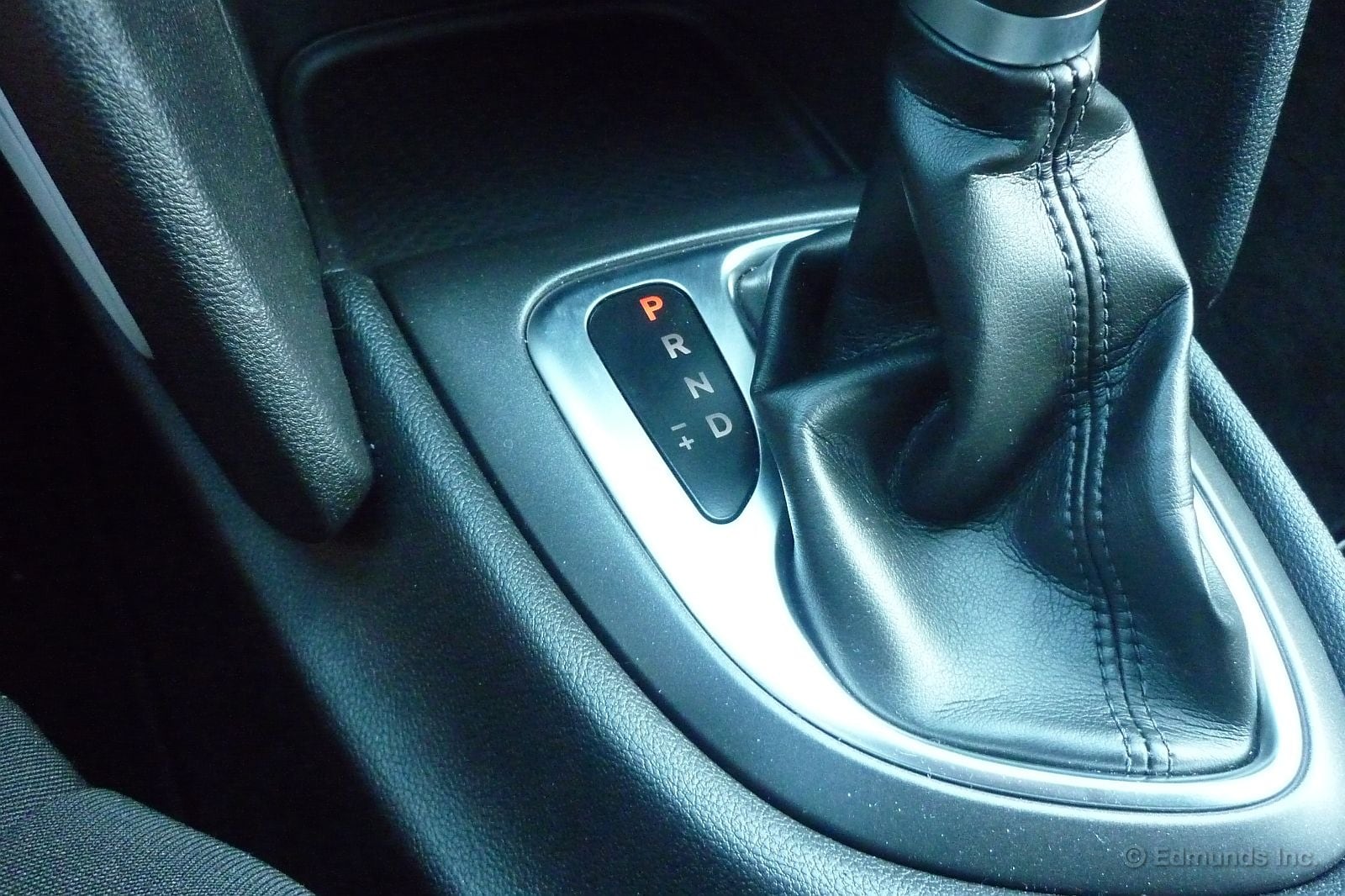
Some editors have already pointed out the annoyances of the 2013 Dodge Dart SXT Rallye's dual-clutch transmission. Basically, it's slow to react and easily confused. Since those are two deficiencies I've also been accused of on several occasions, I probably shouldn't be throwing stones.
Instead I'll focus on some of the redeeming qualities. Such as the perfect throttle blips on manual downshifts.
And that the manual shifting logic is set up in the pattern I prefer. Push forward for downshifts, pull back for upshifts. This is also interesting because it's a change from Chrysler's slap left/slap right manual shift logic.
So while this gearbox can be frustratingly laggy at times, it does have a few positive qualities.
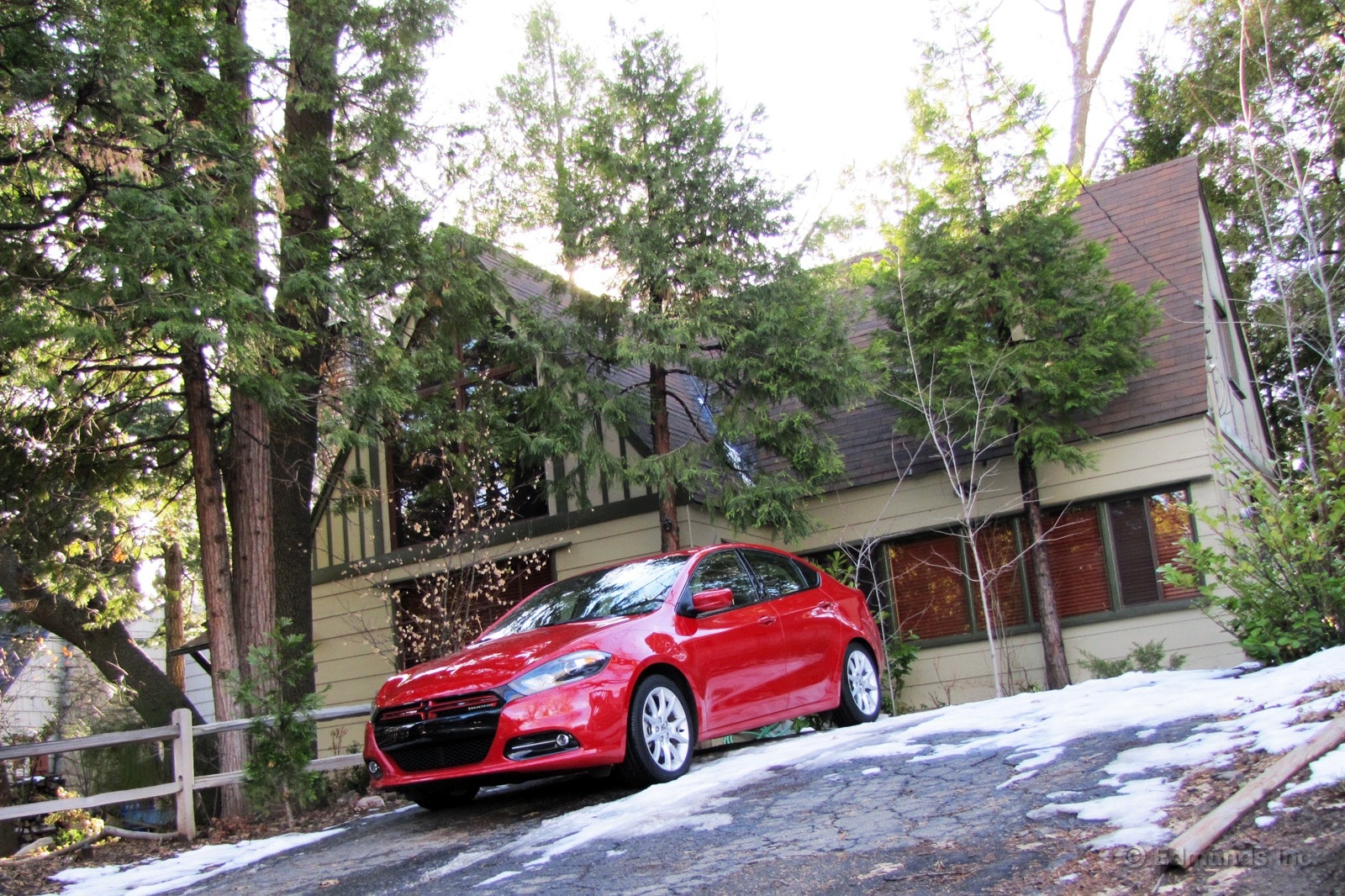
A compact car is not the ideal vehicle to take on a long-weekend road trip with four people and their stuff. And yet, with all our bigger sedans and SUVs already spoken for, the Dodge Dart was actually the most spacious car available for our weekend journey to Lake Arrowhead. No problem, I thought, we'll just have to make it work.
And make it work we did, as the trunk proved to be suitably ample without the sort of bulges or intrusions that can make a cargo area less useful than its cubic feet would indicate. It does have some nasty spikes in it, but I'll save that for the next blog. The cabin was sufficient for myself (6-foot-3) and my friend Chris (6-foot-4) up front, with our wives in back along with a few items that didn't fit in the trunk. Would there have been more room in a bigger vehicle? Of course, but as far as compact sedans go, the Dart was very impressive and I heard no complaints from my passengers.
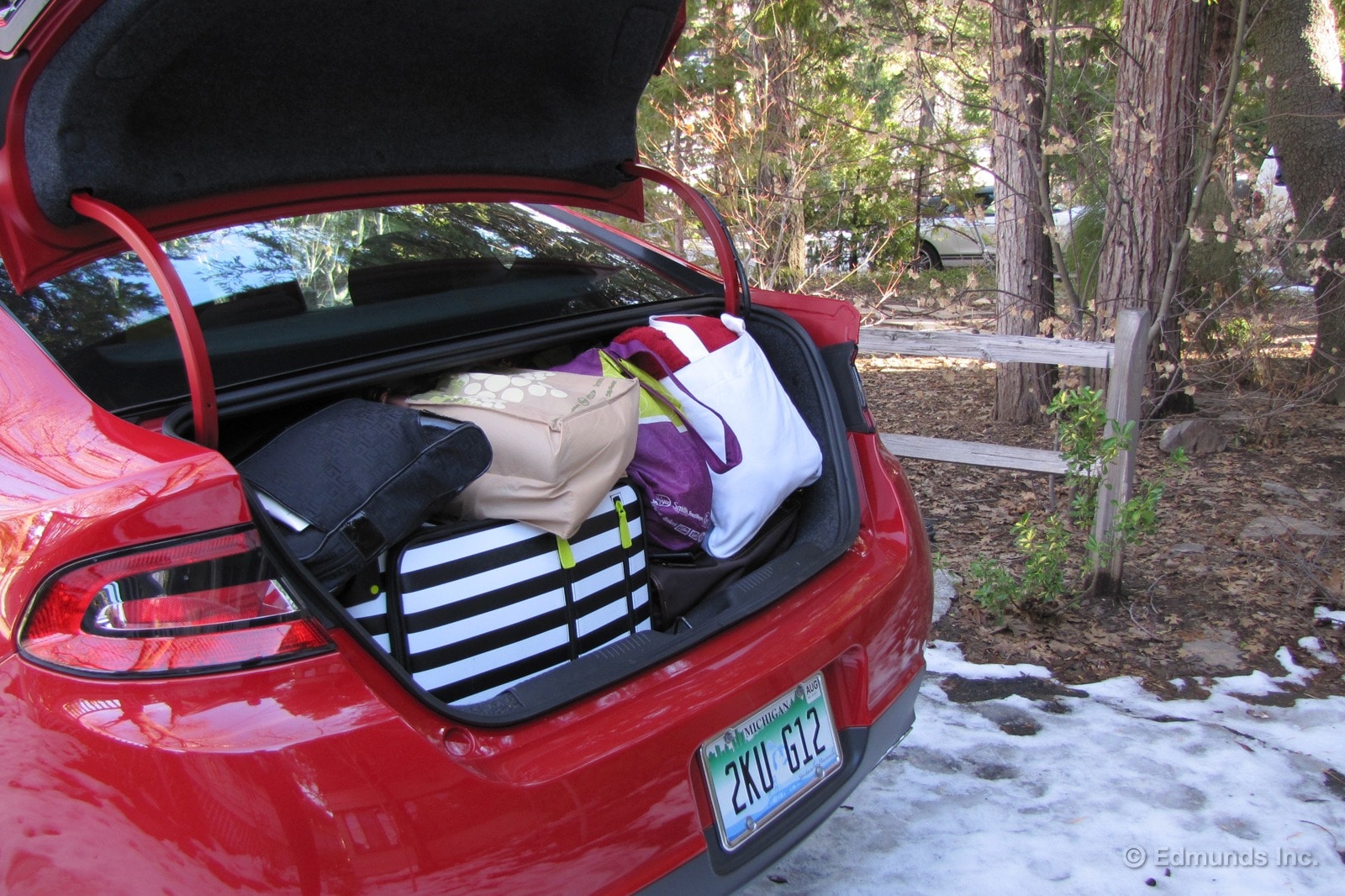
With that much weight on board, however, the Dodge Dart's driving dynamics certainly changed. Not surprisingly, the ride was less compliant and the suspension in general exhibited some odd behavior over I-210's concrete surfaces. That's to be expected, though. The much-maligned transmission, perhaps also not surprisingly, didn't take well to the extra weight. It was even slower to downshift from its beloved sixth gear, often leading to a stuttering sensation when applying gentle throttle during cruising.
Once we hit the steep mountain road up to Arrowhead, that high gear obsession got even more tiresome. Ease off the throttle, upshift. Get on the throttle, downshift. Up and down. Up and down. Up and down. It didn't take long to slide it over to manual and do it myself.
However, my biggest problem with the Dodge Dart continued to be its seats. As I wrote before, the driver seat is mounted too high and I find it impossible to achieve a comfortable seating position for my 6-foot-3 body. My head is in the roof, the steering wheel doesn't go down far enough and my lower back ends up resting at an awkward angle. Over the course of only two hours, I was more than ready to get out.
Interestingly, and for reasons that have little to do with the Dart, my wife ended up driving home from our little weekend vacation. Though 5-foot-nothing, she too found the seat uncomfortable and found that her back was starting to hurt (she has no history of back issues). On the upside, she was pleasantly surprised about how well the Dodge Dart handled.
Inevitably, the seat comfort issue will keep me from any future Dart excursions. However, as a means for transporting four people and their stuff, it passed quite well.

Since I was couch-ridden with back spasms, it was up to my friend Chris to load up the Dart come check-out time at our Lake Arrowhead cabin this past weekend. After the second load, he came back inside holding his cut and bleeding hand. Was he the victim of a bear? An enraged raccoon? Nope, Dodge Dart attack.
While playing that age-old game of Trunk Tetris, Chris made the unfortunate discovery of these sharp metal spikes that hang down from the left side of the parcel shelf. I don't know why they're there, but they are definitely a safety hazard. Not only can you be easily injured, but as Chris pointed out, it's not exactly ideal for whatever you've stuffed in the trunk, either.
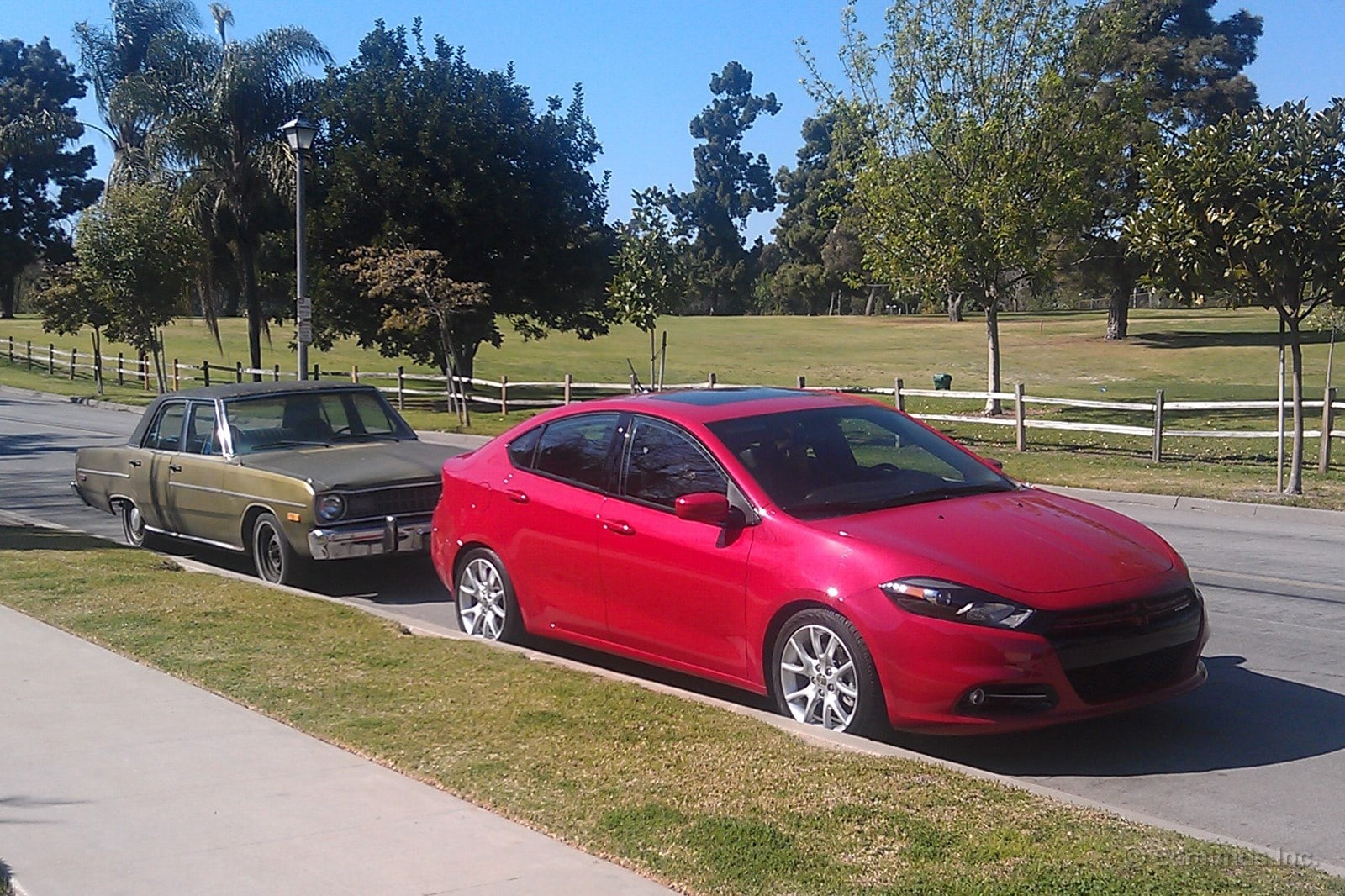
Dodge's new compact car goes by the name of Dart. And that's just plain weird given its roots (its platform is derived from the Alfa Romeo Giulietta) versus those of its namesake ancestor. Hell, that's like Pontiac calling a Daewoo-based subcompact a LeMans. Or Chevrolet calling a Toyota-based compact a Nova. Oh, wait, they did.
As most any middle-aged-and-up American can tell you, the old Dodge Dart was a very popular compact that competed against the real Chevy Nova and the Ford Maverick during the '60s and '70s. But very popular doesn't necessarily mean very good.
Usually powered by a slow, yet fuel-inefficient but virtually indestructible "slant 6", these old Darts were the typical old lady car when new. After they outlasted granny, they often found themselves with much different owners, students who needed dependable wheels.
My sister had one and my lasting memory of that car is how awful the steering was. With about as much road feel and required effort as the old "Pole Position" video game of the '80s, you'd have to turn the steering wheel about 90 degrees before the front wheels reacted. Yeah, you couldn't kill 'em. But you can say the same about a cockroach.
I happened to come across a mid-'70s Dart and couldn't resist the photo op. These two Dodge Darts have about as much in common as my esteemed colleague Michael Jordan and umm, the other one. Stay tuned for an upcoming post on my thoughts on the new Dart.
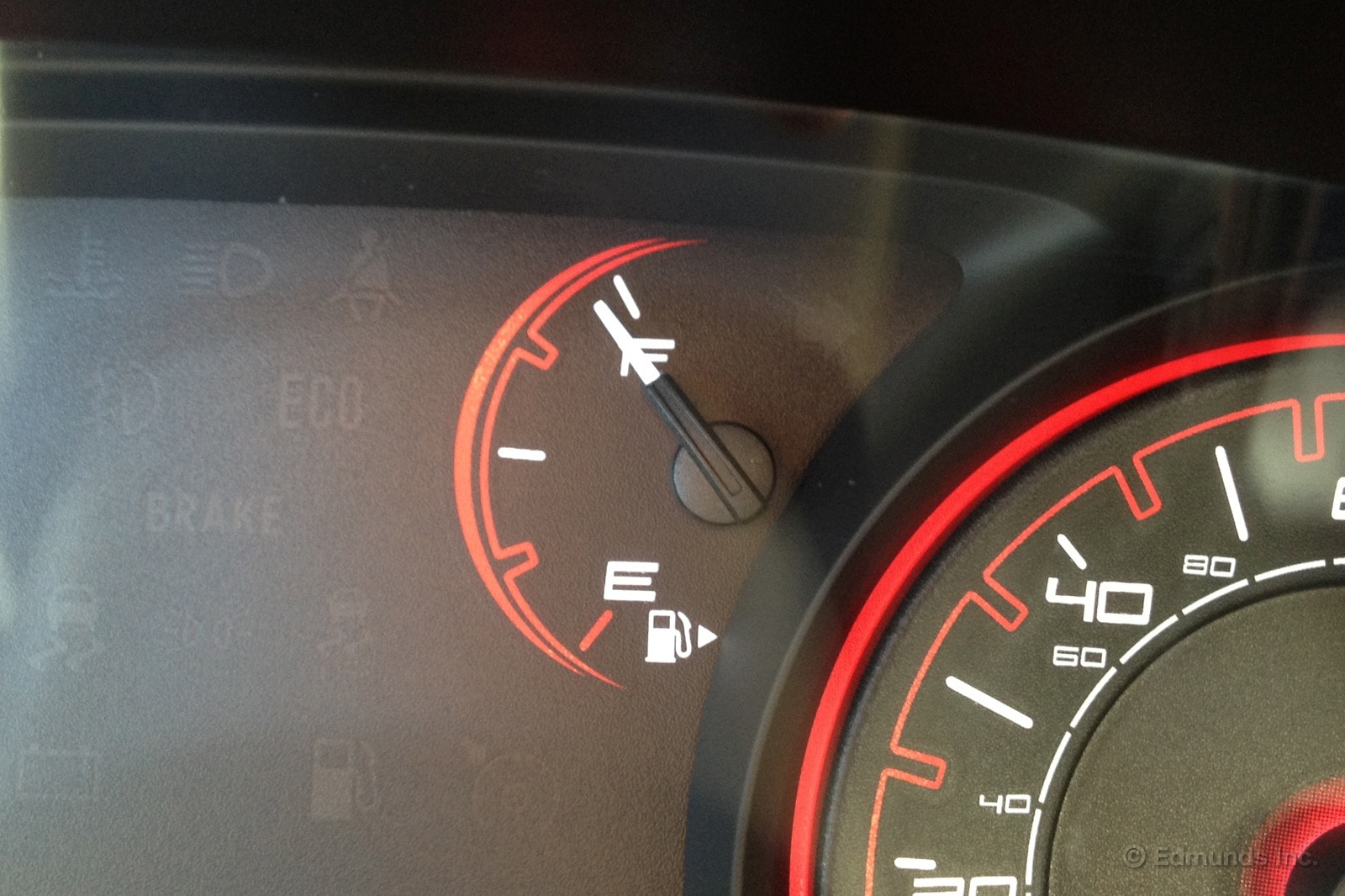
Our Dodge Dart drove nearly 1,200 miles throughout the month of February, our second full month with the car. We averaged 26.5 mpg for those 28 days of mixed driving, which is slightly better than our overall average of 26.2 mpg.
Like Chris Walton mentioned last month, we're still well below the EPA's estimate of 31 mpg for combined city and highway driving. This month we filled up the tank exclusively with 87-octane fuel.
Worst Fill MPG: 21.6
Best Fill MPG: 33.1
Average Lifetime MPG: 26.2
EPA MPG Rating (City/Highway Combined): 27/37/31
Best Range: 384 miles
Current Odometer: 3,638 miles
Bryn MacKinnon, Senior Editor @ 3,638 miles
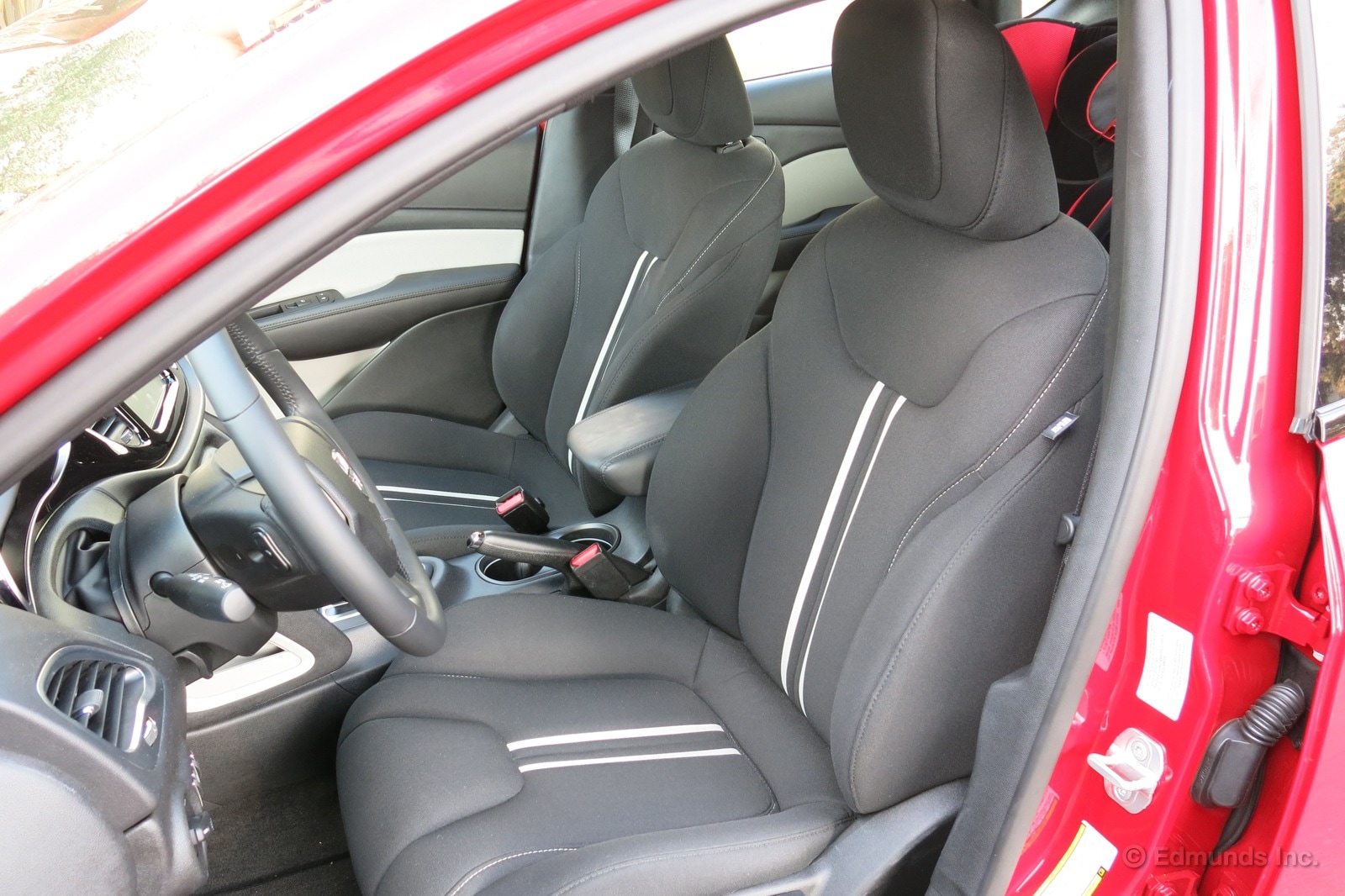
Sitting in the driver seat of our 2013 Dodge Dart is like spooning with an inflatable ninja turtle. The entire seating area is divided into many separate sections, and they are all puffy. Even after driving it for an entire weekend, I never got used to it. I still feel like the seat is constantly trying to push me out. There's also a channel running down the length of the seat back and the cushion, which would be great if I had a spiny back (and backside).
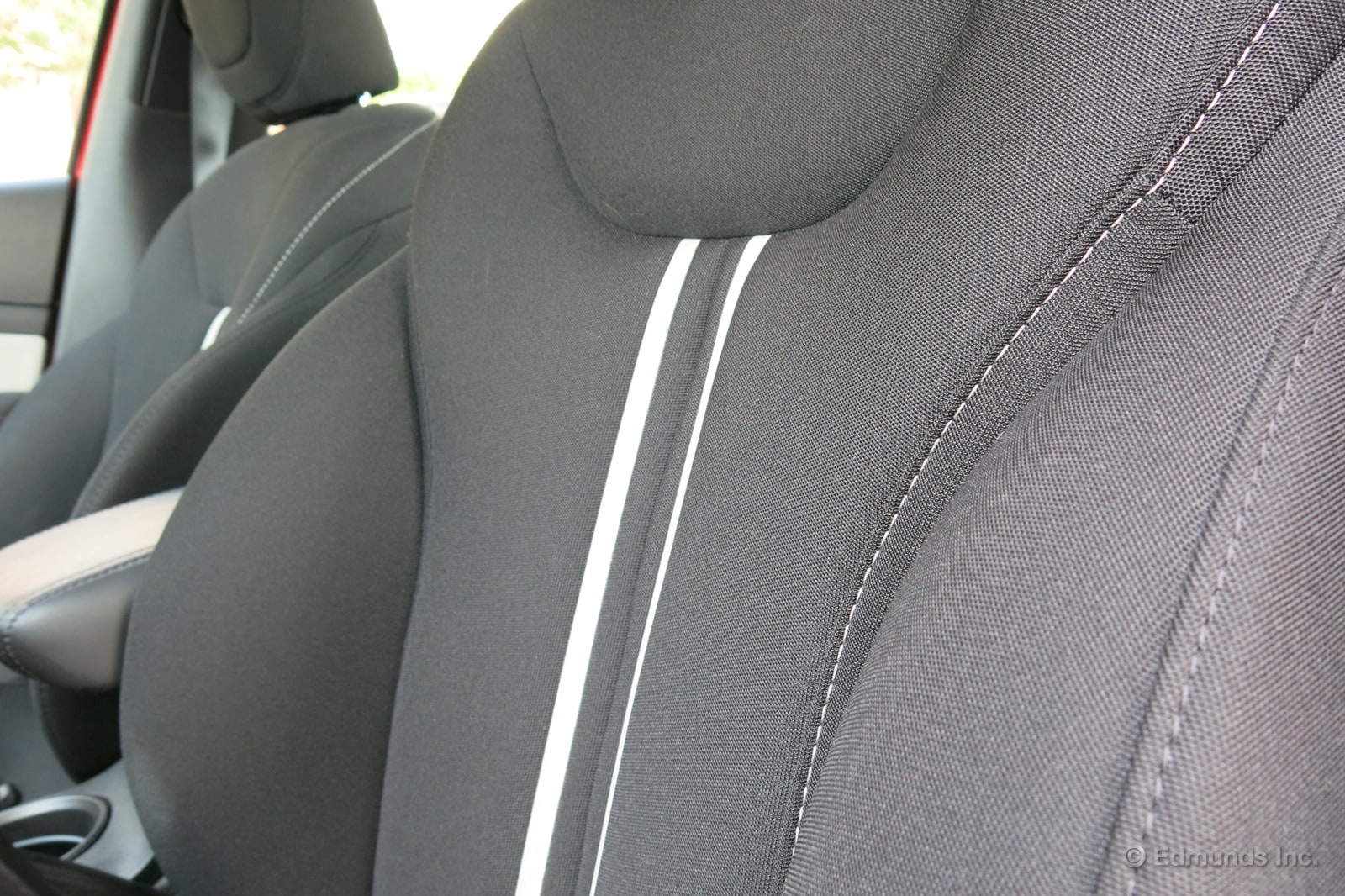
Our own James Riswick has made his similar opinion known already. For reference, James is 6'3" and I'm about 5'8", so this isn't necessarily a tall guy problem. I do like our car's Redline paint, though.
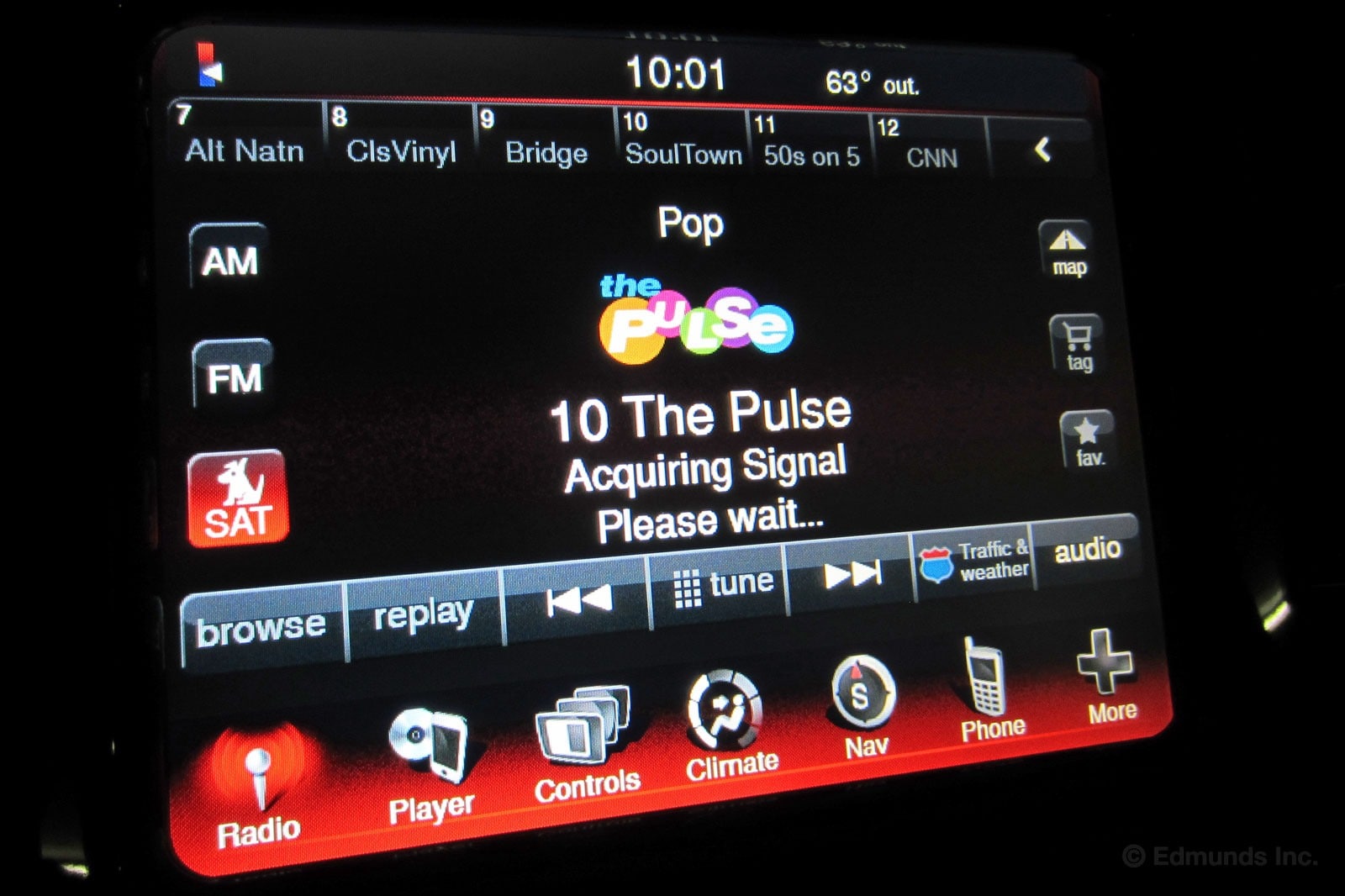
Listening to our Dodge Dart's satellite radio this morning became more than a little frustrating. The sound blipped out so many times during my one-hour drive, I got bored and lost count.
Sometimes, it was just a micro-second of silence, other times it lasted a few seconds.
Either way, it was something I hadn't experienced in the Dart, or any of our other satellite radio-equipped test cars, while driving this regular route.
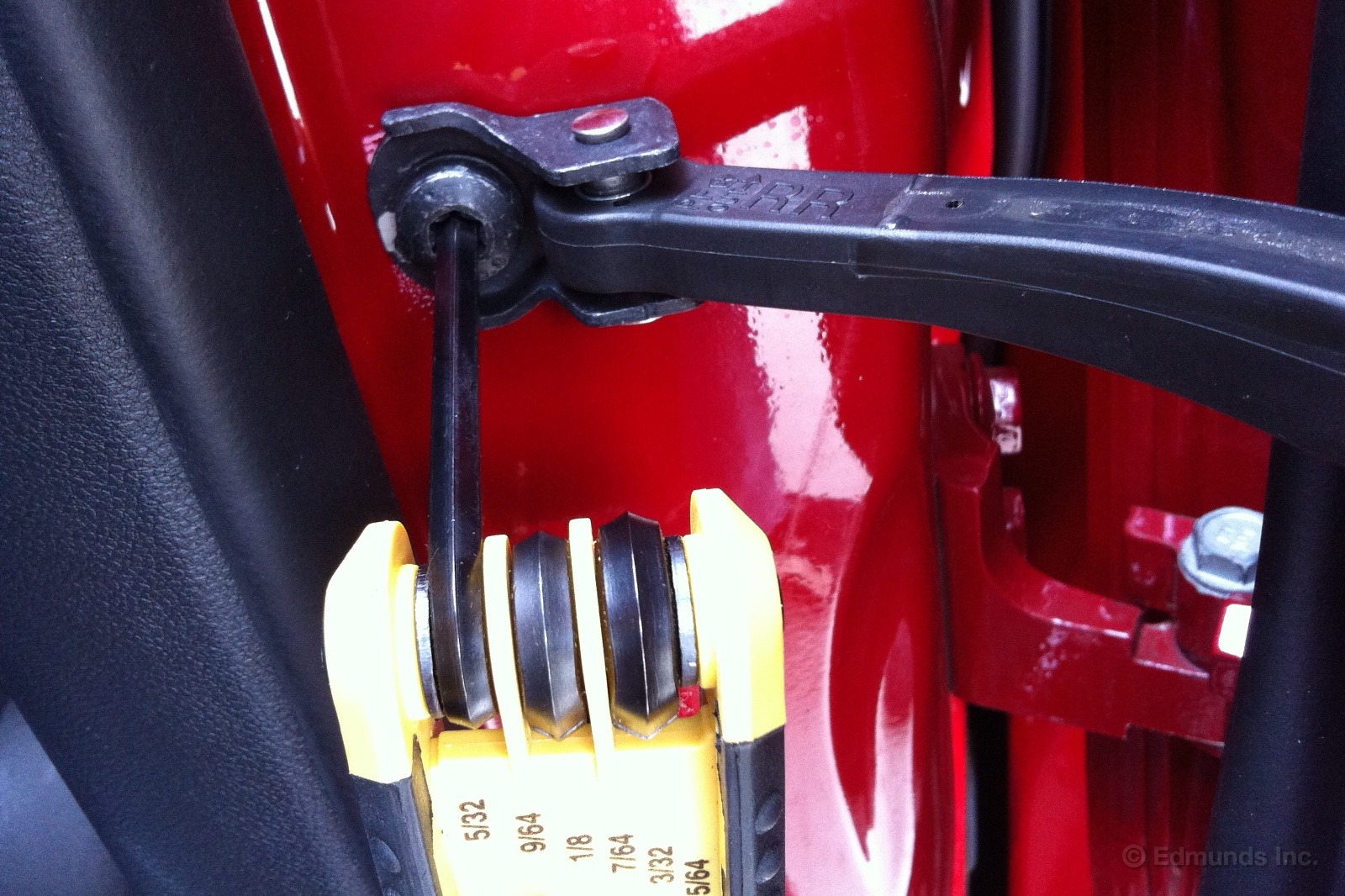
I opened the rear door to load something in the back seat and heard an awful plastic-popping "clack-clack-clunk!" It sounded like something was about to break (see video after the break).
A simple hex-wrench saves the day but it does make one wonder what else might be loose and where. This is the kind of stuff that kills consumer confidence.

It's one of those design ideas in a car that doesn't seem to have a purpose, until it does. Each time I drive our 2013 Dodge Dart SXT I find another use for the clever storage seat: Orchid transport without tipping over.
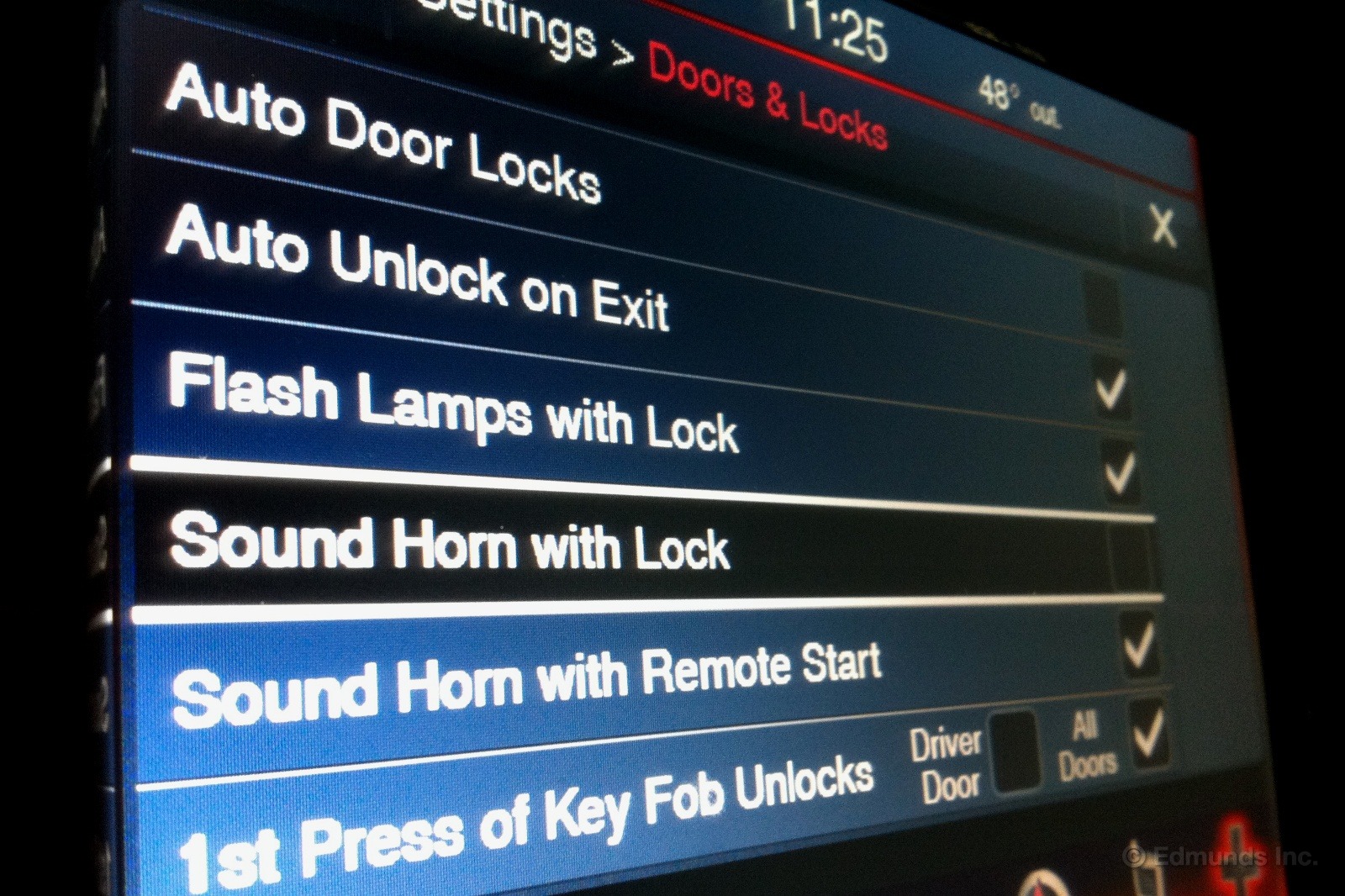
Many cars have a pleasant tone or chirp when you press the remote to lock the doors. The 2013 Dodge Dart uses the car's horn and I'm fairly certain my neighbors know each and every time I lock the car in my driveway. Drilling down into the Settings menu, I found that this "feature" can be silenced. Relief!
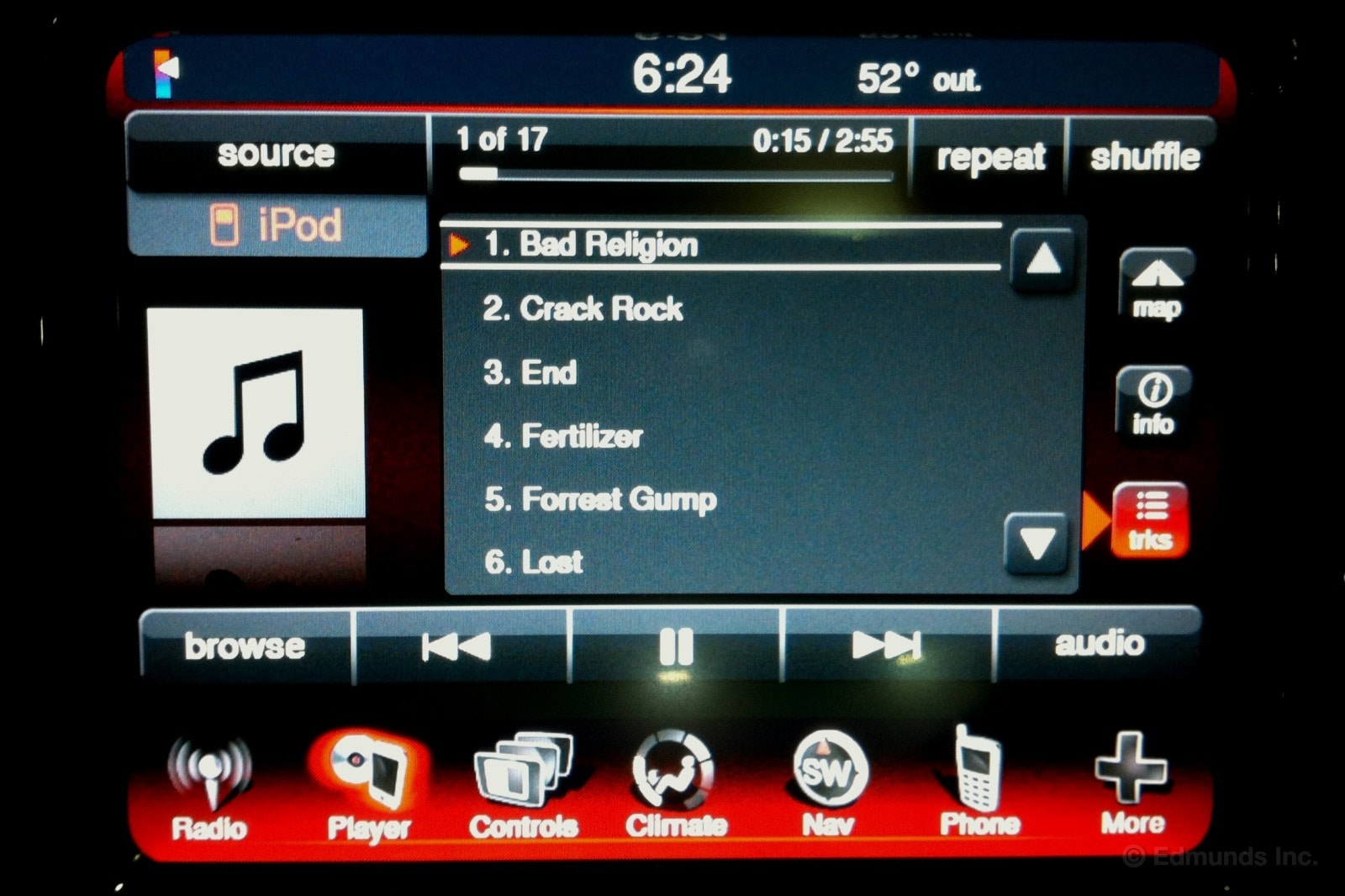
Let me start by saying that I love how easy it is to use the 2013 Dodge Dart's touch screen. Unlike some another car in our fleet, the Dart's icons are large, easy to read, and make good use of the available real estate on the screen.
My problem, however, is with the media player's insistence on alphabetizing the songs within an album when I hook up my iPod/iPhone. I understand why this happens when I want to play all songs from a particular artist, but that's not what I'm doing. I want to play an album, in the order the artist and producer decided. Imagine an opera, for instance, being played out of order. It doesn't make sense.
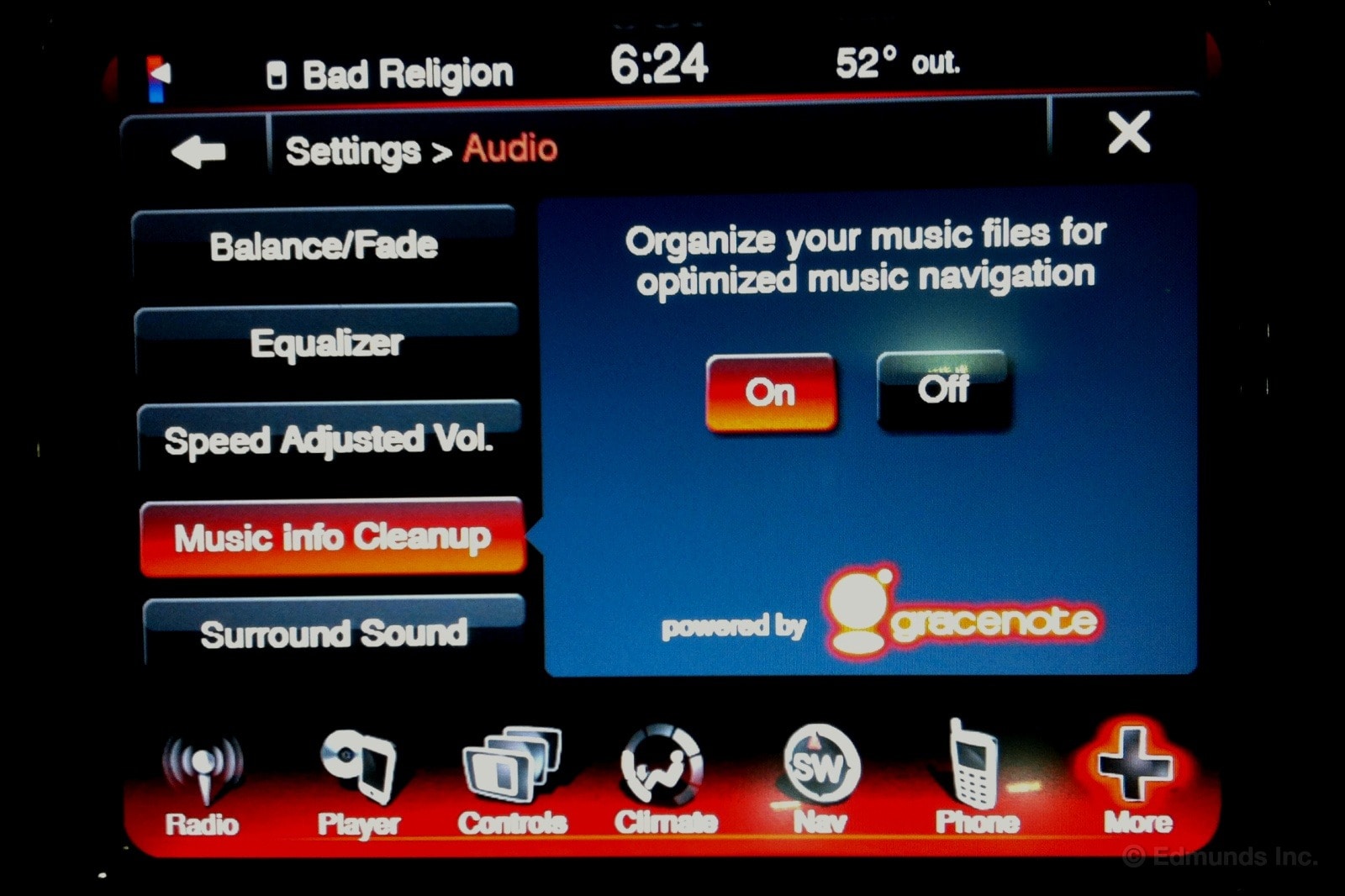
I tried both "On" and "Off" settings on the screen that offer to organize my music files, but the alphabetization persists. It's time to crack open the owner's manual.

You already know how Bryn and James feel about the seats in our long-term Dodge Dart. And Ed doesn't mind them at all.
But I have a new gripe. The rough fabric pulls my hair. Oh horrors, I know. But it's really annoying. My head does not rest against the seat back while I'm driving but somehow it attracts a few strands of my hair and holds onto them. Ouch.
Here's a look at the fabric without my head in the way.
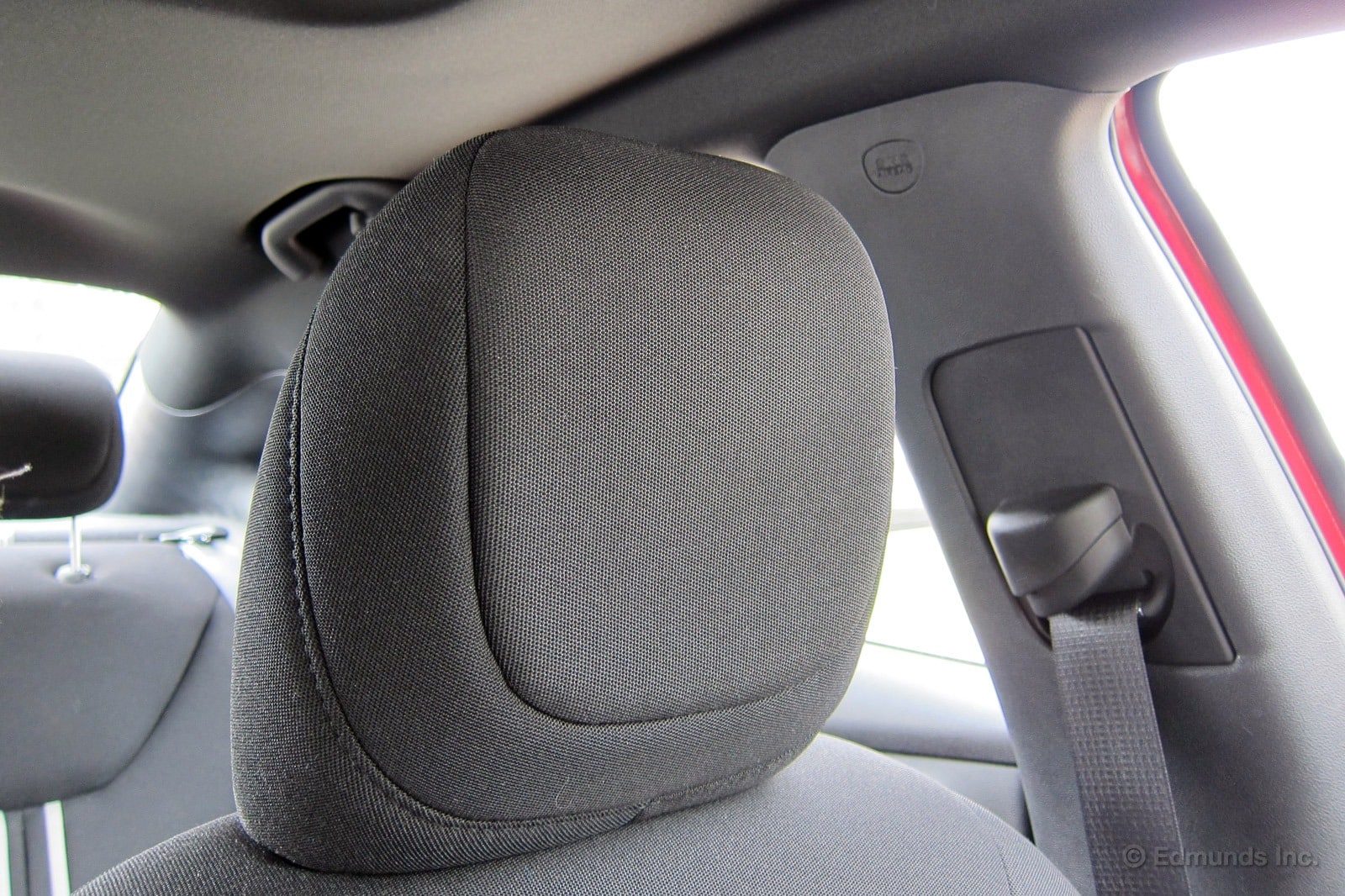
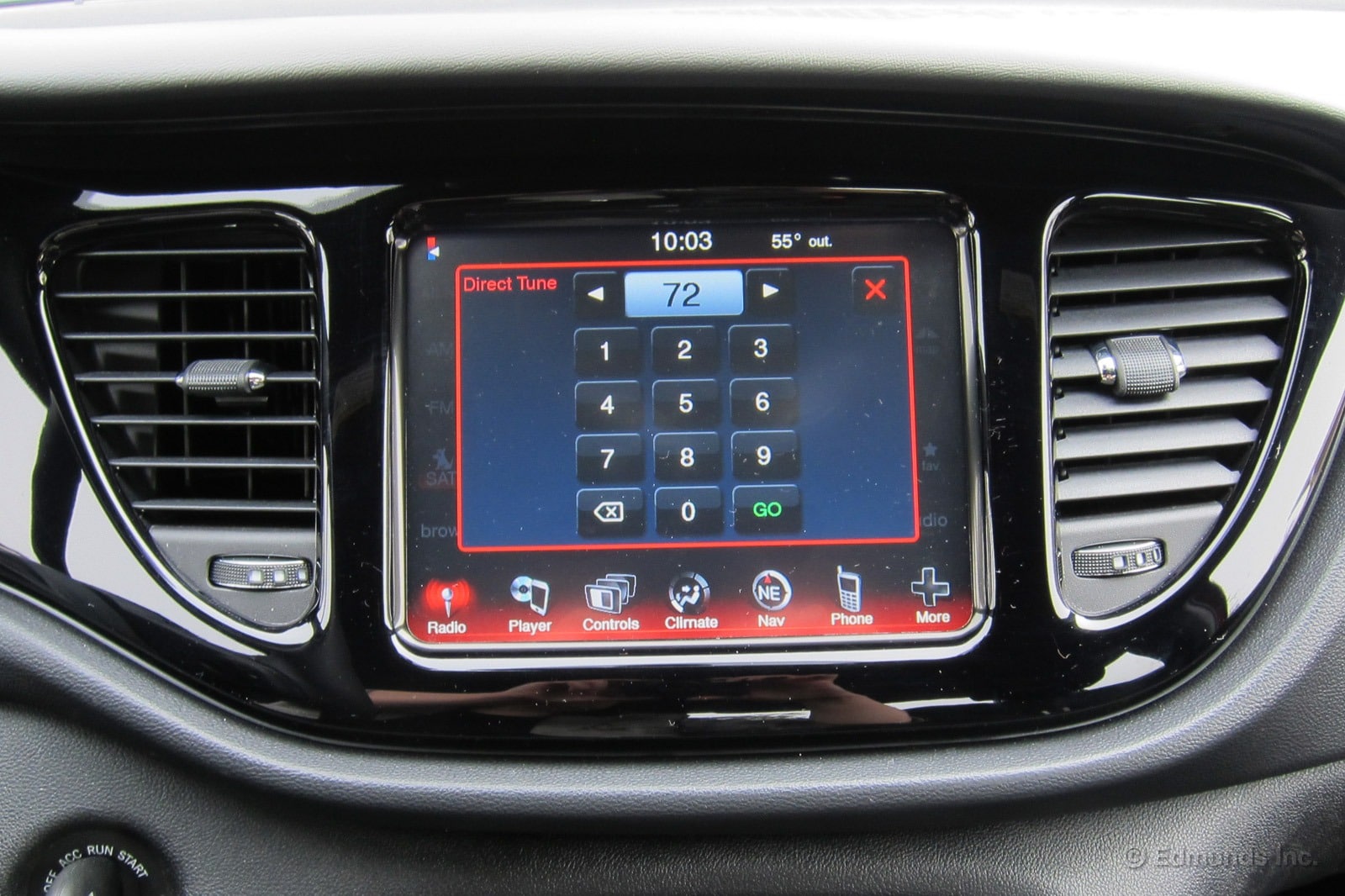
Here's a nice feature on our long-term Dodge Dart's audio system. You can type the radio station number that you want directly into this keypad. The same feature is also in our Jeep Grand Cherokee SRT8.
No more scrolling through lists of stations or categories. If you know your number, just go directly there.
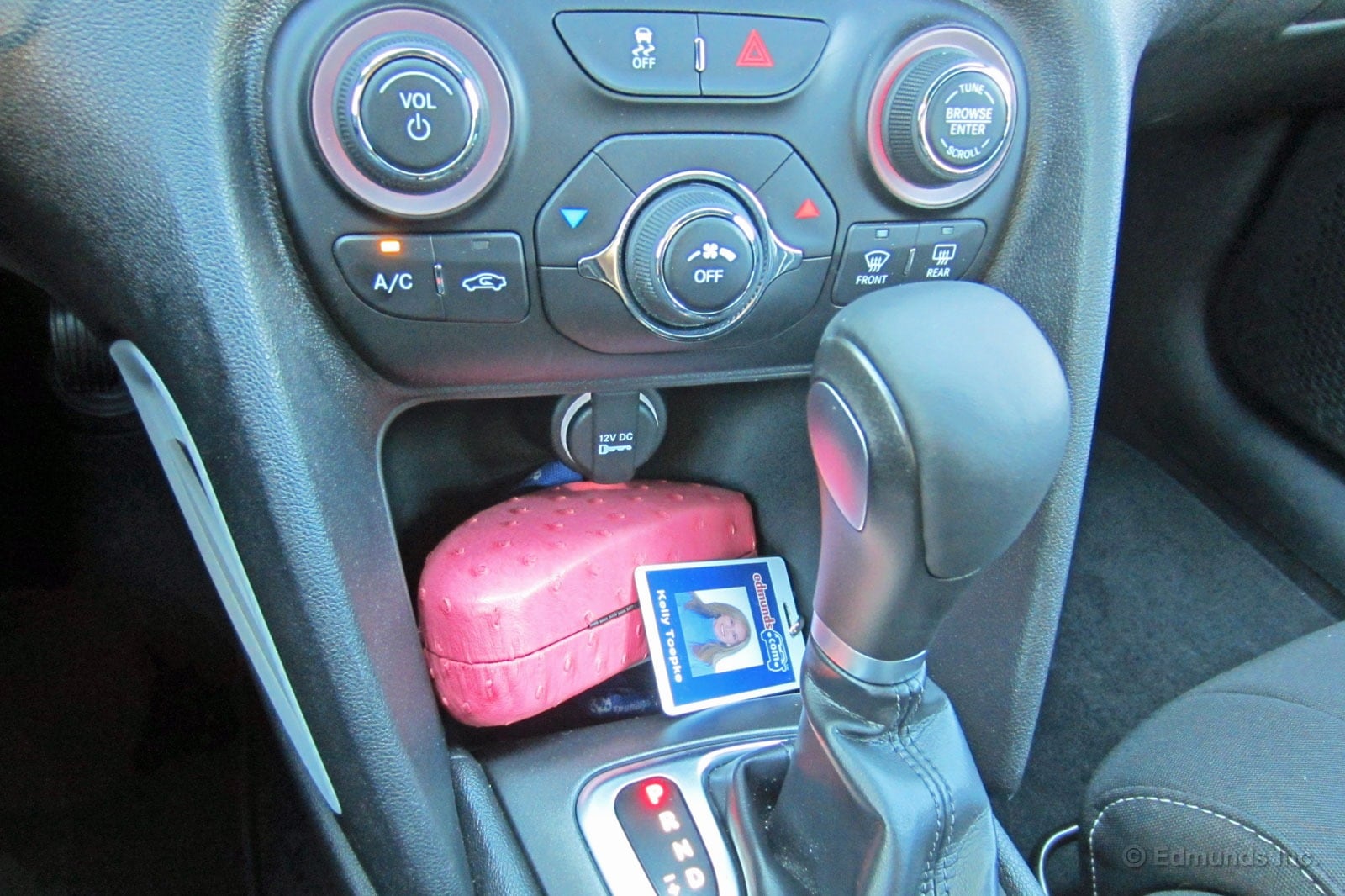
Sometimes it's the simple things that stand out. And with our 2012 Dodge Dart, I noticed immediately the convenience of the deep storage cubby at the bottom of the center stack.
Any space that can hold my ridiculously over-sized sunglass case gets my vote.
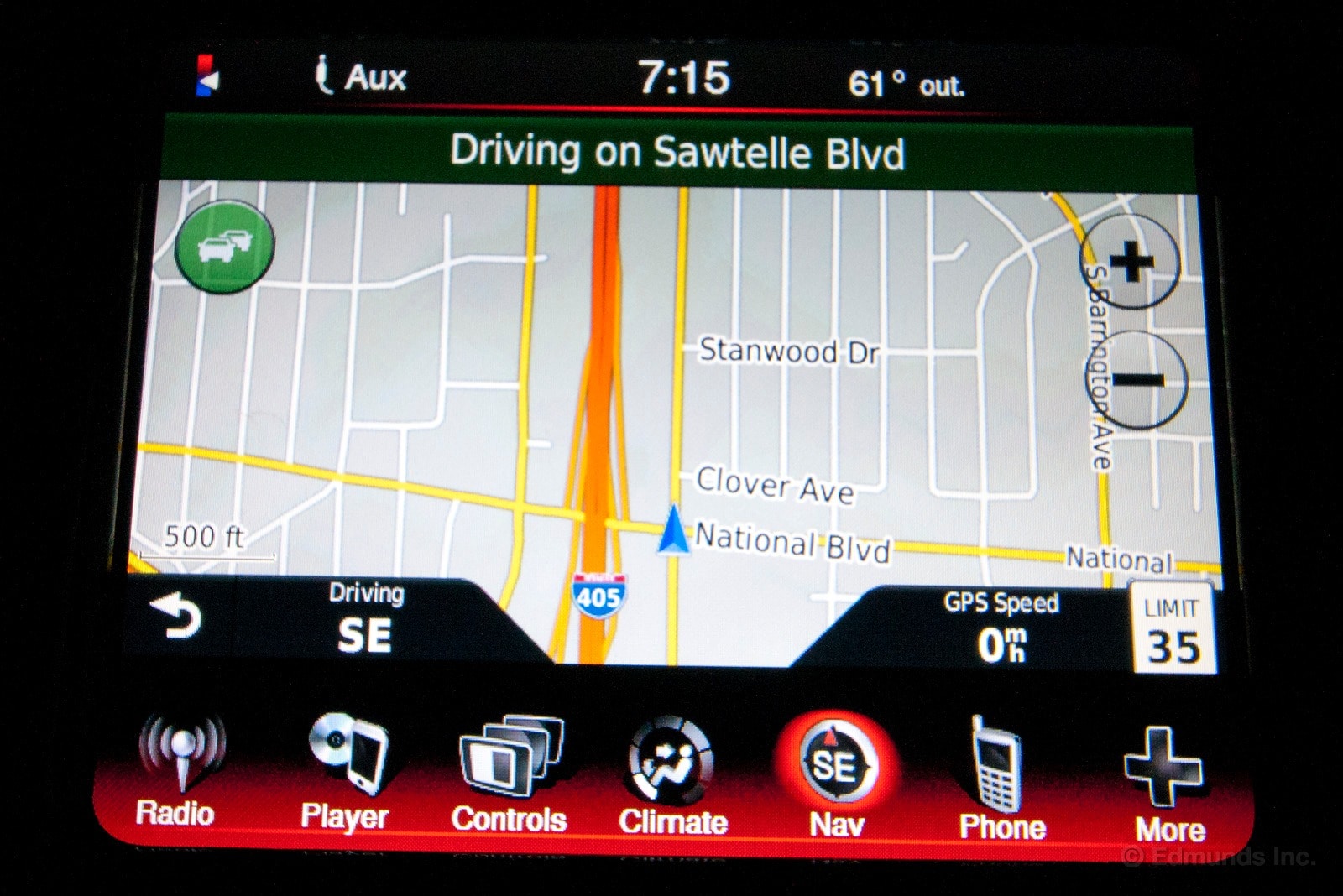
When I drove our long-term 2013 Dodge Dart SXT Rallye home last night I noticed that the GPS seems to know the speed limit wherever I'm driving. A small, practical version of me wearing all white and sporting a halo popped up on my left shoulder and said, "Hey! That's cool, especially at night when signs are hard to see."
What happened next may have changed my mind about this feature...
The light turned green, I drove on and soon noticed the 'GPS Speed' next to the 'Limit' sign had gone from white to red. Another small, very impractical and paranoid version of me wearing all red, carrying a pitchfork and sporting a cape appeared on my right shoulder and yelled at me, "Hey! They're tracking you! We don't like that feature at all! How can you turn it off?"
I'm still not sure which small version of me to listen to in this case but they both seem to have valid points. Do you want your GPS telling you that you're going 36 mph in a 35 zone, or is it overkill?
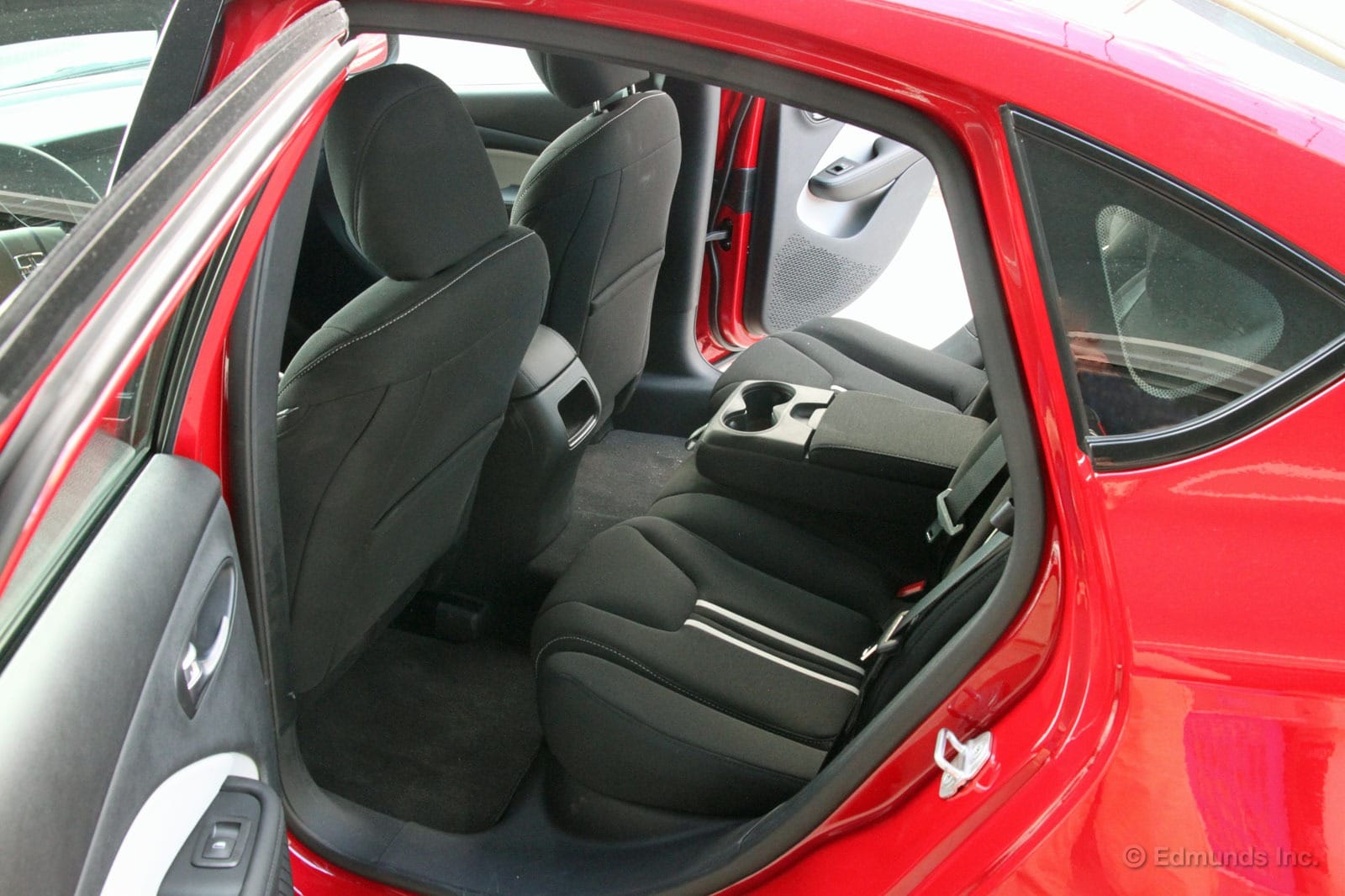
How spacious is the cabin of our 2014 Dodge Dart?
Here's a brief comparison of interior measurements between the Dart and the well-known midsize Honda Accord and the compact Civic to help you place it in your mind.
|
Dodge Dart
|
Honda Accord
|
Honda Civic |
|
|
Front head room:
|
38.6 in.
|
39.1 in.
|
39.0 in.
|
|
Front hip room:
|
54.8 in.
|
55.6 in.
|
50.5 in.
|
|
Front leg room:
|
42.2 in.
|
42.5 in.
|
42.0 in.
|
|
Front shoulder room:
|
58.2 in.
|
58.6 in.
|
56.6 in.
|
|
Rear hip room:
|
52.6 in.
|
54.7 in.
|
51.4 in.
|
|
Rear head room:
|
37.0 in.
|
37.5 in.
|
37.1 in.
|
|
Rear leg room:
|
35.2 in.
|
38.5 in.
|
36.2 in.
|
|
Rear shoulder room:
|
56.1 in.
|
56.5 in.
|
53.3 in.
|
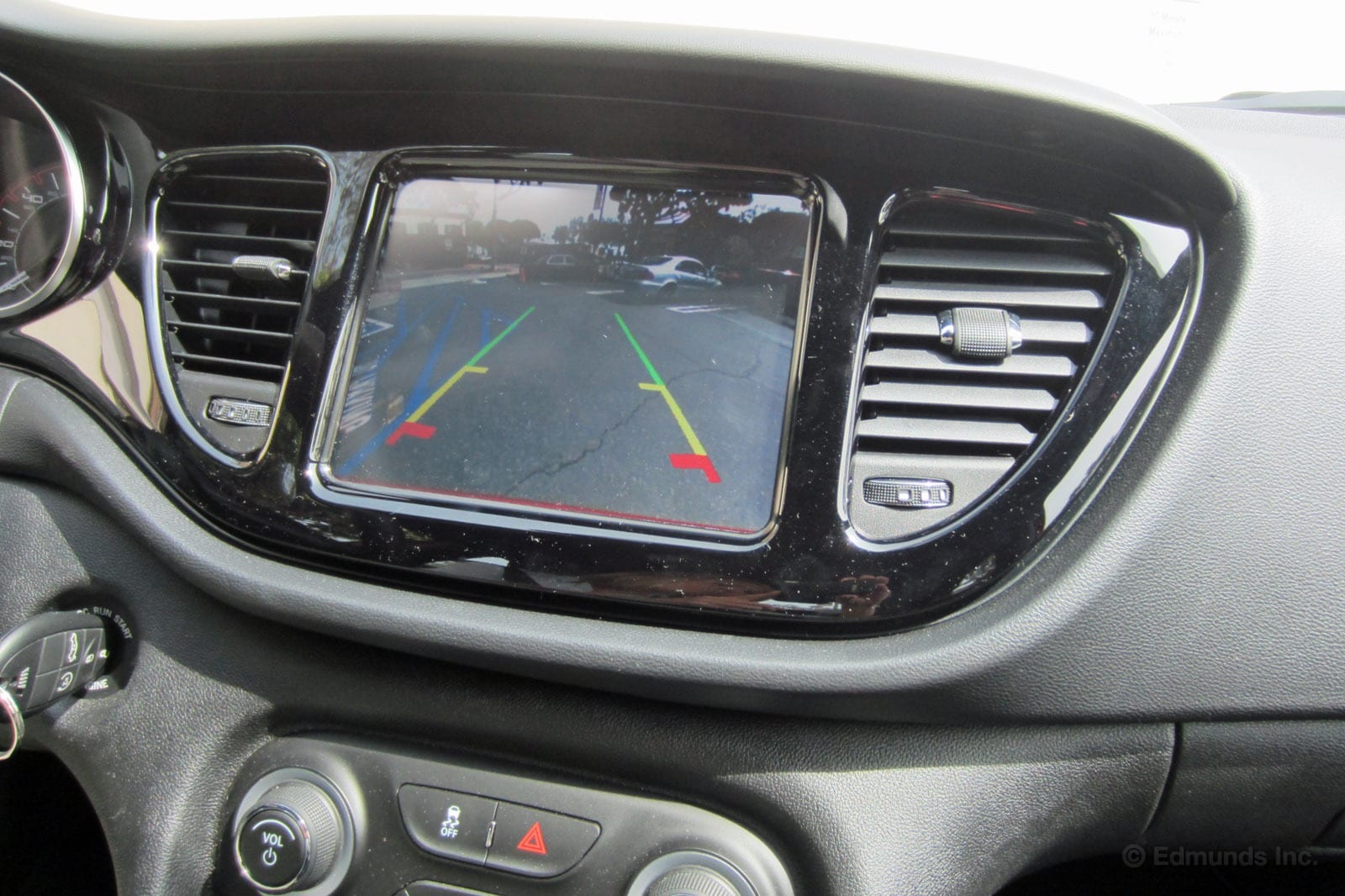
Rearview cameras are getting better and better, and our 2013 Dodge Dart's system is a good example of how far they've come on non-luxury vehicles.
The view offered by the sedan's back-up camera paired to an 8.4-inch display screen is fantastic.
No excuse left for backing into that curbside trash can.
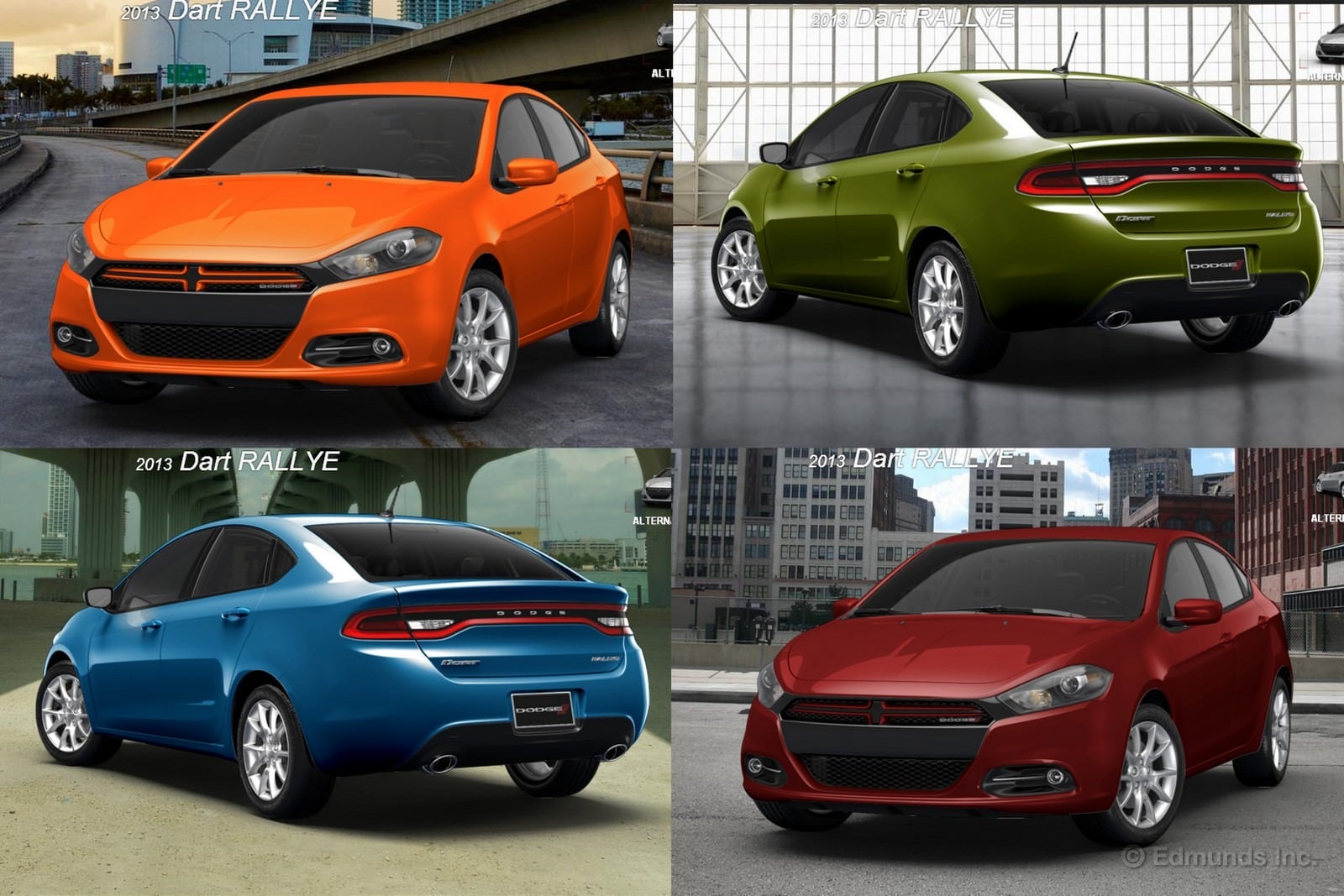
I do happen to like the exterior styling of Dodge's new Dart. OK, it doesn't exactly have the presence of a Challenger SRT8, but there are some distinctive elements that help it stand out in a parking lot, such as the crosshair grille and the optional LED surround taillights. And overall it looks respectably sporty, as a Dodge should.
The Dart also comes in some exterior colors not typically found in the small sedan class. They're not going to be for everyone (Citrus Peel and Header Orange being the most obvious, and pictured above) but they do further help the Dart stand out.
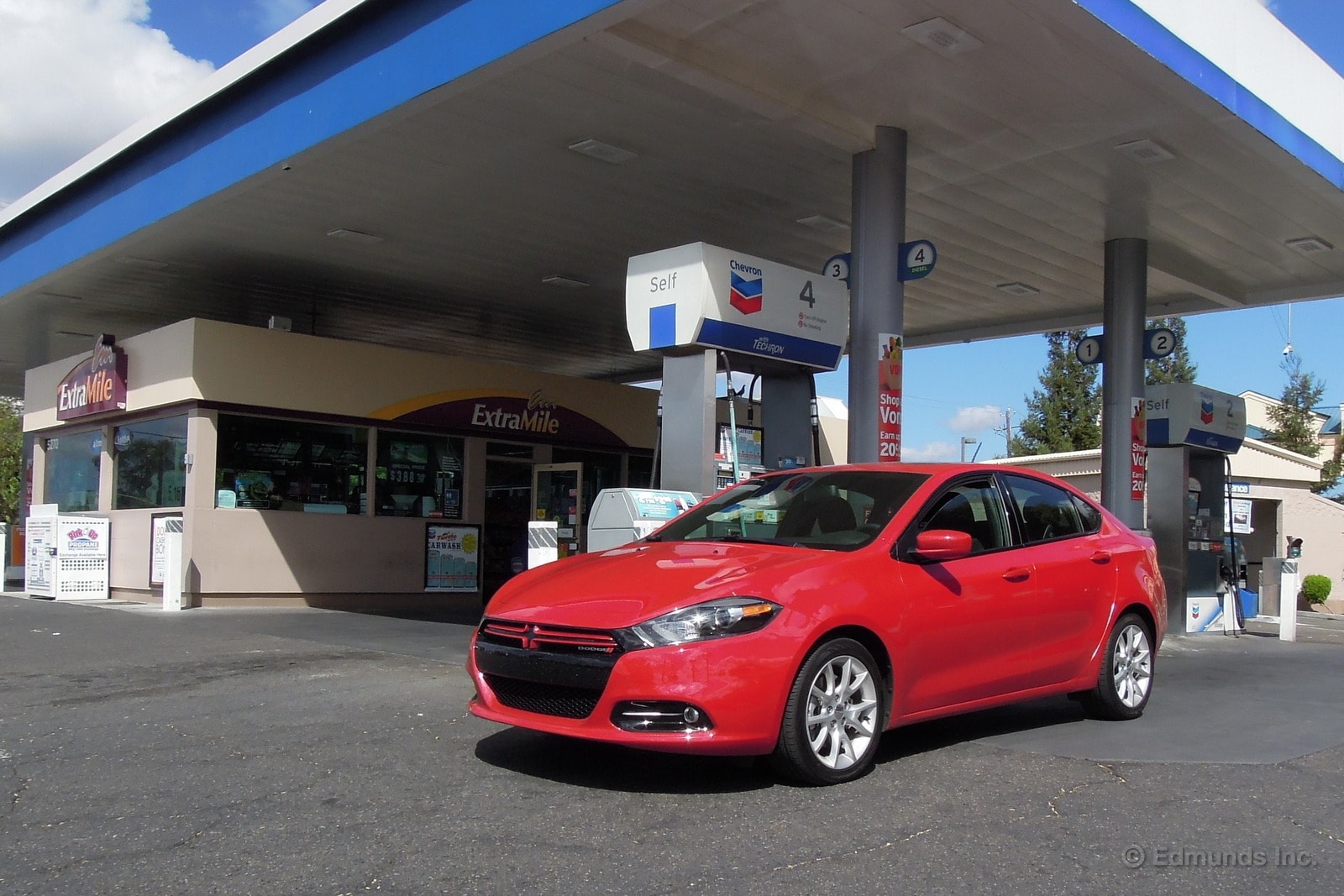
We added close to 2,000 miles to our 2013 Dodge Dart during March. The miles were added both from commuting around Los Angeles and from some long-distance highway driving around California. The result for the month of March was an average of 28 mpg.
While this is an improvement on our lifetime average of 26.9 mpg, it's still below the EPA's 31 mpg estimate for combined driving.
Worst Fill MPG: 21.6
Best Fill MPG: 33.1
Average Lifetime MPG: 26.9
EPA MPG Rating (City/Highway Combined): 31
Best Range: 384 miles
Current Odometer: 5,435 miles
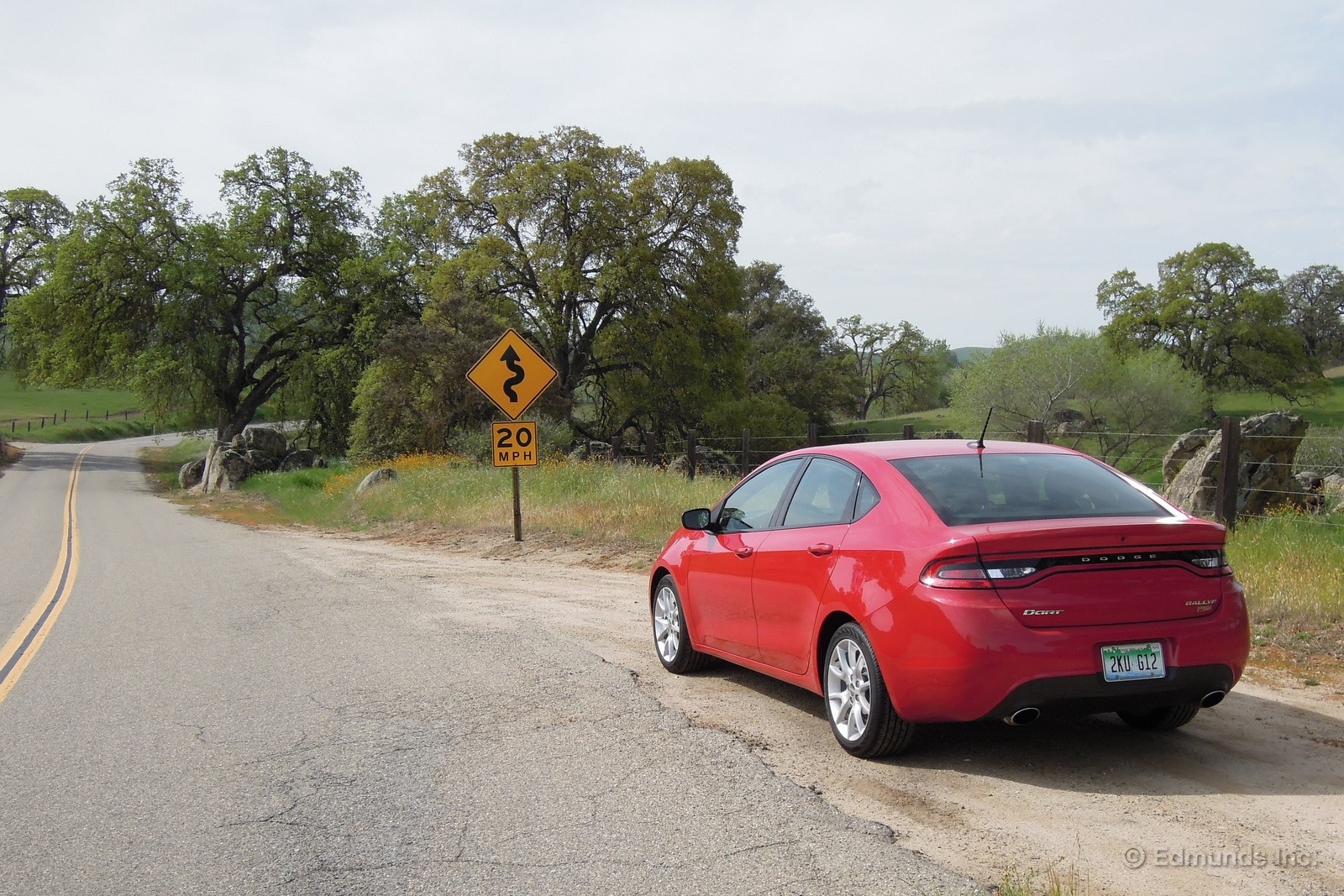
We've generally written nice things about the 2013 Dodge Dart's handling capabilities. In our road test, for instance, we observed that the Dart "is surprisingly satisfying to thread through a smooth canyon road if you're just trying to make brisk work of it and not set a time-to-distance record." But I've also seen some feedback elsewhere claiming that the Dodge is a little more ho-hum. Curious to find out for myself, I drove our long-term Dart on a local, curvy road.
Though I can see both viewpoints, overall I came away from my drive a little underwhelmed. On the positive side, the Dart felt stable once I had turned into to a corner and the (otherwise softly tuned) suspension had set. Grip is modest, but there's certainly hope for an eventual Dart with stickier tires (the forthcoming GT).
However, I've also driven a couple other long-term test cars recently on the same road, specifically the (now departed) Mazda 3 and Subaru Impreza. I recall both cars being superior to the Dart in terms of handling. Mostly, the Dart just drives bigger and heavier than I thought it would. It shows up on the spec sheet (it is longer, wider and heavier), but it also has to do with the car's steering, which requires more effort compared to the Mazda's but doesn't make any notable payoffs in terms of communication with the road.
Overall, I'd say the Dart handles adequately for the segment it competes in. But it's more of a mid-pack player than a handling standout.
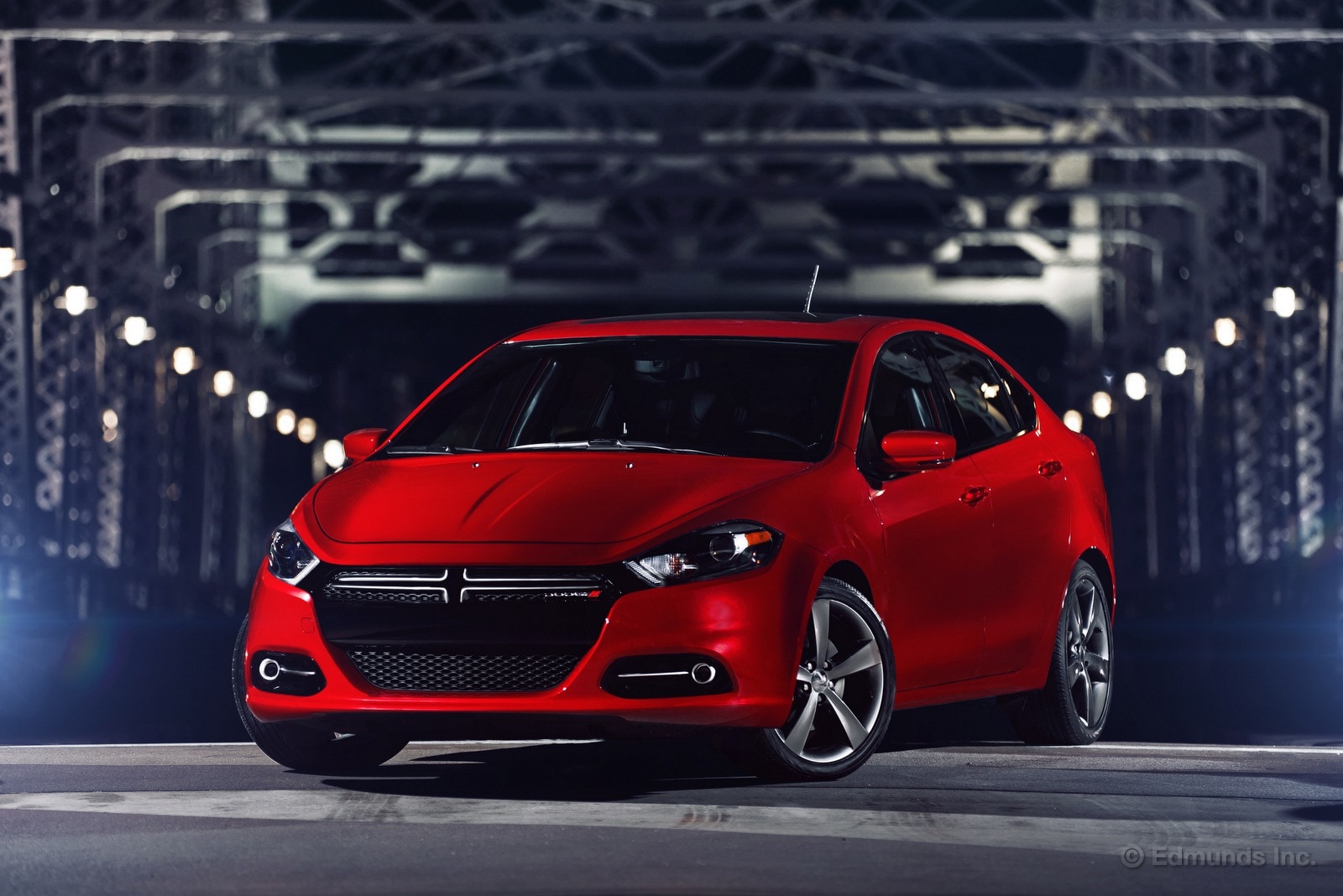
If you've been following news of the Dodge Dart (you have, haven't you?) then you might know that when Dodge debuted the car to automotive journalists, it said a sporty R/T model would be coming in the fall of 2012. The R/T, however, proved to be MIA.
At the beginning of this year though, Dodge announced a GT trim would be coming, and it listed pretty much the same equipment as the promised R/T: a 184-horsepower, 2.4-liter engine, a six-speed manual or automatic transmission, a sport-tuned suspension and special interior and exterior trim.
Now, it's said the GT will be out in the "second quarter of 2013," which would be soon. And if I were thinking about buying a Dart, I'd wait until I could test-drive the GT.
Sure, I haven't driven it yet. But at least on paper, I think I'd prefer the GT to our long-termer. The additional power of the bigger engine isn't substantial, but overall the engine might suit the character of the car more. The same goes for the GT's sport-tuned suspension. And, of some irony, the automatic transmission would also likely be preferable to the dual-clutch automated manual transmission in our car that's won little praise around here.
You also get some of the Dart's best stuff as standard, including the 8.4-inch touchscreen and a reconfigurable 7-inch display in the gauge cluster.
Pricing has been announced ($20,995) but so far the car still wasn't up on Dodge's Web site configurator as I wrote this.

We typically aim for 20,000 miles on our one-year tests of long-term cars. We started our test of the 2013 Dodge Dart back in January, and we just passed 5,000 miles, so we seem to be on track.
The Dart's maintenance schedule is based on an oil life monitor, and so far it's yet to indicate that we need to perform any service. Currently, I'm in the midst of using our Dart for a 700-mile road trip with my family. I'll be reporting on that in the next update or two.
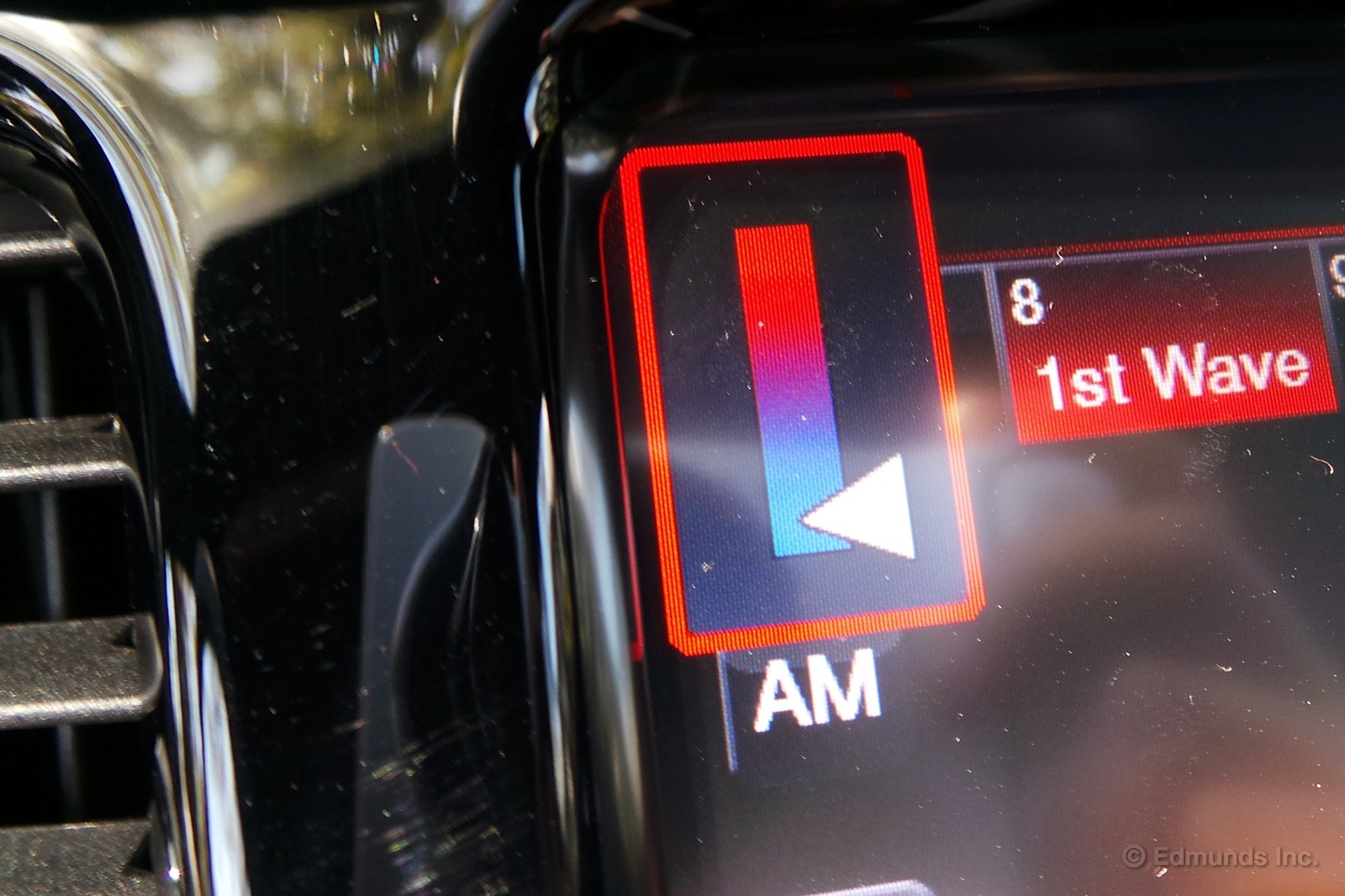
In an earlier post, Editor James Riswick noted how unnecessarily complicated the air-conditioner controls of our 2013 Dodge Dart are. But I'd like to point out how the temperature controls themselves are lacking in a crucial detail: degrees. Looking at this screen how can you tell how warm or cold you are making it with that slider? I mean, is this a thing now?
Maybe it's just me. I like a visual indicator telling me that I'm making the cabin 70 degrees instead of 80. Does this lack of information bug you, too?
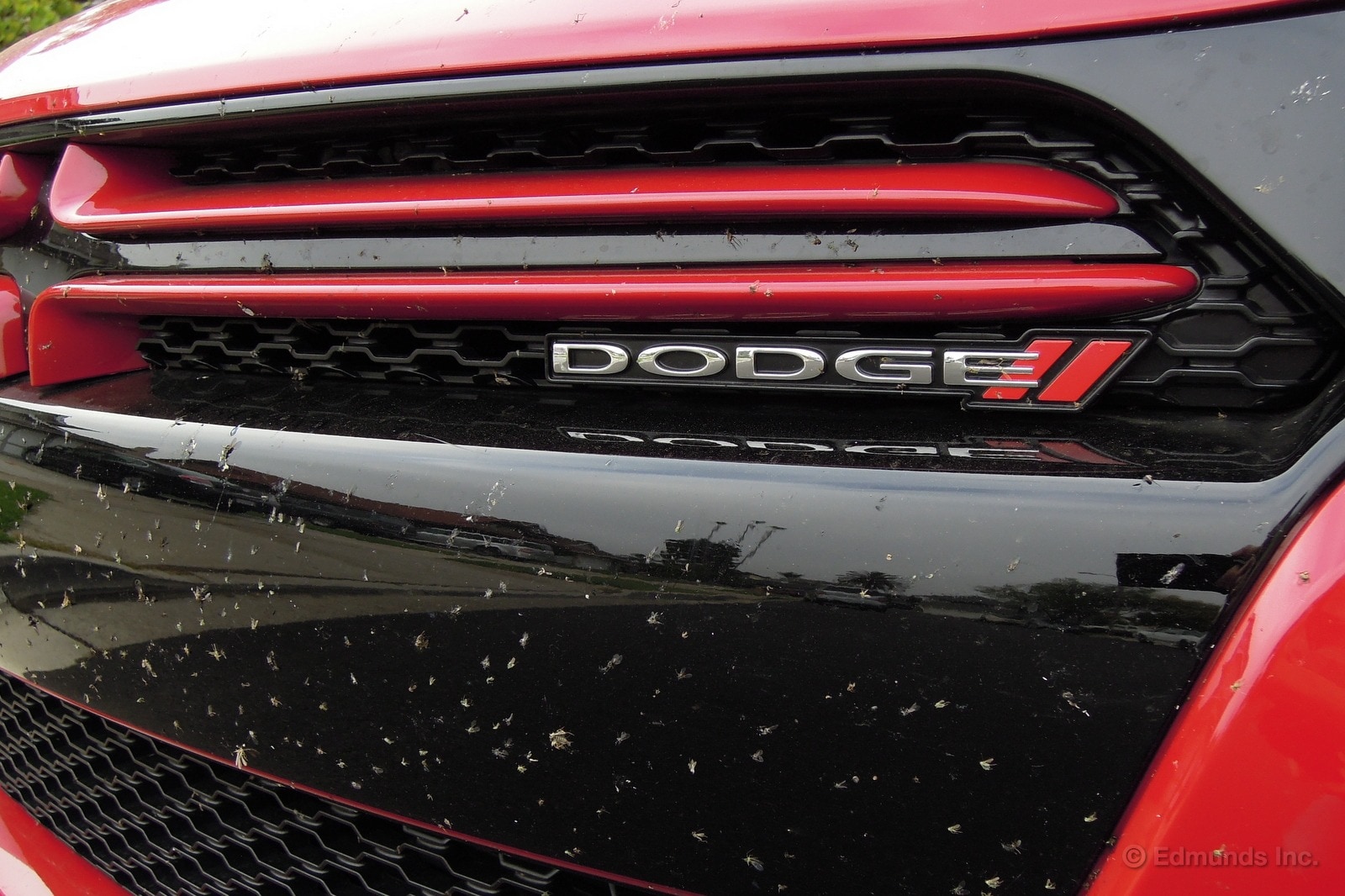
"This is what we're taking?"
This was my wife upon seeing the Dodge Dart in our driveway. We were about to start packing for a four-day trip to visit her parents for Easter. "Yep. It's a Dodge Dart," I replied.
Somewhat disdainfully, my wife's eyes glanced over the car's lines some more. "It's kind of small. You're sure it's going to hold all our stuff?"
"It'll fit," I said confidently, while secretly wondering whether it actually would.
And thus began a 700-mile road trip test of our long-term 2013 Dodge Dart.
With two small children and a wife who doesn't understand the term "pack lightly," it's always a challenge preparing for road trips. No doubt something like Dodge's Journey or Durango would make things easier. But the Dart has a reputation of being roomier than the typical small sedan, so I figured this would be a good test.
The first order of business was fitting as much of our gear as possible into the trunk. At 13.1 cubic feet, the Dart's trunk is merely average for this class of car. I did manage to fit in a decent amount of luggage, including a large suitcase, two small suitcases, two duffel bags, a computer laptop bag, a portable crib, and a garment bag. But it took some mad Tetris skills to make it happen.
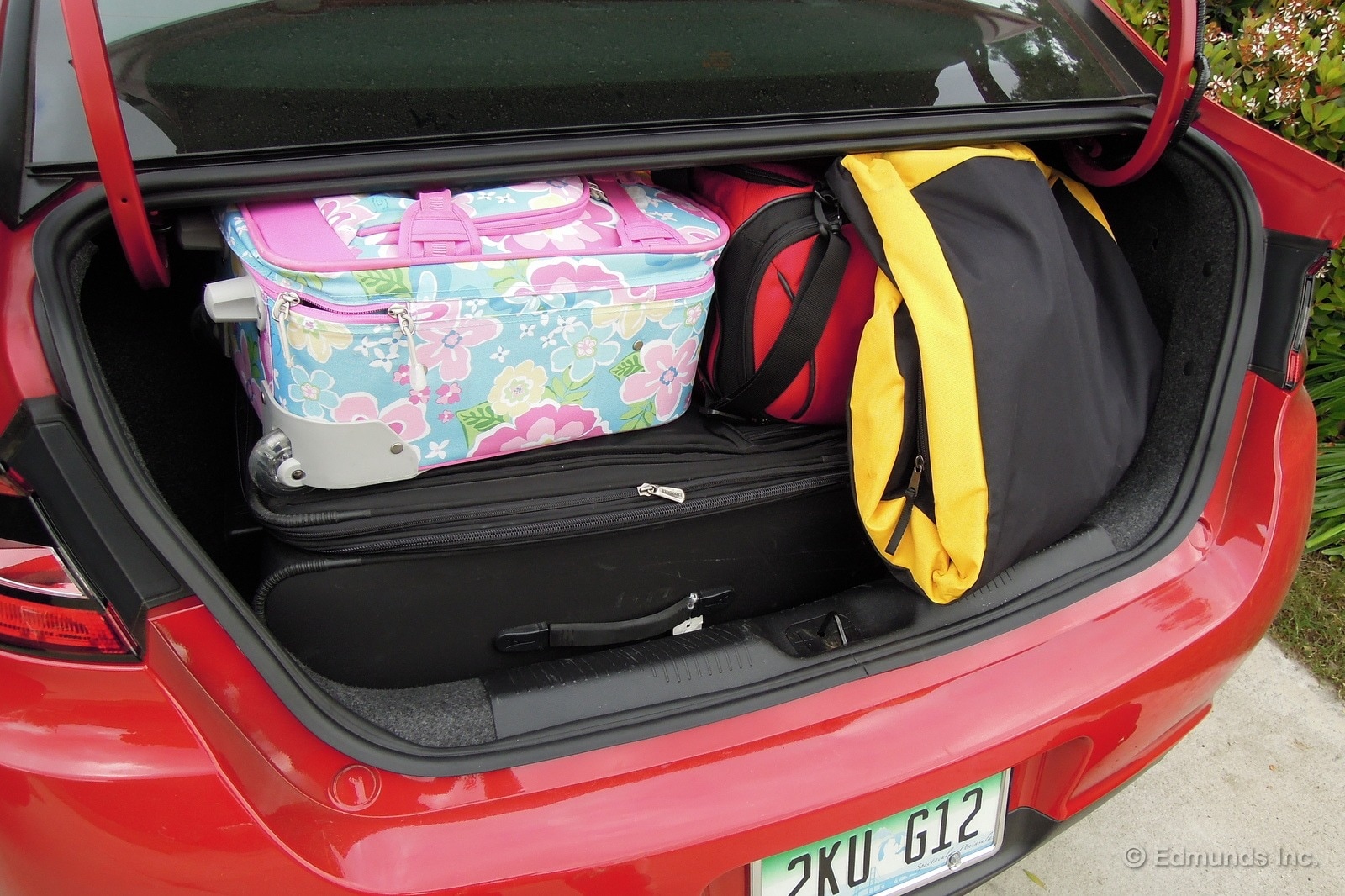
Unfortunately, I had neglected to read James' "Beware of Trunk Spikes" warning and consequently got a nice scrape on my hand when moving some stuff around at the top of the trunk area.
Even with the trunk full, I still had to put a variety of items in the back seat. (And no, I'm not just talking about our kids.) Here the Dart's slightly bigger than normal size came in handy, as I was able to utilize the middle seat area as well as the floor while still leaving the front seats in their preferred positions. Installing a front-facing child safety seat and a booster seat were also no problem.
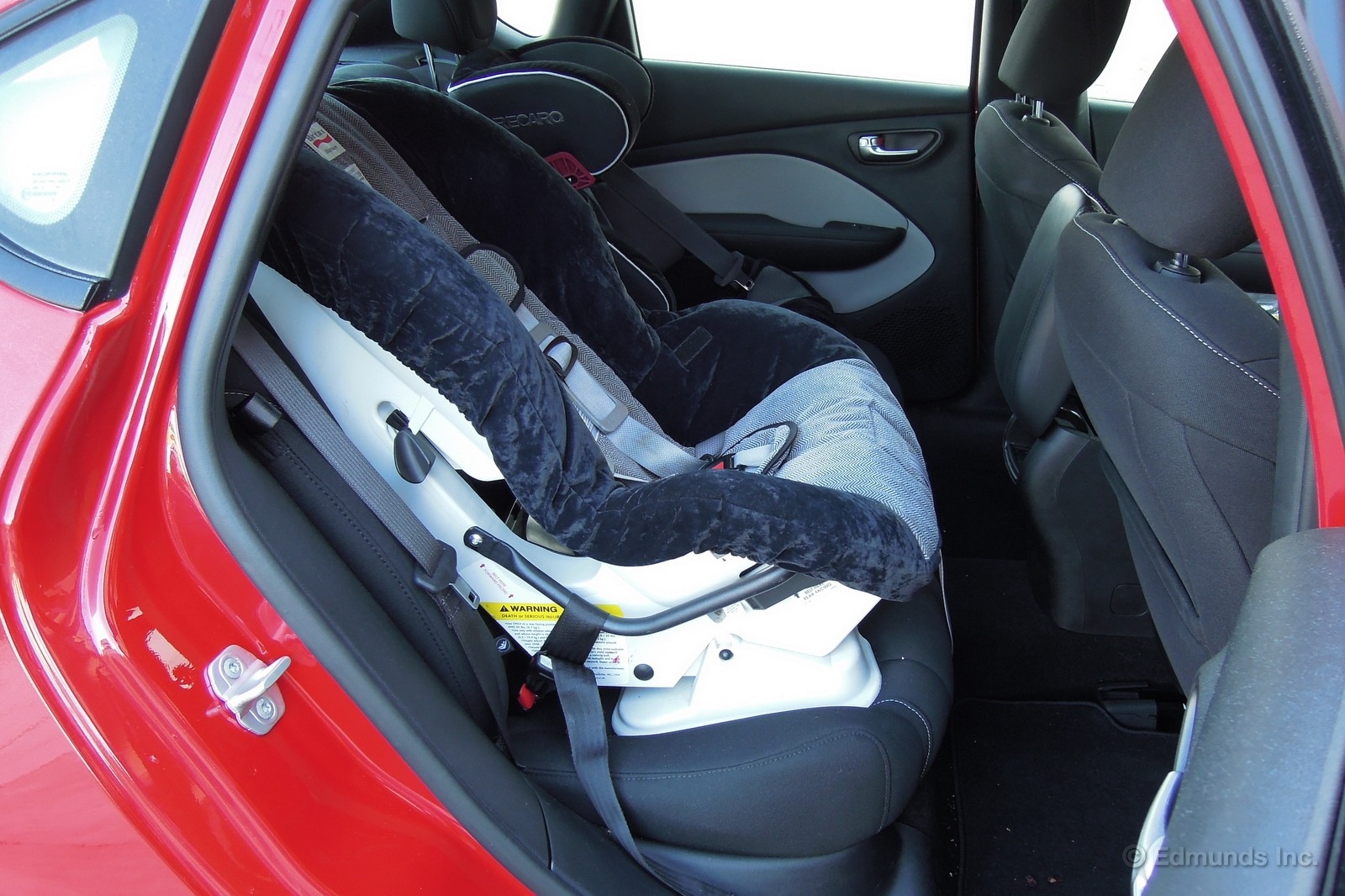
In the end, we were able to fit everything we wanted. It was cozy, yes, but also showed once again that you don't absolutely need a big crossover SUV for such things.
In my next update I'll cover how the Dart drove.
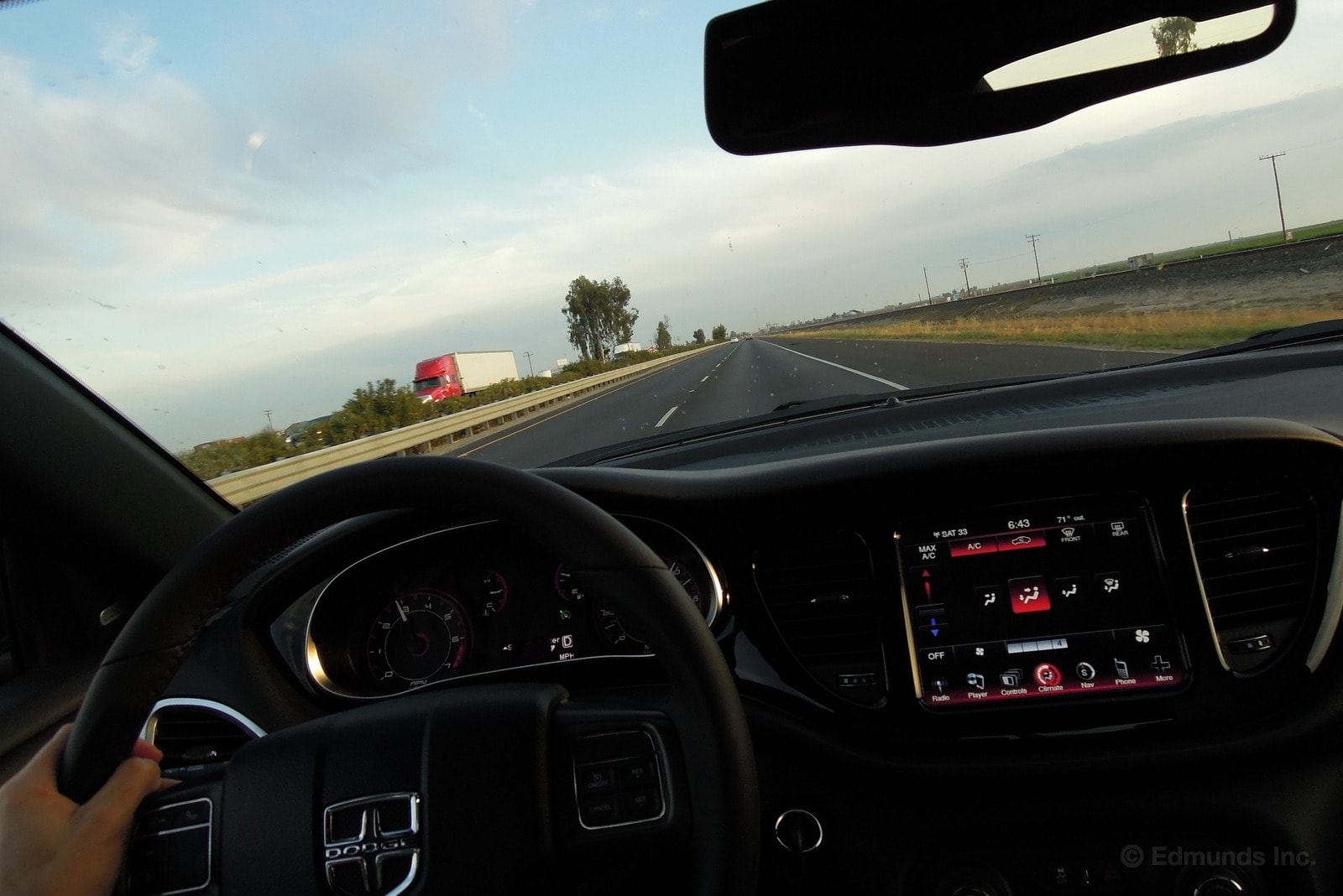
In a previous update I wrote about how our 2013 Dodge Dart successfully took on my family's large collection of stuff for a four-day, 700-mile road trip. For this installment I've got a report on how well the Dart drove.
As a highway cruiser, the Dart is respectable. Its best quality is by far its ride quality. As we noted previously, it feels substantial behind the wheel as the suspension and tires strike a good balance between compliance and control. In that sense the Dart is comfortable and soaks up bumps, but it also feels like it's at the ready should you need to make any emergency maneuvers.
Overall, I was OK with the seat comfort for my driving time, which was 4 to 5 hours each way. Wind and road noise were low, though I found myself noticing engine noise more than I would expect. While its power output is fine, our Dart's turbocharged 1.4-liter engine just doesn't sound very refined.
Fuel economy was underwhelming as well, or at least in comparison to the car's EPA estimates. For the trip, I averaged 30.8 mpg. Considering that my trip was mostly highway miles, I would have hoped for something closer to the car's 37 mpg highway estimate.
On the upside, the large touchscreen is great, providing crisp navigation maps and large, legible fonts for the audio information. I also liked the sound quality of the Alpine stereo and useful amount of interior storage.
Overall the Dart was a mixed bag. Its roomy interior came in handy for sure, and I appreciated the ride quality. For long road trips, those are very important qualities in my opinion. But the issues of refinement and fuel economy also kept me from truly liking the car as much as I wanted to.

I've been dealing with the arduous task of getting my Jeep Cherokee to pass a California smog test. It's been throwing codes for a while now, specifically blaming the first bank of catalytic converters for inefficiency. The Cherokee has a lame design that uses dual exhaust manifolds with a pre-cat attached to each. These then feed into a third cat. This design also uses four oxygen sensors. Sweet.
The search for California-approved, direct-fit replacement pre-cats led me to the OEM piece, worth a cool $1,700. An aftermarket Magnaflow piece was exceedingly more reasonable, but didn't line up correctly with the Cherokee's manifold design, and required a trip to FedEx for the return. Appropriately enough, it was one Chrysler vehicle helping another.
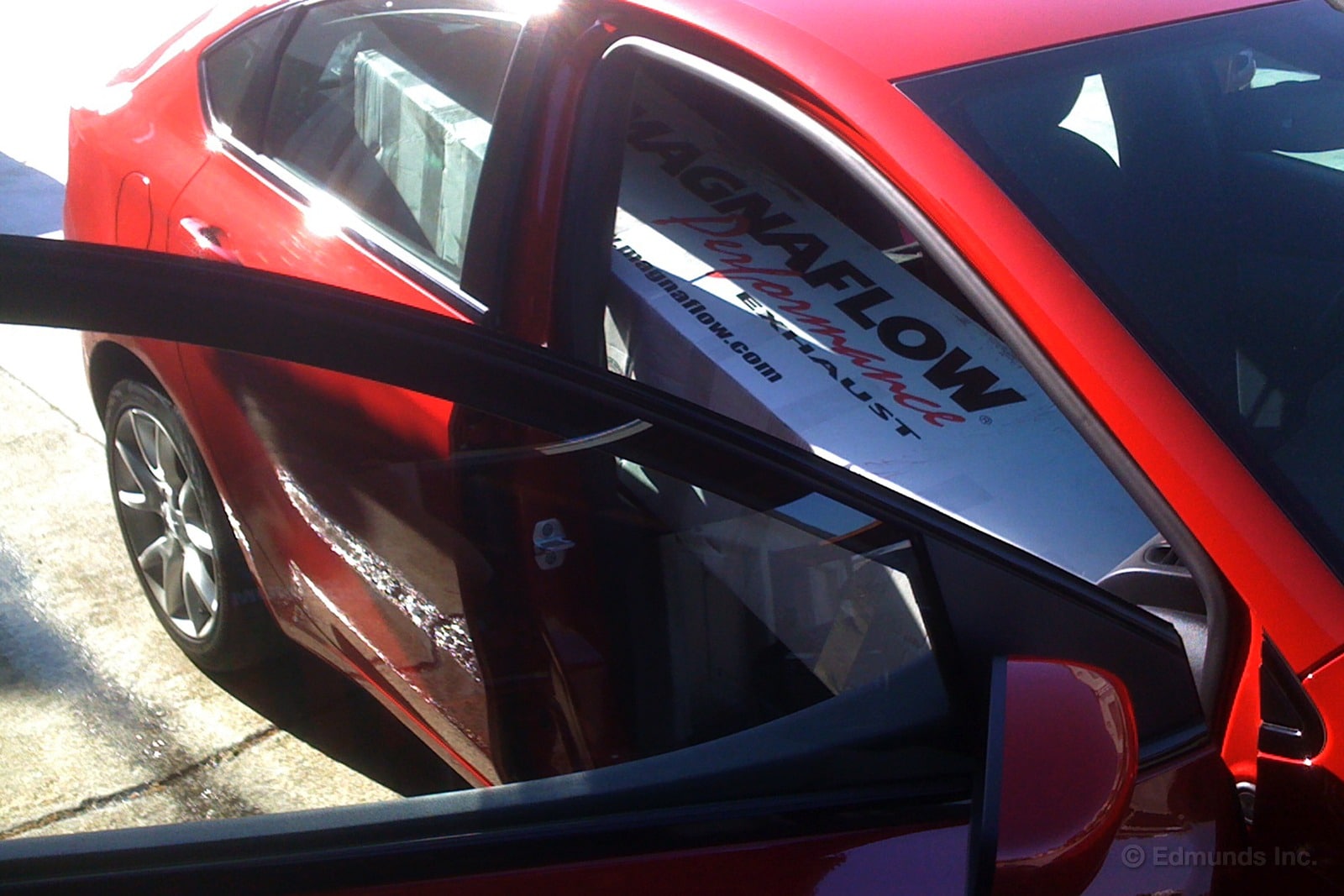
I was certain I could slide the big pre-cat assembly (canisters and runners) box in through the trunk, but I was stopped by the angle of the rear seatbacks, which don't fold flush enough. But for about an inch of lip extending down from the rear deck — hard, inflexible plastic — I might've been able to force the box through with some shimmy and slide.
Plan B worked better: impressive enough cabin volume to load the box sideways through the passenger door, then turn it 90 degrees and lay it on the passenger seat.
If you own a Cherokee in the other 49 states, you've got no cat-converter worries. You can buy them all day from Eastern, Walker and a dozen other manufacturers. But Magnaflow is one of only a handful that has bothered to get an approval stamp from California's Air Resources Board, not a cheap process. Smog test standards have increased this year, and smog techs looking to stay in business are now scrutinizing engine bays and exhaust plumbing.
I'm normally quick to defend the Golden State's track record on air quality and environmental management, even when it costs me. But I admit, this has been a tiresome search just to keep the Cherokee on the road. The next trial involves some of Magnaflow's universal cats, also California approved, and could involve some tricky welding and flanging.
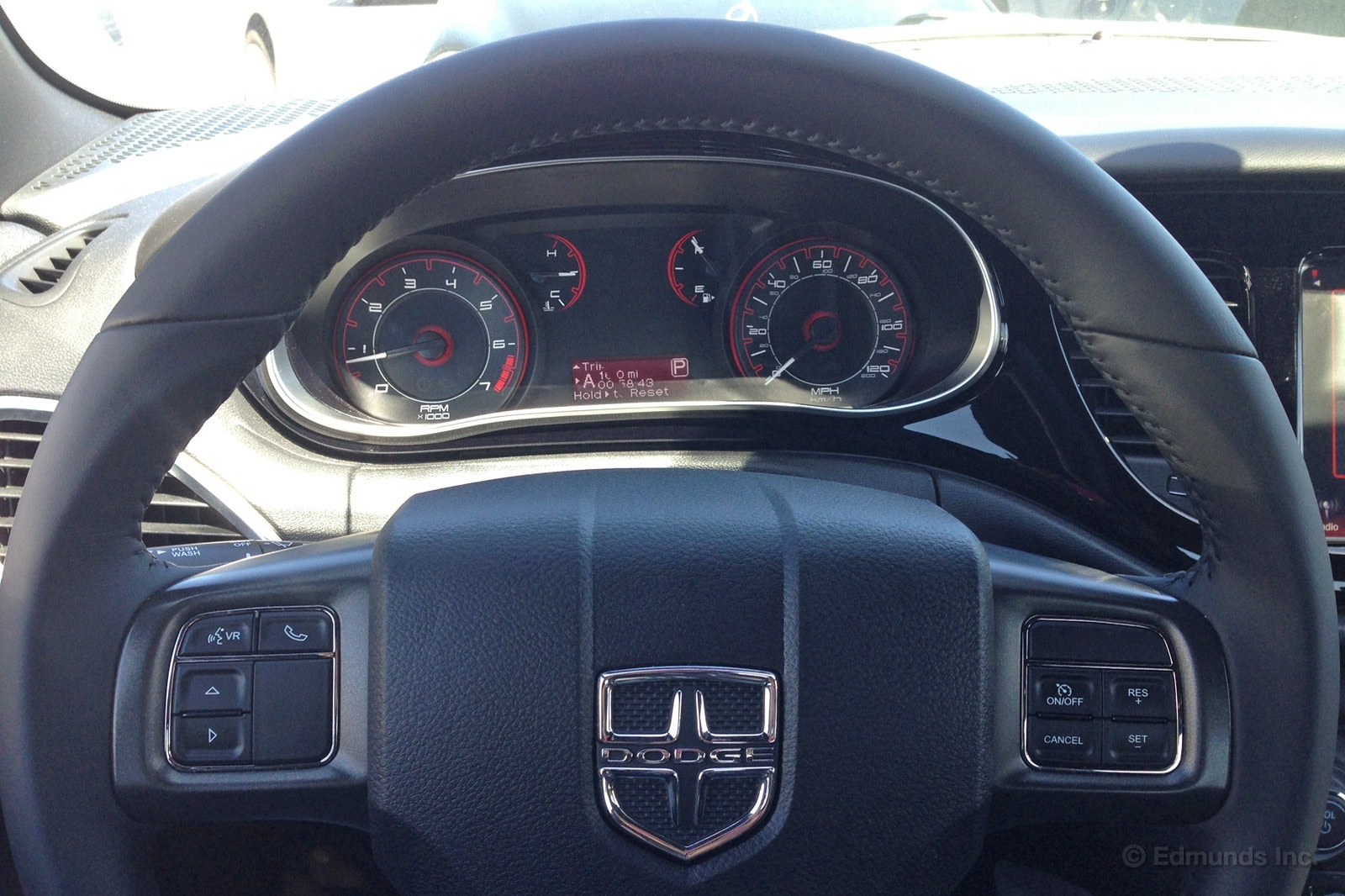
Confession: I'm very picky about how people drive. Basically, hands at 9 and 3, always pass on the left and always look ahead. Amazingly there's a bunch of people who don't know any of this. Cough::Angelenos::cough. Well, last weekend I was passenger to one such person. He drives with both wrists at the 12 o'clock position and also sticks to the speed limit (driving 70 mph in a 70-mph zone, but I tried not to be too mad at that since he probably was just worried about fuel economy). ANYway, you're probably wondering what this has to do with our 2013 Dodge Dart.
After four days of his driving, I needed to let loose, so I jumped behind the wheel of our Dart. Leaving work a bit early there was still some traffic, but it was light enough that I was able to dance around the slow drivers. I was impressed by how well the Dart handled itself, even if my esteemed colleague Brent Romans was underwhelmed by it in that respect. It may not have impressed him on the twisties but it didn't let me down when I just wanted to DRIVE around slow movers quickly.
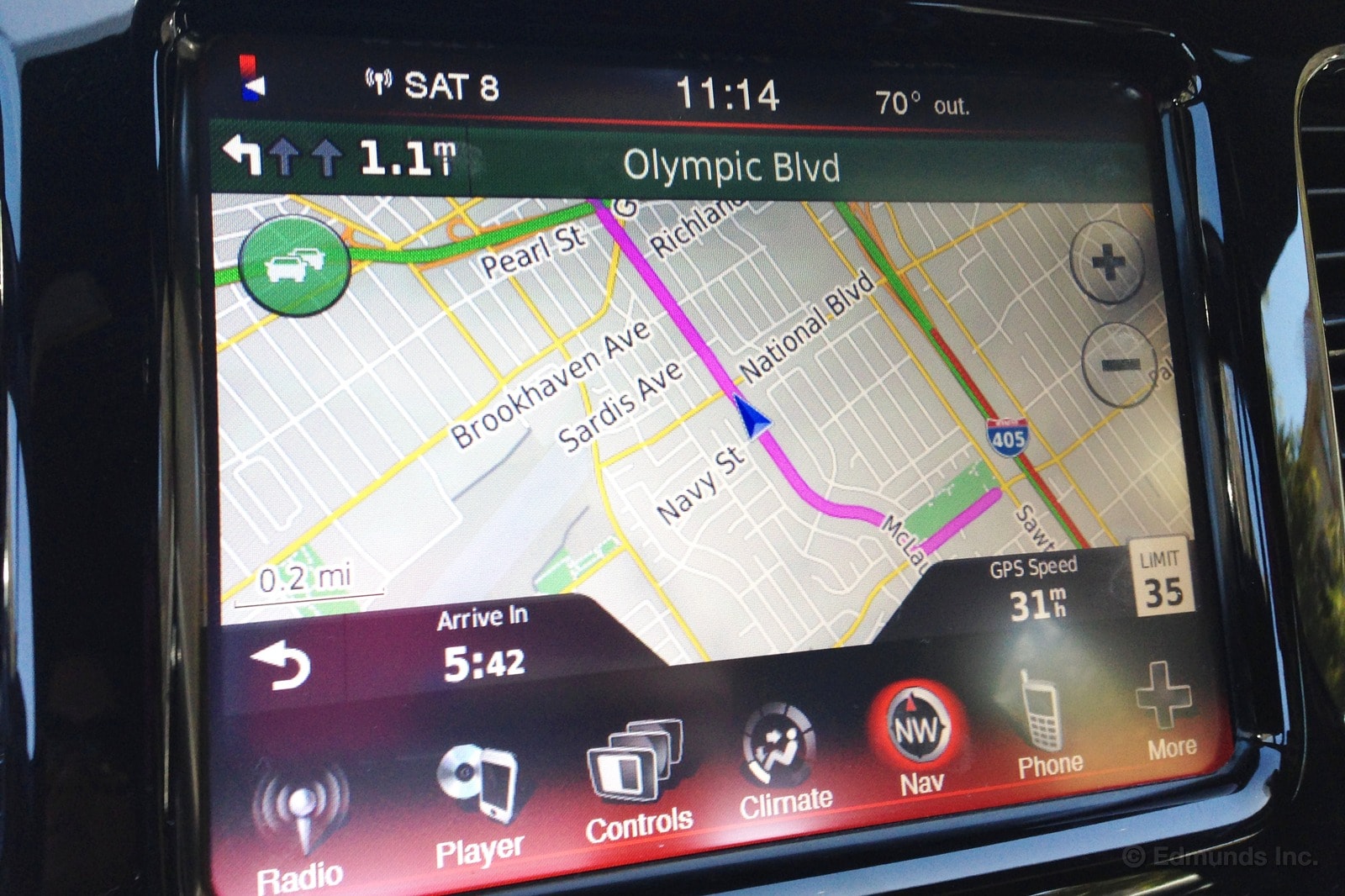
The other day I had to drive one of our editors down to Gardena, about 20 miles south of our Santa Monica headquarters. Problem was that this was during morning rush-hour. As I groaned at the sight of the black-and-red snake of death that loomed on Google Maps, I plugged in Edmunds' address into our 2013 Dodge Dart's navigation just to see how it works in this car. Having consulted Google Maps on my iPhone beforehand I kind of had an idea of what was the least congested way to go and was prepared to ignore the nav and have her reroute and adapt to my change of direction.
Amazingly as I started the trek back, the nav kept adjusting her directions, saying there was traffic up ahead so go here instead. She picked where I had originally decided to go. And then when earlier I made up my mind to take the 405, she offered up another less trafficky route giving me enough of a heads-up to make the change. She took me on surface streets and back on the freeway. It was like how I do for my boyfriend when he's driving and I'm the navigator consulting Google Maps. "That road is red so turn up here instead." She's definitely the best navigation system I've encountered thus far.
I remember our Mitsubishi Outlander had that feature, too, where it rerouted me to avoid traffic. But the one time I followed its directions it ended up being more trouble than it was worth so I never trusted it again. Not so with the Dodge Dart. I trust her nav skills implicitly.

If you were paying attention, you'll remember that a couple of months ago, Dodge launched its unique Dodge Dart Registry. Created to promote the Dart, the site allows participants to raise money toward the purchase of a new Dart.
This approach was certainly an innovative one on the part of Dodge, and now that innovativeness has been recognized. The Shorty Industry Awards honors the best brands, agencies and professionals in social media. The Dodge Dart Registry has won Dodge an award for best social media campaign in the automobile industry.
Some additional information, from the Shorty Awards website:
The launch of the Dodge Dart created a set of "New Rules" for the auto industry. And with Dart Registry, Dodge has created new rules for buying a new car.
It's the first time an auto company has created a crowd-funding platform to help people buy a new car.
It's also the first time that social media has been used to make the burden of buying a car more affordable to more people. A fund-raising goal can be any amount: from a down payment, to a few thousand dollars to make monthly payments more affordable, or even the full price of the car (if you have rich and generous family and friends).
Dart Registry launched on January 20, and registrants began signing up immediately. Some even had charitable goals. Portland animal welfare group The Pixie Project set up a registry, and USC's Zeta Beta Tau registered in hopes of raising enough funds to donate a new car to Meals on Wheels.
Since its launch, over 6,000 people have signed up for their own Dart Registry, spending an average of 11 minutes on the site.
What do you think of Dodge's unusual social media campaign?
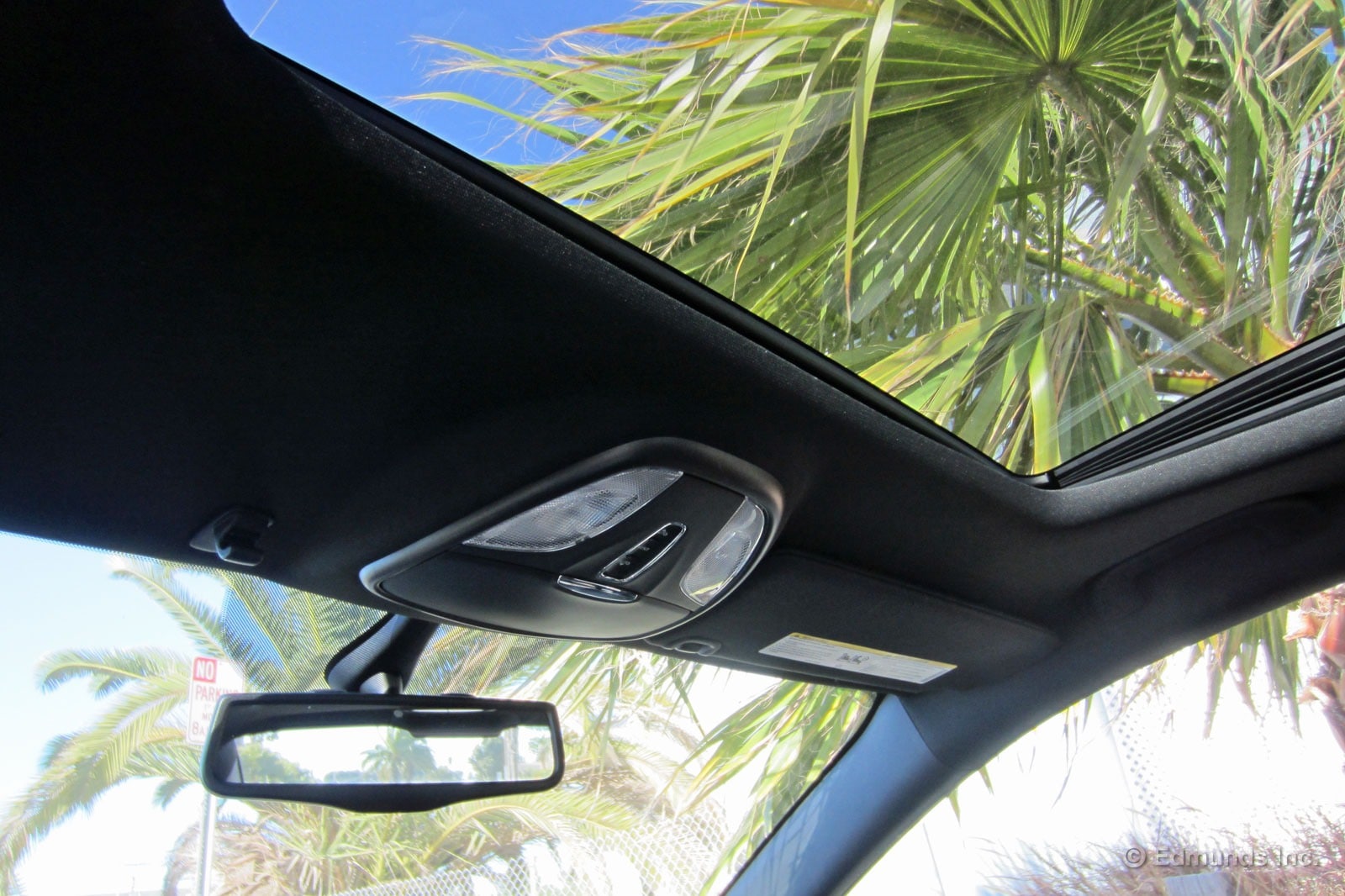
It was a bright, clear morning near the beach, and as I slid open our 2013 Dodge Dart's sunroof, I was reminded of a conversation I had years ago with a friend.
While car shopping, my friend confided in me that she didn't care what kind of car she bought as long as it had a sunroof.
I smiled, and bit my tongue.
Were you ever so attracted to one feature that it made you ignore the rest of the package?

A quick trip to Whole Foods resulted in one small shopping bag holding three 1-liter bottles and a few apples. I needed to make another stop on my way home, and figured the refrigerated liquids would be better off hiding in the trunk.
It was not until then that I realized there is no cargo net in the trunk. There are two good-sized hooks — one on each side — but they aren't ideal to hook a fabric bag.
I wrapped the handle around the hook as tight as possible. Luckily, no apples or bottles got loose on the way home.
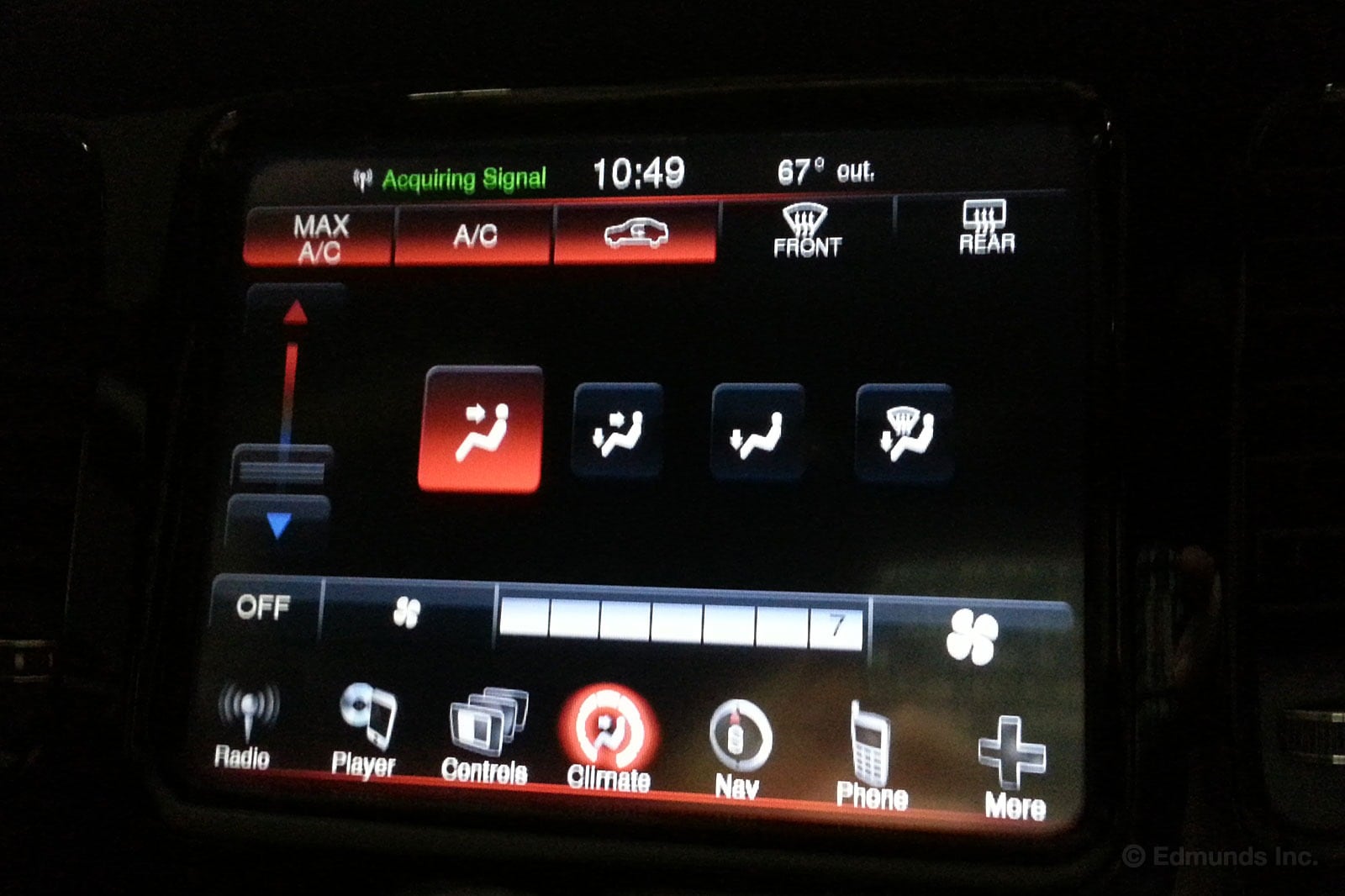
The ambient temp gauge only registered 79 degrees, and yet me n' The Kid never got comfortable.
A/C button pushed? Check. Temp adjusted down all the way into the blue? Check. Fan cranked up to max 7? Yep.
But after 10 miles, I was still sweating.
Photog Niebuhr will be driving it soon. I asked him to see what he thinks before assuming it needs a trip to the service bay.
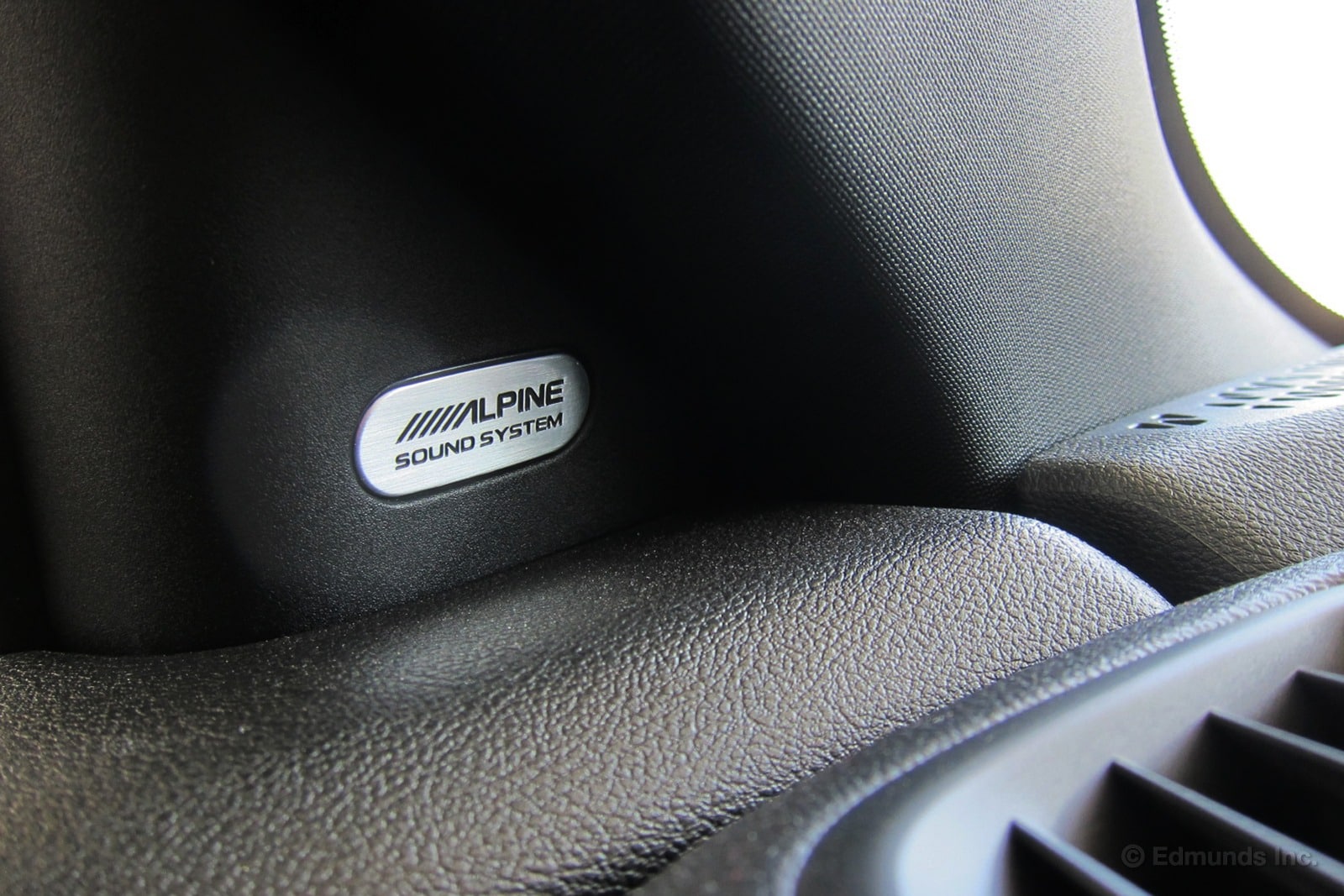
When I saw the Alpine badges in the Dart, I remembered having a conversation more than 10 years ago with Alpine's marketing vice-president. I asked why the company didn't brand the audio systems it provided (through its parent company, Alps Electronics) to automakers like Honda. I argued that the Civic, or at least Civic Si buyers, would pay extra to own that sound and that logo on their head units.
The VP countered that the OEM systems weren't exactly premium setups and that a mediocre Alpine-branded factory system could do more harm than good to the aftermarket product image. A fair point. Honda says "we need an audio system built to these specs for this much money," so Alps might use lesser material for the speaker cones or lighter magnets. They won't devote too many man-hours for cabin-tuning the system.
Not long after, Rockford Fosgate branded a system in the Nissan Frontier. Not surprisingly, it was loud and bassy, not exactly audiophile but it fit the truck's image. Then Scion offered a Pioneer-branded system in the first xB, and since then you've seen plenty of branded systems showing up on the options list.
I realize these weren't the first examples. I think Lexus marketed Mark Levinson systems before that, but Levinson wasn't much of a name in the car audio aftermarket. I believe the dealer could equip your new Porsche 911 with a Blaupunkt deck back in the mid-80s, although this was often more of an expedited job, and not a cohesive factory option.
I take the Dodge Dart's branding with a grain of salt; this ain't like no Alpine system I've ever heard (having owned a few and heard several more). There's simply not the body, depth or power here that you might find in a similar aftermarket system. Alpine isn't the be-all, end-all, but I've always found their gear consistent, built with quality components, and competitive on all the important specs.
But if the Dart's branding gets in its owner's head and helps sell a better Alpine system in a Charger or Durango — or even an aftermarket preference — then mission accomplished.
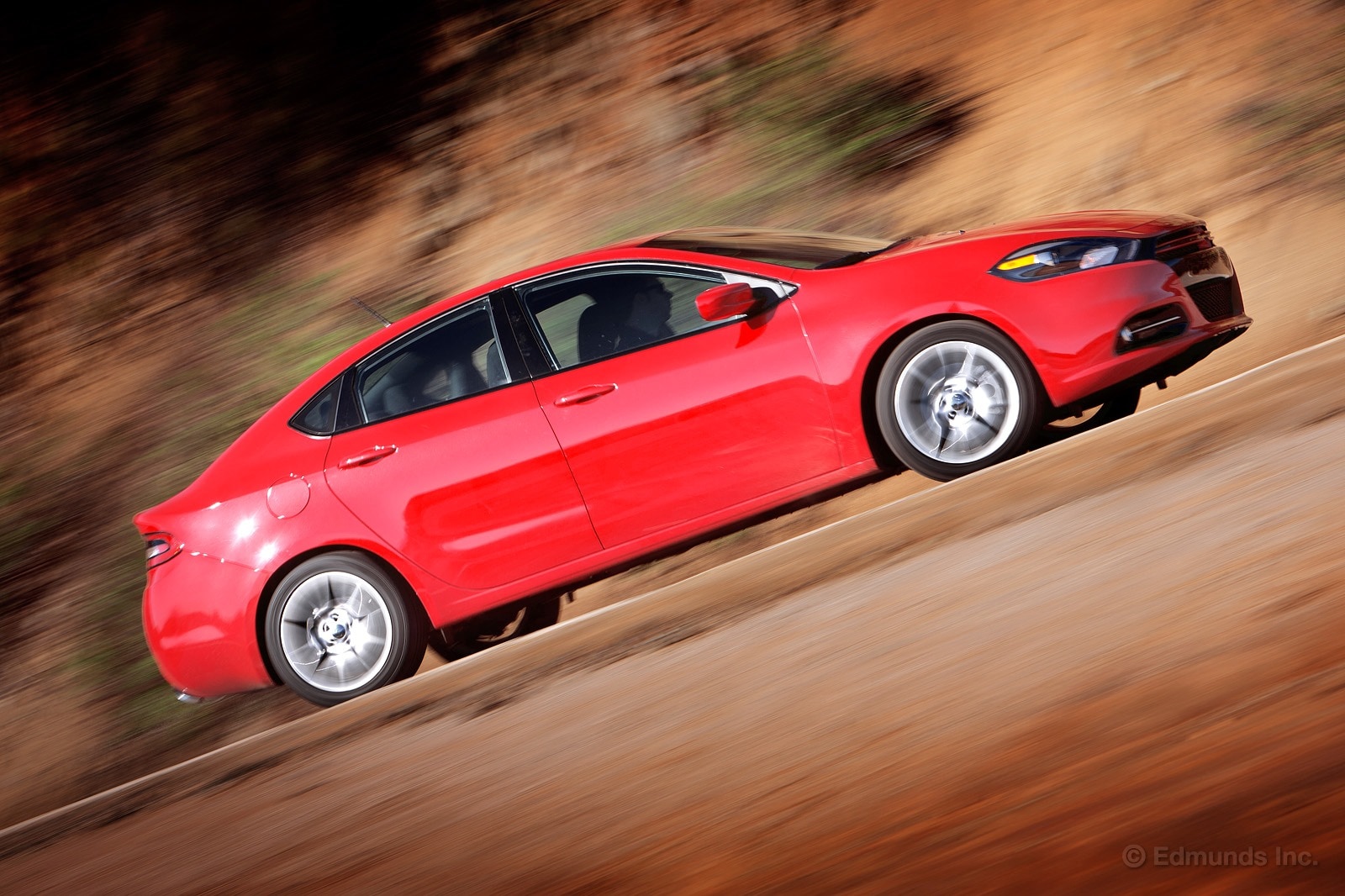
We threw a few thousand miles at our 2013 Dodge Dart in April. Were in-house records broken? Did the overall average increase or decrease? Click on through before you fall out of your chair.
April saw the overall average climb from 26.9 to 28.2 mpg. It also saw the best mpg across a tank climb from 33.1 to 35.6, which is still below the EPA's guesstimate of 37. The editors (read, me) also got brave with the distance driven on a single tank, driving it 486.7 miles which is up from the previous high of 384 miles.
Worst Fill MPG: 16.8
Best Fill MPG: 35.6
Average Lifetime MPG: 28.2
EPA MPG Rating (city/highway/combined): 27/37/31
Best Range: 486.7 miles
Current Odometer: 9,316 miles

It requires a small amount of advanced planning (or forgetfulness) to take advantage of our 2013 Dodge Dart SXT Rallye's auto-start functionality. Simply leaving the HVAC controls where they were prior to shutting the car off allows the climate to resume at that prior setting.
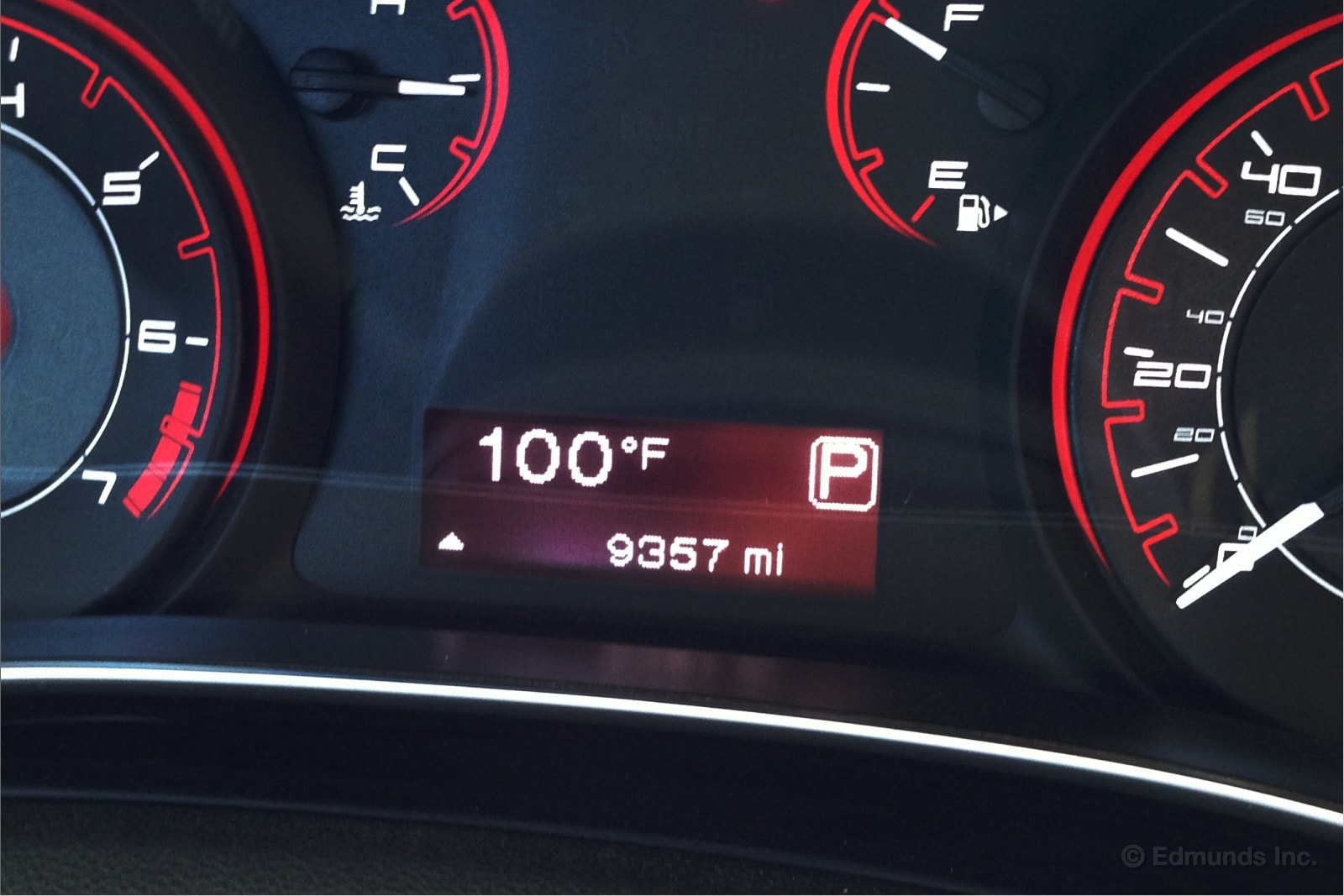
During a heat wave last week, we went grocery shopping. With the key, we popped the trunk and started the car. By the time the groceries were loaded and the cart returned to the coral, the interior was nice and cool.
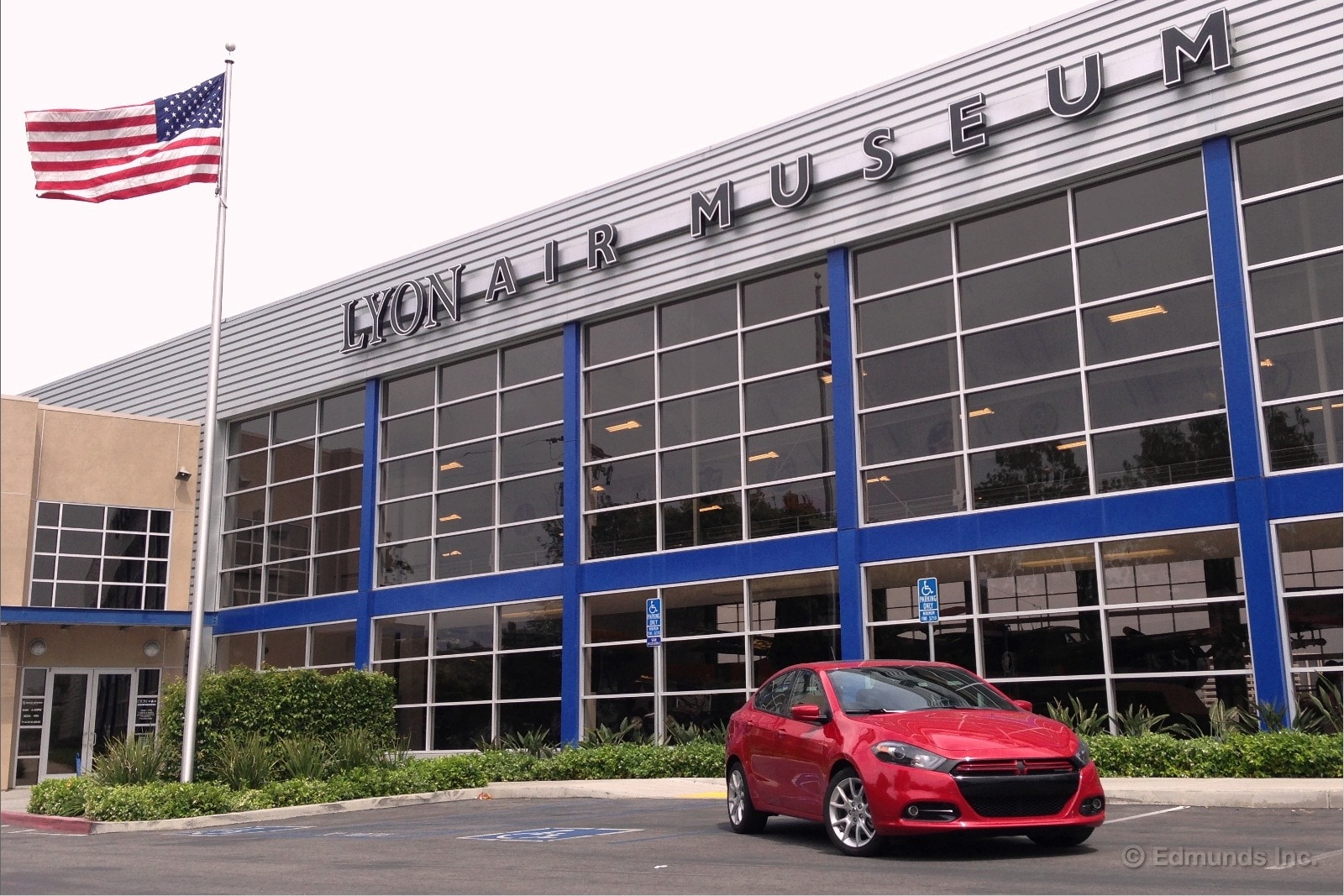
In a purpose-built hangar adjacent to John Wayne Airport, in Orange County California lies Lyon Air Museum. Named for General William Lyon, USAF (Ret.), "The Lyon Air Museum exhibit is comprised of authentic aircraft, rare vehicles and related memorabilia, with emphasis on the defining event of the 20th century — World War II."
Click through to see a smattering of the collection, whose centerpiece is a famous B-17 Flying Fortress. Besides all the aircraft, all the cars, transports, and motorcycles are in running condition. Worth the trip and the modest price of admission.


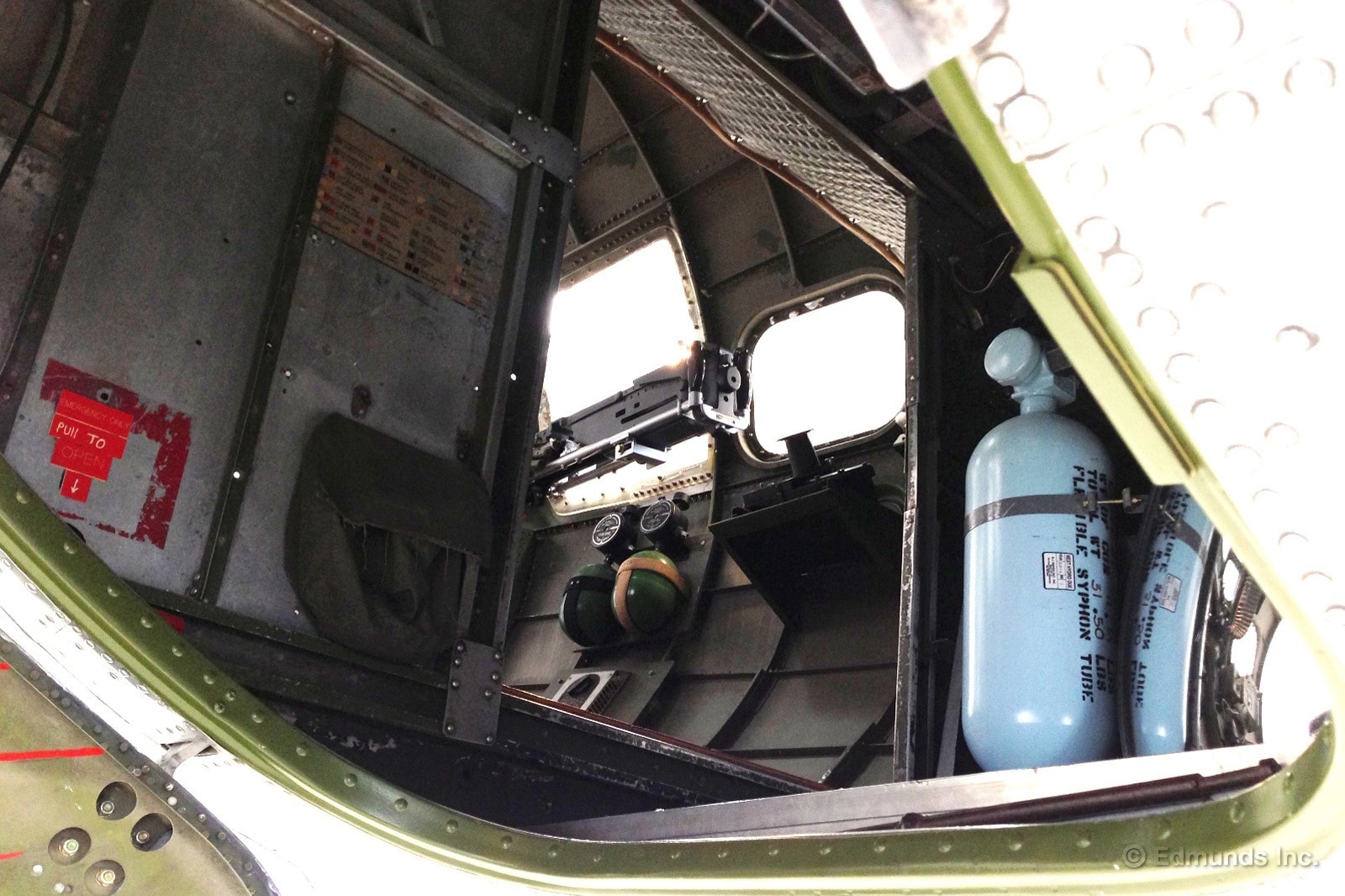
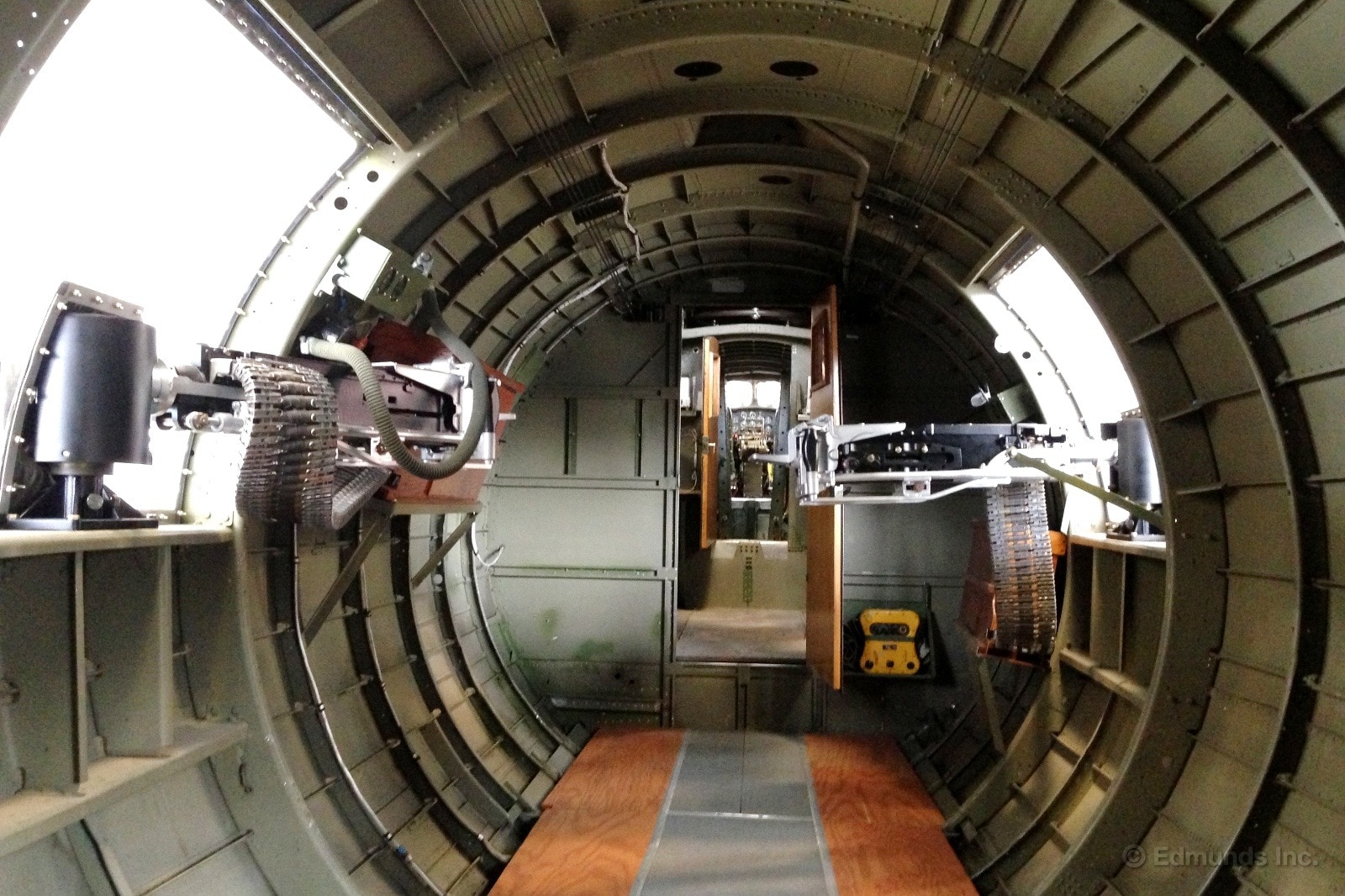
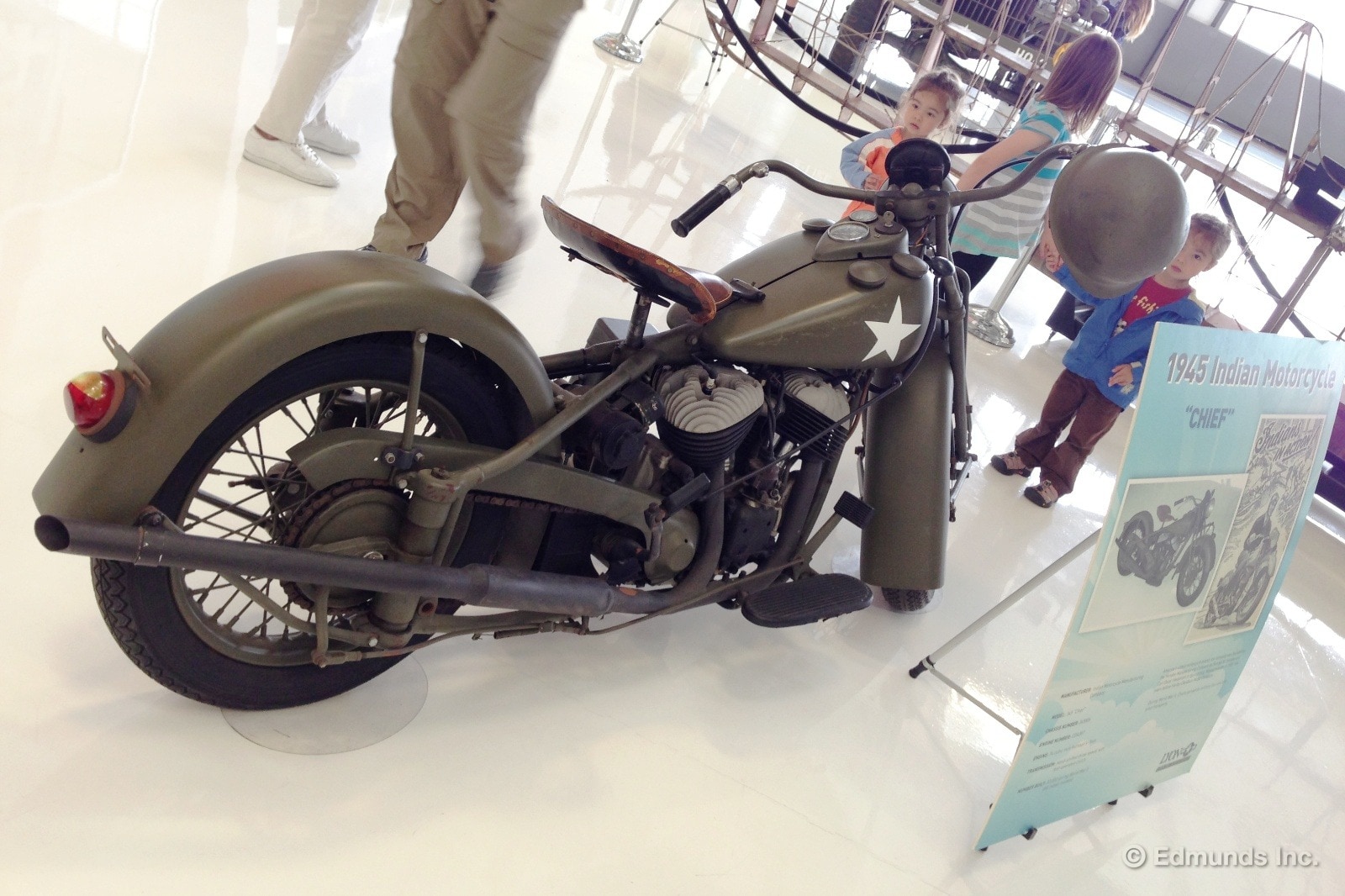
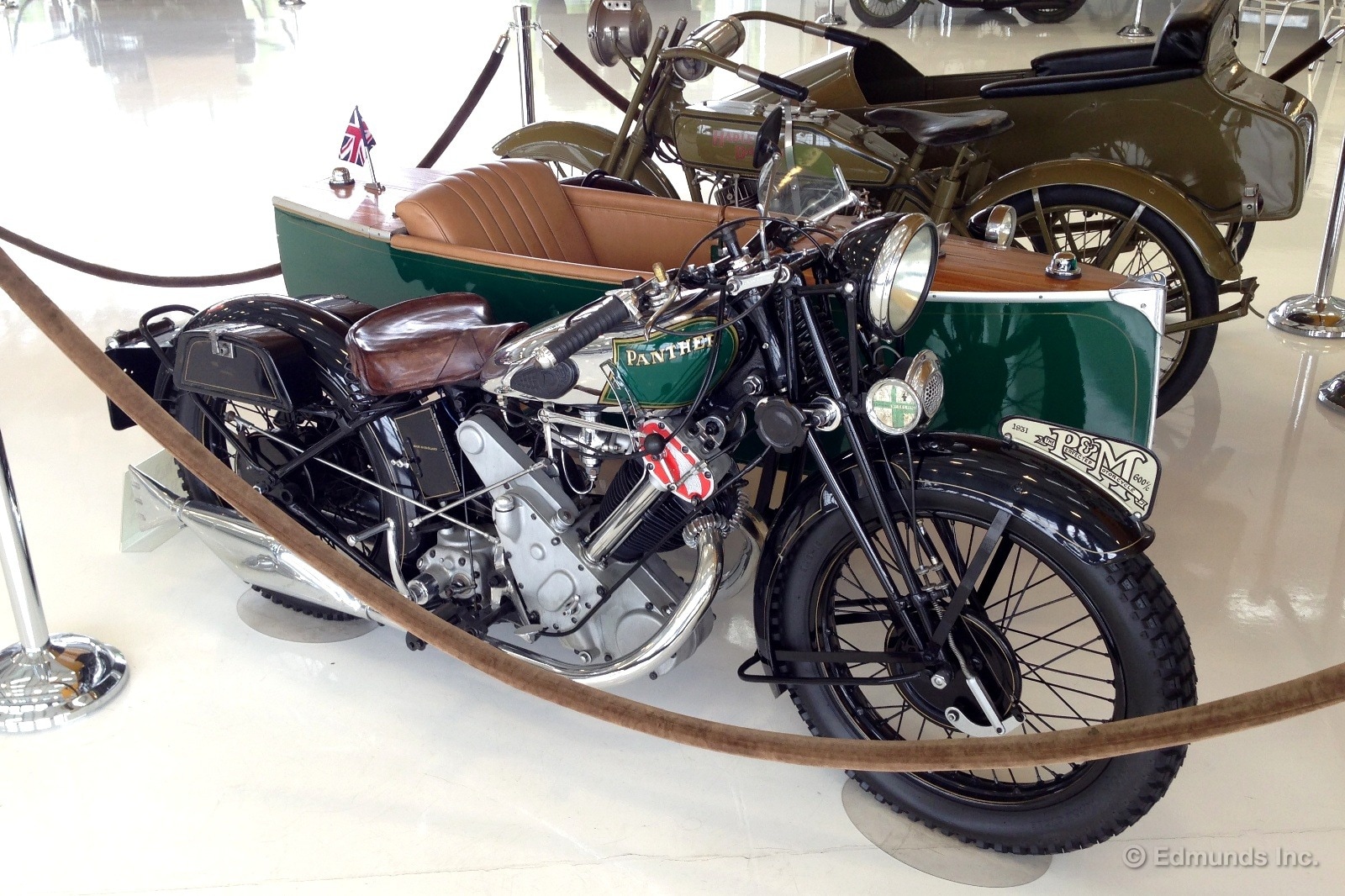
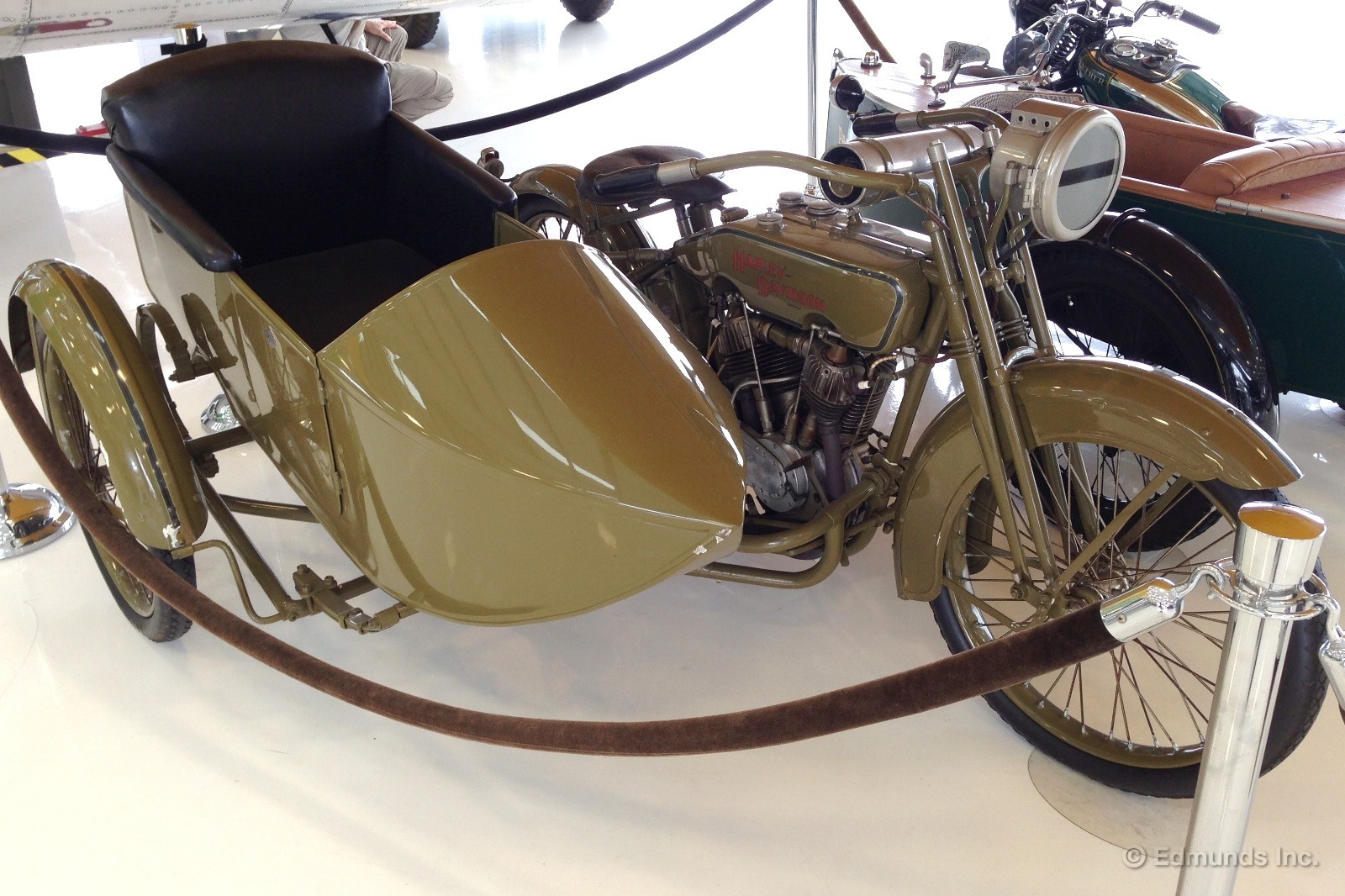
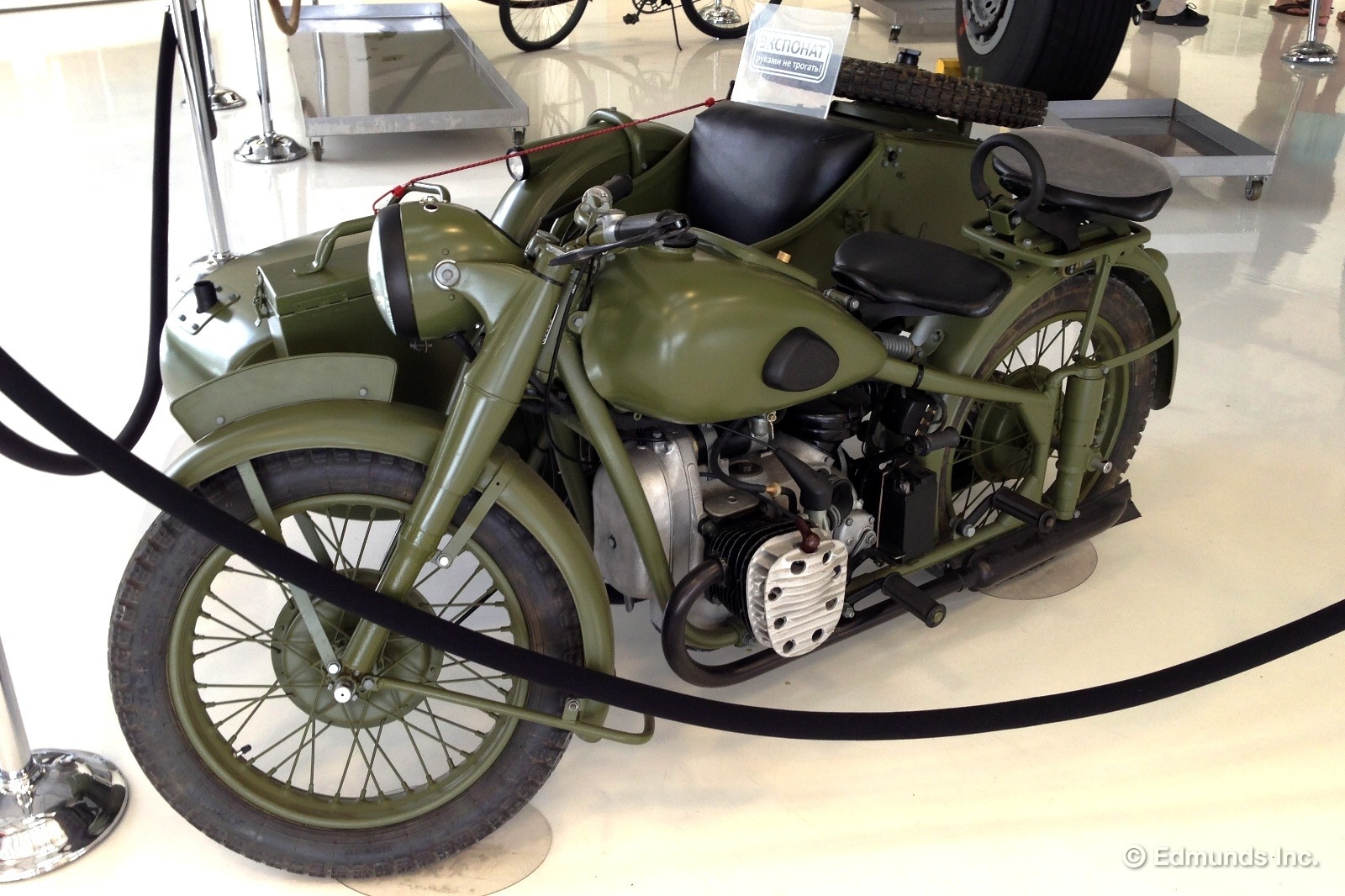
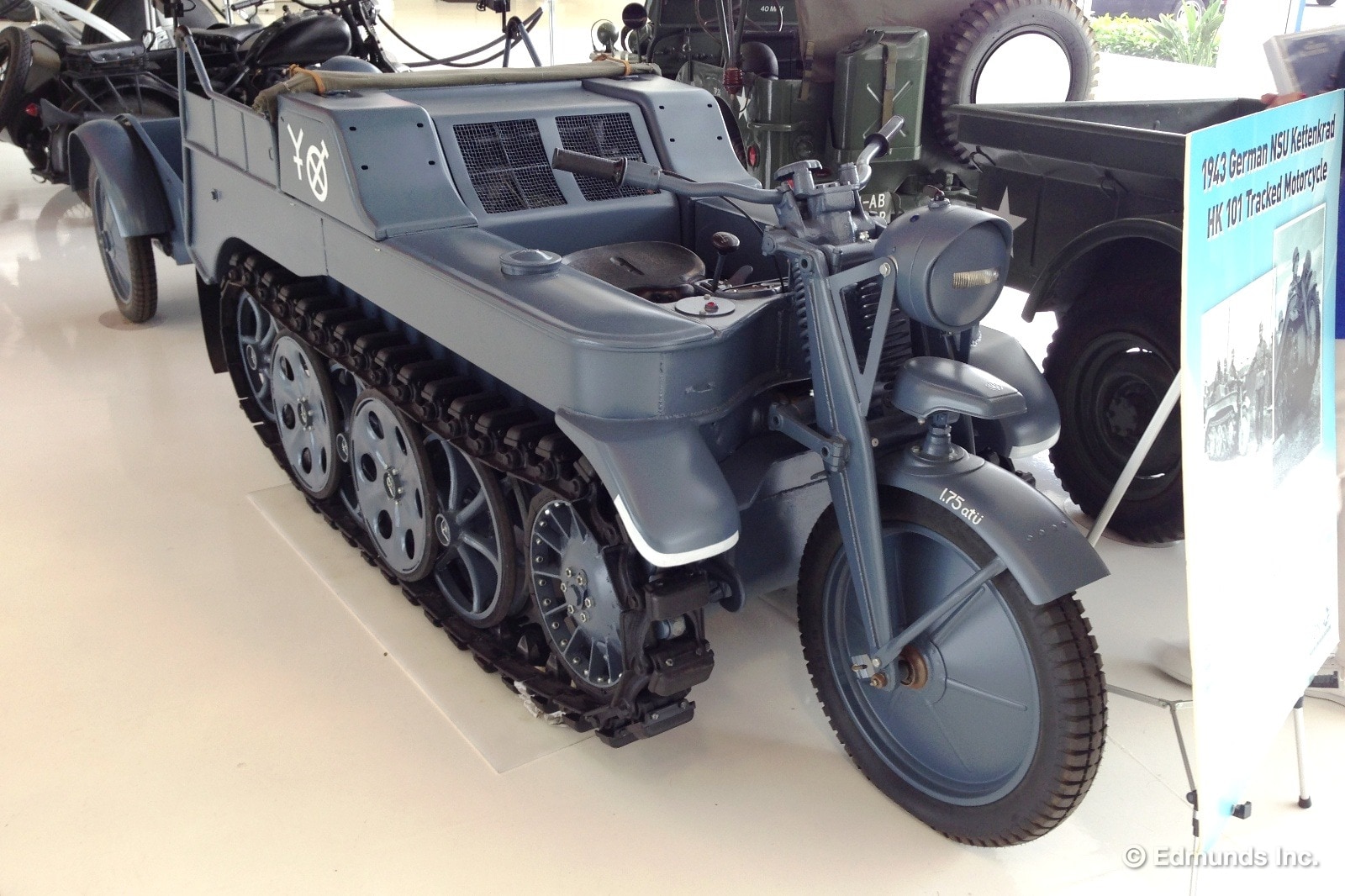
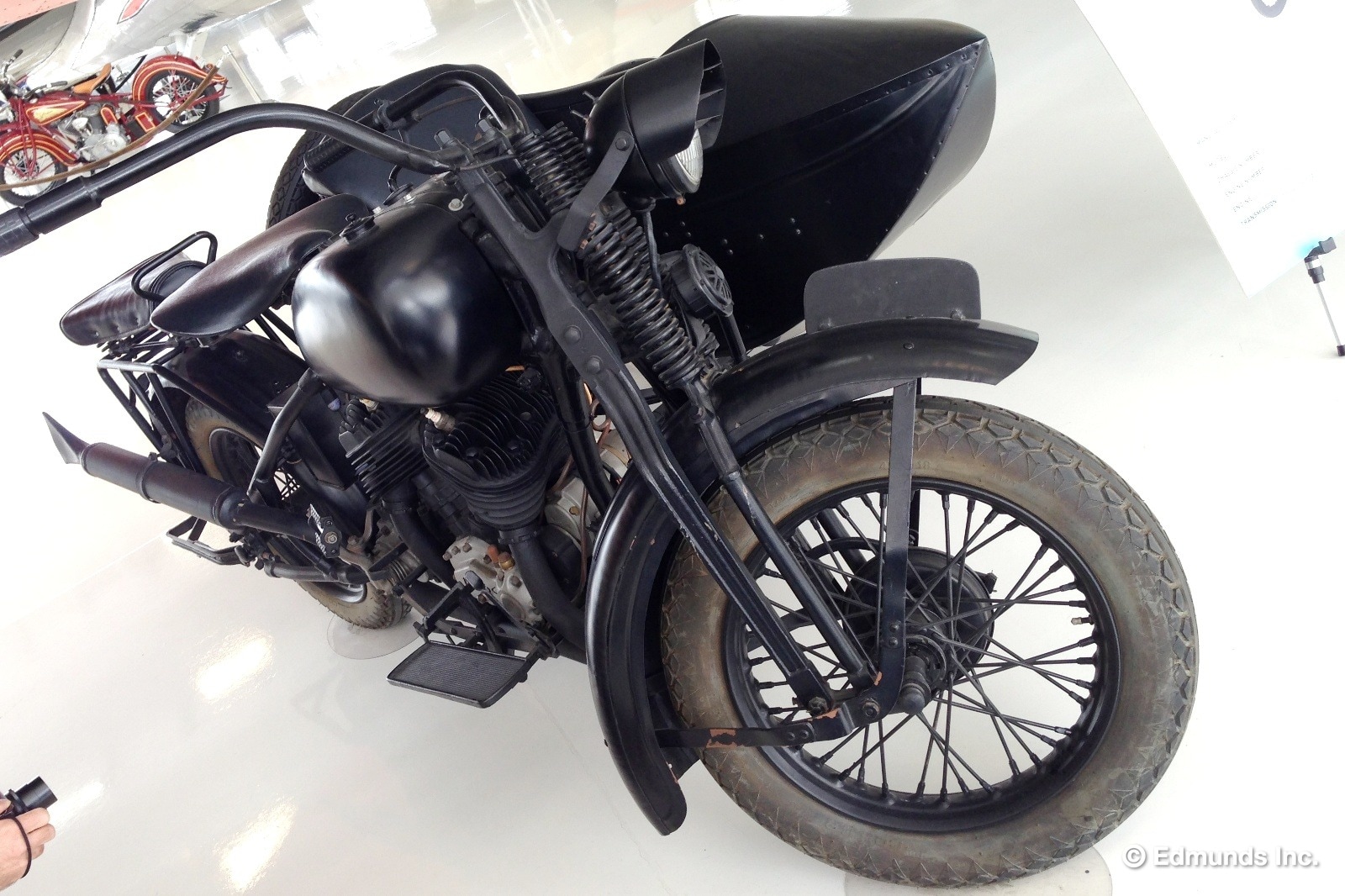
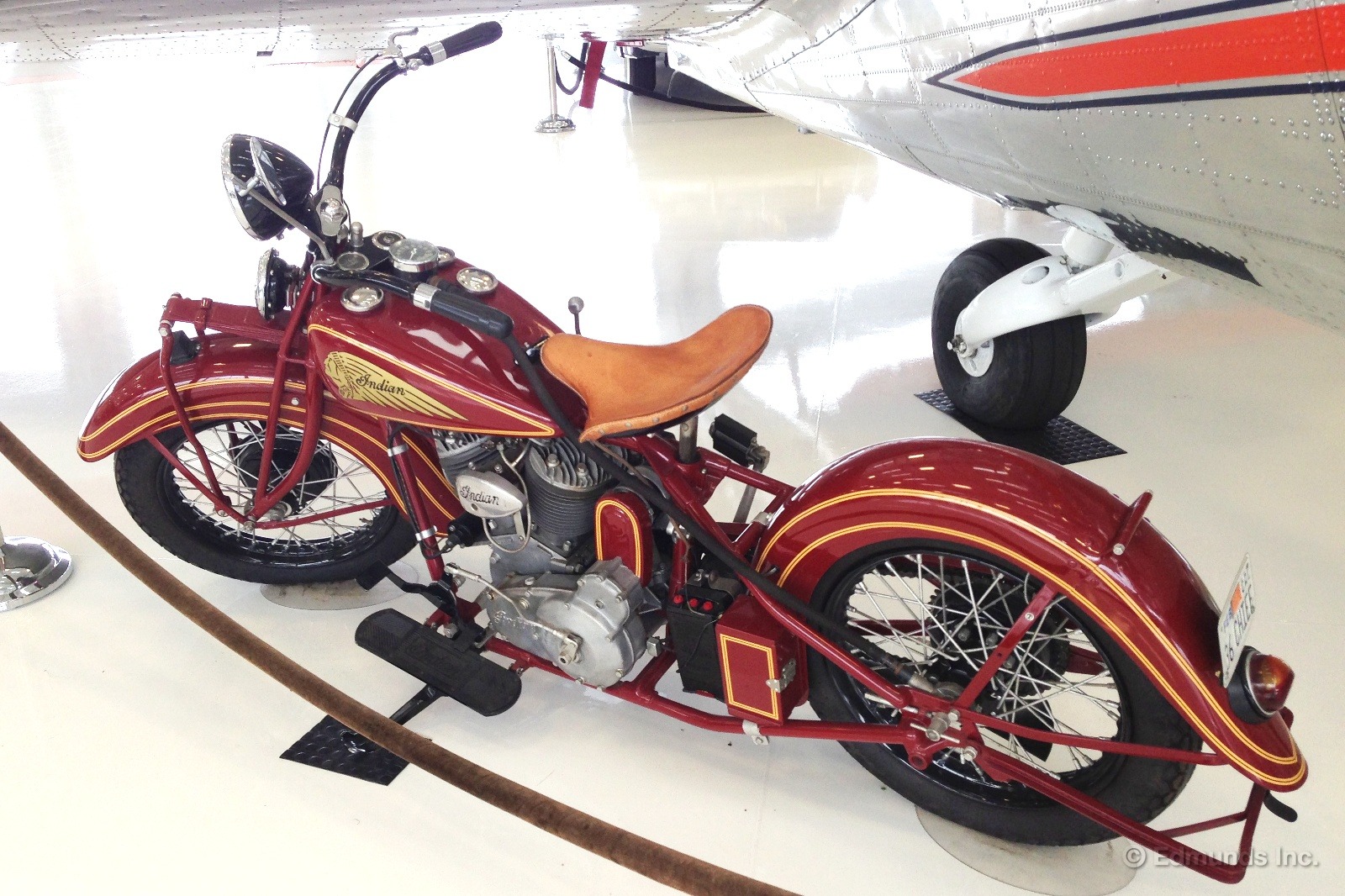





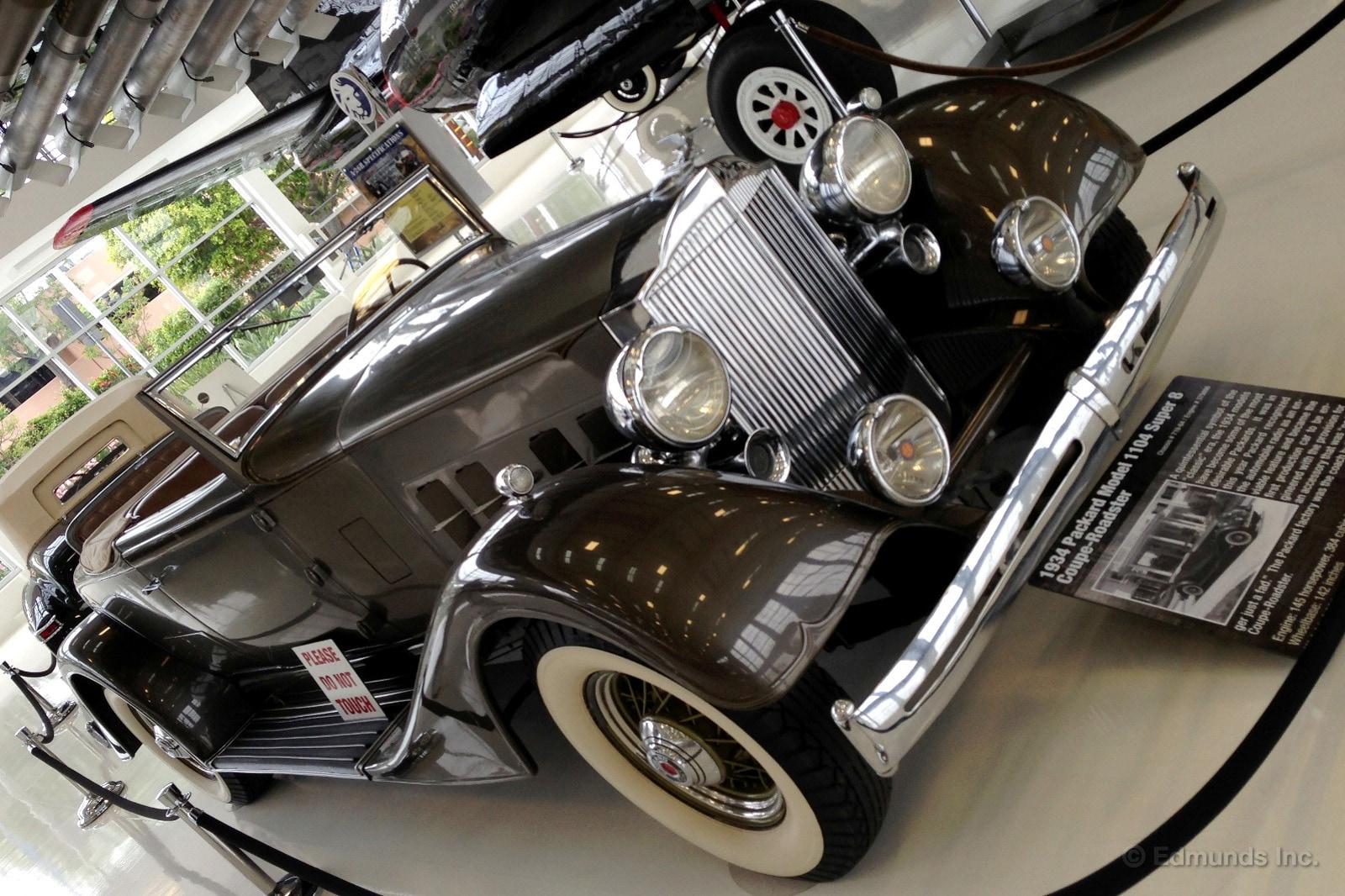

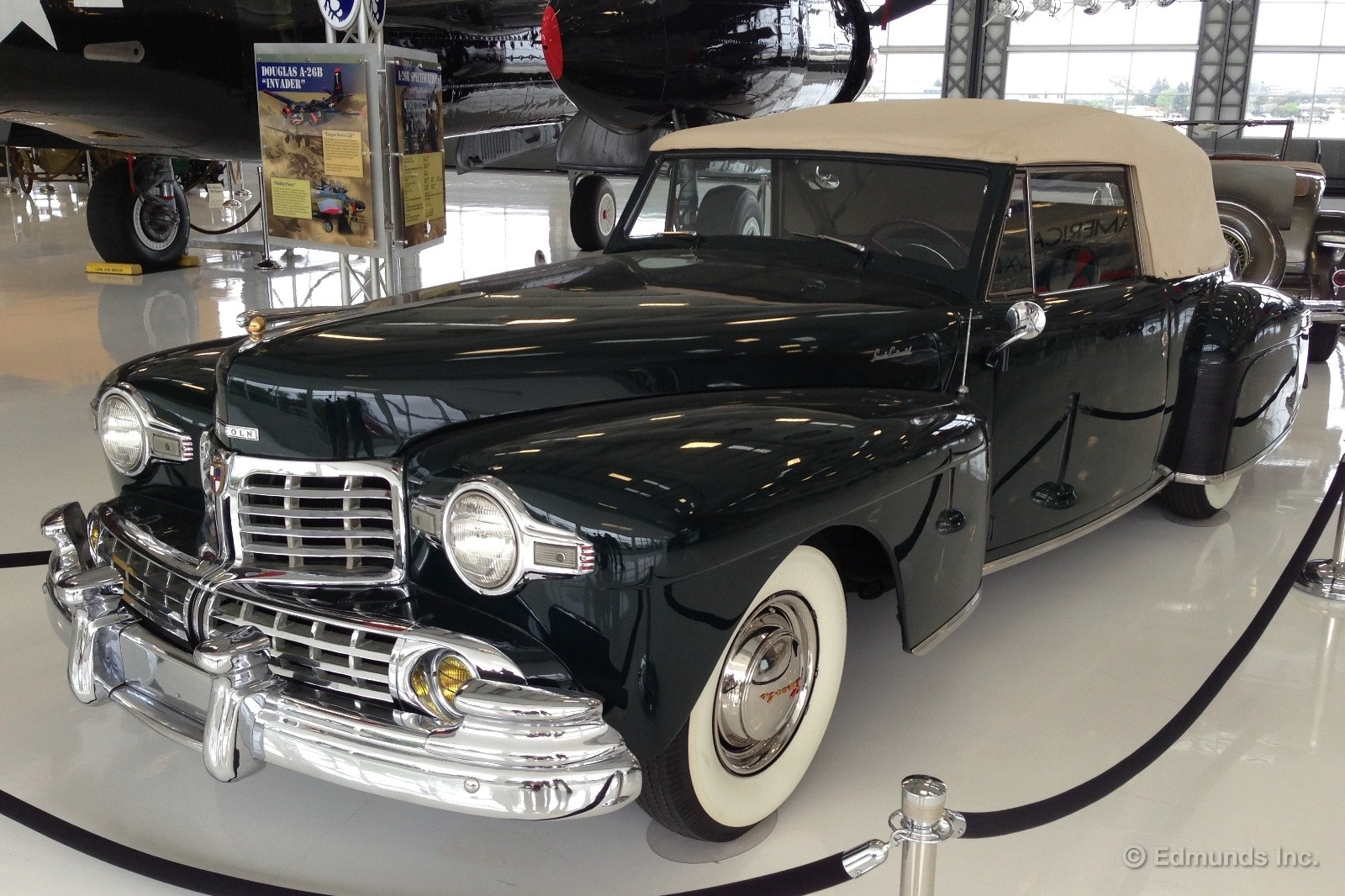
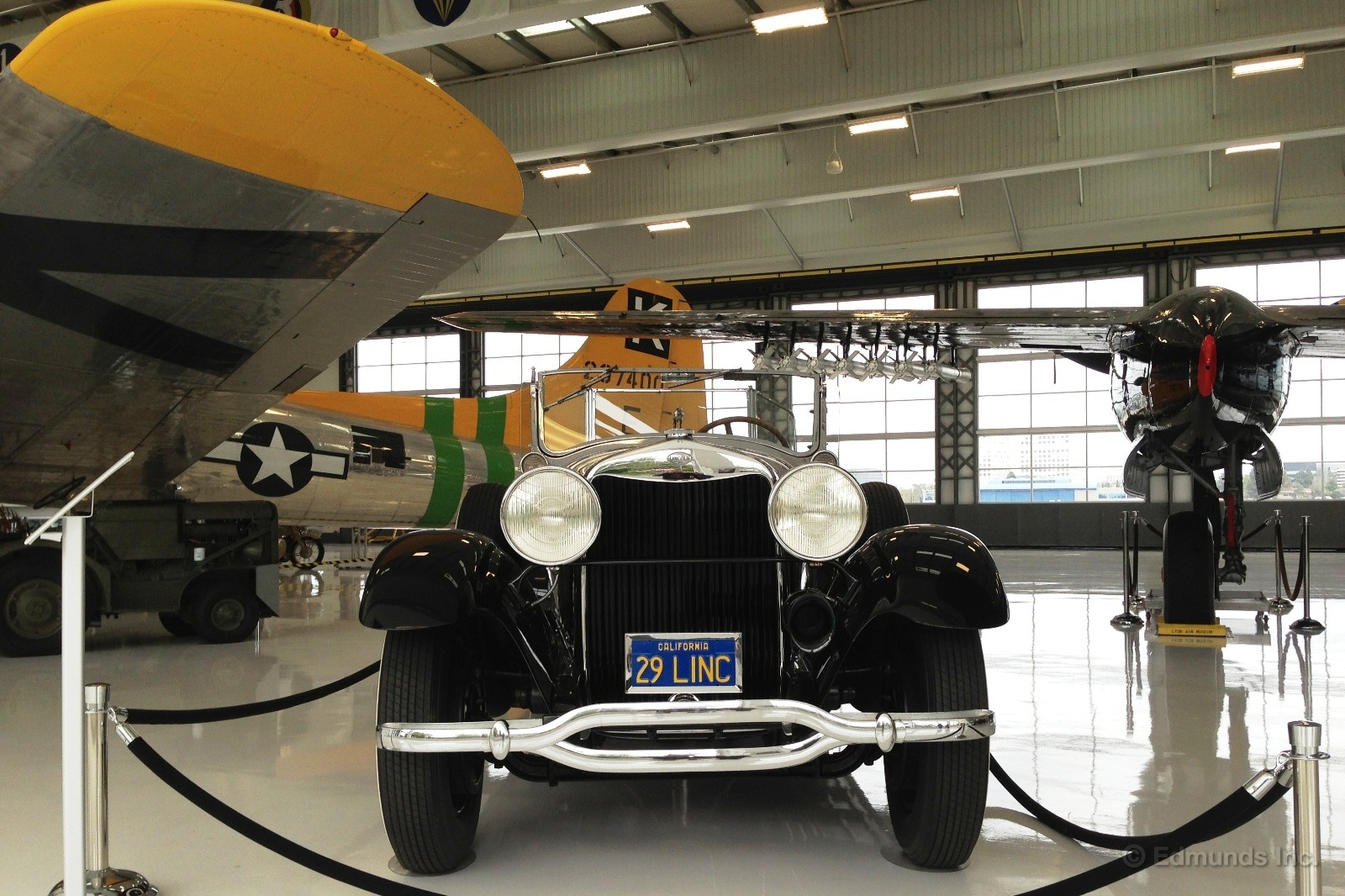
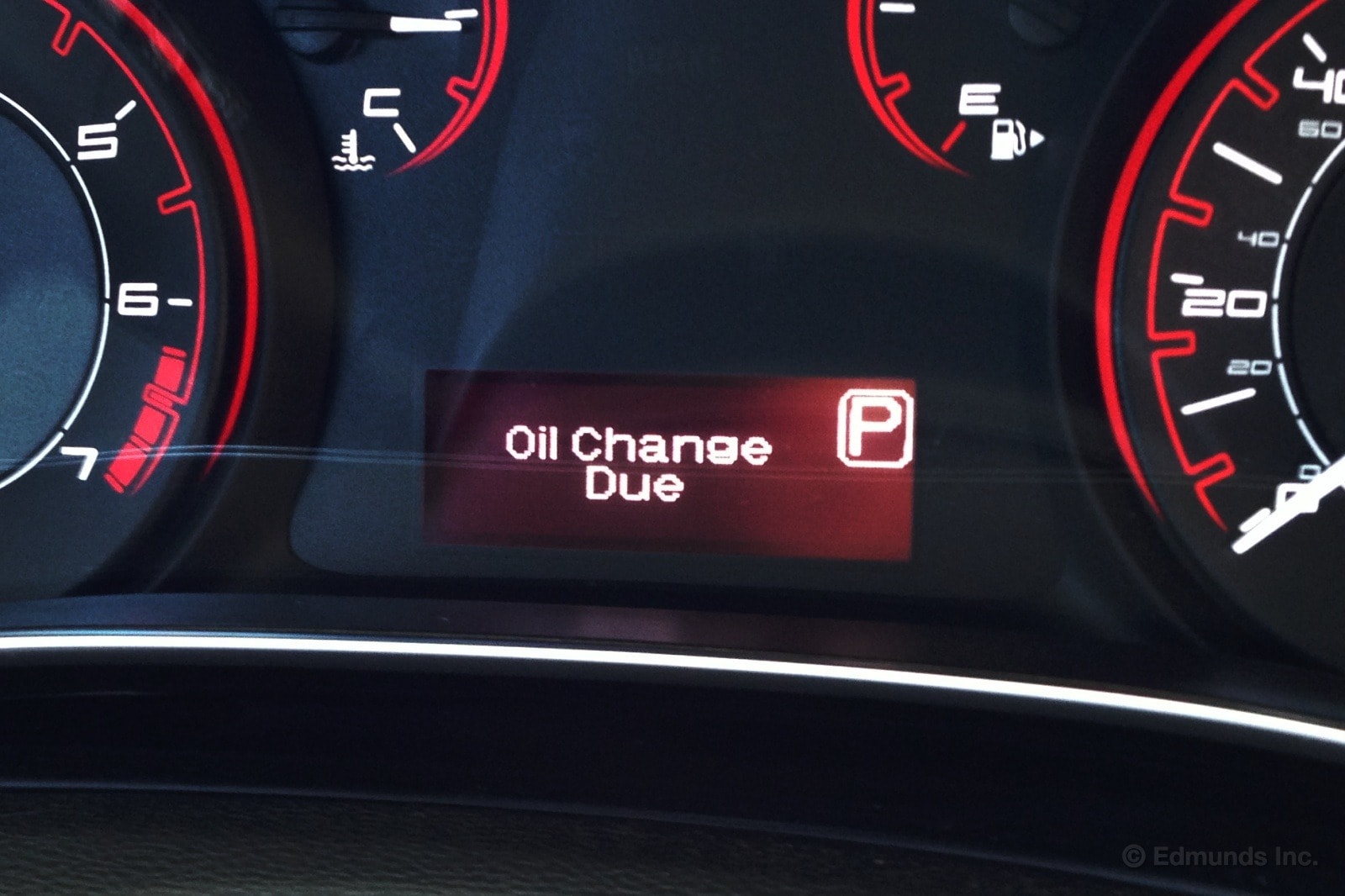
We twisted the key on our 2013 Dodge Dart SXT Rallye and were greeted in the instrument panel by a number of messages, but one was accompanied by a tone, "Bing."
With about 500 miles to go before the 10,000-mile mark, the car requested an oil change. We dropped it off yesterday and we'll let you know what, if anything else, was taken care of by the dealer and for what cost.
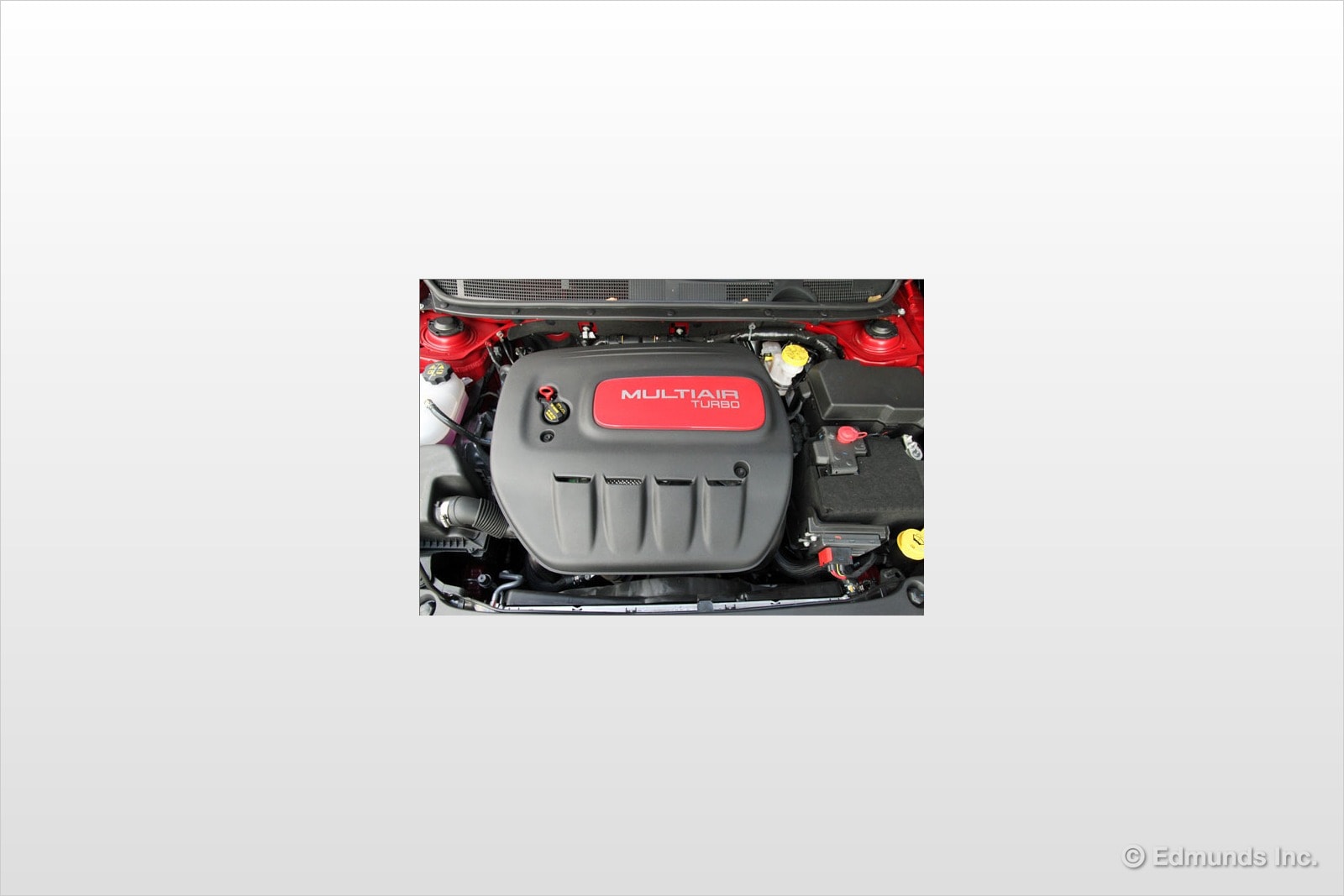
As is often becoming the case these days, our 2013 Dodge Dart features an optional engine that's actually smaller in displacement than the base setup. With the help of a turbocharger, this 1.4-liter engine manages to deliver 40 extra pound-feet of torque over the 2.0-liter four-cylinder. Horsepower remains equal between the two engines.
That extra helping of torque makes a huge difference. Our Dart is hardly what I would call fast, but it does have plenty of punch when you need it on the highway. Once the gearbox finds the right gear, this car moves out nicely. It almost feels like a lightweight despite weighing over 3,200 pounds.
When it comes to noise this engine is a mixed bag. When you're wringing it out the sound is on the shrill side. Not the worst I've heard, but not the most refined either. Once it settles down, however, the engine noise disappears completely. Between that and the minimal road noise, this Dart is one of the quieter compact sedans I've driven in a while.
I'd say it's worth the upgrade.

When I hop in a car and adjust everything, I tend to prefer the steering wheel down a bit, where it feels more natural for someone like me with a shorter build. Although I appreciate that the Dart has both tilt and telescopic adjustments for the wheel, it just doesn't tilt down enough.
The total range of the wheel's adjustment is pretty stingy, only about 1.25 inches. After moving it all the way down, it was still about an inch shy of where I wanted it. It wasn't as awkward as this arm positioning mind you, just not as comfortable as what I've experienced in other small cars.
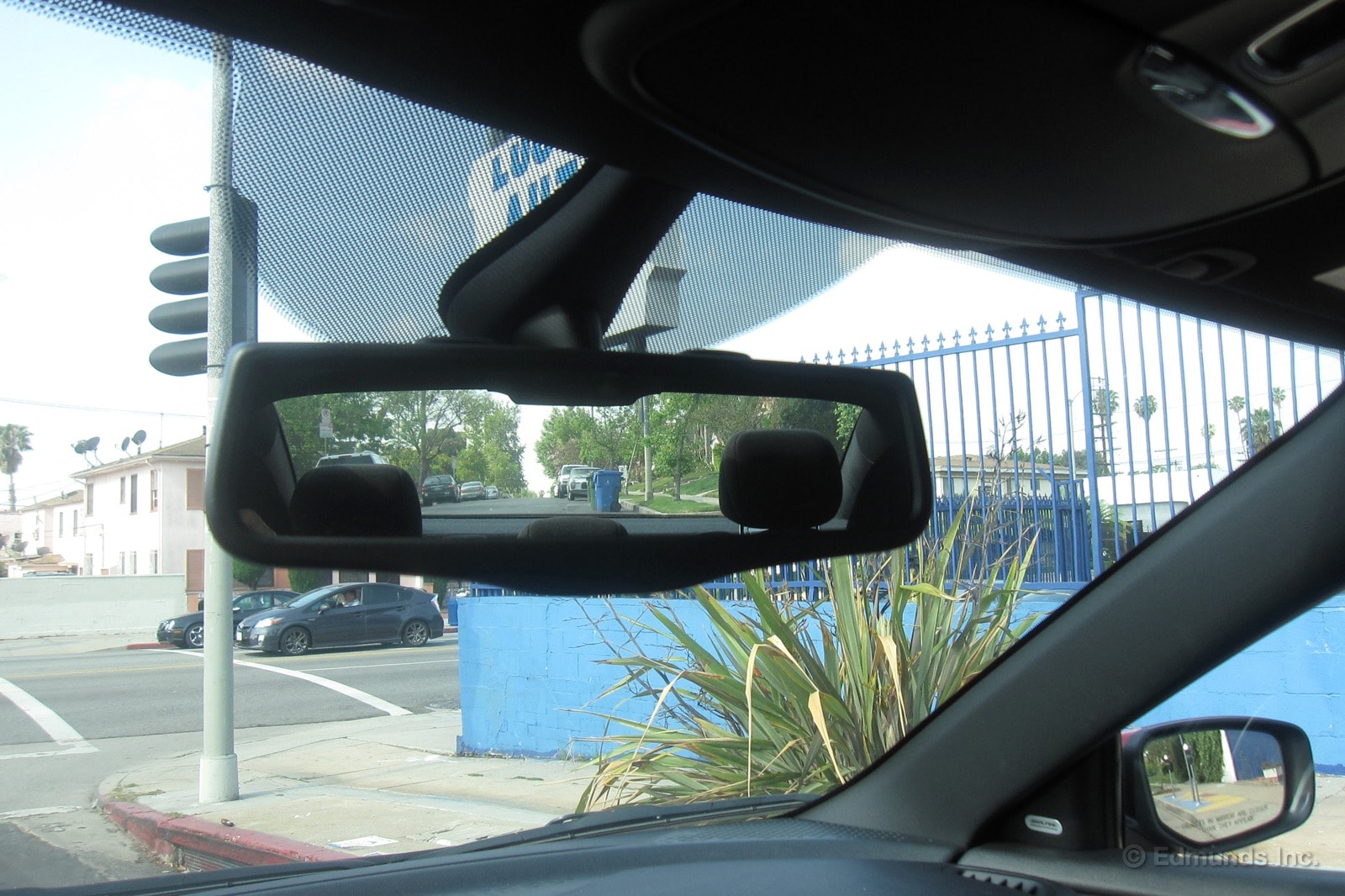
As a visibility hog, I am made crazy by this decade's trend of less and less visibility in cars. Sure, I appreciate a good rear-view camera when an SUV's heiny is huge, but when your average family sedan or hatchback often requires one, it makes me frown. So I was pleasantly surprised when I looked up to the rearview mirror in our 2013 Dodge Dart and noticed I could see the entire back window in the reflection. The whole thing. And that's not a tiny slit of a rear window, like in the Camaro we had a while back.
One of the reasons we can see the whole rear window is because the Dart's rearview mirror is nice and big, and fairly blocky. But thankfully, this doesn't affect forward visibility through the windshield. And the designers didn't prioritize aggressive styling over functionality. Bravo, Dodge.
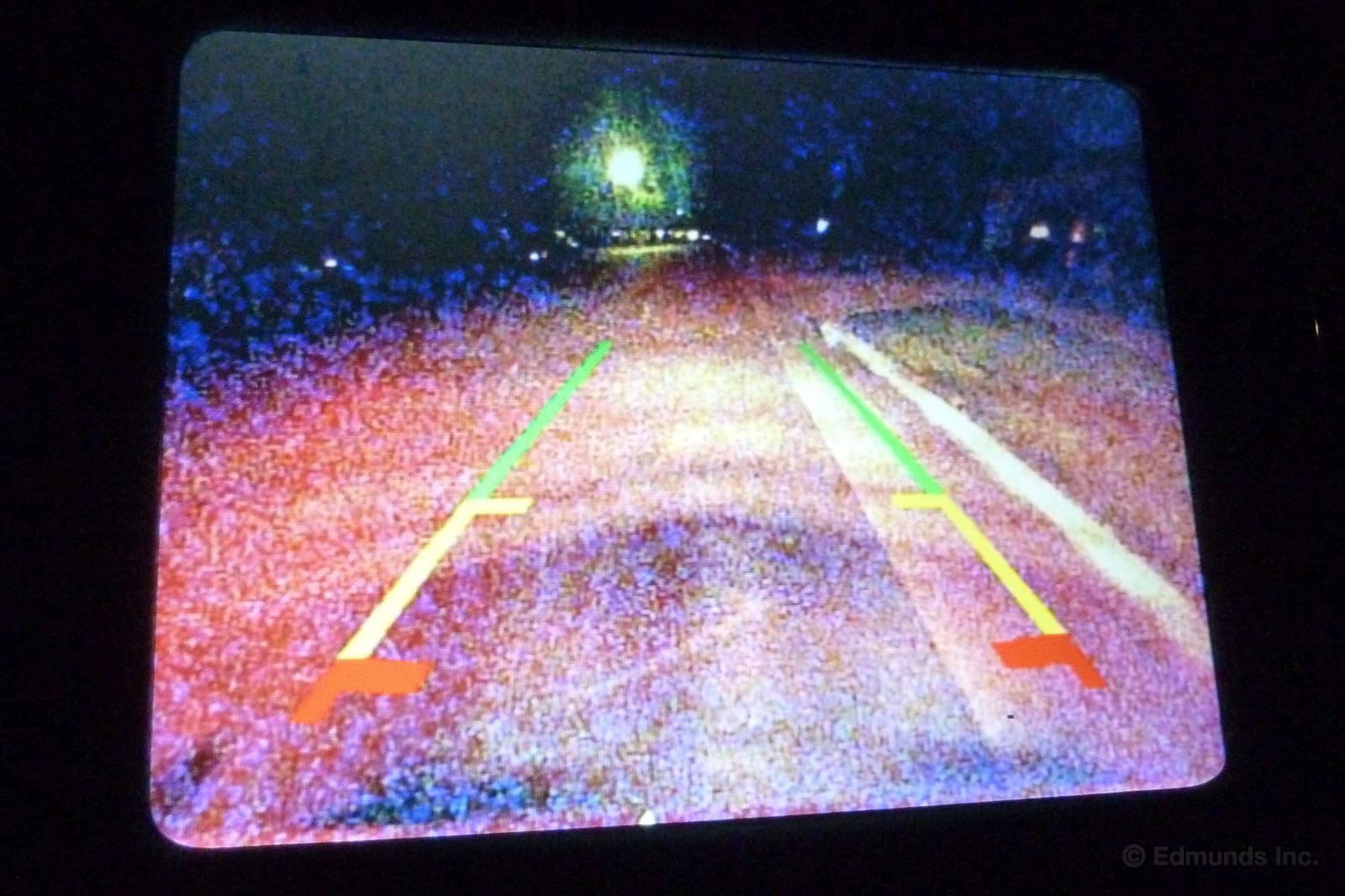
All hail the backup camera, the parking aid of the century! Our 2013 Dodge Dart SXT Rallye has one, and mostly that's a very good thing.
But the image at night suffers from bad resolution. Those who remember analog TV sets fed by rooftop antenna might call it "snowy." The guide lines are not peppered with any snow, so the issue is with the camera, not the display.
It's still possible to see the trash cans before I back into them, so it still works, but it gives off a poor quality vibe.
I don't remember noticing this on previous occasions, and I'm pretty sure I backed up at night at least once. We'll have the dealer look at it during the next service visit.
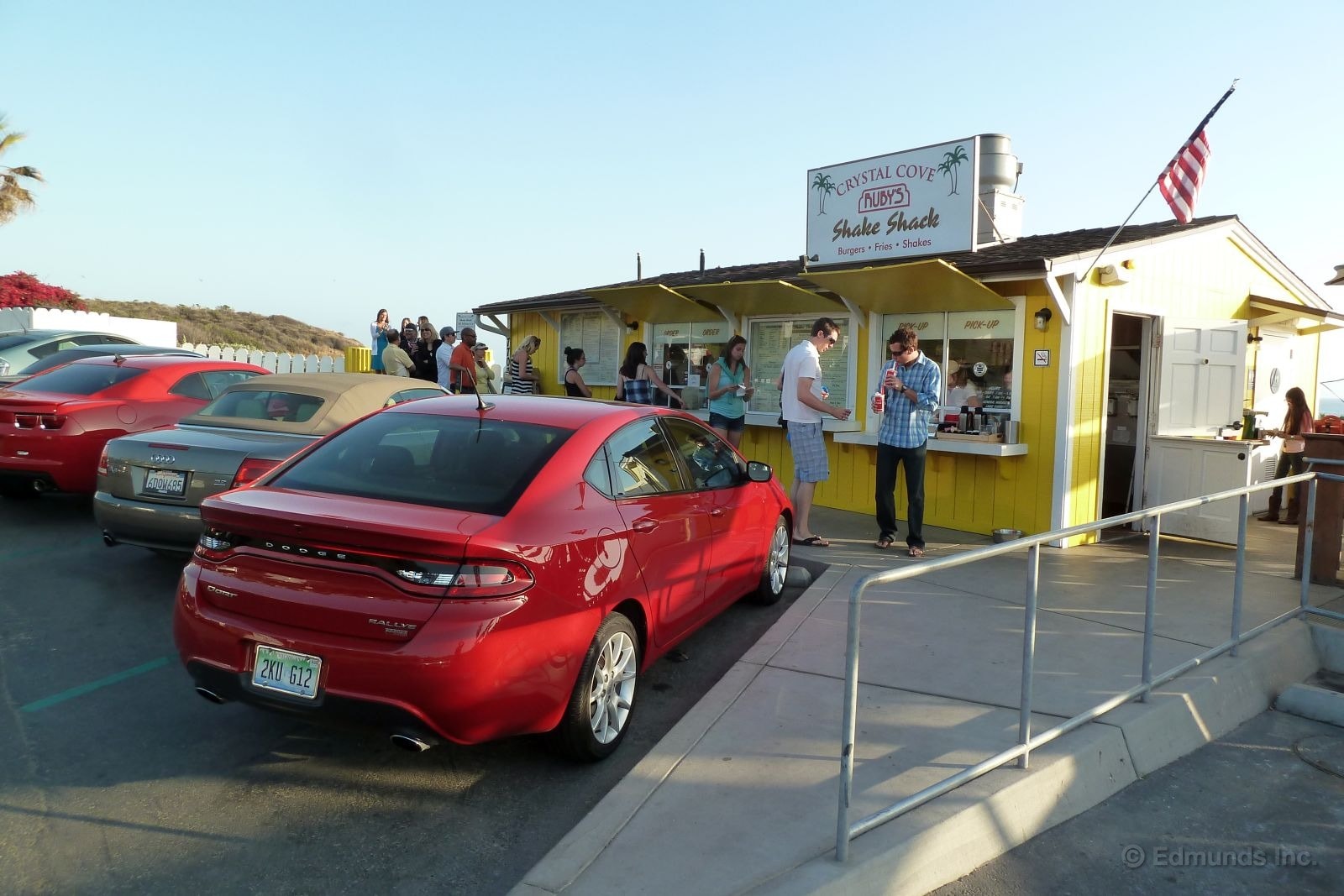
We were headed to Corona Del Mar to drop off our daughter for a beach party. After that my wife and I planned to head over to Ruby's Shake Shack on Pacific Coast Highway for a chili dog, a side order of ocean view and a milkshake chaser.
At our first stop the odometer showed nothing but nines when Sarah hopped out with her towel and beach chair.
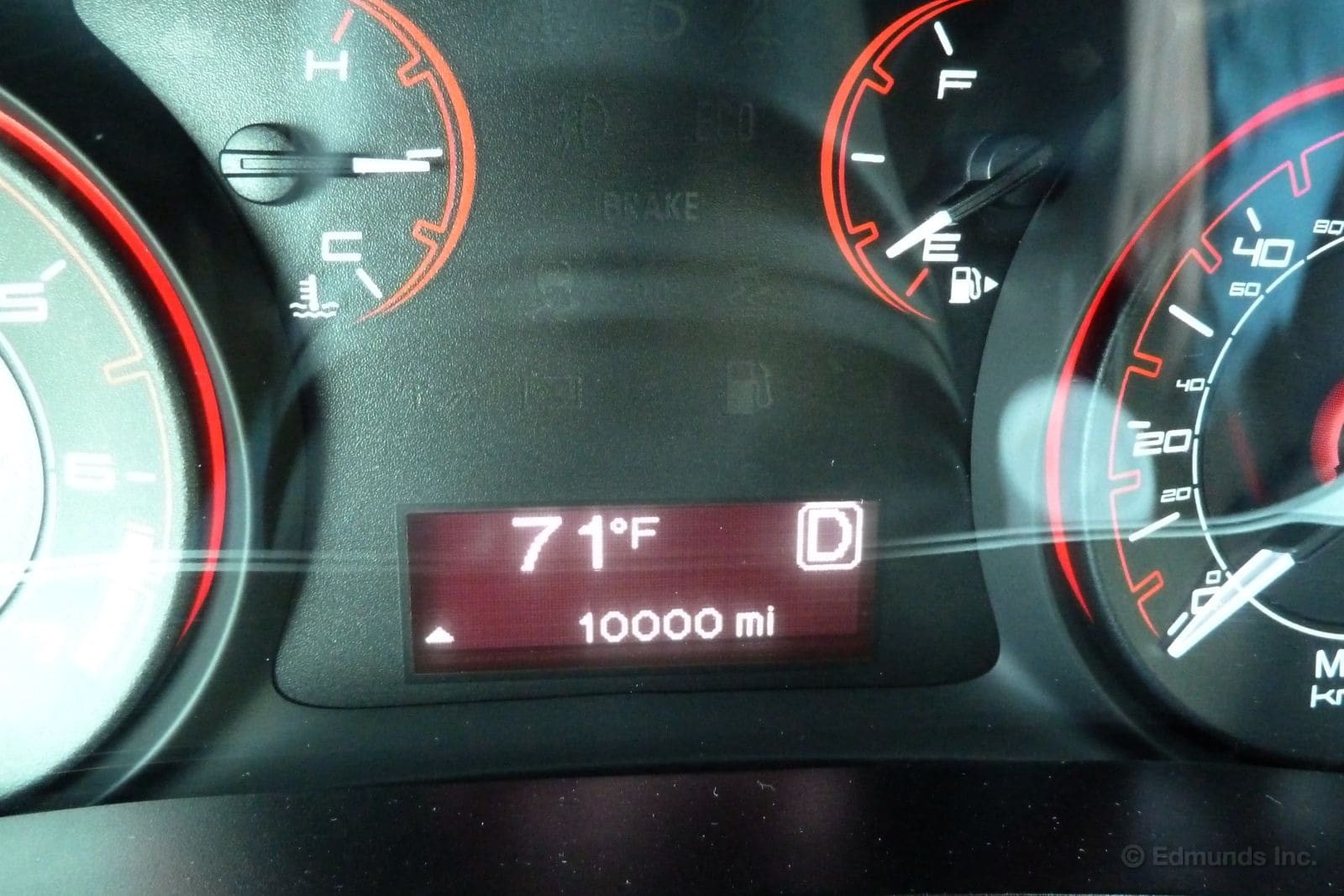
It soon rolled over to 10 kilomiles as we puttered away from the drop-off zone and along the bluff as we made our way back to PCH.
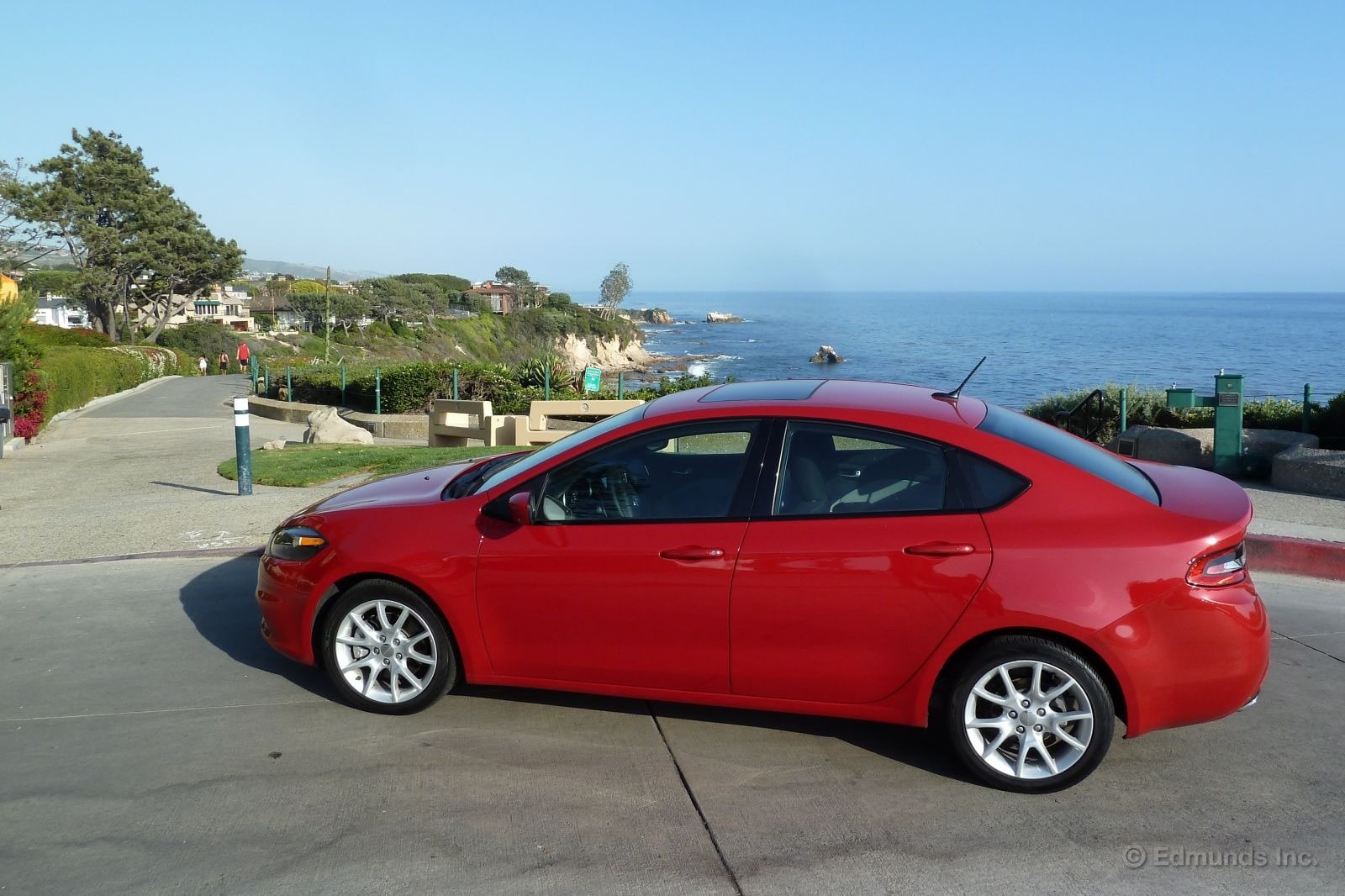
Ruby's is just a few miles down PCH at the south end of Crystal Cove, so the odometer crept up to 10,005 miles by the time we rolled into the parking lot and claimed the coveted pole position parking space.

Ever since I first laid eyes on it, I've liked the Dodge Dart's basic shape. It's smooth and flowing, and unlike cars like the Hyundai Elantra and some other cars I could name, the sides aren't mucked up by an abundance of creases.
But it's the Rallye trim level that really does it for me. The keys are black headlight housings instead of chrome, the relatively small amount of black paint that bridges the gap between those headlights and the grille, and the black-colored bumper segment between the grille and the lower air intake. The body-colored grille crosshairs on a black background helps, too.
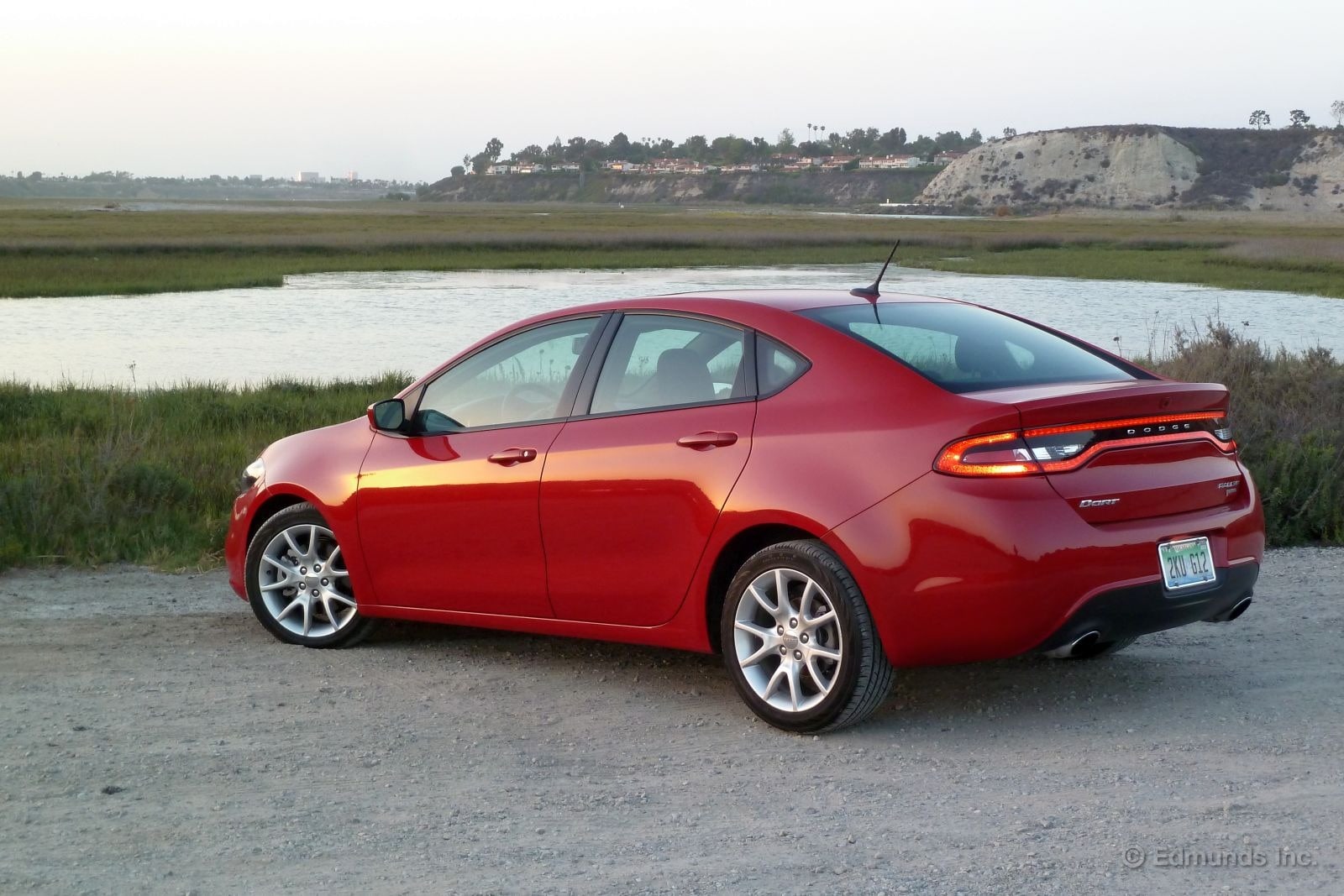
Without these simple touches the Dart's look can tend toward nondescript, especially in a bland color. While I'm sure those that like nondescript sedans would disagree, I'm of the opinion that all Darts should have the Rallye front end.
And the back half ain't bad, either.
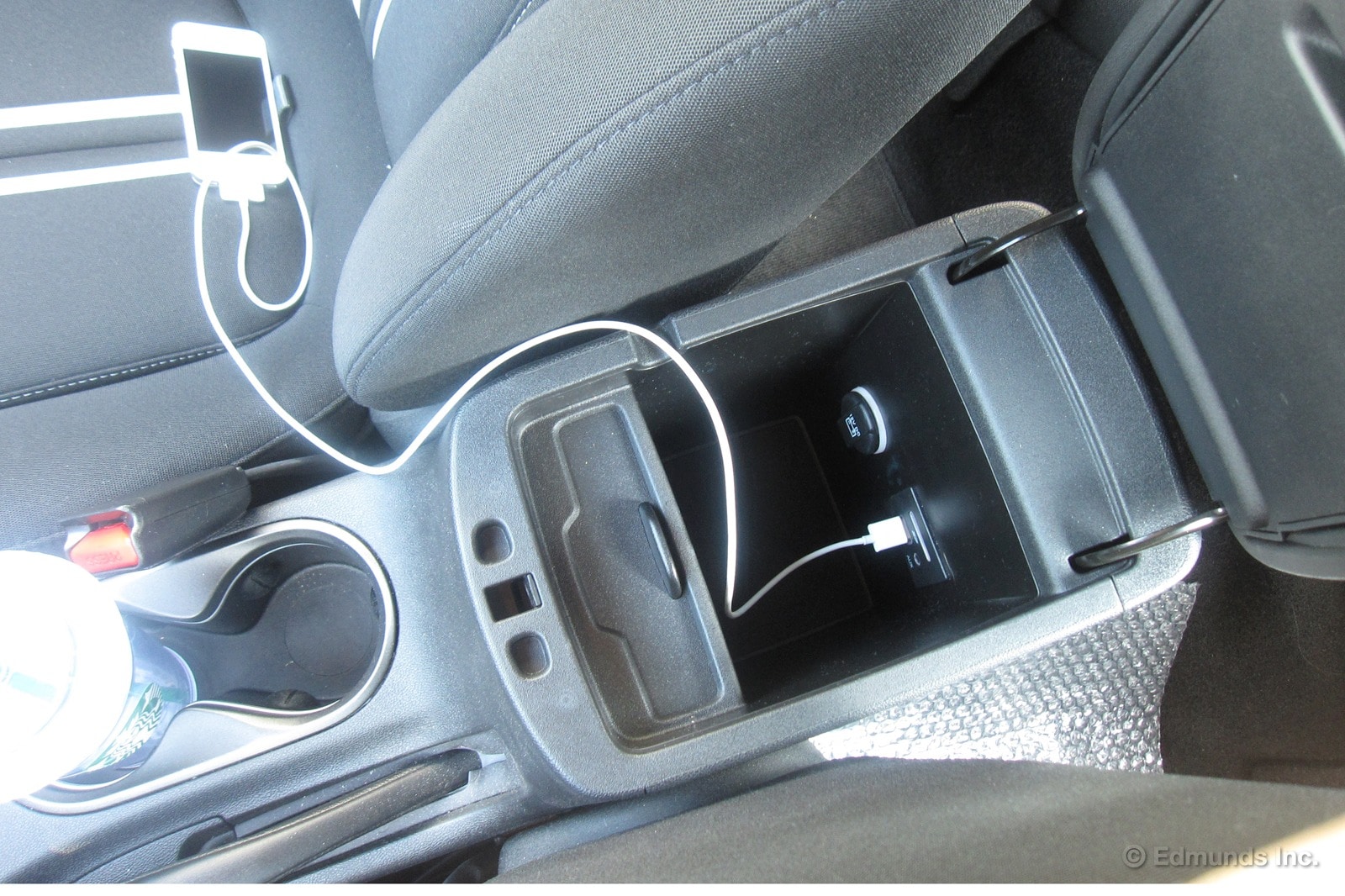
Our long-term Dodge Dart has a USB port and aux jack hidden away in the center console armrest bin (there's also a power outlet in there). Like most of these in-the-bin situations, the Dart has a handy cutout that allows you to keep your smart phone or mp3 player within reach, but still close the door on the bin and not pinch your cord.
Other cars' USB ports and aux jacks are located on the center stack, sometimes behind little doors and sometimes au naturel.
Now, obviously, you don't get to choose where these conveniences are located in a car, but perhaps you have a preference, nonetheless. After living with each for a while (via our long-term fleet), I've come to prefer the exposed-on-the-center-stack setup, because I'm lazy and have a bum right shoulder that makes it a pain (both literally and figuratively) to deal with the center console bin.
In your opinion, where is the ideal location for the USB port or aux jack?

Seems several cars in the long-term fleet are coming up for service. This time it was our 2013 Dodge Dart Rallye, which is rapidly approaching the 10,000-mile mark.
As is our custom for the Dodge nameplate, we took the car to Buerge Chrysler Jeep (yes, they do Dodges too). The service advisor, a Mr. Ortiz, was adamant that it could be done that afternoon. And anyway, the 10,000-mile service is usually an easy one: oil and filter, tire pressures to spec, general inspection of important moving parts. The department's service record for this car indicated that it had previously had its tires rotated so they wouldn't need to do that. I didn't argue.
We got the call maybe an hour and a half later. Car done as promised. Score one for Buerge.
Total Cost: $52.78
Total Days Out of Service: 1/2
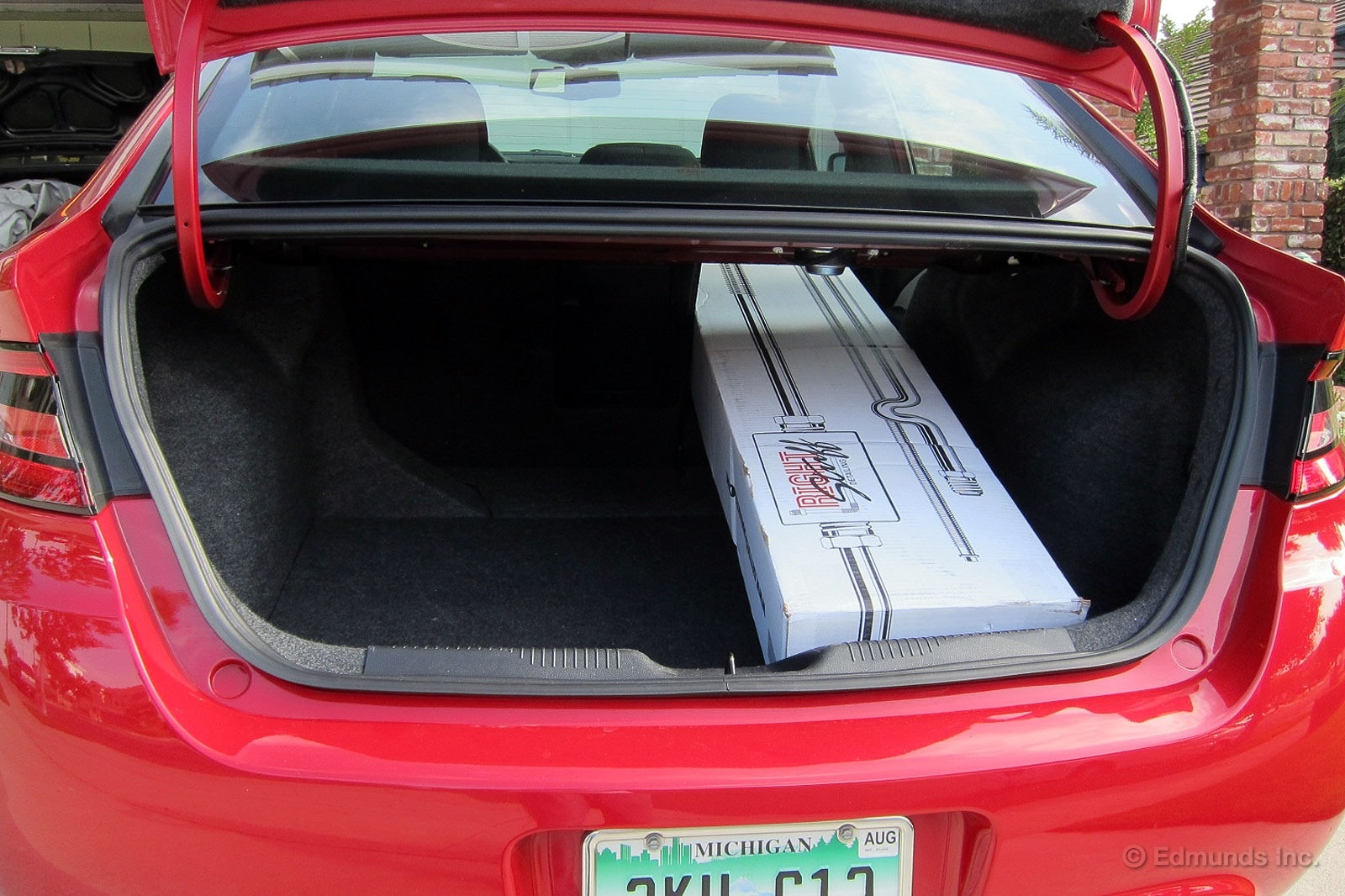
That's a five-and-half-foot tall box filled with brand new brake lines from Right Stuff Detailing for a 1969 Chevy Camaro project my father and I have begun.
Did I think it was going to fit in the trunk of our long-term 2013 Dodge Dart? Nope. But then I remembered the sedan has a 60/40 split fold-down rear seat. I dropped the smaller section easily and slid the box in place. Trunk closed without issue and the car could still hold four passengers.
Very cool.
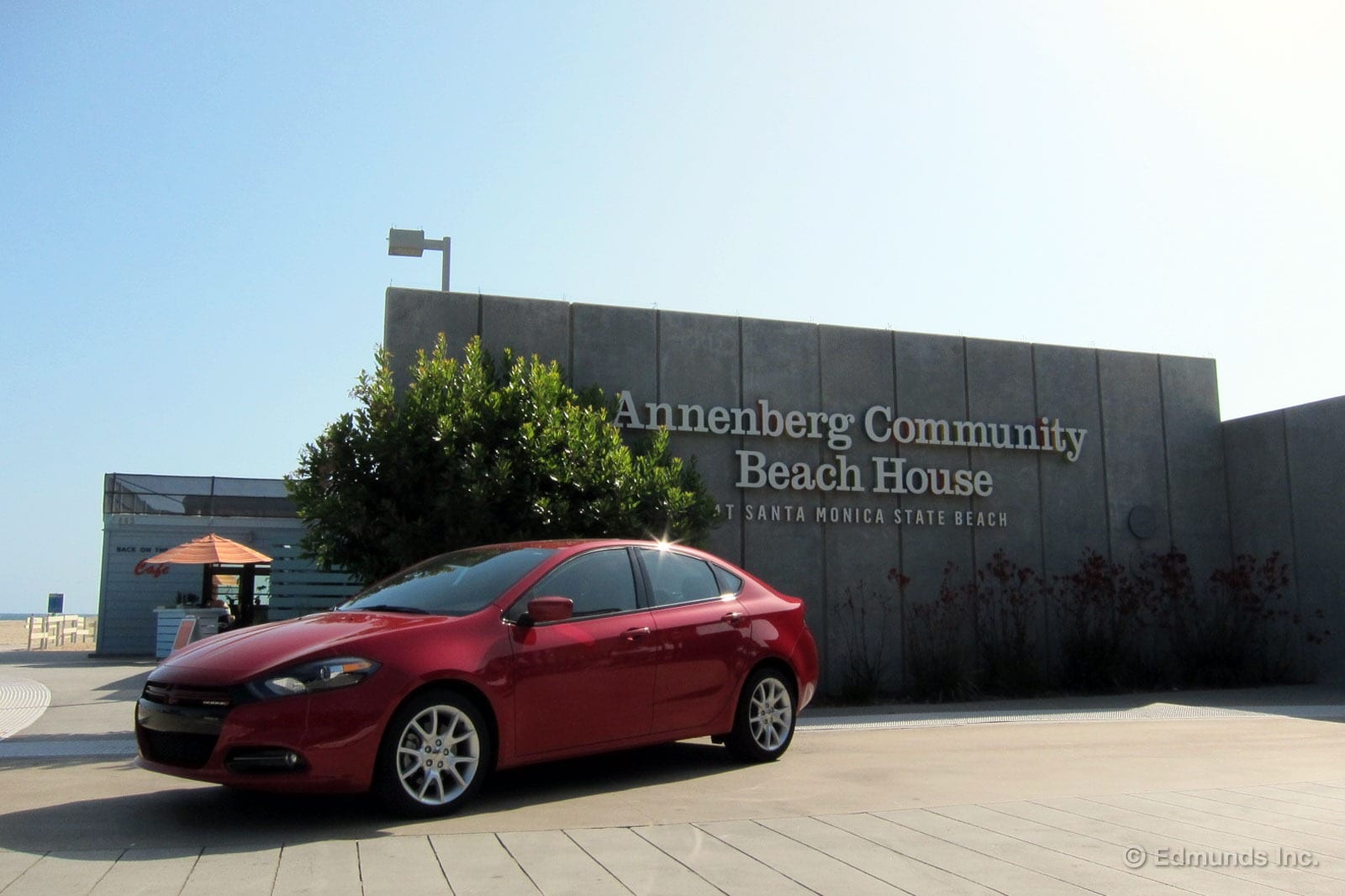
I'm loving our long-term 2013 Dodge Dart right now. I just spent the better part of a week living in the Dart and I'm hesitant to give up the keys.
This front-wheel drive sedan is fun to drive. And it likes to be driven hard. Although I do wish it had paddle shifters on its steering wheel, the Dart Rallye hangs in there nicely and really comes alive when its driver starts driving.
Nothing outside the law mind you, I'm talking about redlining a few gears, trail braking into a few turns and manually shifting the Dart's six-speed Dual Dry Clutch automatic transmission. You know, driving.
Turns out the Dart is engineered for such shenanigans. It likes it when you put that coffee down, stop talking on the cell phone and drive like your Skip Barber instructor taught you to drive.
It's no racecar, but the Dart is more than entertaining. And its performance levels are impressively high when you ask it to accelerate, stop and turn with exuberance.
I really like the way its brakes are easy to modulate, and its ABS system doesn't kick in prematurely. It also turns in very well, and its body motions, especially its body roll are very well controlled. Its Electronic Stability Control is also very well-tuned. Like the Dart's ABS system, the ESC is there when you need it but it doesn't come on constantly when you don't.
You know, there have been rumors of an SRT version of the Dart, a true high-performance iteration of the small sedan from the team responsible for the Viper and the Dodge Challenger SRT8. Now that would be something I'd like to drive.
If Ralph Gilles and his gang get it right, I think the Mazdaspeed3 and Ford Focus ST would have some real competition.
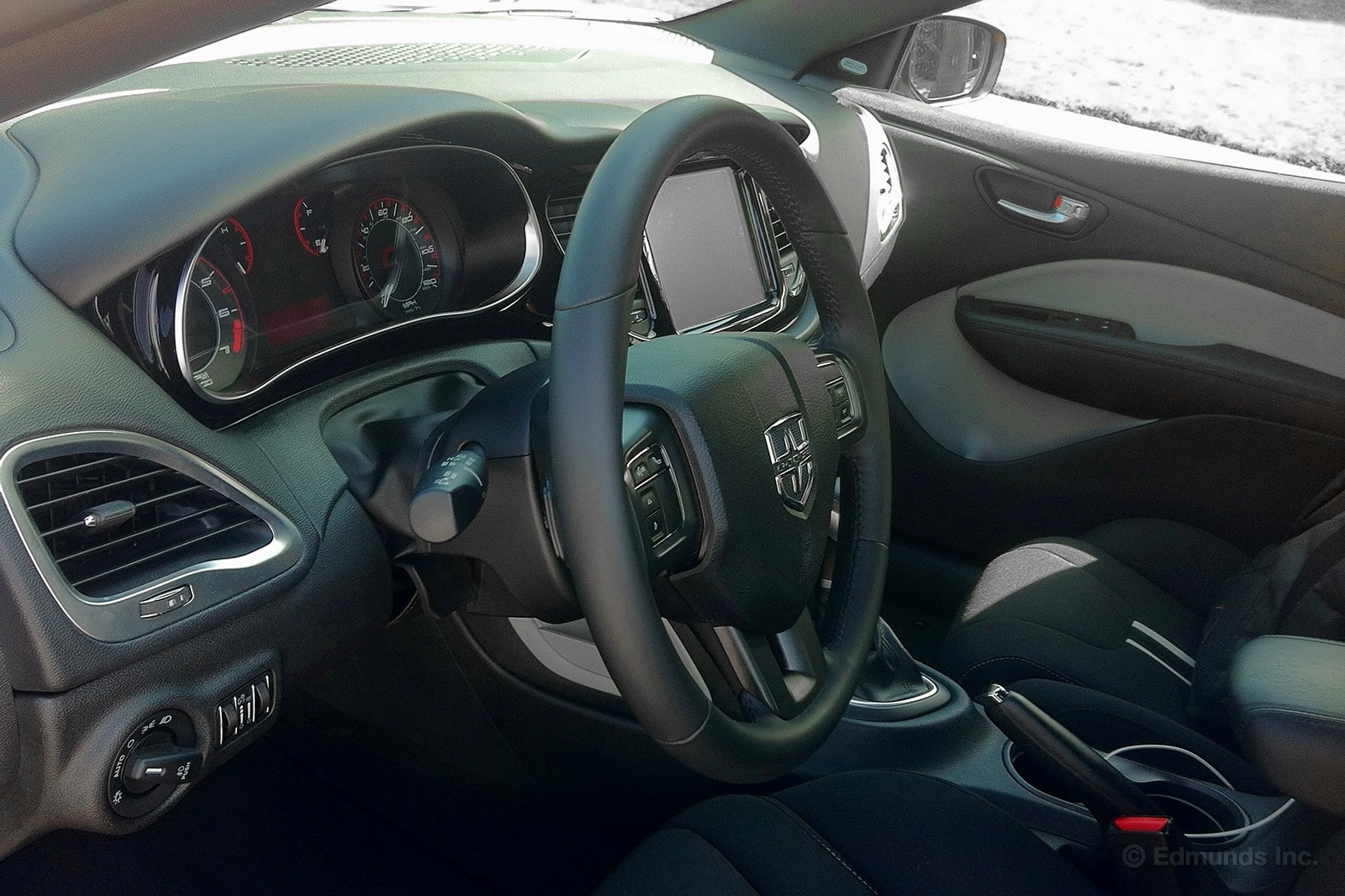
Judging by the adjustments I make to the steering wheel whenever I get in a long-term car, I prefer to have my wheel a bit lower than my colleagues. When I went to drop the wheel in our Dart, I discovered it lacked the range of adjustment that I prefer.
Pictured above is the lowest tilt setting for the wheel. I found it about an inch or two higher than what I consider optimal. I usually have my hands down at the 5- and 7-o'clock positions, switching to the 3- and 9-o'clock positions when I need to use the remote buttons.
For the entire weekend, my hands were uncomfortably hanging off the bottom of the wheel. I'm sure this isn't that big of a deal for a lot of drivers, but those who shuffle steer or prefer a lower adjustment, this should be considered.
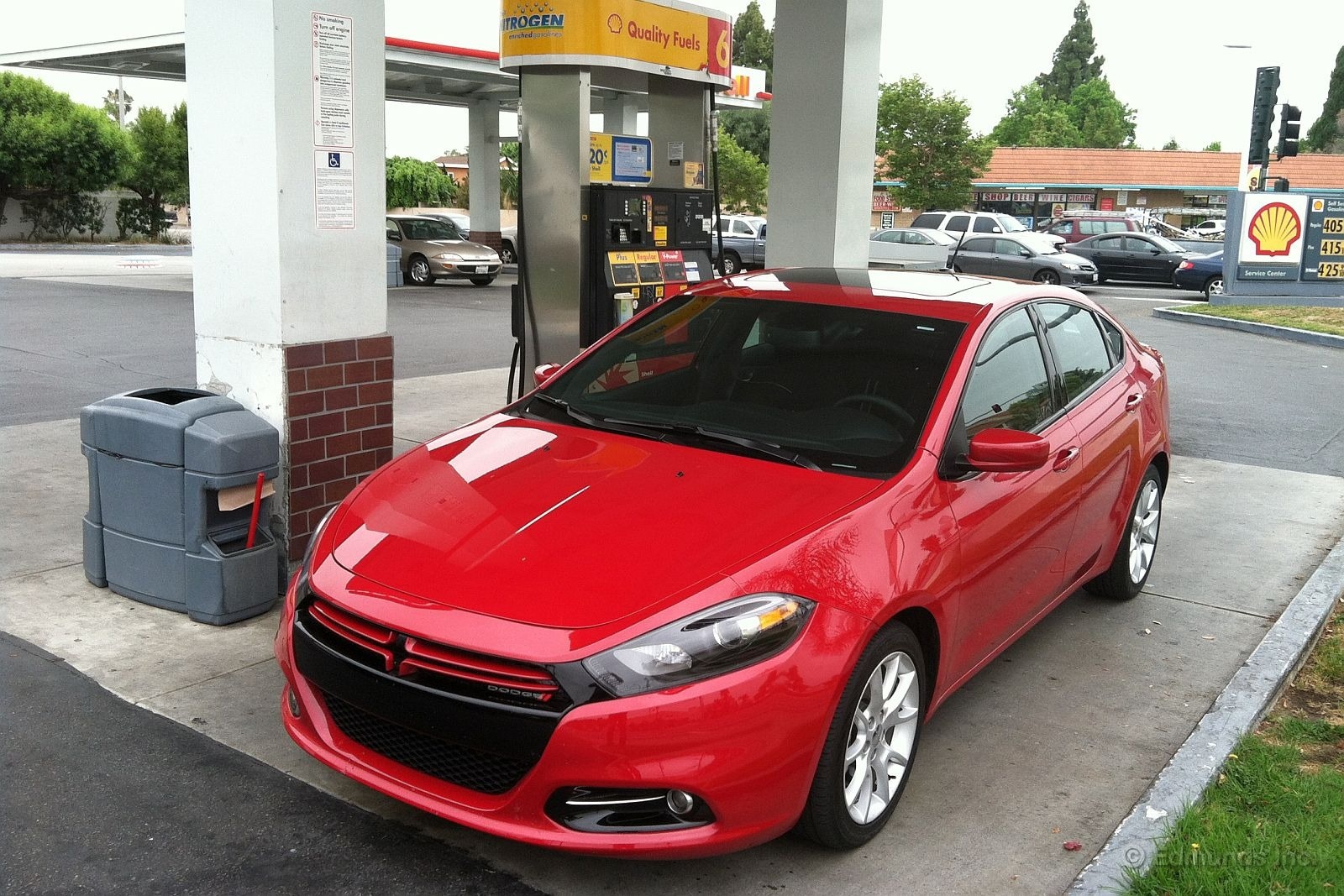
We've put just over 10,000 miles on our 2013 Dodge Dart, and at this point we're starting to get alarmed about its fuel economy.
Compared to an EPA combined rating of 31 mpg, our average stands at 27.7 mph. That's 3.3 mpg shy of the rating, which represents an 11-percent miss.
Lest you think this is a result of lead-footed journalism, know that I personally drove the last tank and my commute-to-work driving style is pretty boring. And I tend to do quite well unless the traffic is absolutely solid, which it wasn't. I got 26.2 mpg.
Our best highway tank so far (35.6 mpg) came on Kurt Niebuhr's road trip. I don't know if he was flying or trying, but the EPA highway rating stands at 37 mpg, so he got somewhat close. Within 4 percent if you want to put a number on it.
But that tank was an anomaly. Only a handful are in the 30s, and 31 mpg is supposed to be the overall average here.
I'm beginning to wonder if small turbos do as well in the real world as they do on the dyno running the EPA test procedure. And this isn't the first such "ecologically boosted" engine to leave me with that impression, either.
Worst Fill MPG: 16.8
Best Fill MPG: 35.6
Average Lifetime MPG: 27.7
EPA MPG Rating (City/Highway/Combined): 27/37/31
Best Range: 487 miles
Current Odometer: 10,680 miles
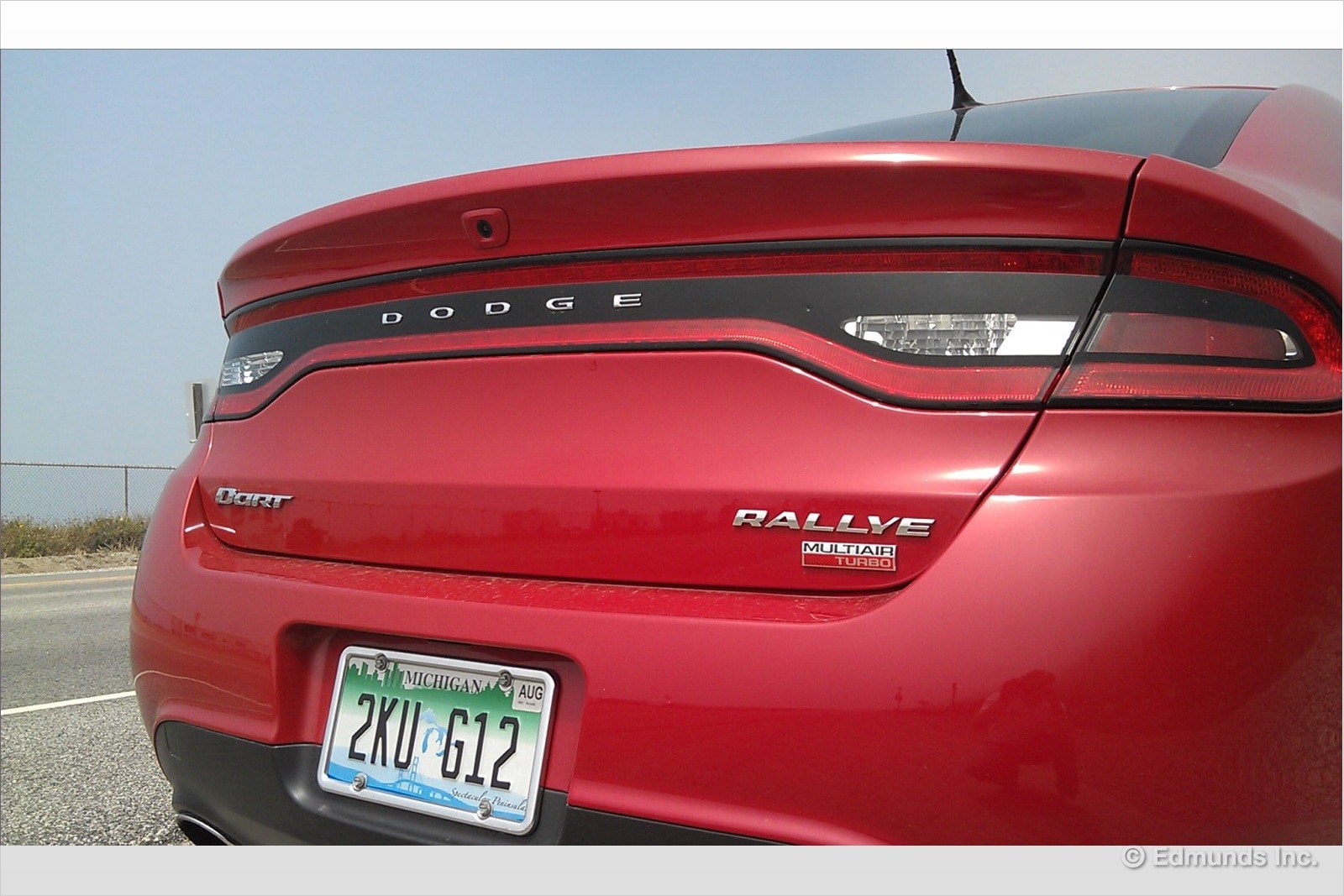
The compact car segment is one that's now chock full of good picks. In addition to the segment fave Honda Civic you have well-regarded choices such as the Ford Focus, Hyundai Elantra and Mazda 3.
As such, if you're a brand new player trying to get in the game it's not easy. The year-to-date sales numbers (through April) for compacts have the Dodge Dart at the back of the pack. Here's the low-down...
Toyota Corolla 103,317
Honda Civic 96,709
Ford Focus 84,455
Chevrolet Cruze 77,763
Nissan Sentra 43,736
Mazda 3 35,037
Dodge Dart 31,064
For the most part, I like our Dart. Specifically, I give props to the handsome styling, peppy turbocharged engine, roomy cabin and user-friendly infotainment system.
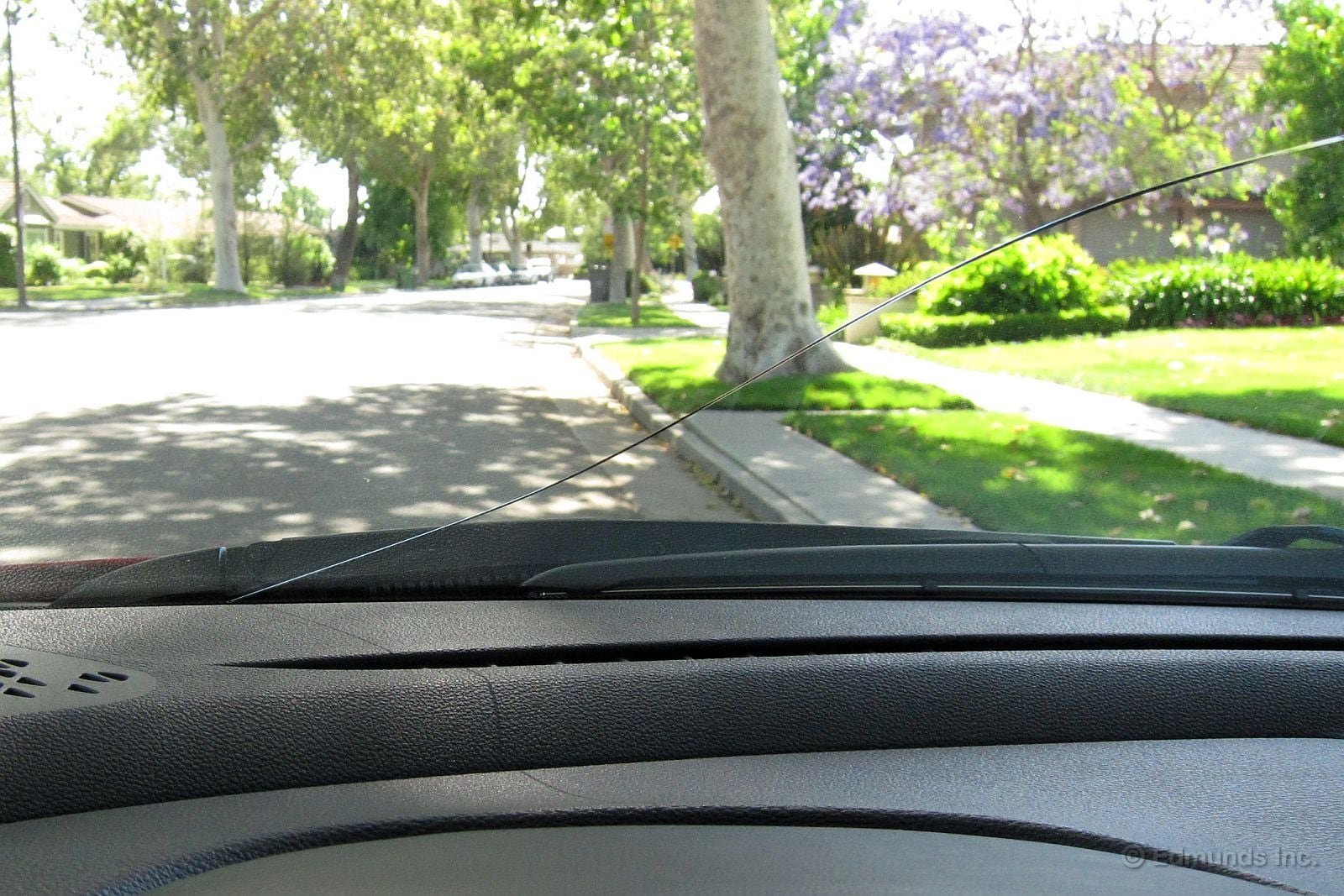
The crack was staring me in the face when I climbed behind the wheel of our 2013 Dodge Dart to drive home. After mouthing a wordless medium-potency swear I dabbed a fingerprint onto the end to track how much it would grow during my outbound commute, if any.
But I couldn't see the impact point from the driver's seat, so I climbed out and looked things over.
Oddly, I found no impact point, not even under the edge of the molding when I peeled it back.
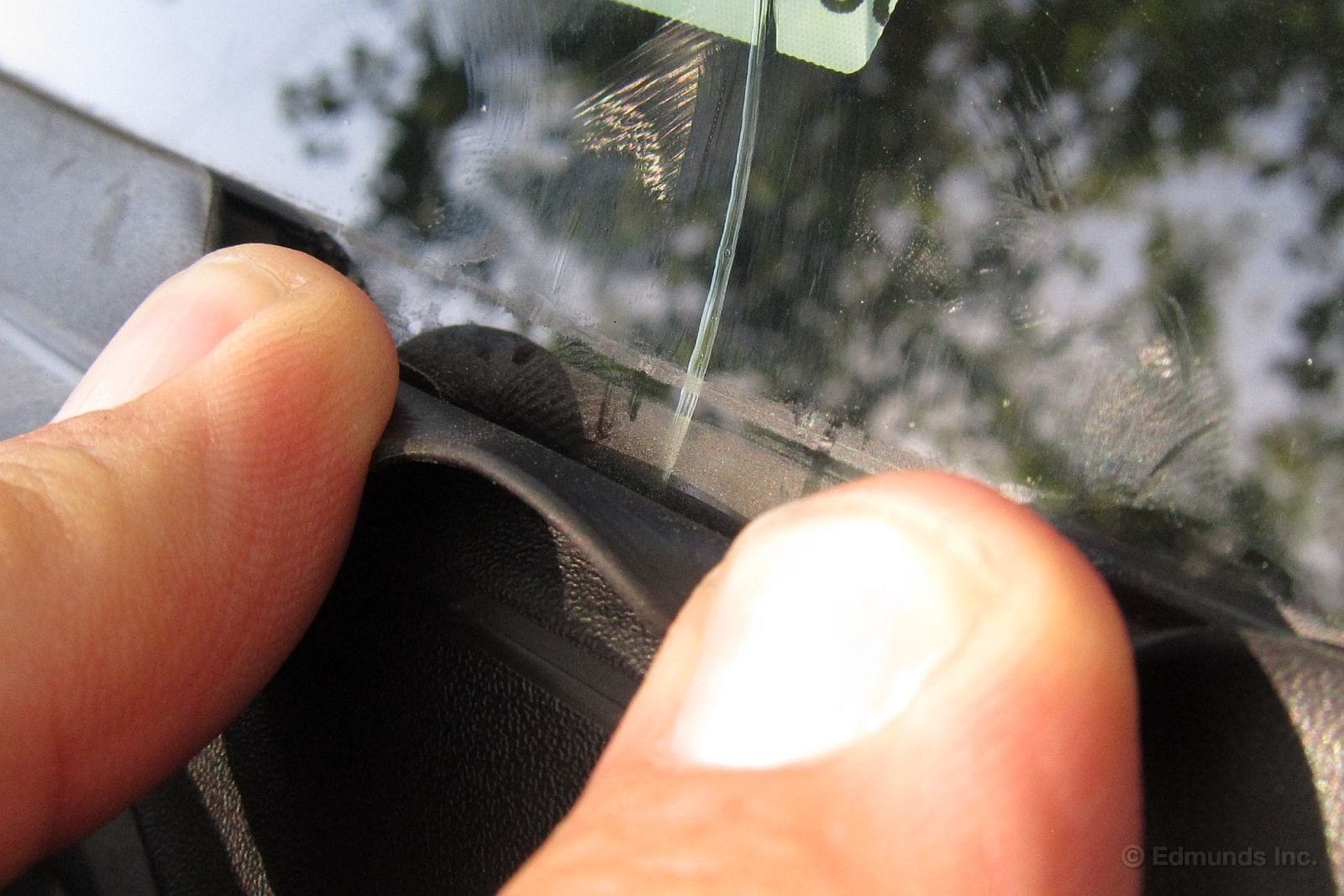
A closer look (that probably won't show easily in photographs) showed that the crack lives on the inner layer of glass, not the outer one. That's not how it usually goes.
Not following me? Car windshields are a two-layer sandwich with a thin transparent sheet of plastic in between that bonds them together. Laminated safety glass, they call it.
It's rare to see a crack on the layer of glass facing the inside of the car with no corresponding sign of impact on the outside. I don't think I've ever seen it before, in fact.
To me this seemed like it could be a defect in the glass itself instead of road damage. So I wheeled in to Glenn E. Thomas Dodge (Ram/Chrysler/Jeep/Fiat) on my way home for an opinion. By the time I arrived the crack had extended three inches past my fingerprint.
Frank, my service writer, was perplexed, too. He explained that glass issues have to be approved at the district service manager level. A regular cracked windscreen wouldn't be covered. Fair enough.
But he seemed to agree this wasn't the usual cracked windscreen. So he took pictures, wrote notes. He and another staffer examined it closely. In the end they came to the same conclusions I had.
The verdict: It'll probably be covered by warranty, but we need to hear back from the DSM at HQ to be sure. If so they'll order the glass and call me back in to have it replaced. Stay tuned.
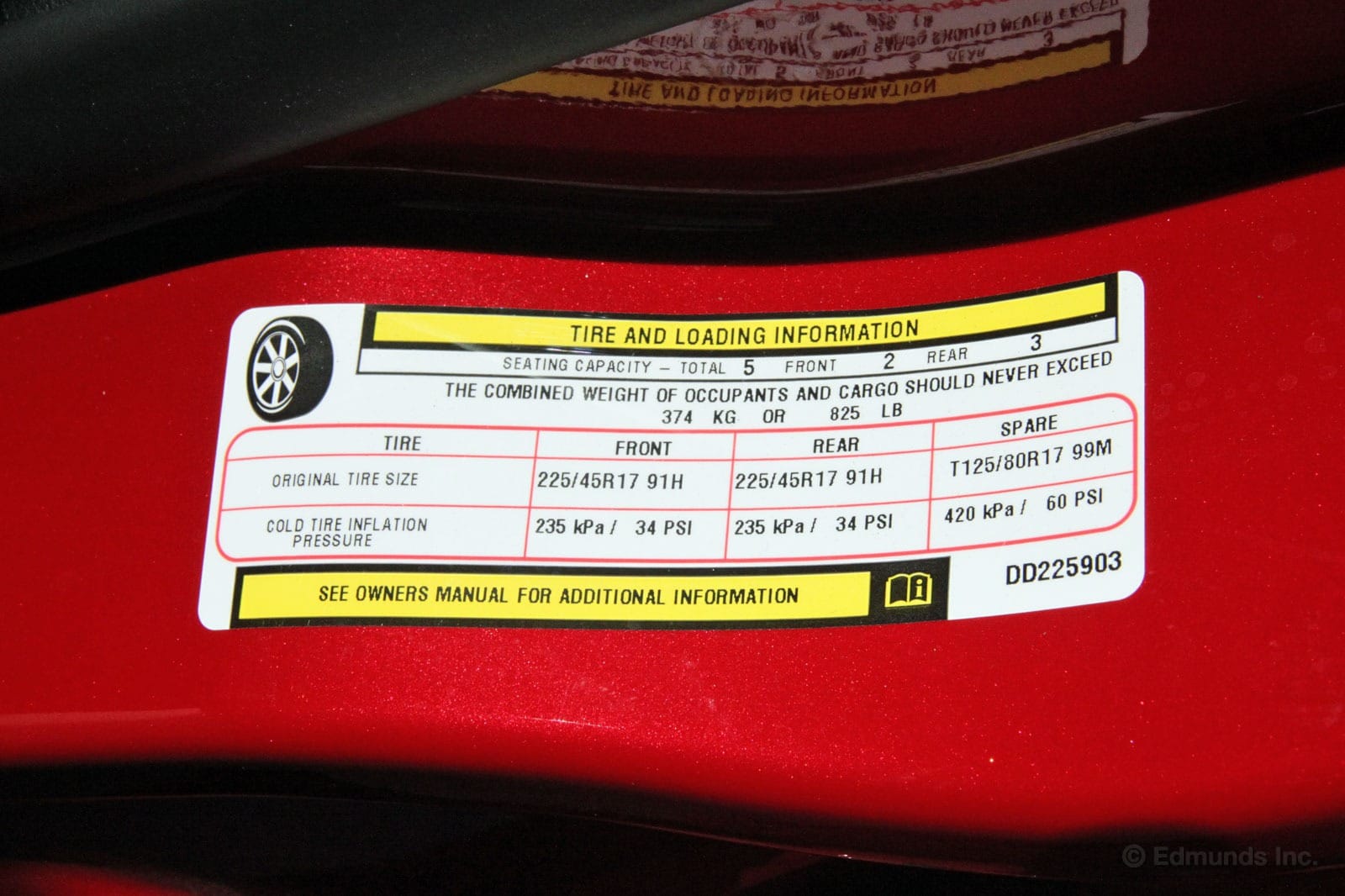
As you can see from this warning sticker, Dodge doesn't recommend putting more than 825 pounds of total weight in the Dart. Seems reasonable until you start doing the math.
If you just consider the driver and passengers, that's an average of 165 per person with five people on board. Better hope none of them are male adults or you're going over the limit real quick.
Even if you keep it to four people on board, that's only a little over 200 pounds per person. Not so bad, but that doesn't leave much room left over for cargo. A trip to the airport with a trunk full of luggage and you'll be over for sure.
Surprising maybe, but most cars in this class have similar limits. It's one of those little known restrictions that's rarely adhered to since it's not likely to cause an immediate issue. Still worth keeping in mind though if you drive a similarly sized car. That warning is there for a reason.
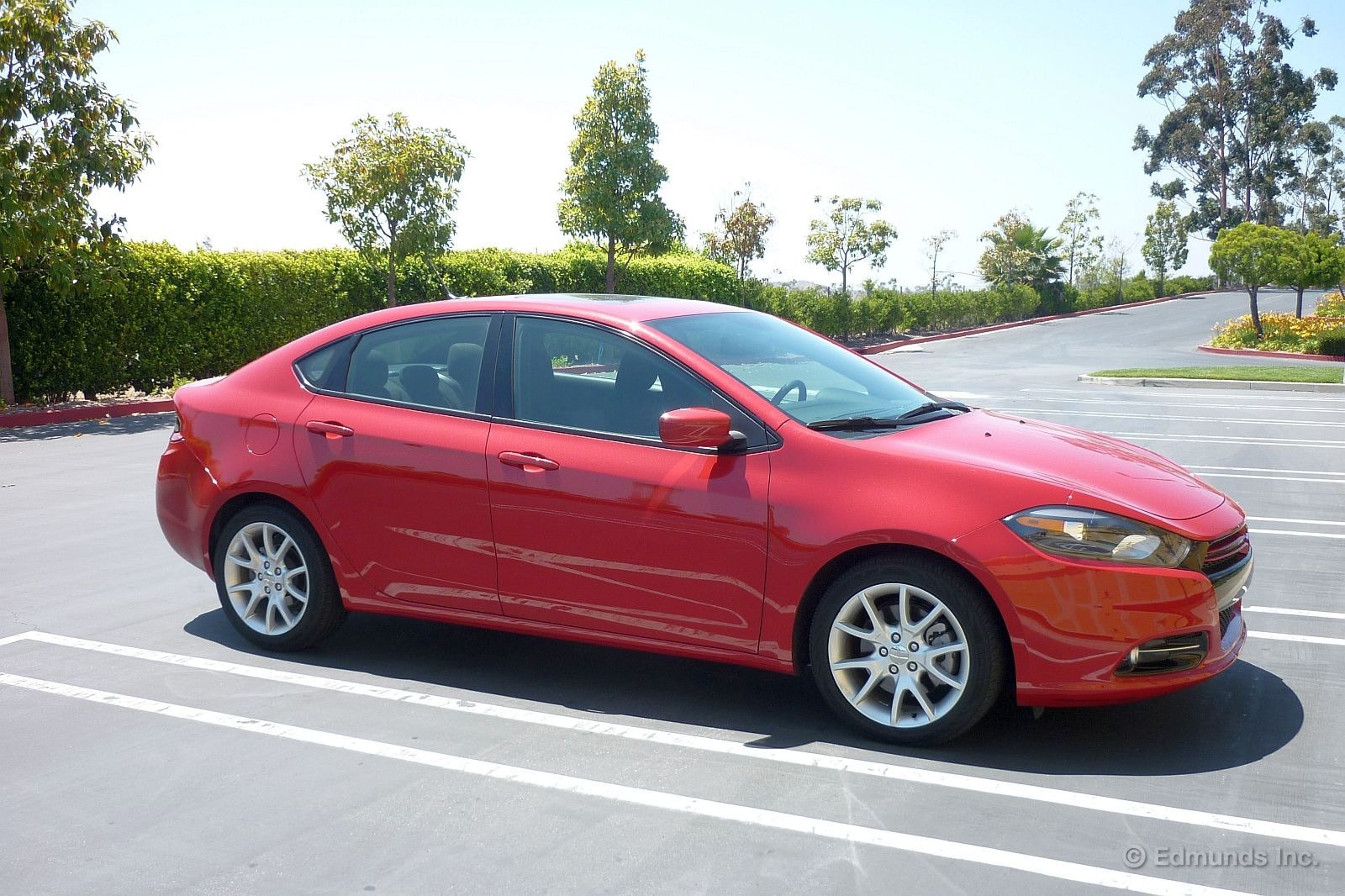
I met a friend of mine the other night at the movies. Afterwards, as we were walking back to our cars in the parking garage, my friend, who isn't what you would call a "real car person" (whatever the definition of that is anyway), asked me what car I had tonight.
"Dodge Dart," I said.
"Oh, cool!" she said. "Can I see it?"
"Well, you can if you want," I half protested. "But honestly, it's really not all that special," I said. "It's just a pretty normal little car."
"What, really? I thought it was supposed to be all kinds of sporty," she went on.
"Oh, you've been watching those commercials with the rally driver sliding the Dart all around, haven't you?"
"Well of course! It looks so cool."
Travis Pastrana, your work is done here.
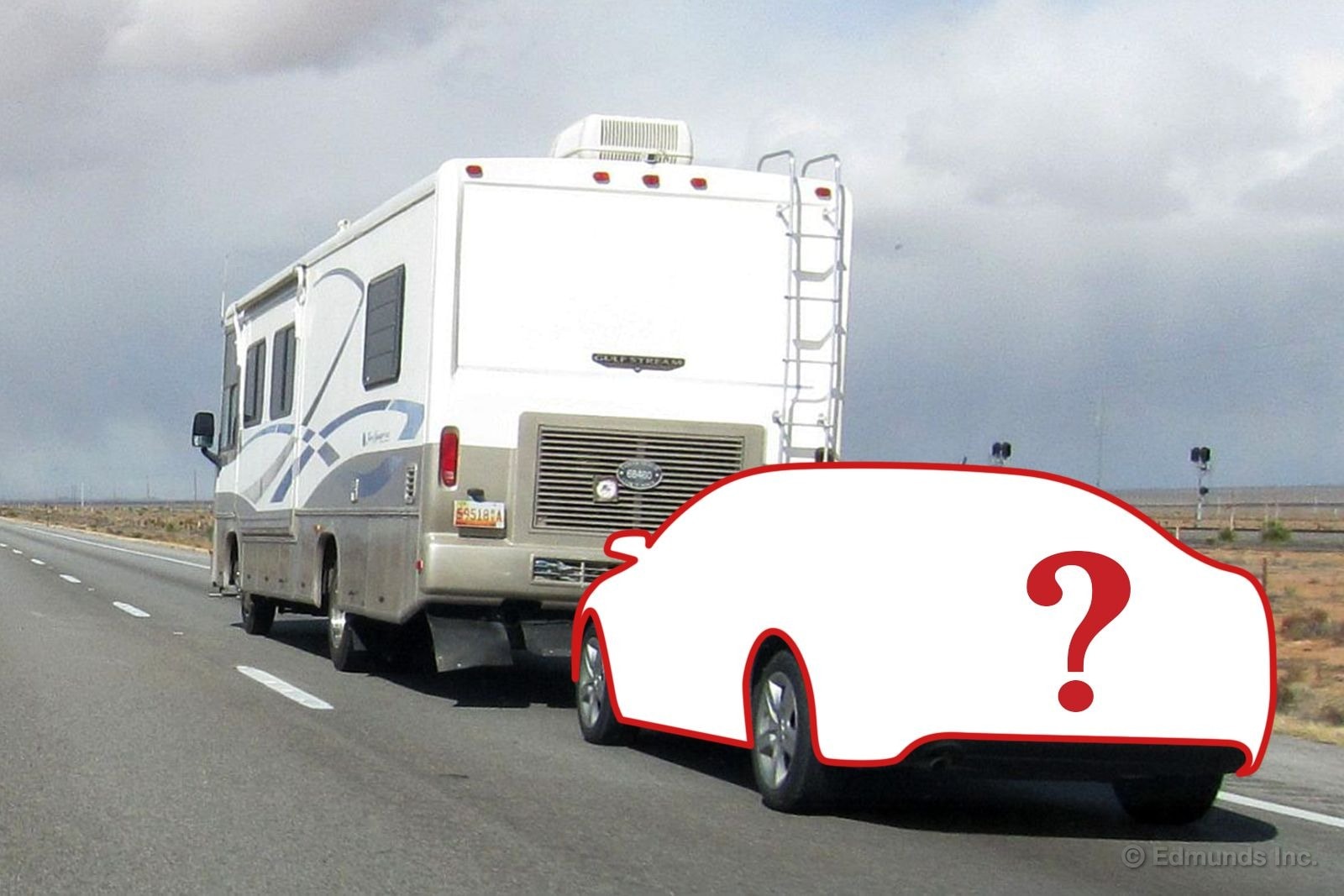
You can tow any car behind a motorhome if you bring a trailer. But motorhome aficionados rightly consider trailers to be a pain in the butt because they represent extra towed weight and a storage problem. They'd much rather tow the car on its on wheels with a simple tow bar in so-called four-down or "dingy" fashion.
Easy is the watchword here. Motorhome touring is supposed to be fun. A dinghy vehicle can be quickly unhooked and driven around on side trips while the motorhome sits parked with its awnings unfurled and its sliders popped out in full relaxation mode.
Of course there are mechanical implications for the car involved.
What does this mean for the 2013 Dodge Dart? Can you tow one of these with a motorhome?
Yes and no. Page 484 of the owner's manual (available online in pdf form) is essentially a chart that lays out the Recreational Towing capability of the Dart.
Manual transmission: yes. And there are no restrictions on distance or speed, so long as the latter is "legal". Of course, the gear lever must be in neutral and the ignition needs to be in the accessory position (ACC), presumably so the steering is unlocked.
Automatic transmission: no. I should also say we're out of luck, because our Dart has an automatic. From an engineering standpoint there are two fundamentally different automatics in the Dart lineup, though. But both are equally affected.
One is a traditional automatic that comes with the base engine. The second is a dual-clutch automated manual transmission or DCT. That's what we have. There are two clutches within, but to the layman this is an automatic because there is no clutch pedal, no manual rowing of a shift lever. Turns out it's an automatic from a dinghy towing point of view, too, with even more potential for damage than a true automatic.
That much was half-expected, I suppose, but then it gets weird.
The chart goes on to say that dolly towing, the sort of half-trailer that puts the front wheels in the air, is not allowed in any case; the restriction is the same for manuals and automatics alike. This sort of warning is typically reserved for all-wheel drive machines, but the Dart is strictly front-drive. I have no explanation for this.
So the Dart is only good for flat-towing in manual transmission form. Automatics need not apply. Those who like tow dollies need to look elsewhere.
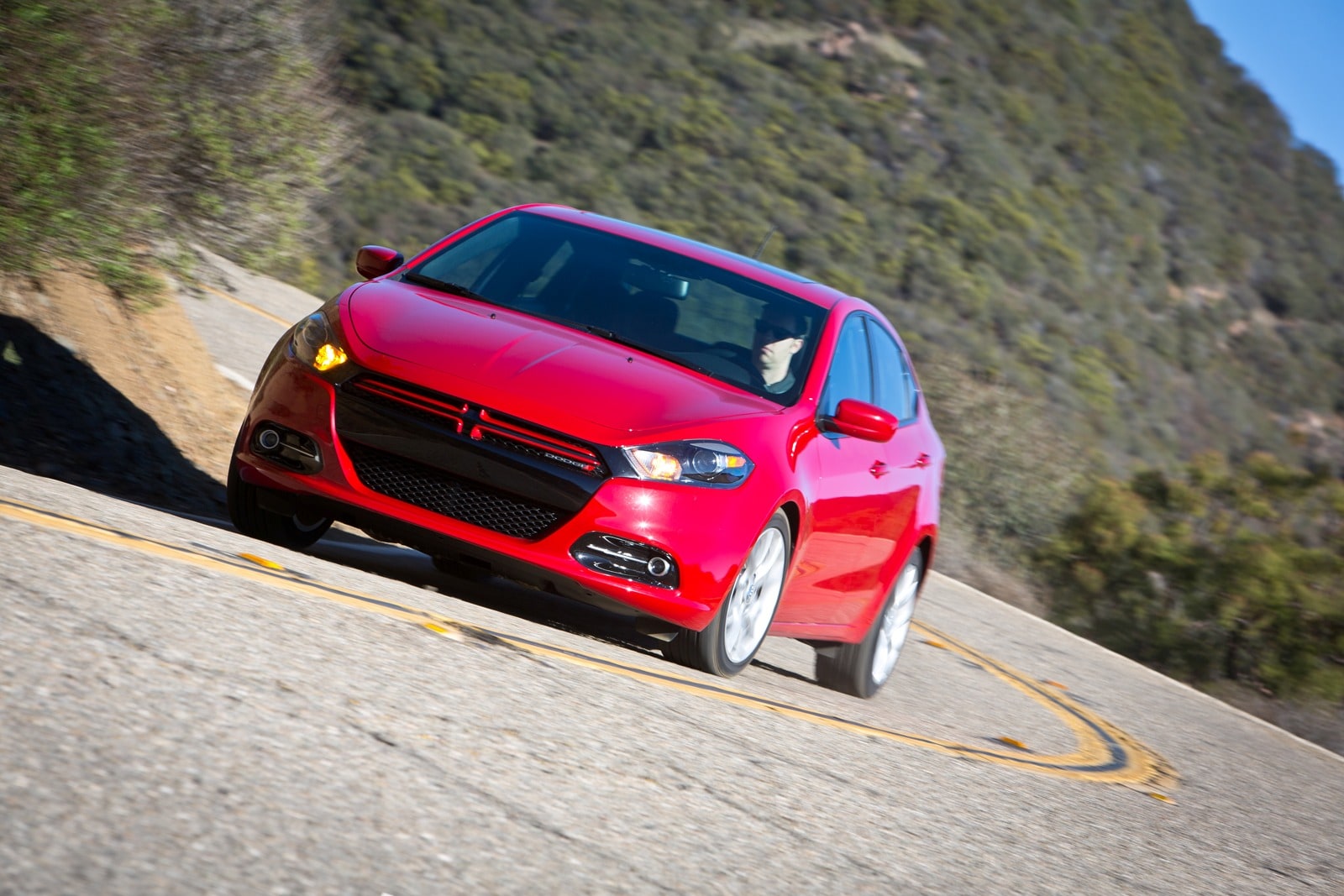
Today Chrysler issued a recall notice for nearly 15,000 2013 Dodge Dart sedans equipped with the 1.4-liter engine and dual-clutch transmission.
Yep, that's the spec for our long-term Dart.
Chrysler says the issue causes cars to stall moments after start-up, and that recalibrating the powertrain control module should cure the problem.
First step for us is to confirm that our car is definitely on the list.
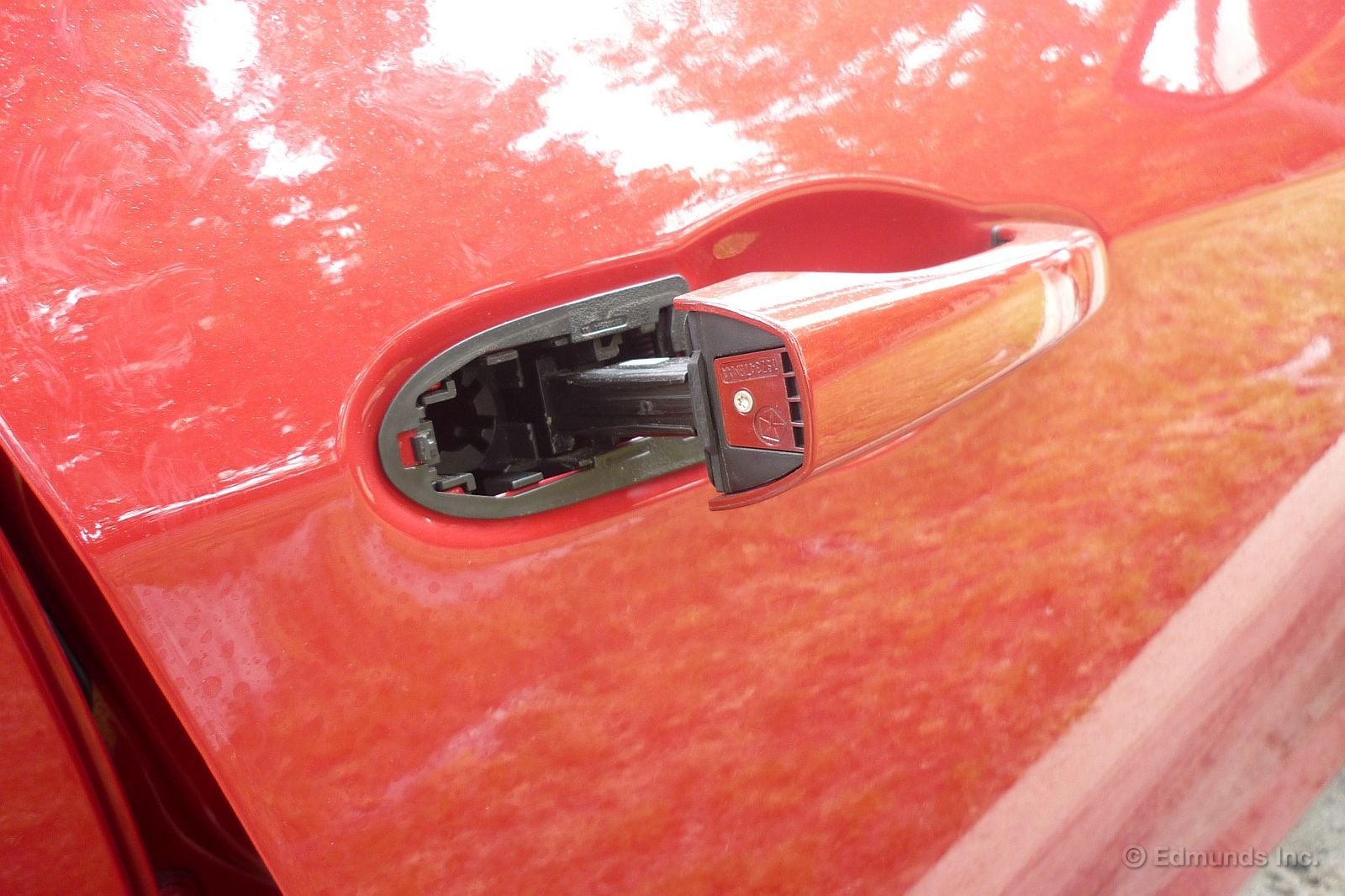
Uh, now that can't be good. That's what I said to myself when I opened the 2013 Dodge Dart SXT Rallye's front passenger door the other day and part of the handle flew off onto the ground.
Now I'm no genius, trust me, but I don't think that's supposed to happen.
I will admit it was a bit more of an "aggressive opening" on my part than usual, as I was in a hurry. But still, this kind of thing shouldn't happen in a brand new, fully modern car.
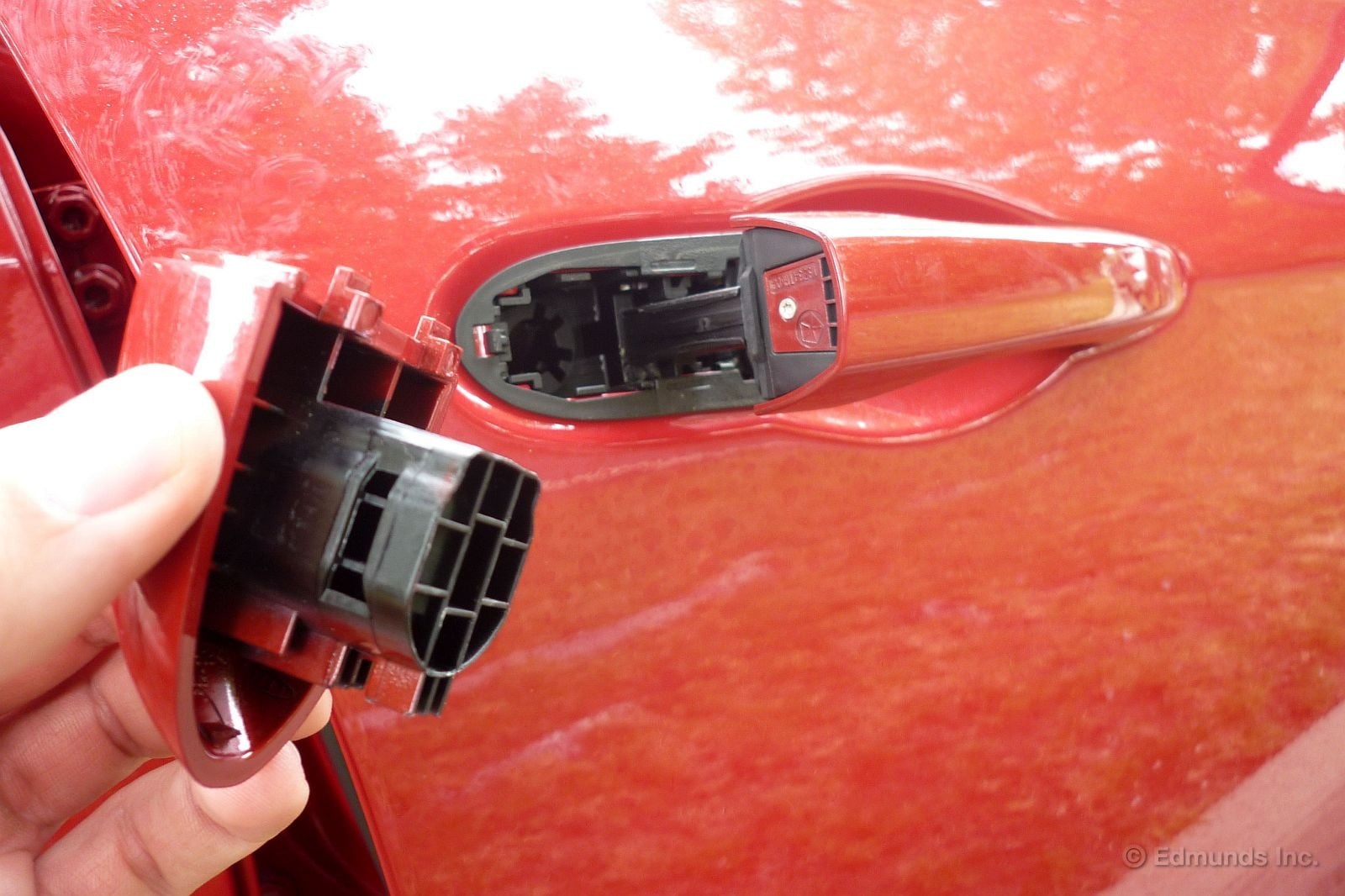
After a little finagling I was able to pop the piece back into place, and the door works again, but the part that came off now sits a little more loosely on the door.
We'll have the dealer inspect it when we bring the Dart in for its new windshield.
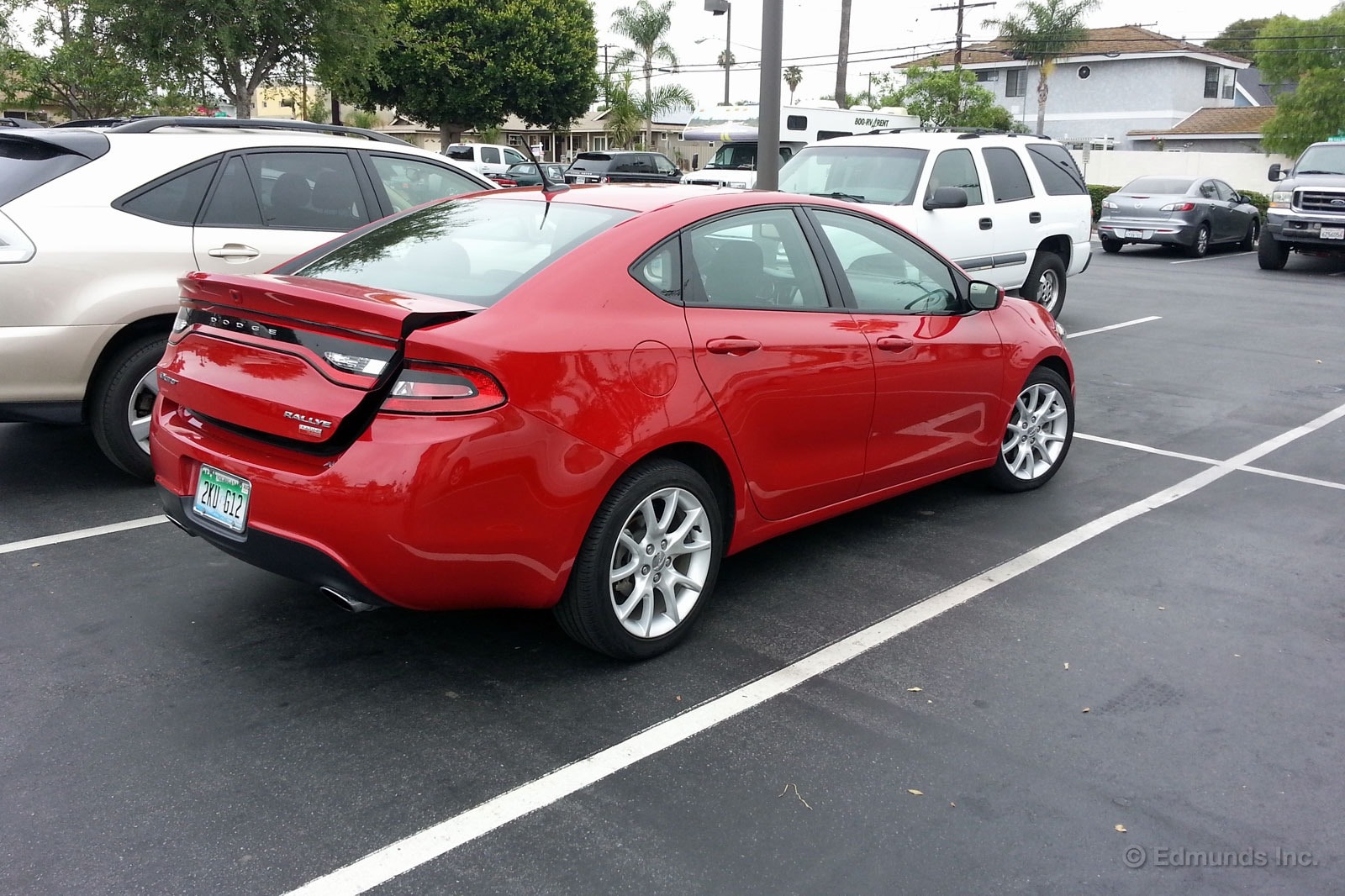
With hands full of whatever, there's nothing better than being able to conveniently open your car's trunk when you're on the approach.
Our 2013 Dodge Dart requires two consecutive pushes of the key fob's trunk button to pop open the cargo area.
The trunk lid doesn't spring to full open as with many cars, but it does open far enough to slide your hand easily under the lightweight lid.
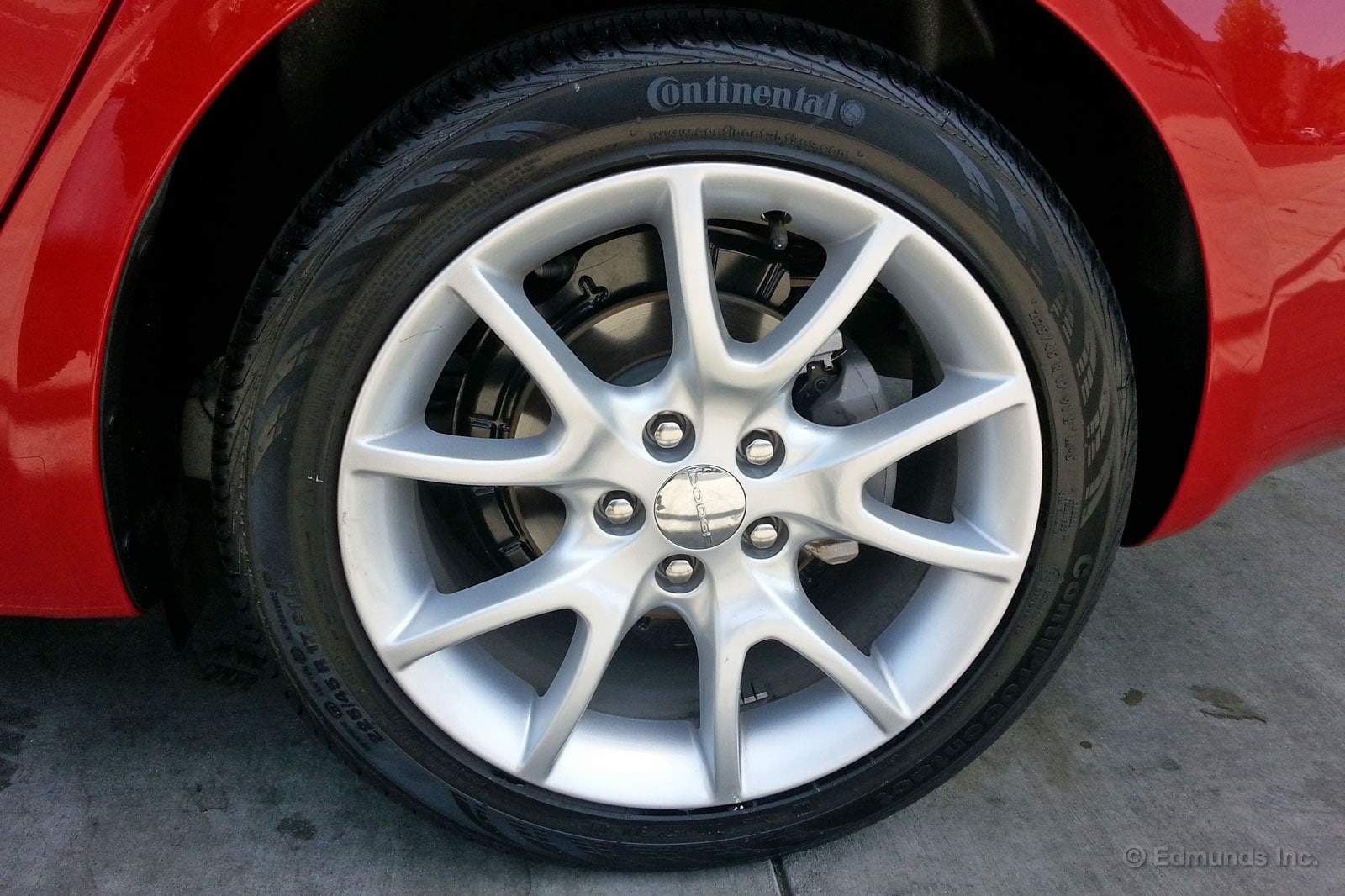
There's been a lot of talk lately in the news about rental tires. The crazy prices people are paying to rent tires when they can't afford to purchase a whole set at once seems practically criminal.
I decided to check TireRack to see what it would cost to rubber-shoe our 2013 Dodge Dart SXT Rallye. TireRack's price for a full set of Continental ContiProContact tires, size 225/45R17 is $448 plus shipping.
And then of course you'd have to mount them.
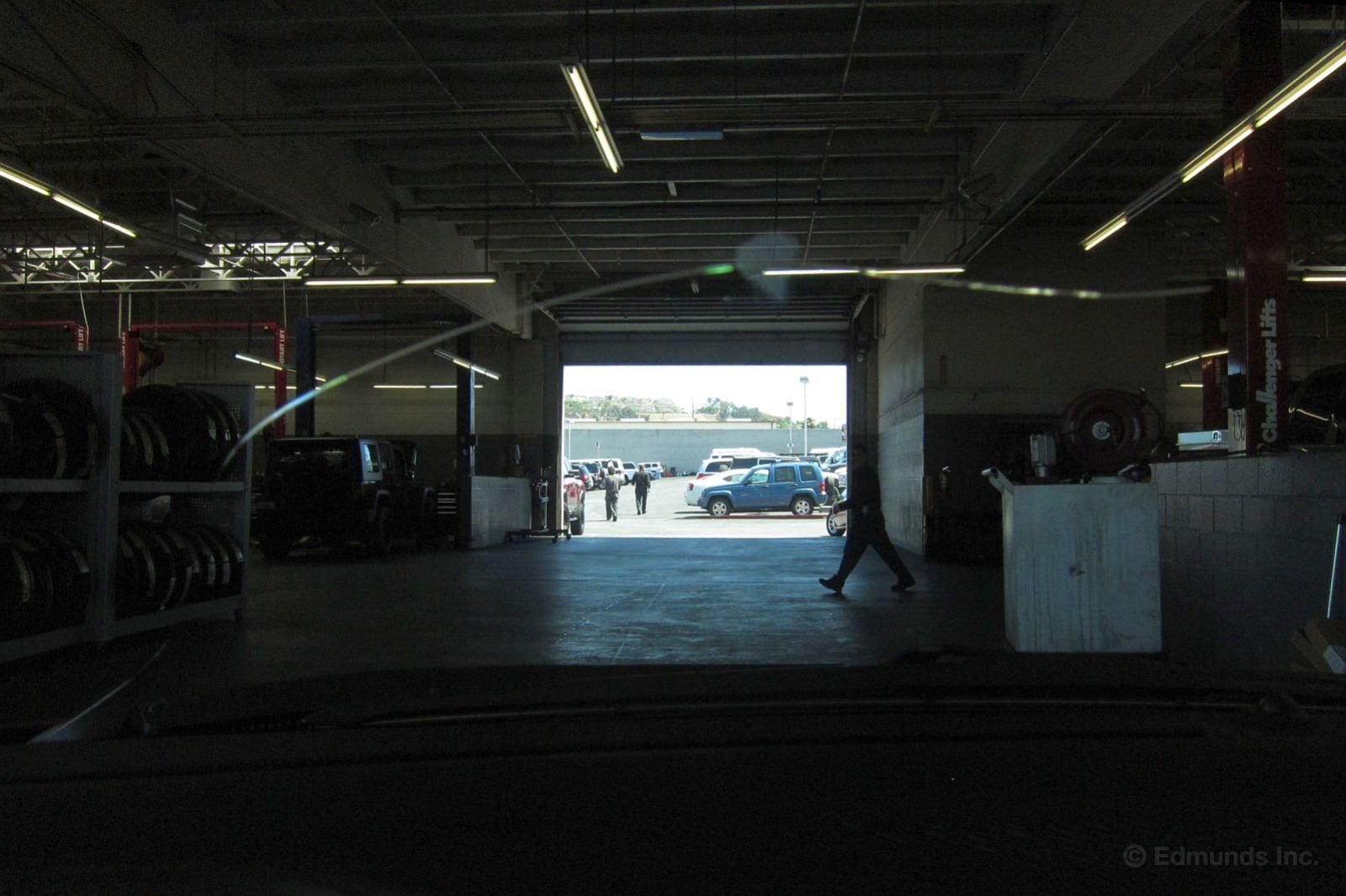
Three weeks and six days. That's how long it has been since I first brought our 2013 Dodge Dart to Glenn E Thomas Dodge on May 28th to have them look at its cracked windshield.
If you'll remember the crack was on the inside, where I could feel it with my fingernail. The outer layer of glass was smooth and unbroken, with no signs of impact. To me this suggested a defect that might be covered by warranty.
The service writer seemed to agree, but he couldn't make the call. So he took pictures and sent a report in for a ruling by the district service manager. Within a couple days word came back that it was indeed covered under warranty, and they ordered a replacement around about the first of June. I was told it would arrive direct from the manufacturer in about a week.
I called a week later. It hadn't arrived. Ditto the week after that. This time I was told it would arrive the next next week, on or around the 18th. Really?
Last Thursday (June 20th) I returned from a three-day Michigan business trip and called once more from the airport. I'd driven the Dart and left it in the airport parking garage so I could go straight to the dealer upon my return.
Then I heard something unfathomable: they still didn't have it.
Well, they had received it, apparently, on June 12th, but the parts department discovered it had been damaged in transit. They ordered a new one. The 18th came and went because the part spent a few days in back-order status in there somewhere.
The service writer was unaware of any of this. The parts department hadn't told him of the broken part, the subsequent re-order and the back-order status. And, it must be said, he hadn't asked until prompted by my phone call.
Why not just replace this windshield in the usual way? I don't like the idea of filing an insurance claim for something that didn't happen out on the road, for what's been ruled a warrantable defect. Sure, most of us pay premiums far in excess of what we ever claim, but it's not their responsibility this time. Besides, every filed claim narrows the eyes of the insurance company bean counters a bit more, gives them an excuse to bump the rates ever higher.
So, even though I'm losing patience at a rapid clip — it's all gone, in fact — I'm stuck gutting it out. I just hope no one gets written up for a fix-it ticket while we wait for the Dodge parts supply chain to pull its head out. That would add insult to injury.

If you're tall like me you know that side window visor coverage is no small matter. Visors that fall short leave a huge gap for those that scoot the seat all the way back, and a lot of cars and trucks fall into this category.
Our 2014 Mazda CX-5 is one of them, but the 2013 Dodge Dart has it covered.
It's probably a combination of factors. The Dart is of course a sedan, and its compact size places the center door post farther forward than it might be in a longer, larger car; the front doors aren't terribly long. And the Dart has a sleekly sloped windshield, which shifts the top of the windshield rearward, bringing the visor pivot along with it. The combined result is a smaller gap for the visors to bridge. Beyond that the Dart is the widest compact out there, and its correspondingly wide interior allows longer visors to fit in the usual stored position, which gives us more to work with when folded to the side.
Whatever the case, there's no gap at all. Some of your other carmakers should be taking notes.

My wife and I recently headed to the pet store in the 2013 Dodge Dart to buy a big bag of dog food.
As Kelly recently pointed out, the remote trunk release is nice, but it doesn't open the trunk all that much. No problem, it's got that "lightweight lid" she talked about.
As my friend Linda said, "Those dogs are gonna starve!"
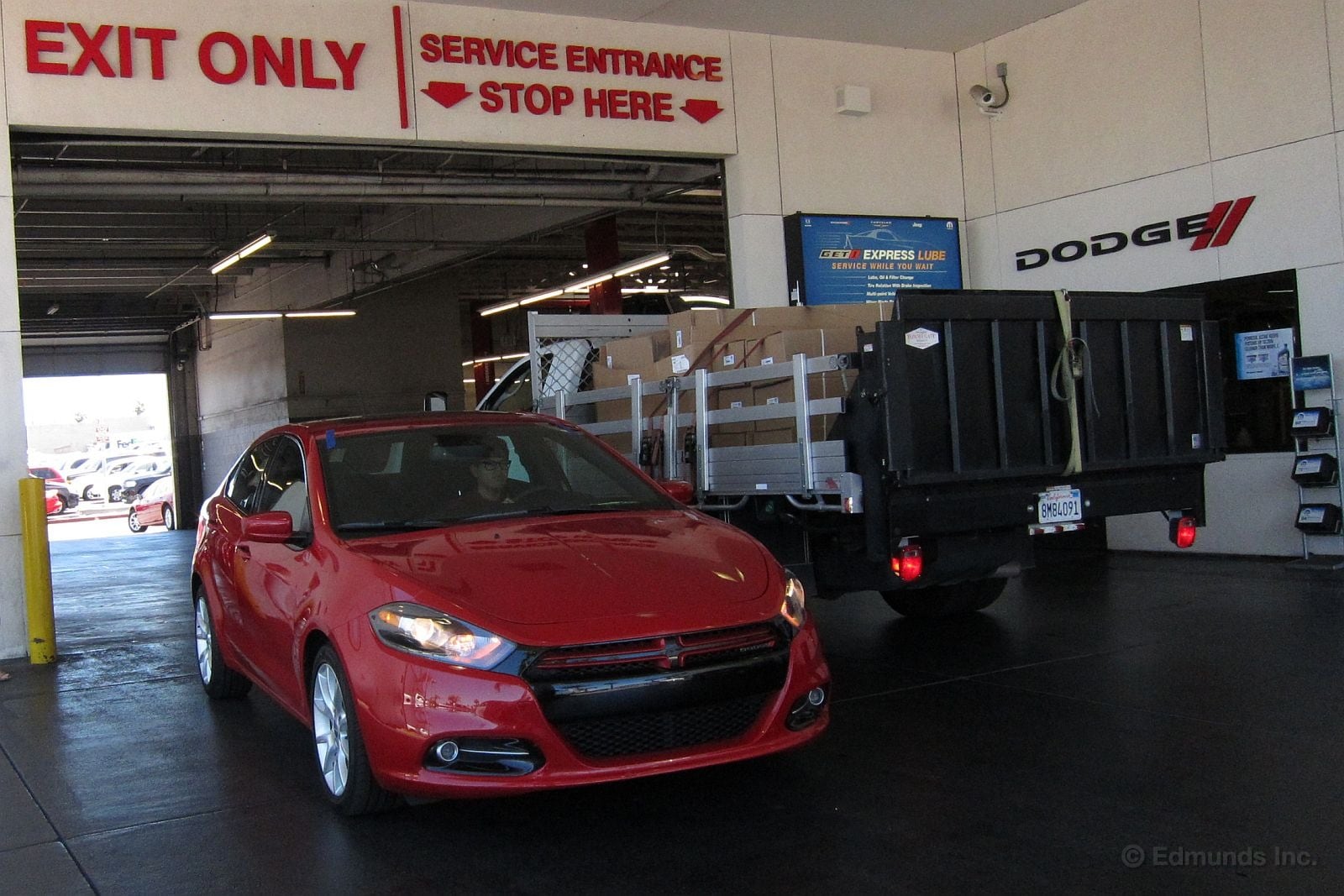
Our 2013 Dodge Dart finally has a new windshield. And we didn't have to pay a cent because the break was deemed a stress crack that was covered by warranty.
We'll never know if the original glass had a manufacturing defect, was nicked ever so slightly during handling at the factory or was installed slightly askew. Nothing ever looked wrong or improper from where we sat. All we know is it spontaneously fractured on the inside.
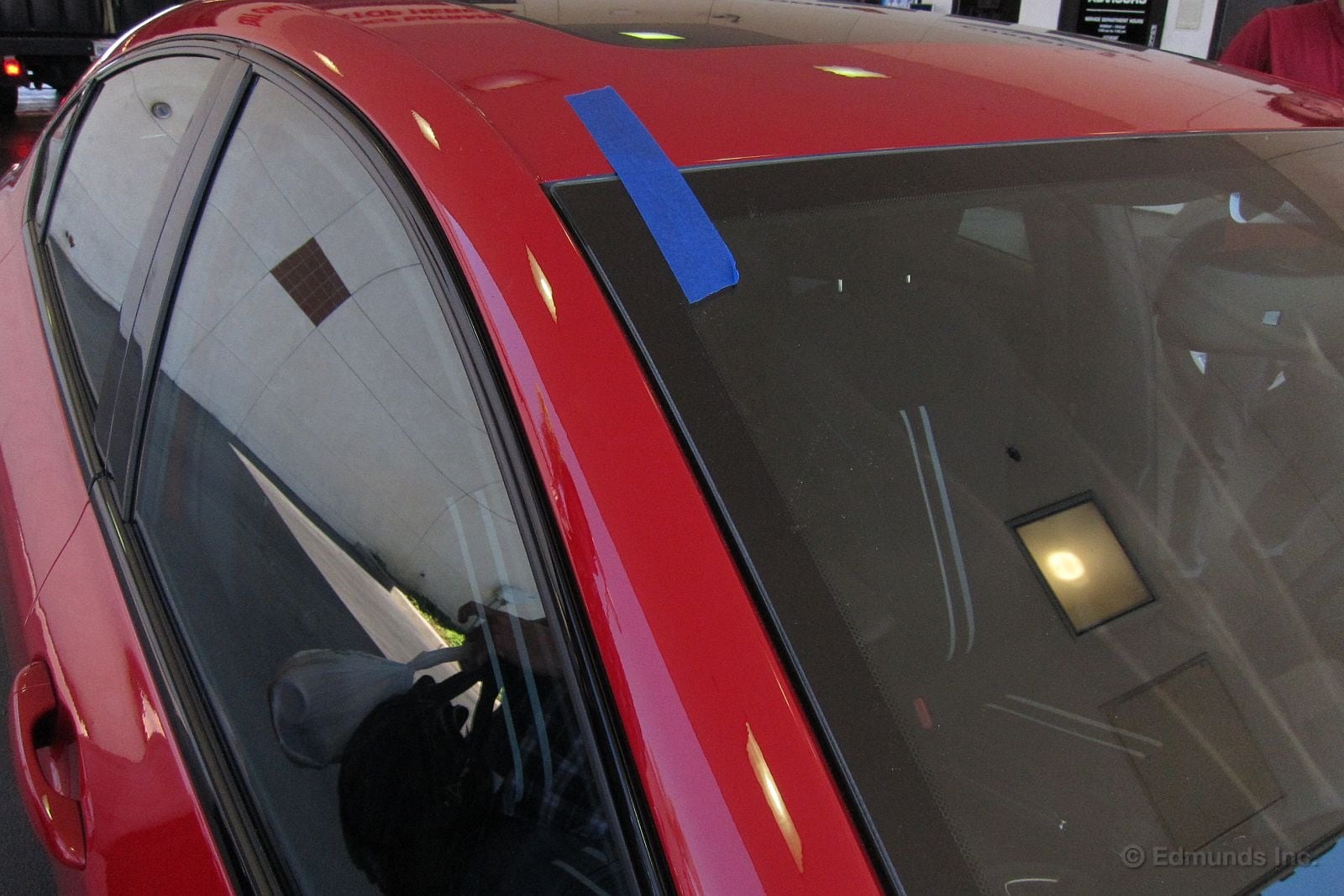
Two strips of the obligatory blue painters tape was still in place when we picked it up some hours after it was replaced, accompanied by the usual suggestion that we wait a full 24 hours before peeling it off.
They always say that. But, c'mon, these measly strips can't be doing much. I think we'll risk it.
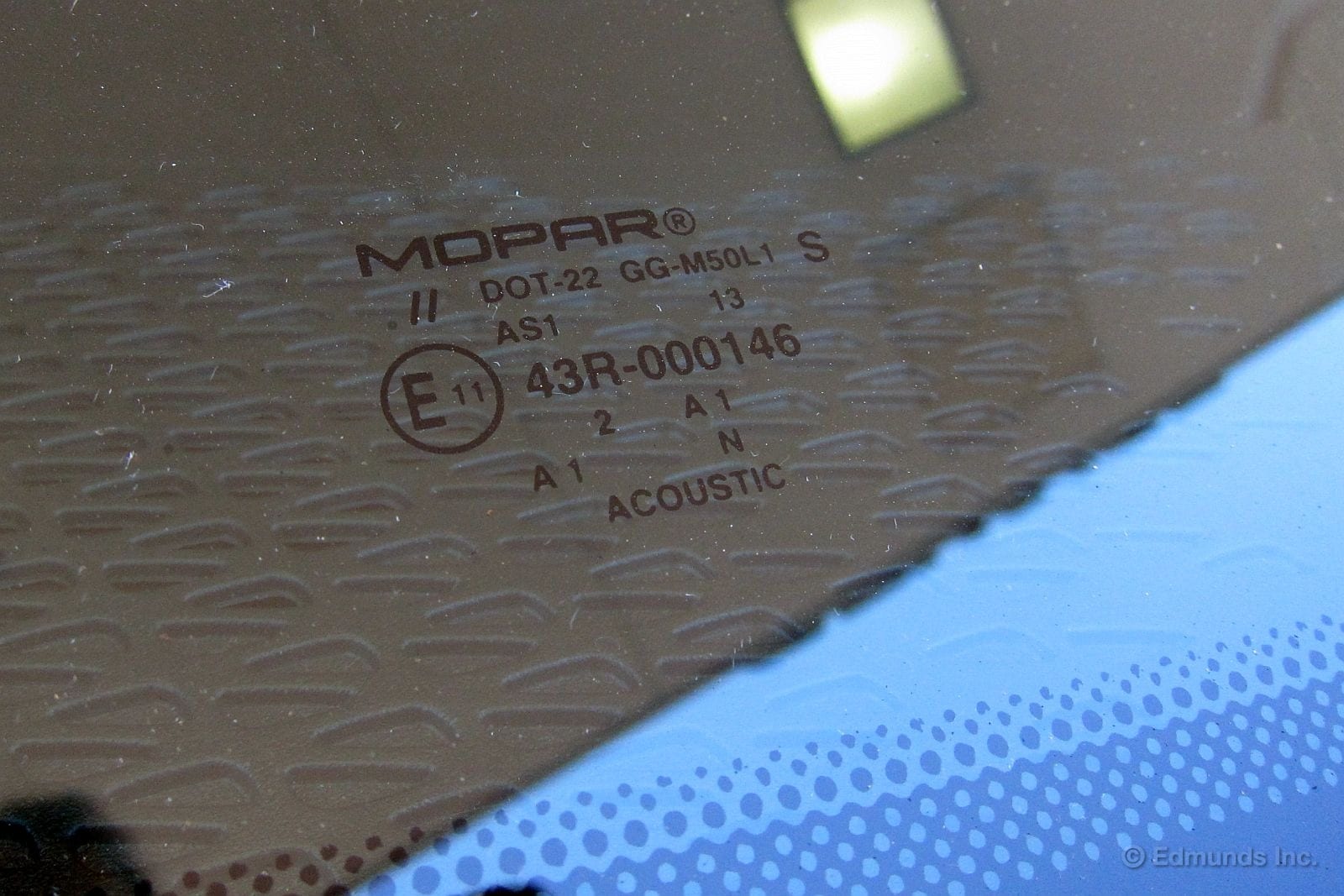
The warranty value of the new glass was $680. Pricey. But this was a factory piece, not the usual third-party replacement part that regular folk and insurance companies buy when they're paying. Add another $136 for the new molding and installation.
This added up to exactly zero for us, though. And in the end our Dart was only out of service a few hours. We could have waited, but we decided to drop it off and swing by later to pick it up.
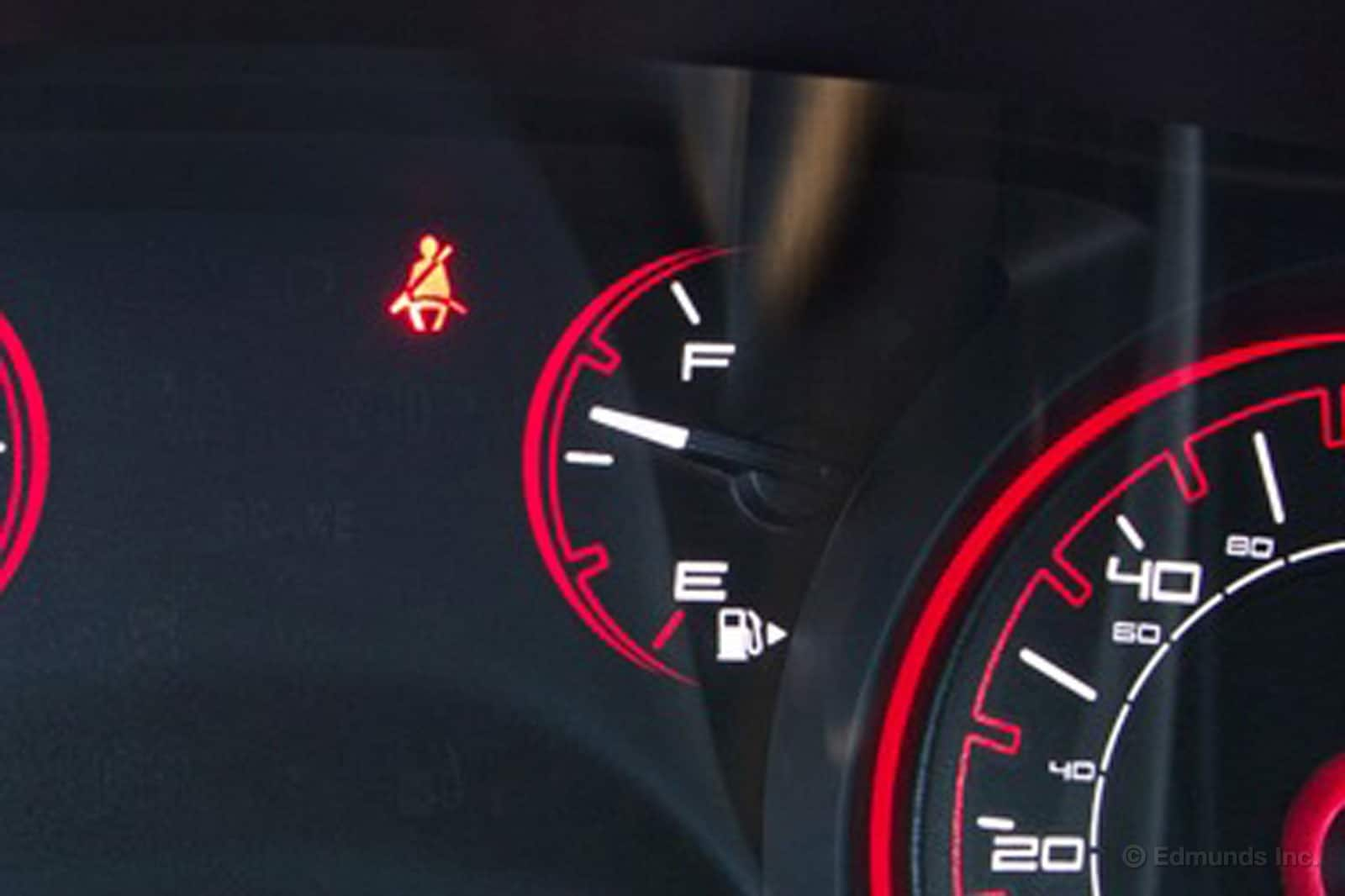
Here is the June fuel economy update for our long-term 2013 Dodge Dart. In the past month we drove the Dart 1,200 miles. This falls 500 miles short of our monthly goal. After 7 months of service, however, we are exactly on track to reach our 20,000-mile long-term goal for the car.
Worst Fill MPG: 16.8
Best Fill MPG: 35.6
Average Lifetime MPG: 27.7
EPA MPG Rating (City/Highway/Combined): 27/37/31
Best Range: 486.7 miles
Current Odometer: 11,914
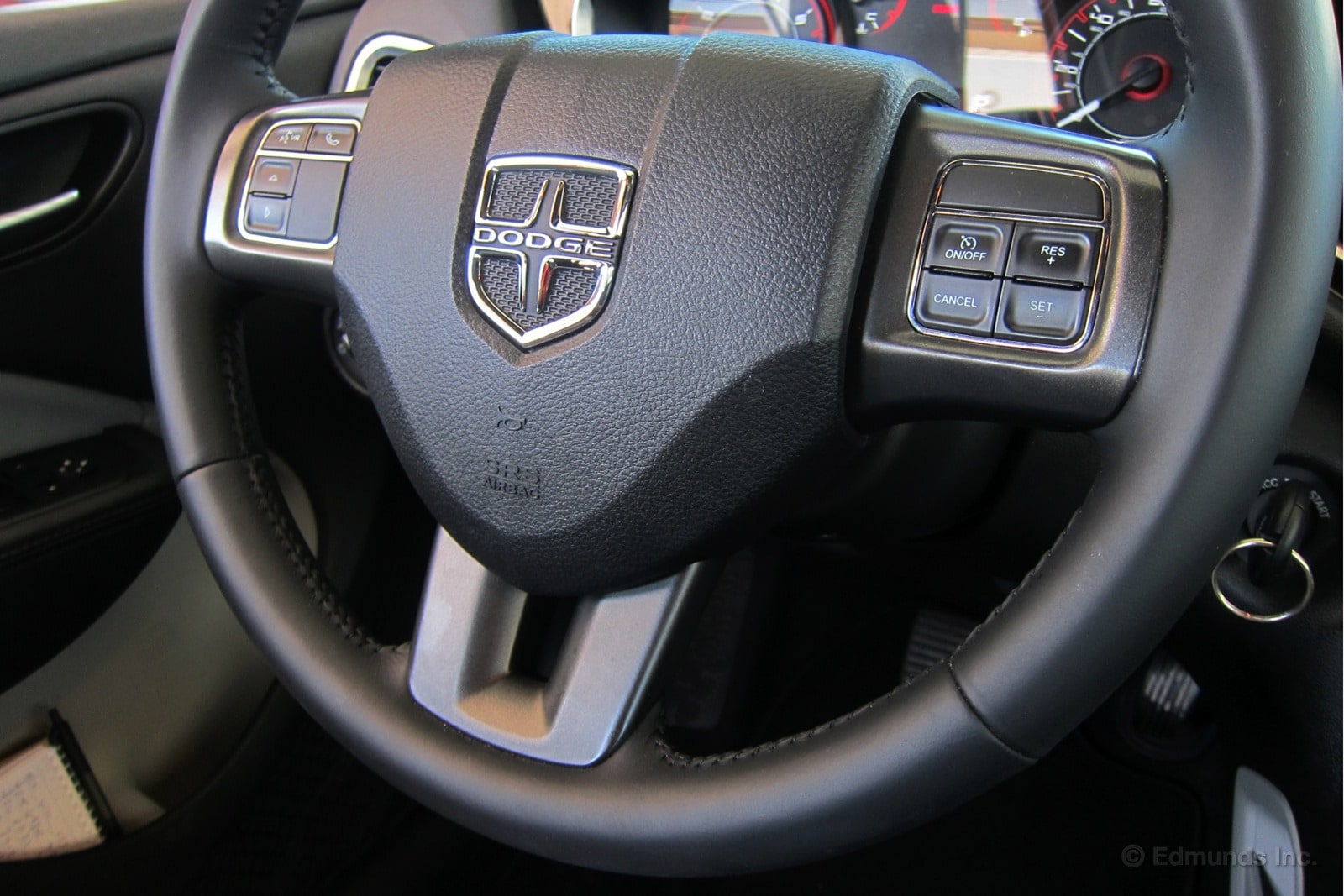
This thick-rimmed steering wheel doesn't seem out of place in Dodge's Charger, for example, but it feels incongruous in the 2013 Dart. While the rest of the interior feels sportishly compact, this chunky pipe wheel feels like it belongs at the front end of at least 300 horsepower. Even then you might not like it, depending on your preference.
It feels like a product planner's intentional, slightly cynical, move to dress over the Dart's economy intentions. More likely, the fat wheel is simply a parts-bin grab reminding you that the Dart is still a work-in-progress, a step toward helping Dodge reclaim the compact segment it lost when the Neon bowed out.
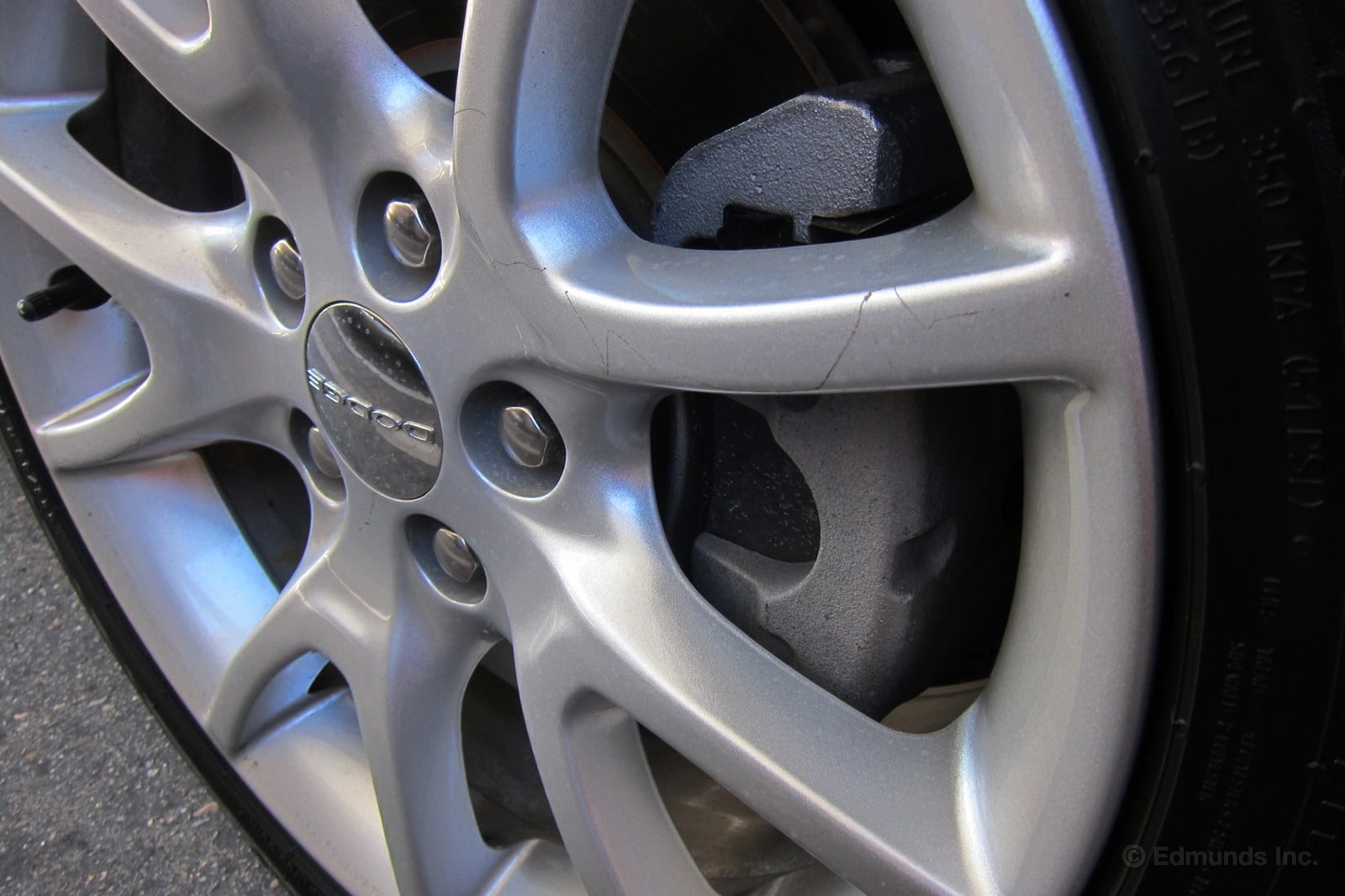
Our long-term 2013 Dodge Dart has sensitive brakes. You roll to a red light or a stop sign, roll onto the pedal gently, then lurch. Even light pressure brings a quick clamp. This proves useful for unexpected slowing at highway speeds, and indeed our Dart slows itself better than most in its class. The Dart requires 117 feet to stop from 60 mph; most in the class require 120 feet or more.
And during the Dart's track testing, our drivers noted firm and consistent brake feel, although the pads were stinking up the place by the end of the braking runs. So while the brakes do their job, the lack of linearity is more than a little annoying when coming to rest at an intersection or crab-walking your way through city congestion.
The Dodge Dart's not the only one with this characteristic, though. Our long-term Ford Focus ST also has sensitive binders, and it was one of the few, more universal grumbles about our Jaguar XF.

By now you know that we received a new windshield for our 2013 Dodge Dart. Everything seemed fine until there was a little early morning condensation on the glass. Guess they forgot to clean it? That's a green traffic signal you're seeing under the grime, by the way.
The defroster took care of the problem, at least temporarily. It was back again the next morning. Looks like it's time to break out the cleaning supplies.

I spent some time in our 2013 Dodge Dart recently. One thing stuck out as a bit annoying to me. The shifter.
In order to shift the car from park, the button on the shifter must be pressed. No big news there. But the click made when park disengages is quite loud. The noise may not have found a way under my skin if I hadn't been in a situation where I was shifting in and out of park frequently. But I was. And it did. Now I hear it every time.
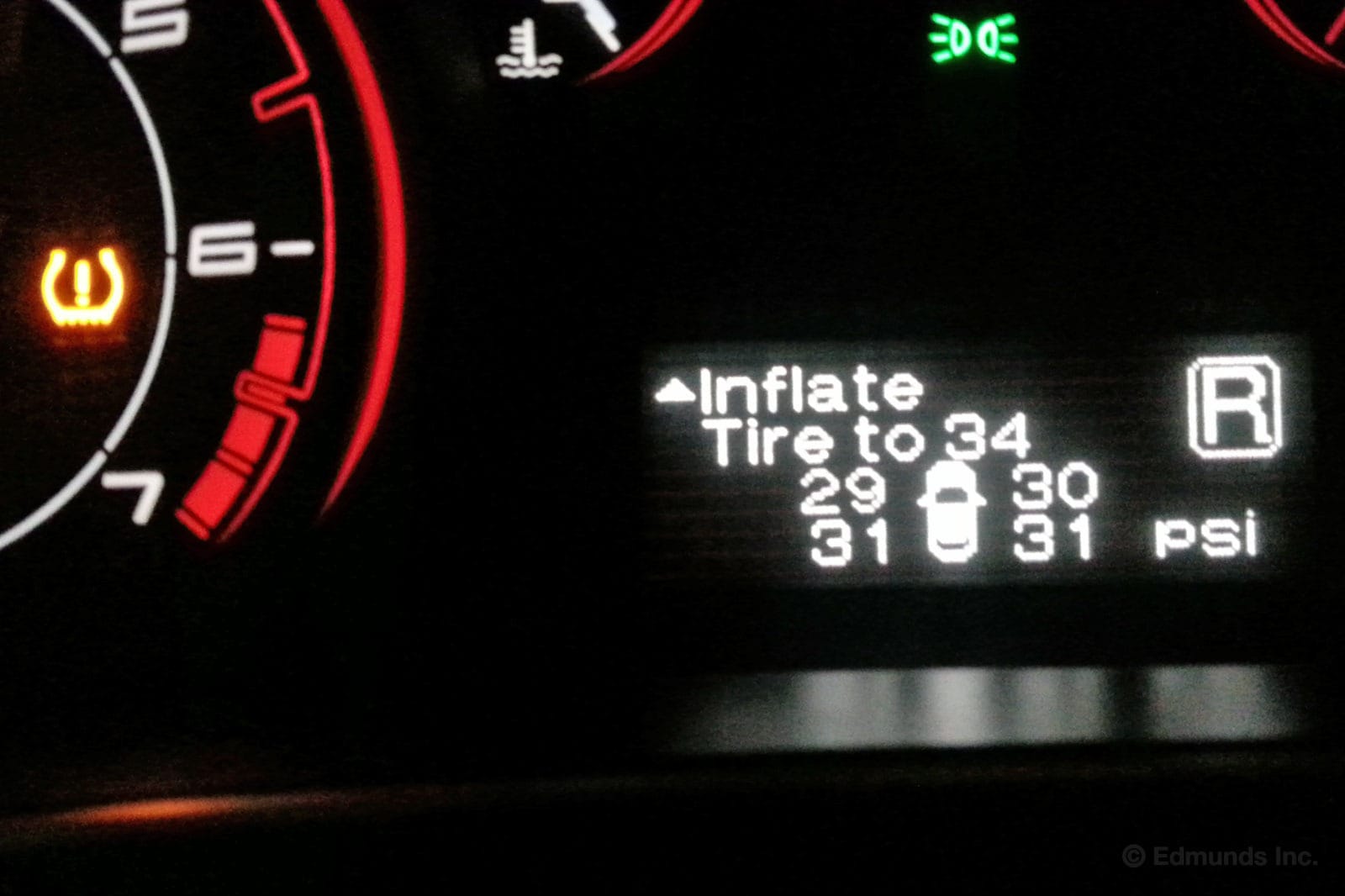
When I saw the TPMS light come on in our 2013 Dodge Dart I was a bit concerned. According to the owner's manual, or "user's guide" as Dodge calls it in the Dart, the warning light will only come on when there's a significant drop in pressure in one of the tires.
Switching over to the tire pressure screen, I noticed that the driver's side front tire was a couple pounds low. At first I thought it was a mistake, but sure enough at some point the readout started flashing to let me know that it was in fact the cause of the warning light.
Now I'm glad to know anytime my tires are a pound or two low. It seems trivial, but every pound makes a difference. In this case, however, I would think the warning light was a little premature. The average driver might think that a couple pounds low is dangerous and pull off the road unnecessarily. In my case, I just added a few pounds when I got home. I'd be curious what Dodge considers a "significant" drop in pressure.

After reading Ed Hellwig's post about the Dart's low tire pressure, I decided to recheck them myself, to see if maybe we had a slow leak. Another reason I did this was because I have a cool tire pressure pump and wanted a chance to use it. I'm a bit of a fanatic about tire pressure because it is so important for safety and fuel economy. But getting the right setting is tricky, since temperature affects the pressure and the temperature and road conditions are often changing. As I drove home I watched the pressure climb as the tires warmed up. Once I got home, I sprung into action.
Last year, I bought this battery-operated tire pump which displays the tire pressure and has a built-in flashlight. The best part is you don't have to pop the hood and connect it to the car's battery terminals. It only took a few minutes to check the yellow sticker to see that the tire pressure was supposed to be 34 psi when cold and bring them all up to the right level. The next morning, it was satisfying to see the warning light was off.
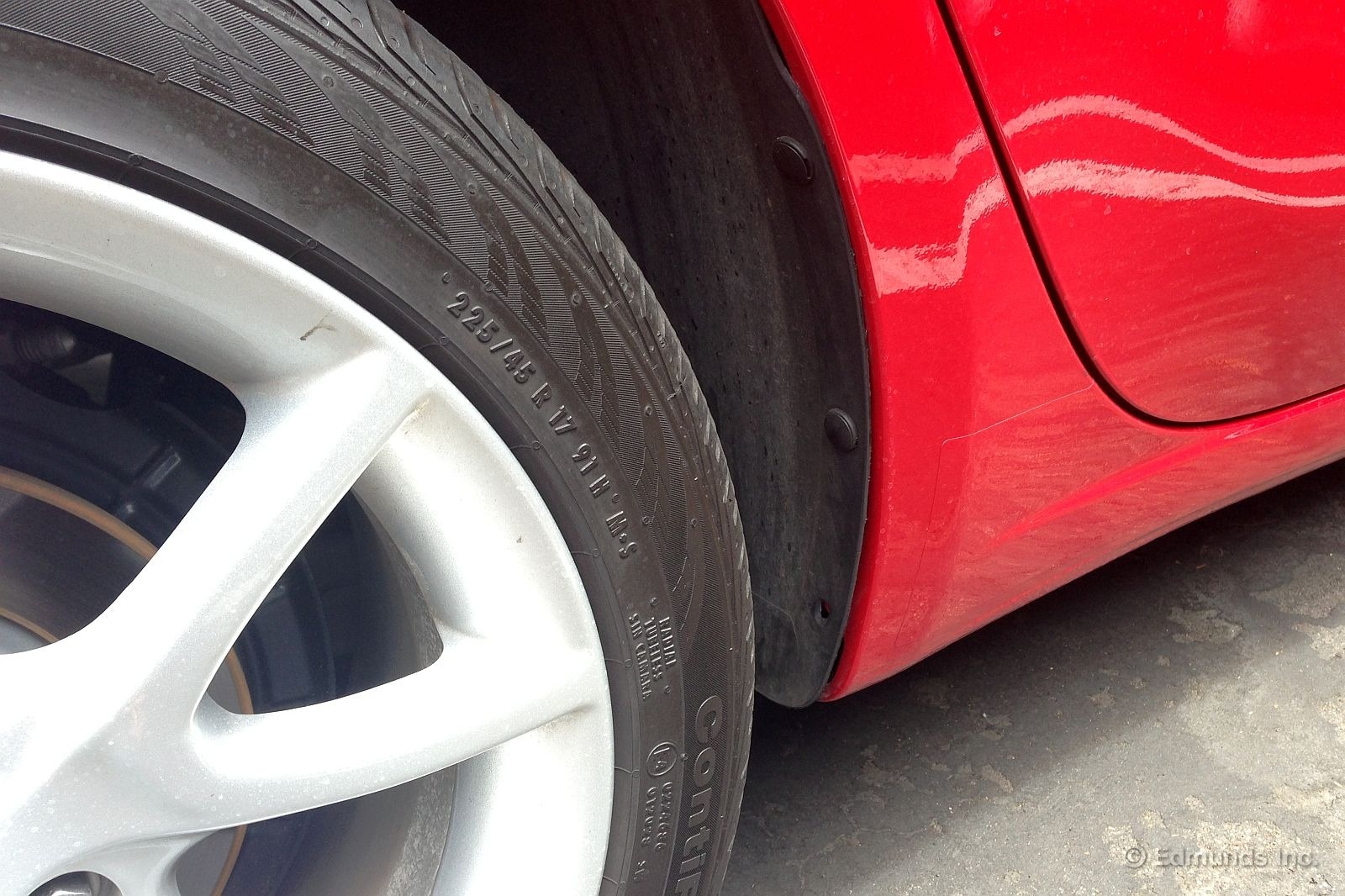
A clip from the 2013 Dodge Dart SXT Rallye's right rear inner fender has popped out.
Since one of the door handles also previously came off in my hand, I'll be honest, I'm starting to have some questions about the build quality of the new Dodge Dart.
But to be fair, I don't know the full story here. Did the clip just pop off randomly on its own, or did something cause it to pop off?
Regardless, we'll either pop a clip in if we find one that fits at the office, or we'll have it addressed at the car's next dealer service.
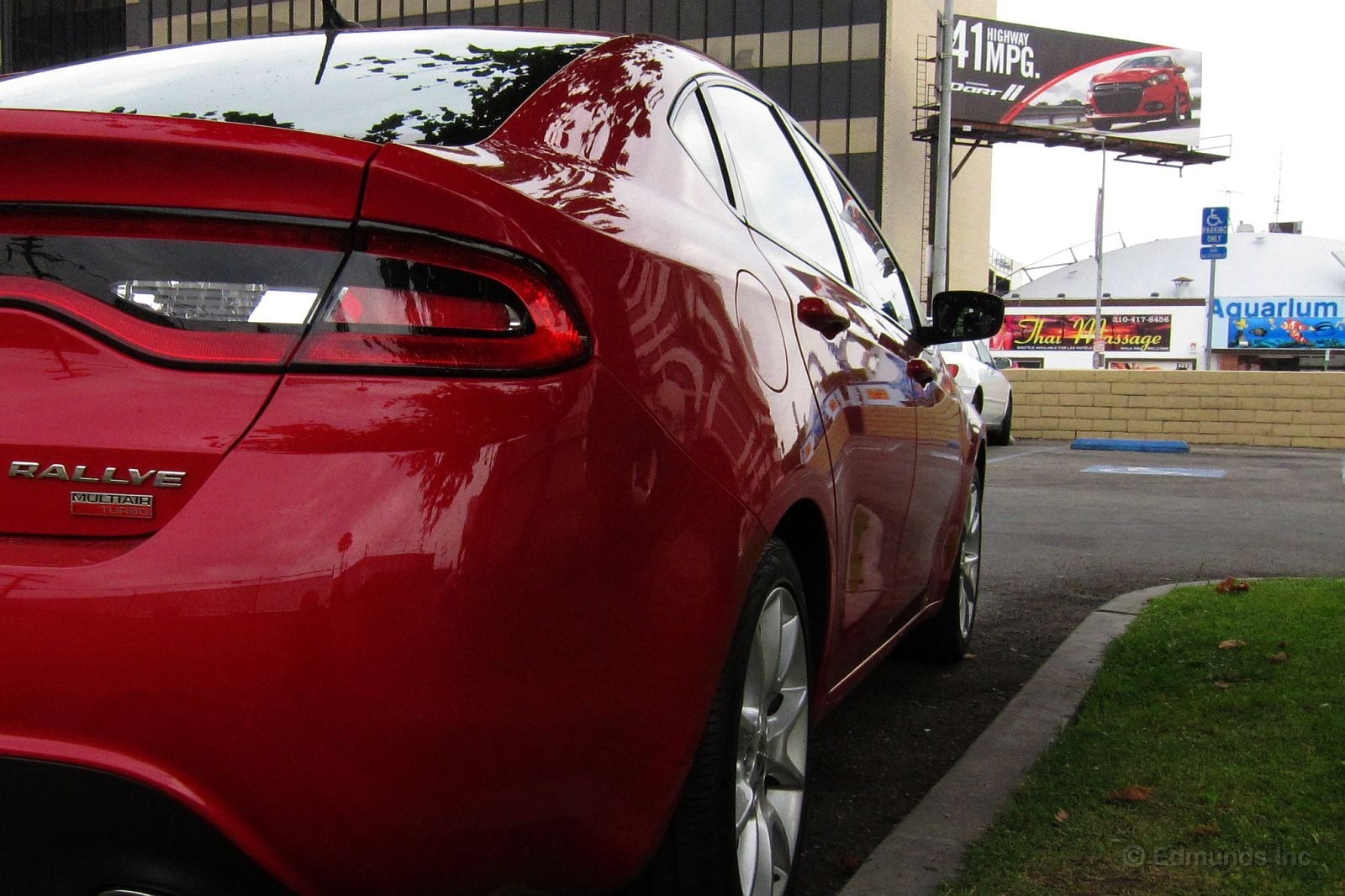
I hate the way fuel economy is marketed and sold, and this 2013 Dodge Dart billboard is Exhibit A. Let's run down what's wrong with it.
The "41 mpg" Dart is really only good for 32 mpg. That's the EPA Combined rating, the one that really applies in day-in-day-out usage. Most car owners have a hard enough time matching EPA Combined. The highway by itself number is fairly useless.
The "41 mpg" Dart is in fact the Dodge Dart Aero, but by not disclosing that little nugget this billboard implies all Darts are good for 41 mpg on the highway.
The "41 mpg" Dart Aero is a $3,300 option package available only on the base SE trim. It's not standard equipment.
The "41 mpg" Dart Aero is not the one pictured on the billboard. They're showing an SXT with the Rallye package that looks exactly like our long-term test car. A real 2013 Dart SE Aero won't have the tough looking blackout headlights, blackout accent paint or fog lights. I just asked Dodge public relations for a stock photograph of a 2013 Dart SE Aero and they didn't have one.
The relentless focus on highway MPG to the exclusion of all else is tiring. And it's extremely misleading, even if the word "highway" does appear here. Such marketing tactics only set the owner up for disappointment and the carmaker for customer complaints down the road. Nobody wins except the car salesmen.
Dodge is far from the only one doing this, however.
EPA Combined is the number that really matters day-in, day-out. It's the one that should be advertised, the one car shoppers should focus on.
A new window sticker layout was made mandatory for the 2013 model year in an attempt to remedy this. Today's sticker elevates EPA Combined from the ultra-fine print to headline status. EPA City and Highway ratings still appear, but they're greatly diminished. Still, because they're listed at all, ad agencies still feel empowered to dwell on the highway mpg number as if it's the only one.
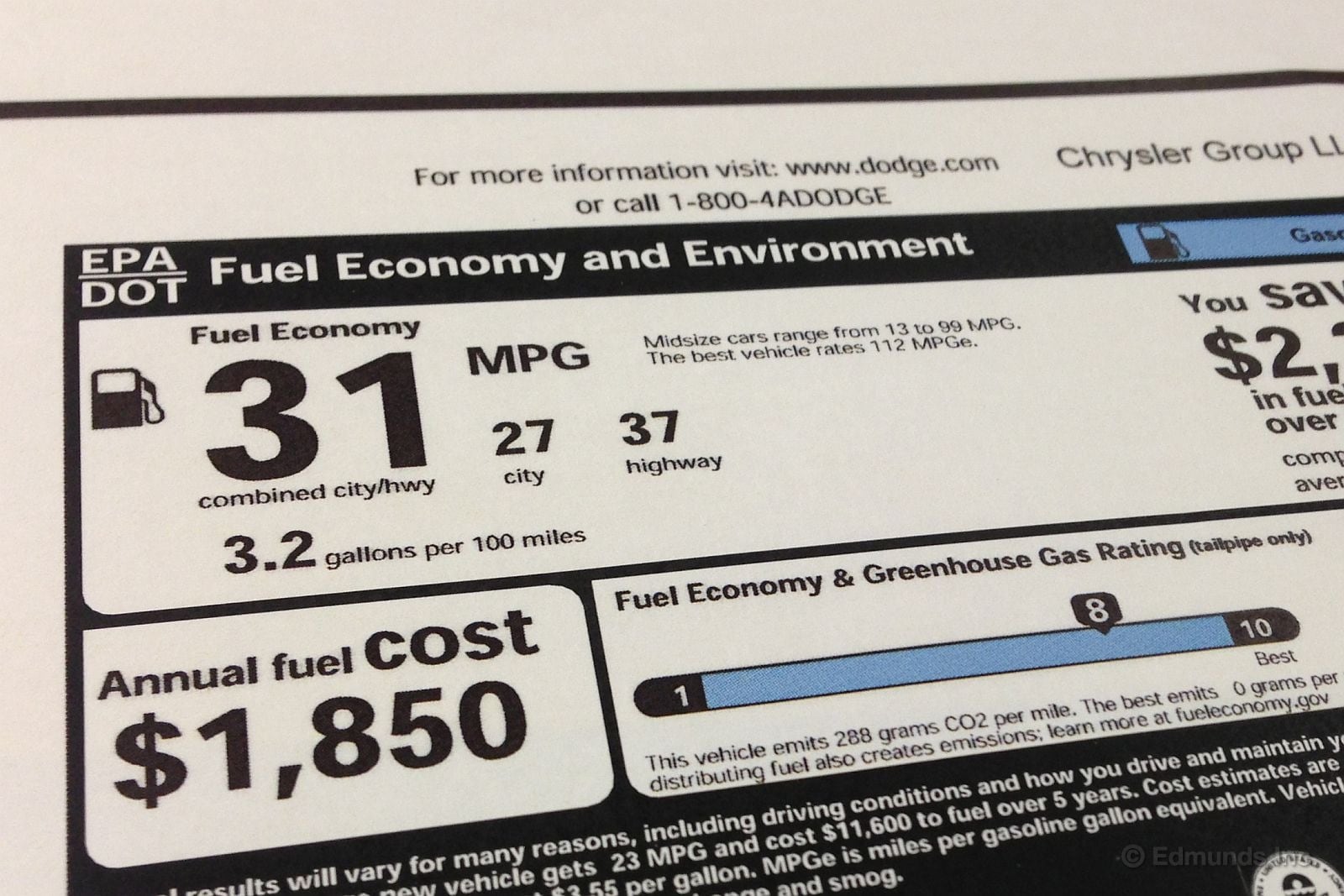
Here are the relevant 2013 Dodge Dart fuel economy ratings:
SE Aero 1.4T, 6-speed manual: 32 Combined (28 city / 41 highway)
SE Aero 1.4T, 6-spd DCT auto: 32 Combined (28 city / 40 highway)
SXT, Ltd. 1.4T, 6-speed manual: 32 Combined (27 city / 39 highway)
SXT, Ltd. 1.4T, 6-spd DCT auto: 31 Combined (27 city / 37 highway)
And the base 2.0-liter engine
SE, SXT, Ltd. 2.0, 6-speed manual: 29 Combined (25 city / 36 highway)
SE, SXT, Ltd. 2.0, 6-spd automatic: 27 Combined (24 city / 34 highway)
That last rating in the first group and the window sticker image correspond to our long-term car. If you follow our monthly fuel economy updates you know we've averaged 27.7 mpg so far, which trails its 31-mpg EPA Combined rating by 11 percent. And its 37-mpg EPA Highway rating has proven to be a pipe dream; the best cross-country tank we've seen is 35.6 mpg.
And yes, ours is the version that looks exactly like the Dart pictured on the "41 mpg" billboard.

We've had our 2013 Dodge Dart about seven months and in that time we've driven it 12,705 miles, which works out to 1,815 miles per month. And that tally includes this past July, a fairly light month in which slightly less than 1,000 new miles were added.
Still, we'll reach our 20,000-mile goal if we can manage 1,450 miles per month through the end of the year. I think we can handle that.
What we can't do is bring our Dart's average fuel economy up to its 31 mpg Combined rating. It currently stands at 27.6 mpg, a tenth less than where we were at the end of last month.
In order to get to 31 mpg overall at the end of 20,000 miles our 2013 Dodge Dart would have to average 38.8 mpg for the next 7,300 miles.
That's not going to happen. Our best single tank to date is only 35.6 mpg.
Worst Fill MPG: 16.8
Best Fill MPG: 35.6
Average Lifetime MPG: 27.6
EPA MPG Rating: 31 Combined (27 City / 37 Highway)
Best Range: 486.7 miles
Current Odometer: 12,705
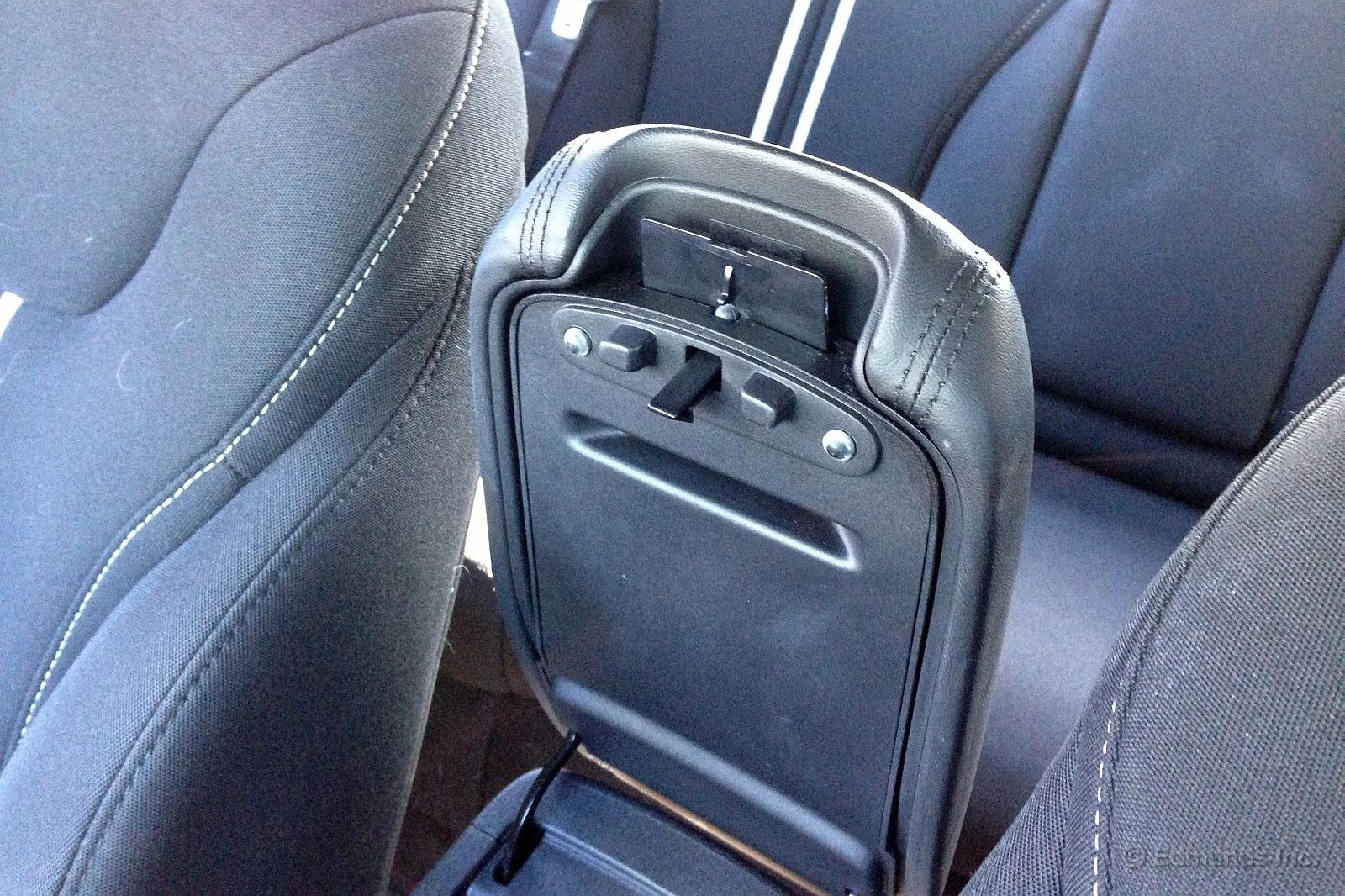
The 2013 Dodge Dart SXT Rallye's center armrest opener latch (or the cover for it, anyway) came off in my hand as I tried to access the center bin.
Apparently, I open things too aggressively for the new Dart. Or maybe it's that I have insanely strong hands.
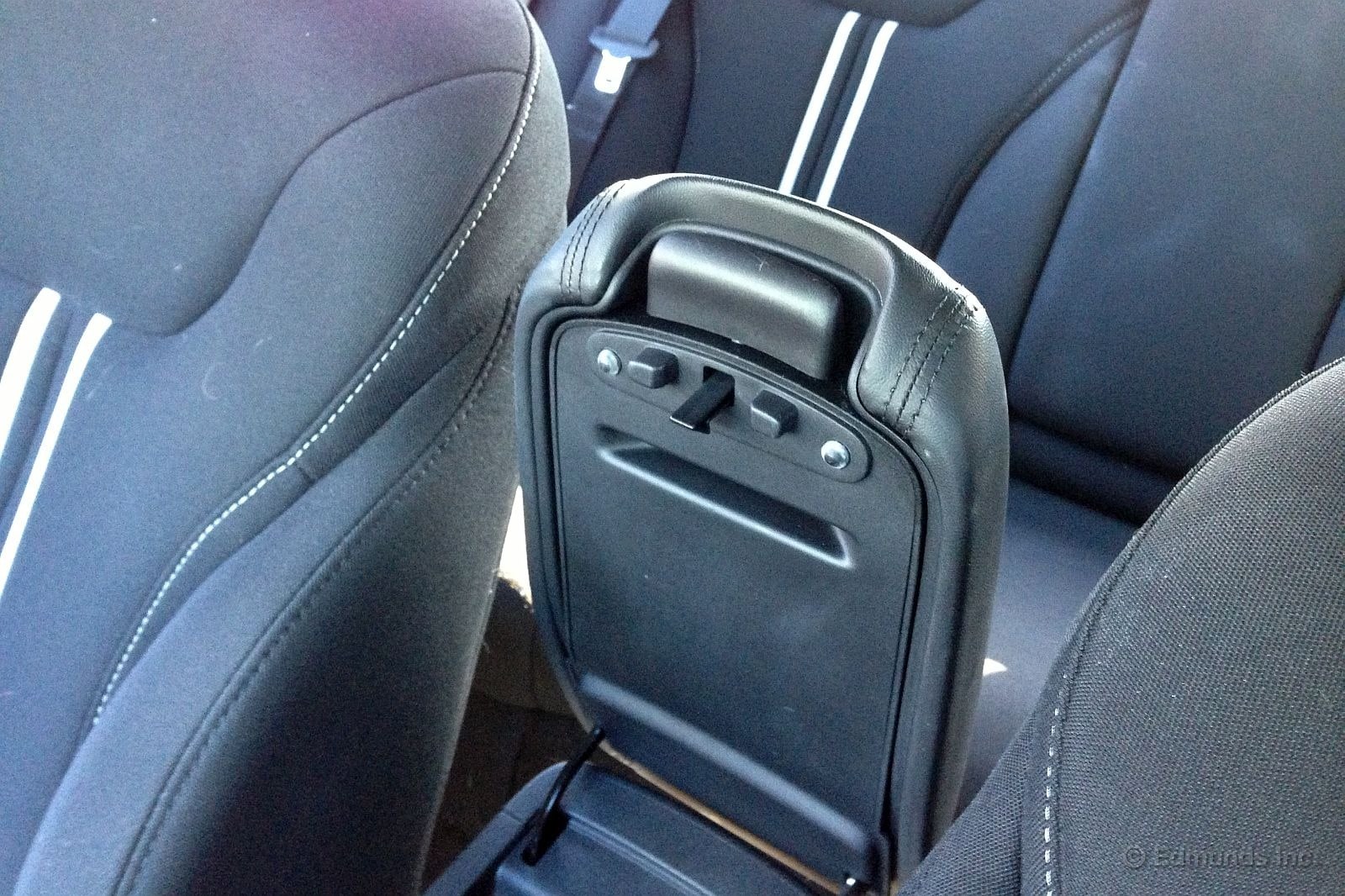
You might remember that several weeks ago part of the outer front passenger door handle broke off on me, though I was able to snap the assembly back together.
Kind of the same story with the center armrest bin. As quickly as the little plastic piece popped off, it also snapped right back on. It does feel a bit looser now, though.
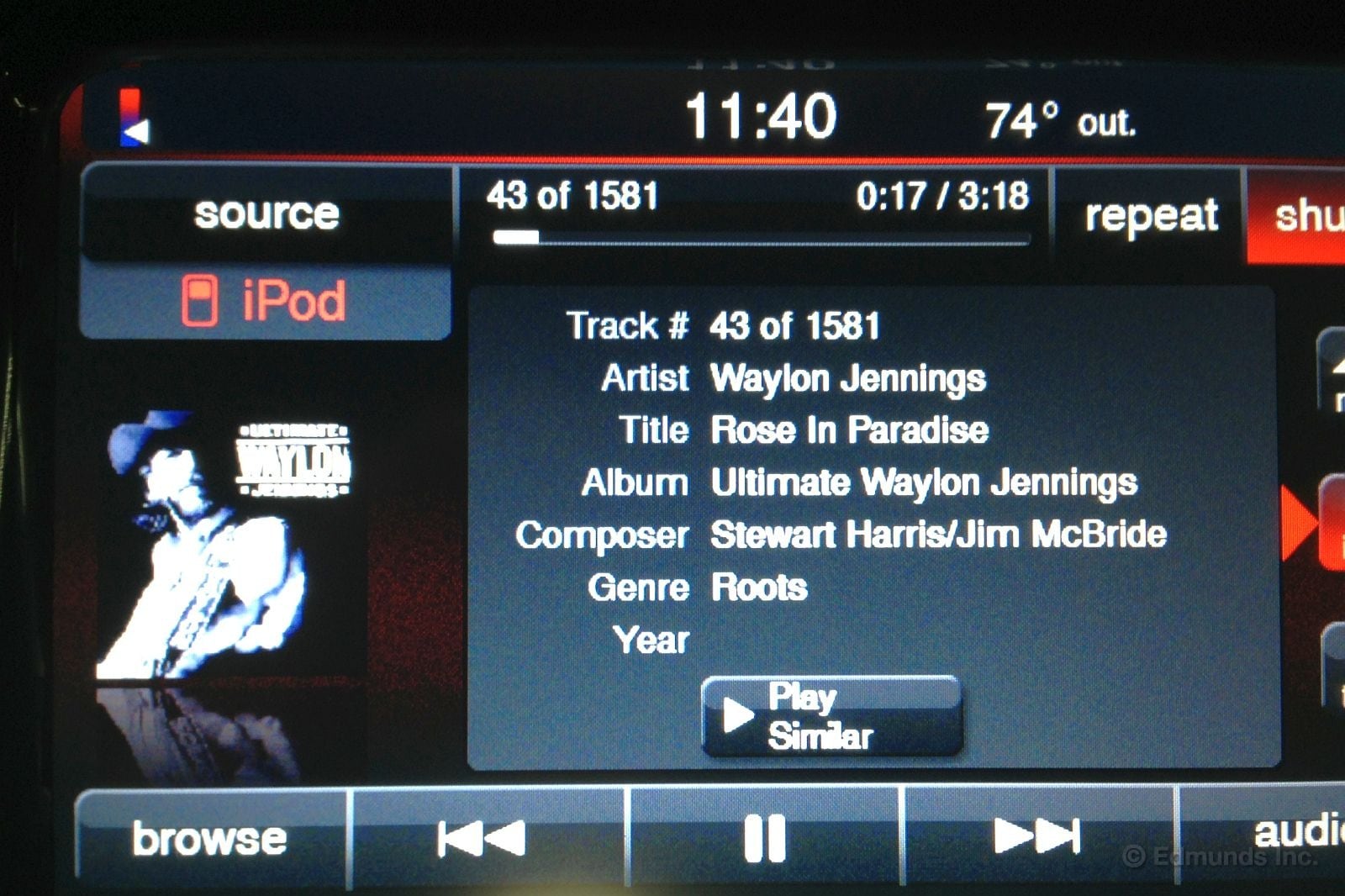
Here's something I hadn't noticed about the 2013 Dodge Dart SXT Rallye before. The audio system lists song composers, at least when I connect my iPhone via the USB port.
Now that's cool.
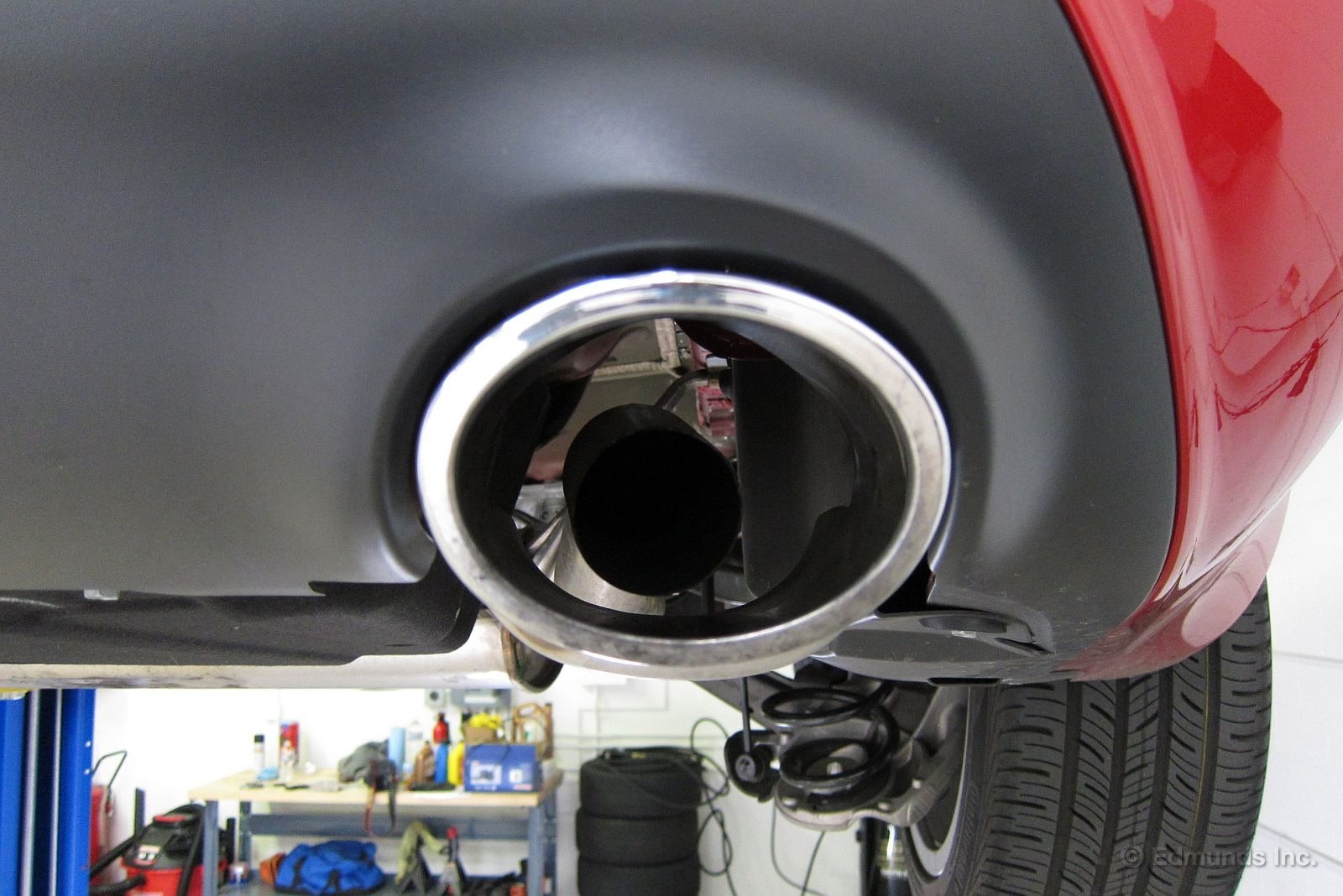
This kind of thing used to bug me. It doesn't anymore.
Very little soot, much lower chance of burns, always-perfect alignment in the bumper and the designers can have fun with the styling.
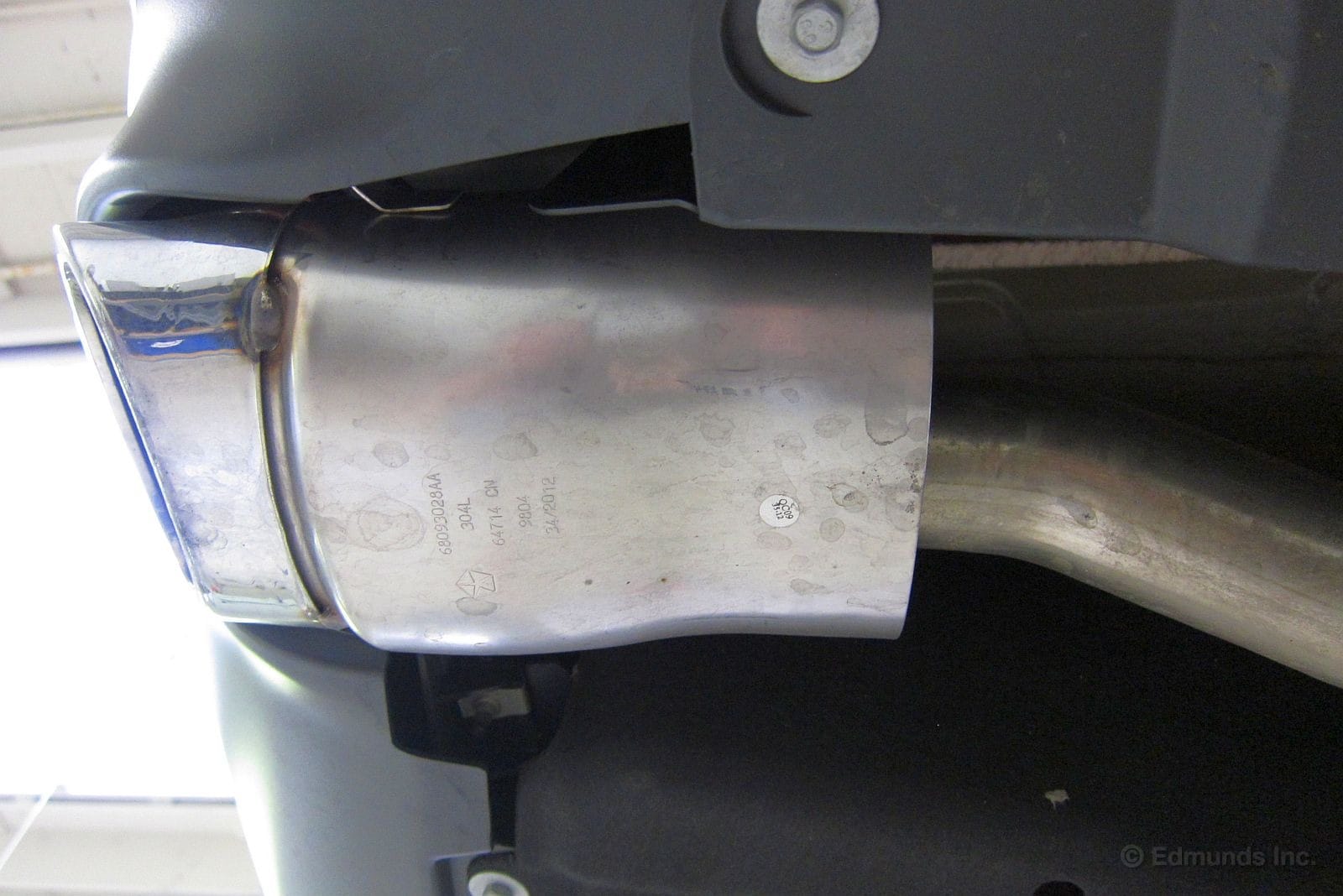
Who cares if it's hooked up directly or not? As long as exhaust comes out, I'm good.
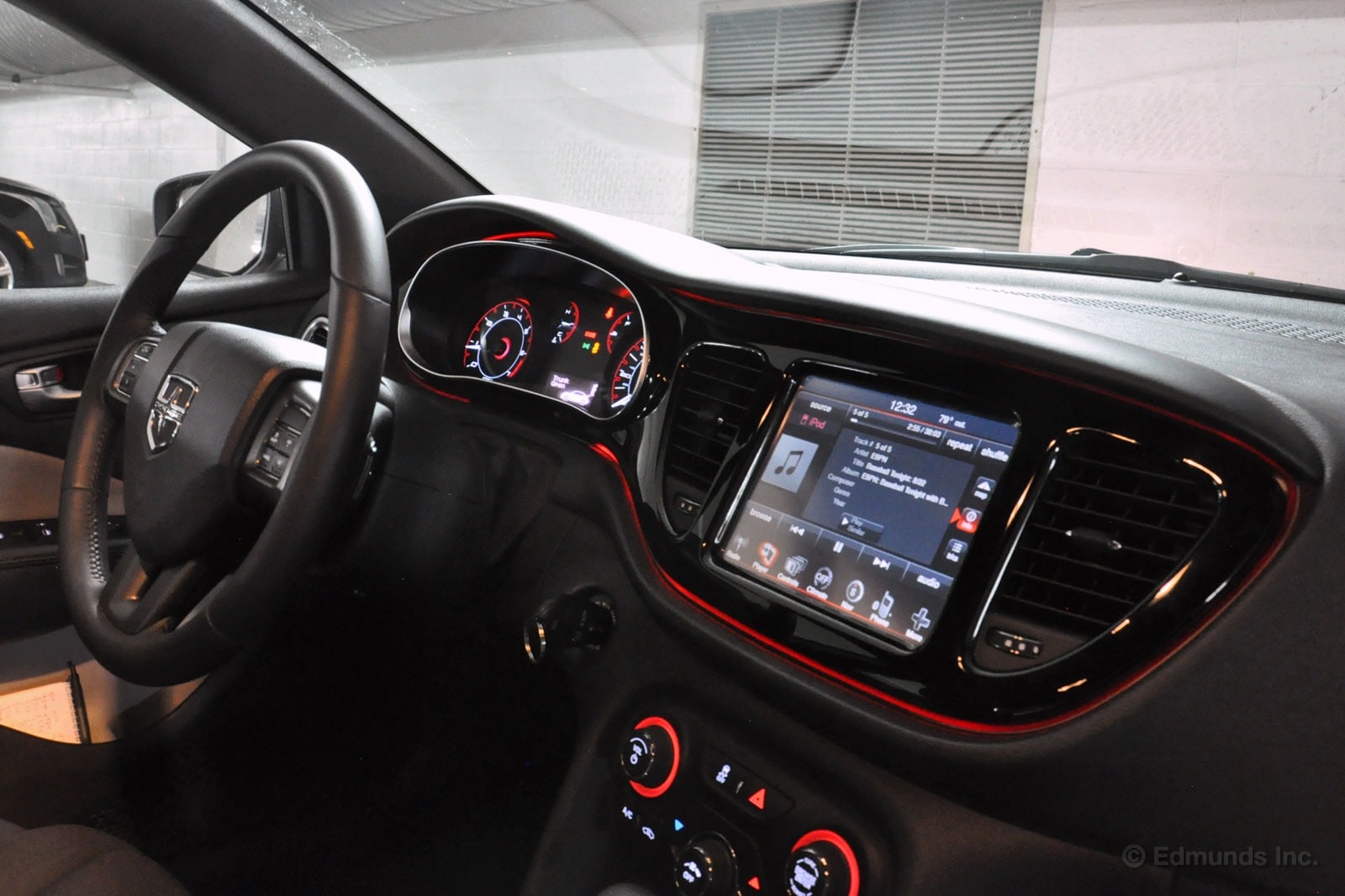
I haven't yet decided how I feel about driving our long-term 2013 Dodge Dart. But on the way home last night, I realized just how much I like our Dart SXT Rallye's interior lighting: a lot.
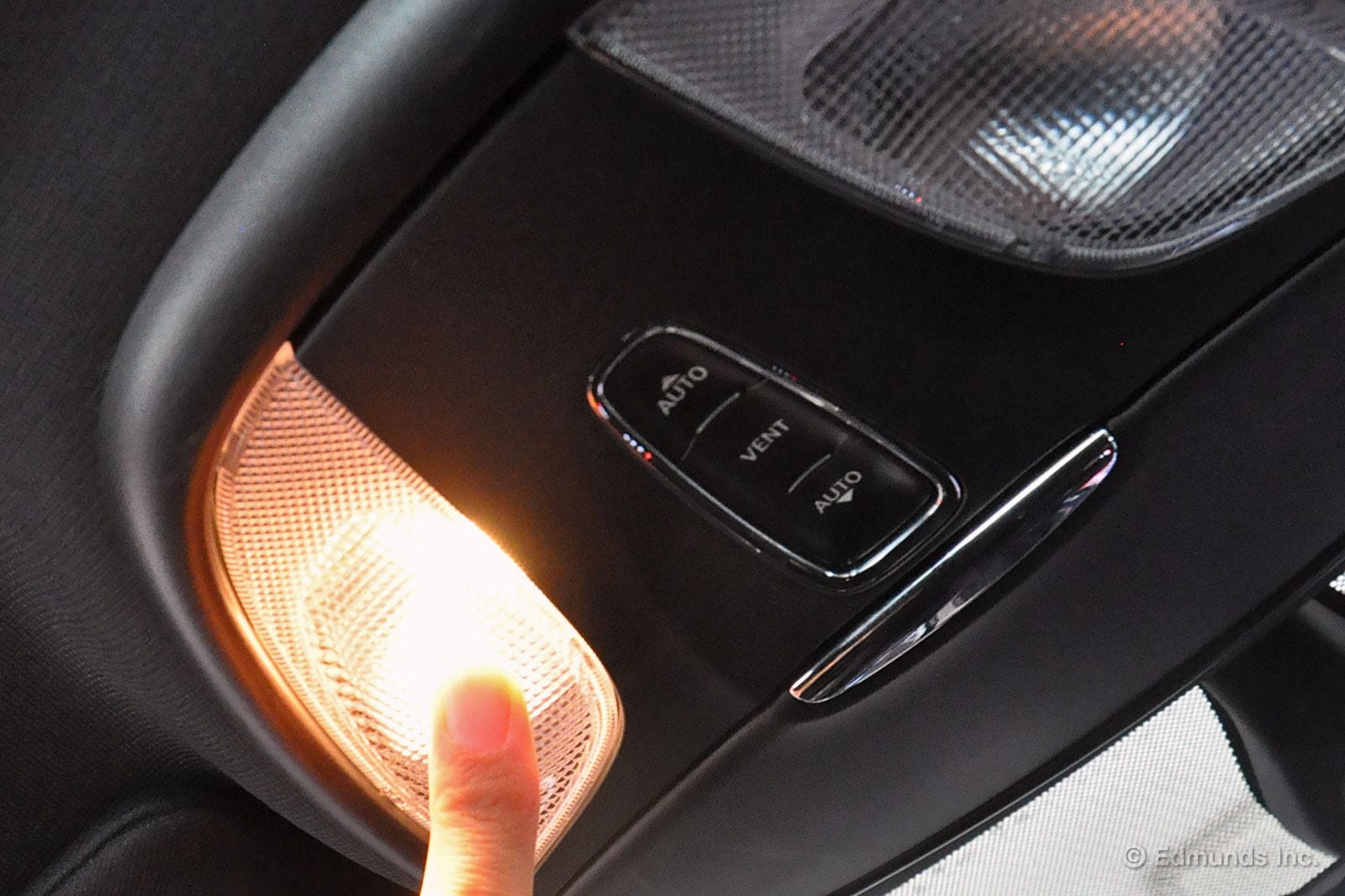
Ambient lighting is now widespread in budget-priced compact sedans, but in many of these cars, it's executed in a haphazard and half-hearted fashion. Not so in our Dodge, where a red ribbon of light encircles the gauge pack and the 8.4-inch touchscreen in the center stack. It visually unifies them into a single shape that I find quite attractive.
Totally unrelated to this is the Dart's map light design. Years ago, one of my mentors and I were riding in a 2000 Dodge Intrepid. He pointed up to the map lights and said, "I always like how Dodge does these. If you can see them, you can turn them on."
Thirteen years later, our Dodge Dart has the same map lights. It's a small touch, but at night, it adds greatly to the car's ease of use. Of course, there are other cars besides the Dart that use these map lights. But I like how Dodge has retained this design through thick and thin.
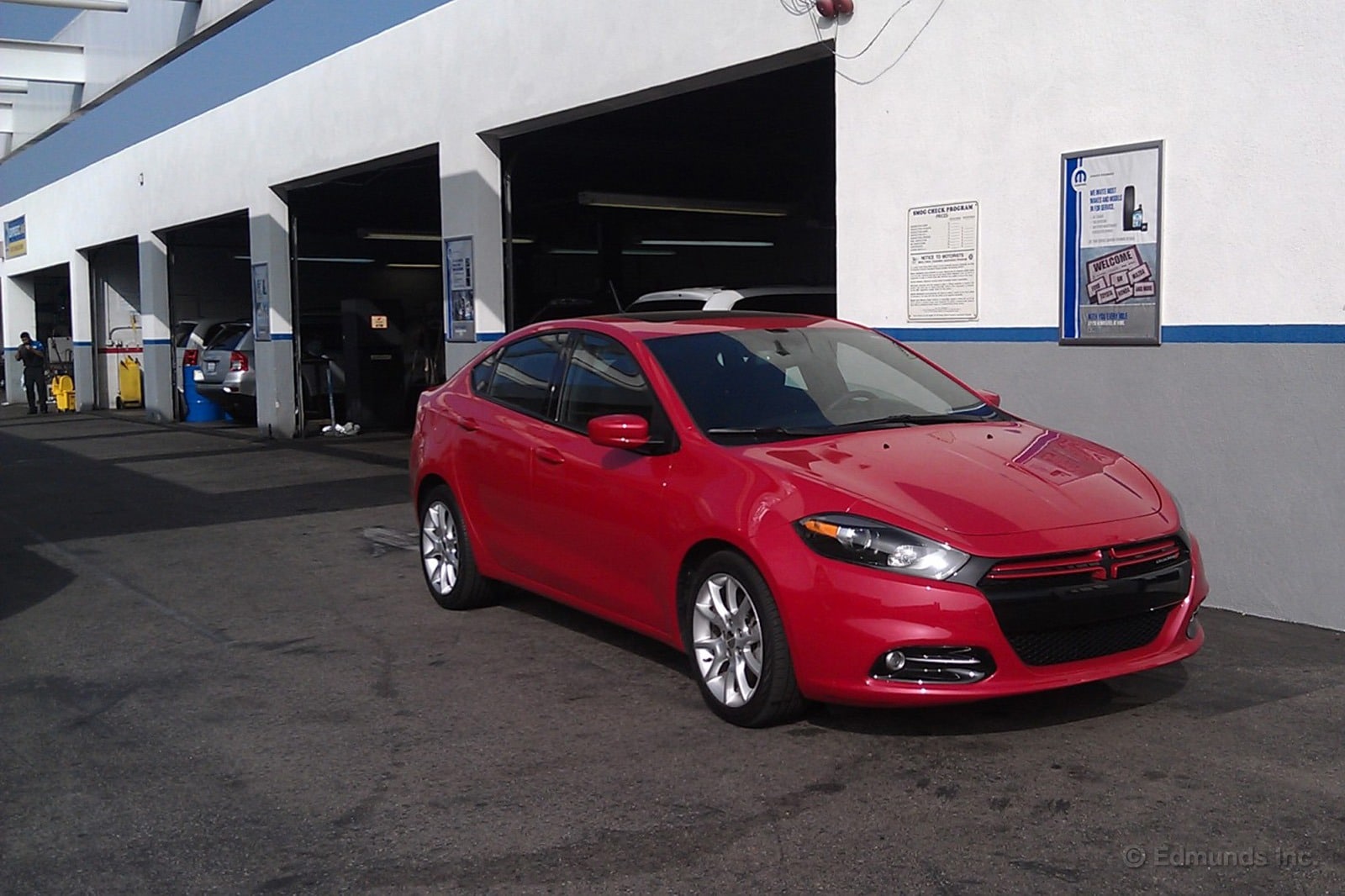
Getting the Dart's broken door handle fixed wasn't exactly a speedy process. On Tuesday, August 6, we brought the car to Buerge Dodge and showed them the problem. They said they'd have to order a new door handle and although we could have taken the car back with us, we opted to leave it with them, hoping it would arrive soon.
The following Friday they called and told us the part wouldn't arrive until Monday and we could retrieve the car and just bring it back then. We declined as everyone was all set for weekend wheels. When Monday came and we didn't hear anything we called them and were eventually told they had ordered the wrong part. Of course we weren't happy with that.
Somehow they managed to get the right part by the next day, Tuesday, August 13, installed it and called us to let us know the Dart was ready.
At least picking up the car was drama free. As expected and previously determined, the repair was covered under warranty and we were in and out of there in about 10 minutes. So once again our small Dodge is a functioning quattroporte.
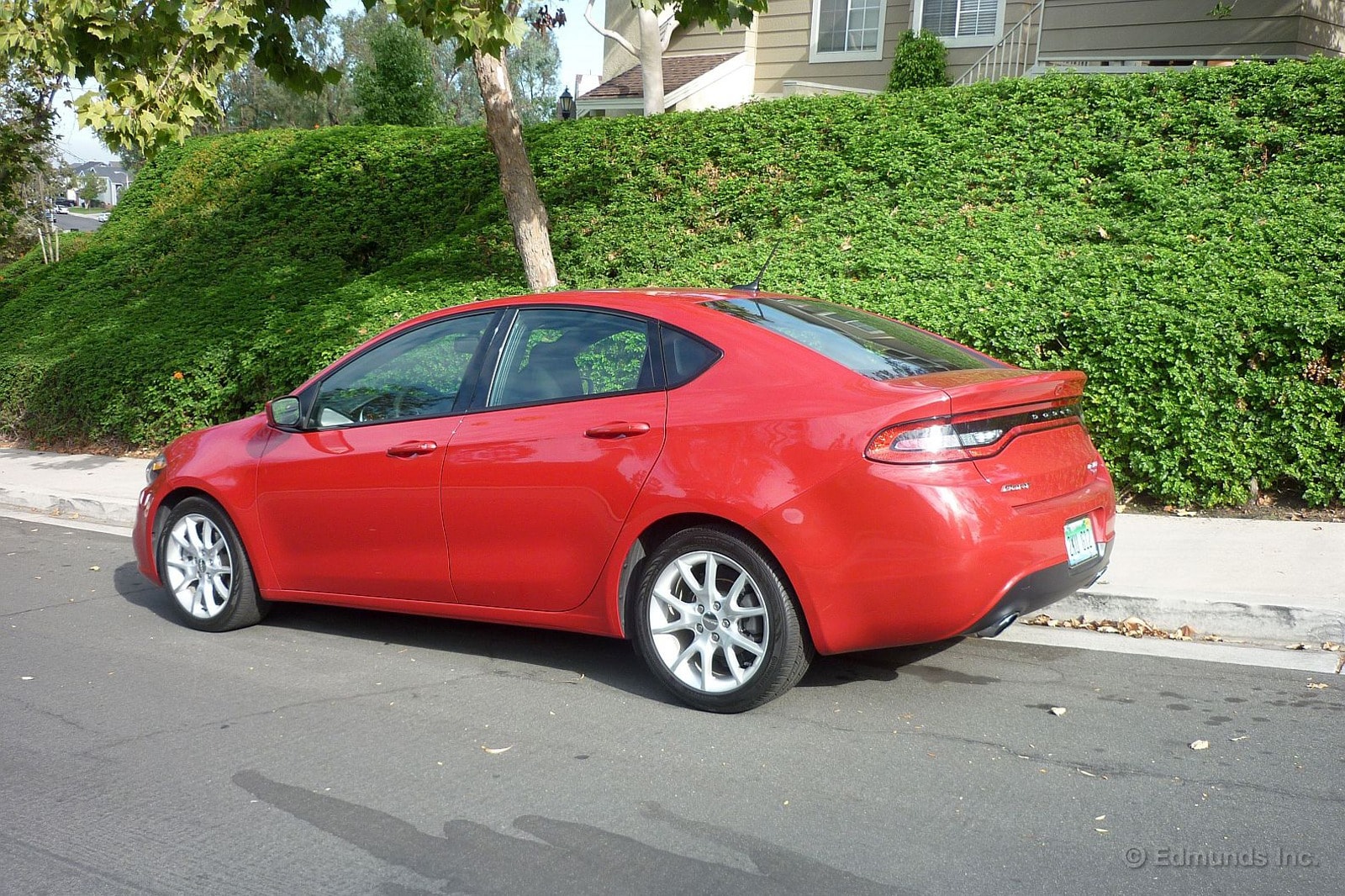
For the month of August we logged just 508 miles on our 2013 Dodge Dart SXT Rallye. Why so few miles? The Dart spent several days out of service with a broken door handle, which has since been repaired.
During the 508 miles we averaged 22.9 mpg on 87-octane fuel.
The Dart's poor fuel economy for the month brought the car's lifetime mpg average down to 27.4 from 27.6. This means we're averaging closer to the EPA's 27-mpg city rating, rather than its 31-mpg combined rating?
Worst Fill MPG: 16.8
Best Fill MPG: 35.6
Average Lifetime MPG: 27.4
EPA MPG Rating: 31 Combined (27 City / 37 Highway)
Best Range: 486.7 miles
Current Odometer: 13,213 miles

I can't fully explain why, but I find the 2013 Dodge Dart SXT Rallye's speedometer tough to read quickly sometimes. And when it comes to staying close to the legal limit, an easy-to-read speedometer is nice to have.
I think the problem is that I get confused as to whether the white or red hash marks are indicating "0" or "5" of the current mph, if I'm just glancing over.
Maybe I don't have enough brain processors. Or, maybe the multiple large hash marks truly do confuse things.
Luckily, the Dart also has an easy-to-read digital speedometer if you scroll through the displays in the middle of the instrument panel. So when I'm in the Dart, I always have it on this screen. It's just easier.
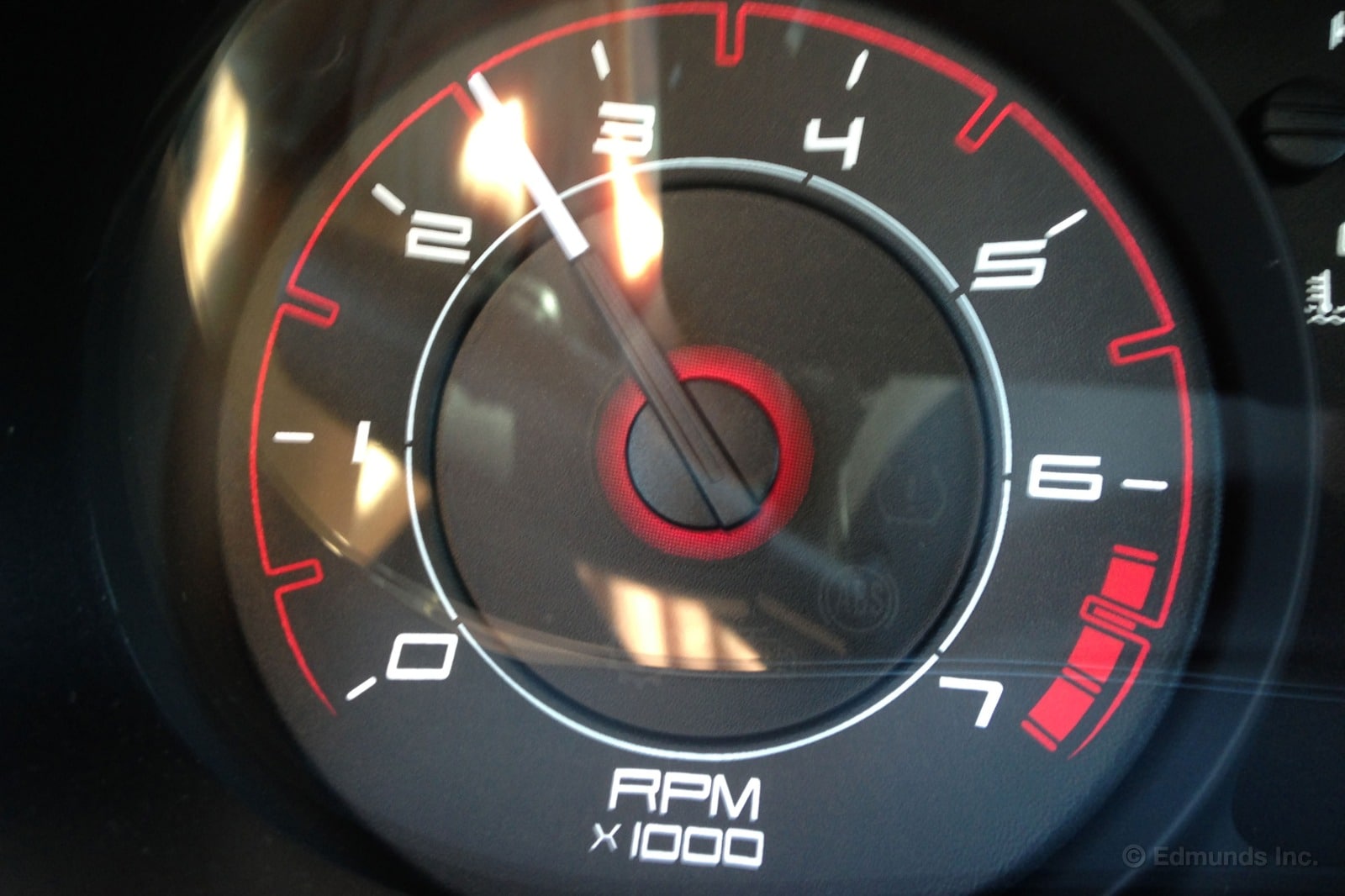
I hadn't driven our 2013 Dodge Dart before this week. And other than a few comments about its transmission, I had no prior impressions. Here's my first observation. At 70 the engine is cranking at about 2,600 rpm in sixth gear, which is enough to be noticeable — disturbing, even — in the cockpit.
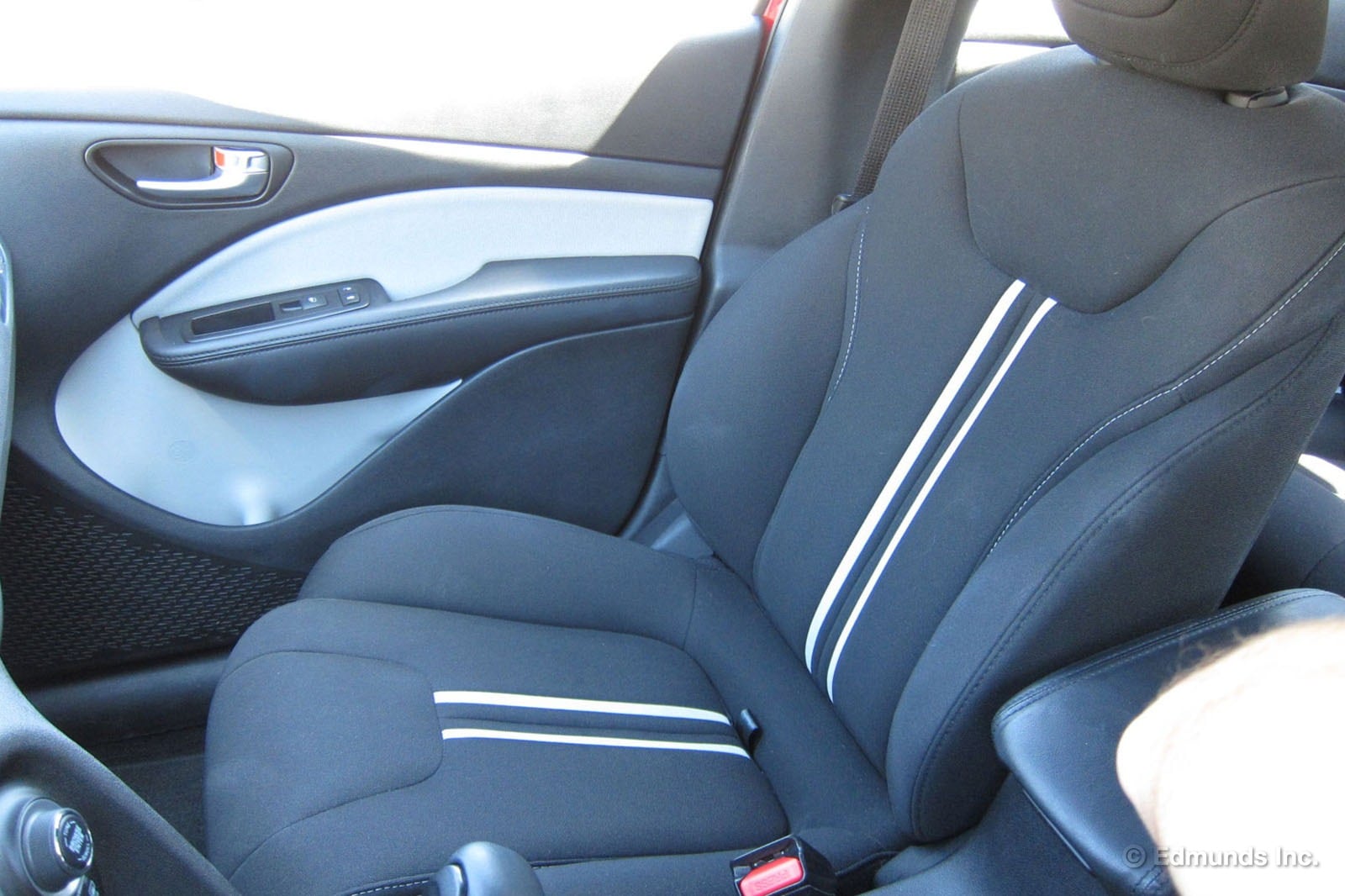
You'll be glad to know that our long-term 2013 Dodge Dart is following in the footsteps of generations of Grand Caravans before it by retaining Cheerio crumbs in its seats. Sure, the minivans probably hoarded them in seat rails, but the Dart keeps them right there in the secret storage bin beneath your passenger's butt.

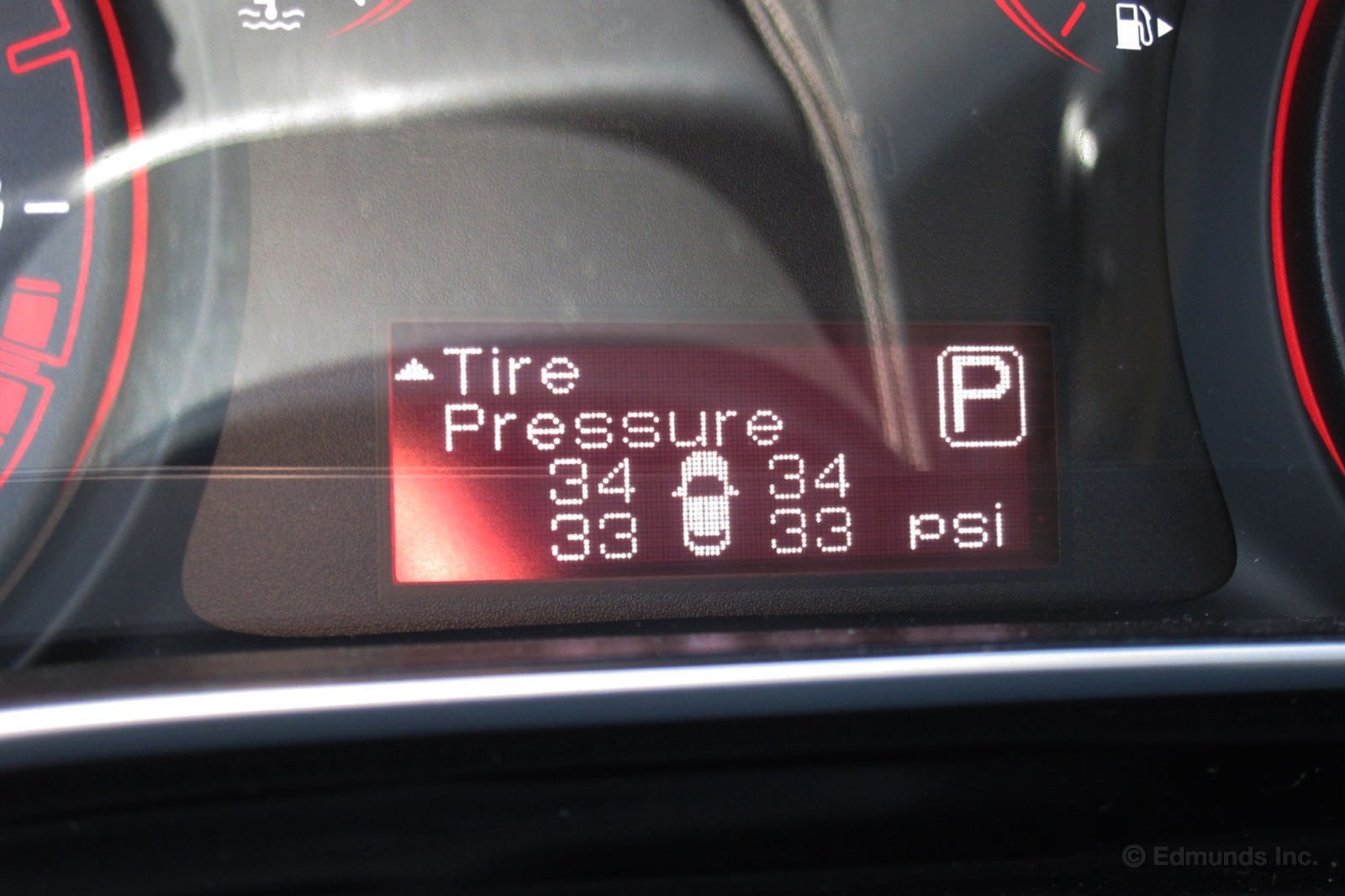
Among the multiple display options (exterior temperature, trip odometer, range, etc.) on the 2013 Dodge Dart's configurable instrument cluster display is tire pressure. It's not a breakthrough, certainly, but it's also not common in the compact segment.
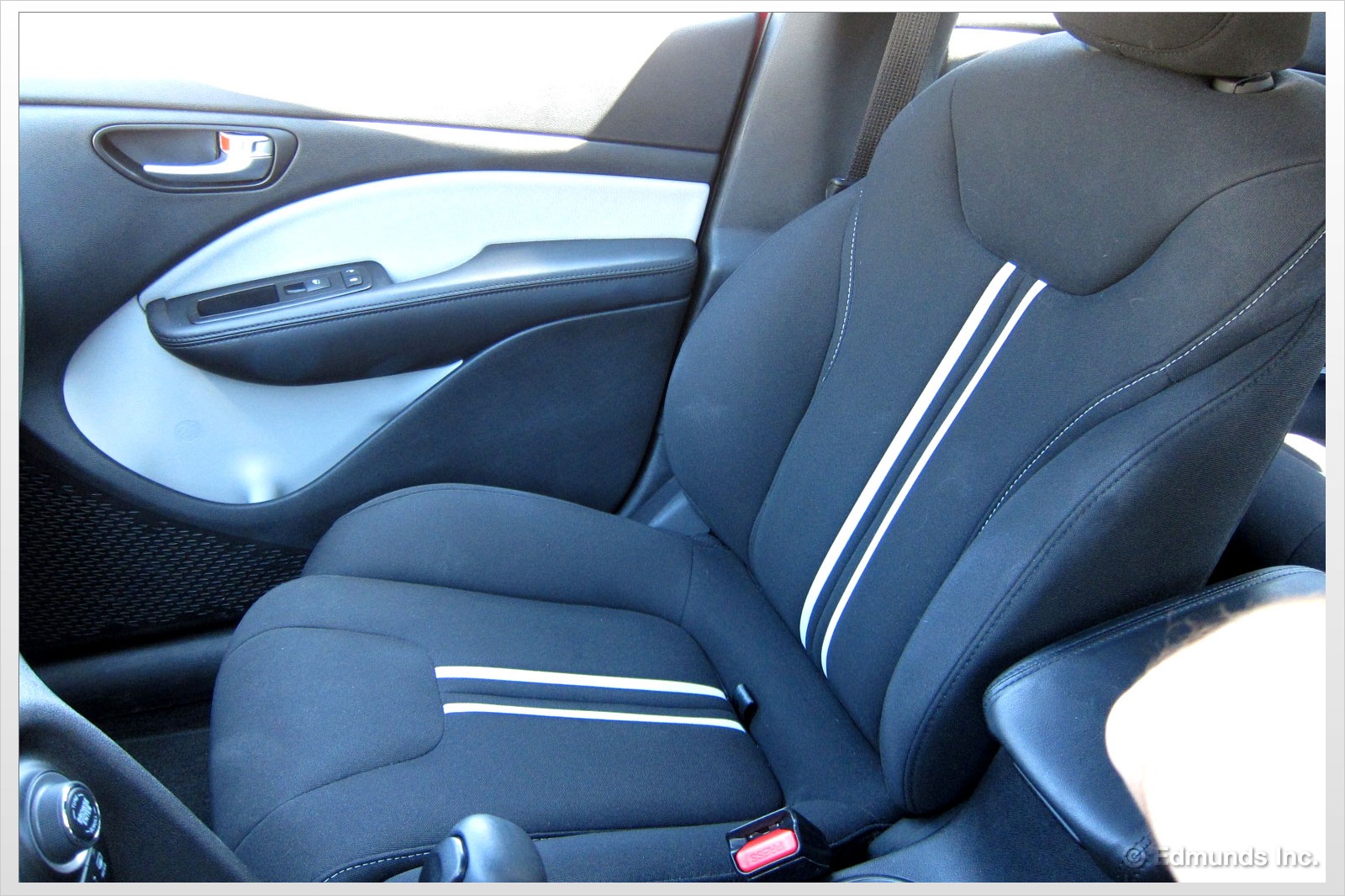
Despite the fact that they've got racing stripes down their center which are both visible and obvious to one's backside, the 2013 Dodge Dart SXT Rallye's seats are pretty good.
Supportive, comfortable and, thanks to cloth covering, good at holding you in place.
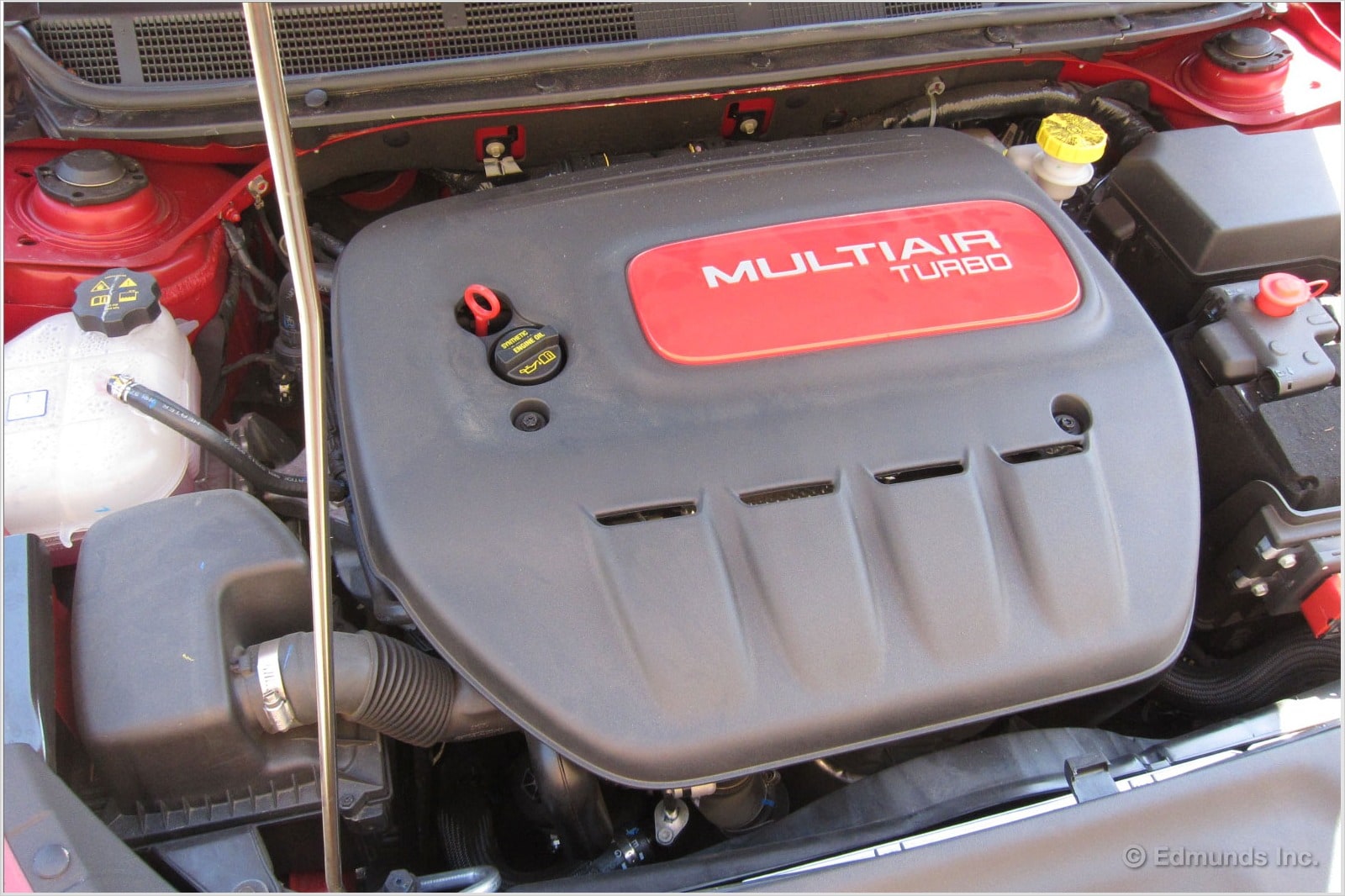
Southern California is in the middle of a heat wave. It's been 95 to 100 degrees here every day for more than a week. It's uncomfortable both for humans and for small boosted engines burdened with the weight of a compact sedan. It's this three-week period every year when we rediscover one of the primary downsides of small turbocharged powerplants.
Of course, the 2013 Dodge Dart is no rocket ship to begin with and, in fairness, it doesn't need to be. It's a compact sedan and speed isn't really a requirement for compact sedans. But the Dart is downright difficult in this weather. Below about 3,000 rpm, where it starts to make meaningful power, it's a slug. The reduction in off-the-line speed in this heat is substantial enough that I found myself second guessing gaps in traffic when pulling out of a driveway from a stop. It's not fun. Many of the Dart's competitors, those with larger displacement normally aspirated engines, don't suffer the same heat-induced reduction in performance.
Its transmission does it no favors, either. A manual transmission paired with this engine would allow better use of the slow-to-build power delivery and therefore better compensation for the weather. As is, however, I guess I'll just watch those gaps.
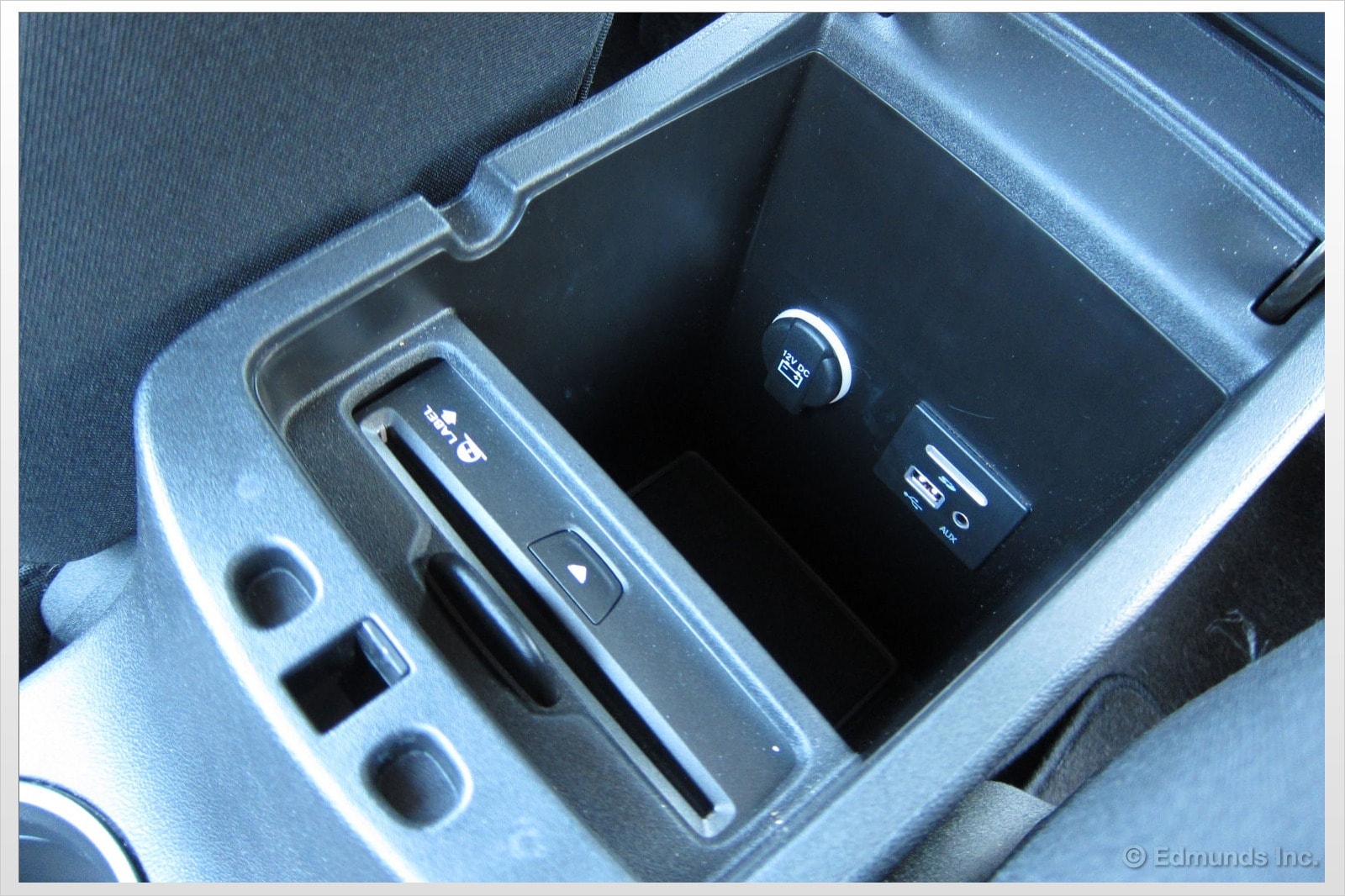
It's possible the Dart's strongest interior trait is its many small-items storage bins. Here's a tour starting with the center console (above).
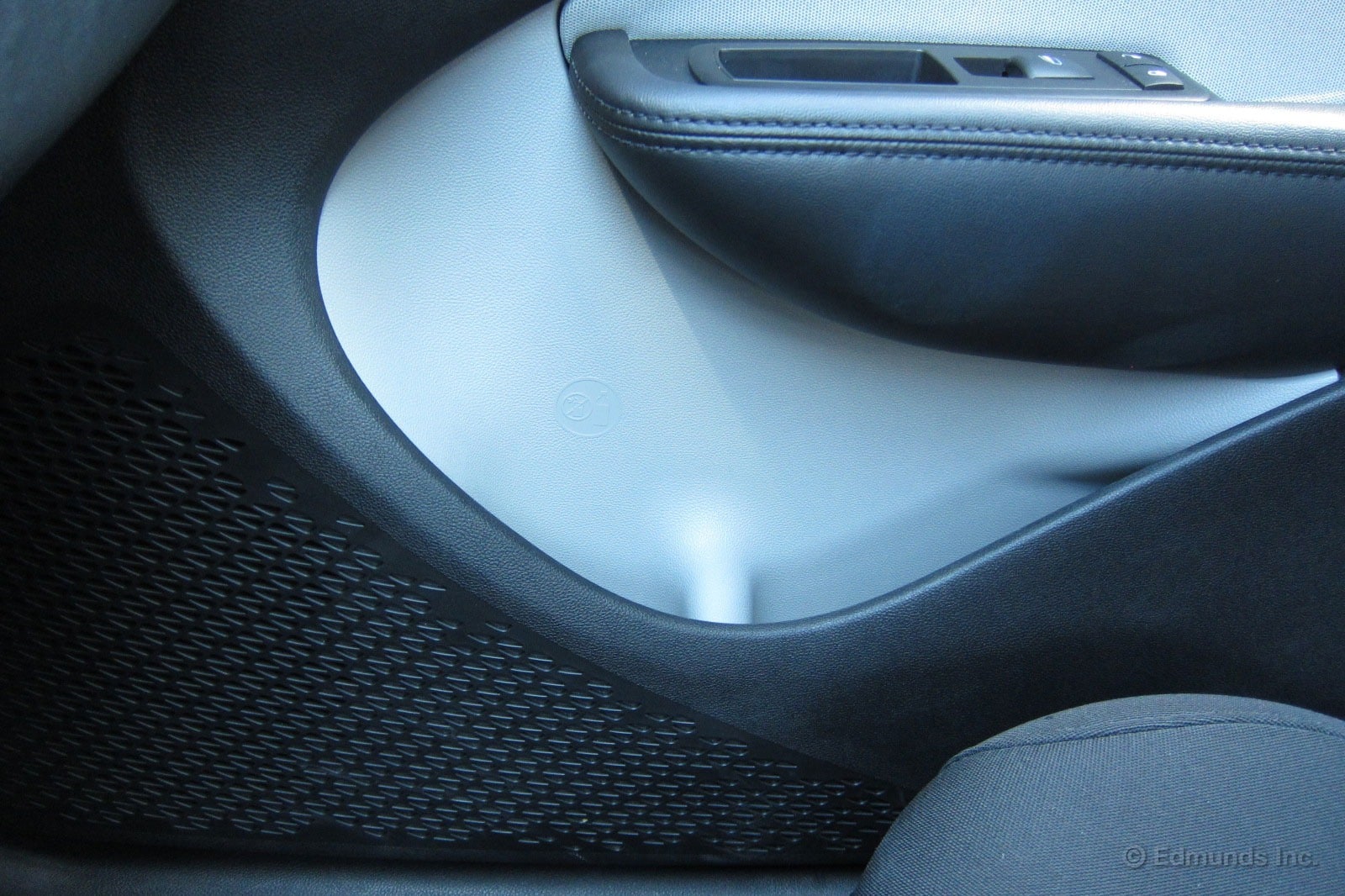
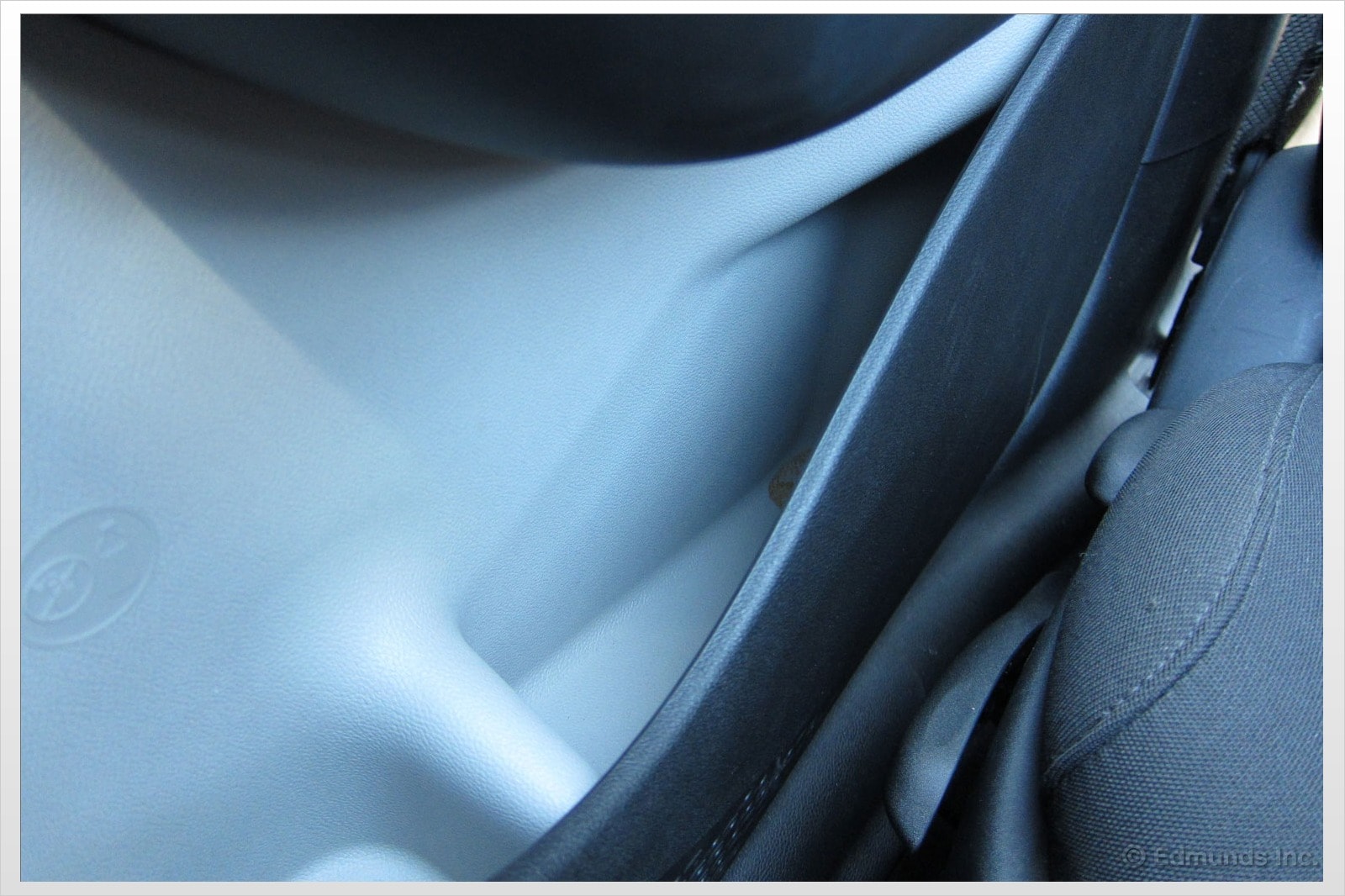
The door pockets are big enough to hold common-size drinks, but also have a surplus of space deep in the door behind the drink storage.
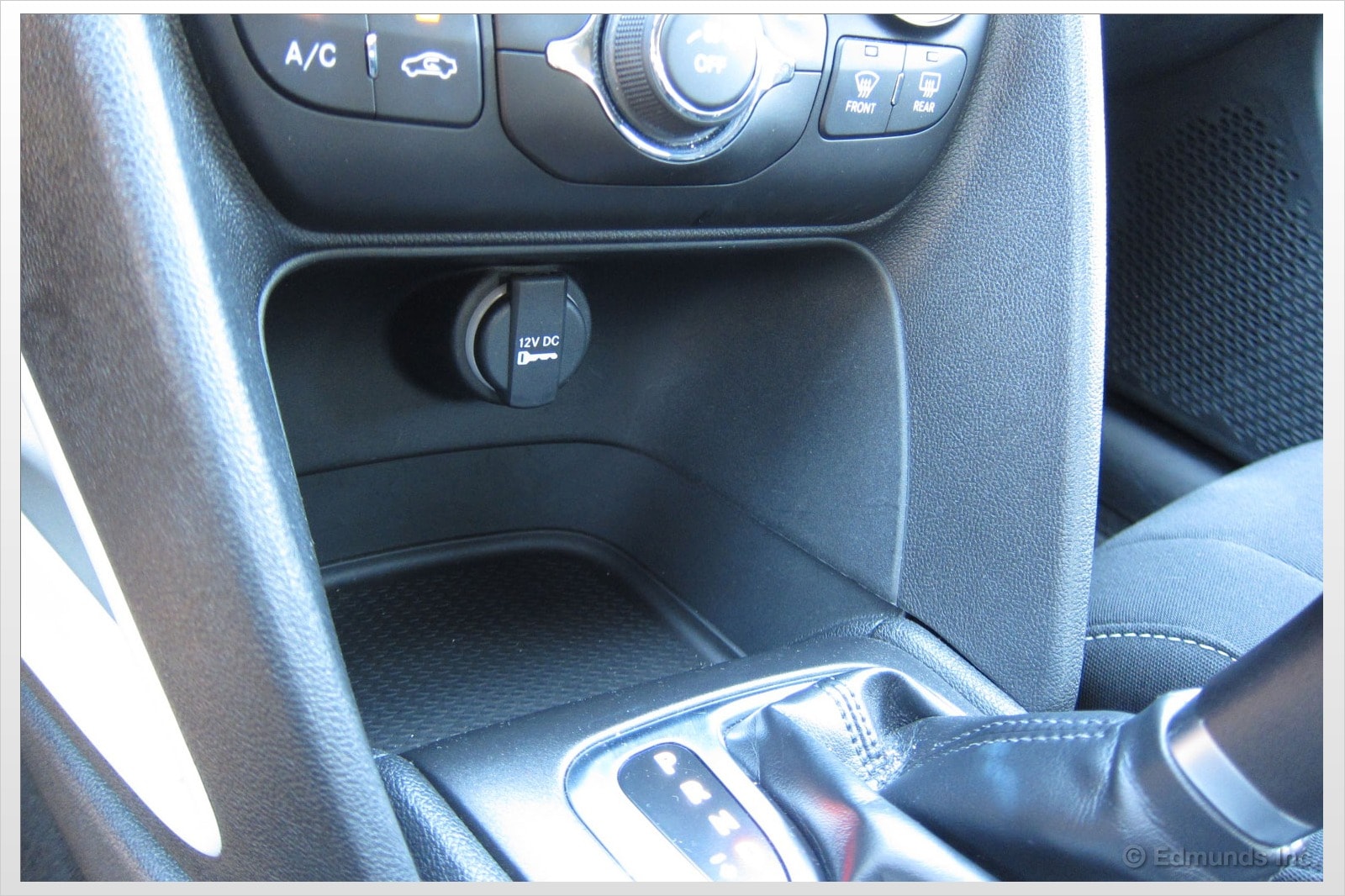
The bin beneath the center stack is large enough for a phone and other small items.
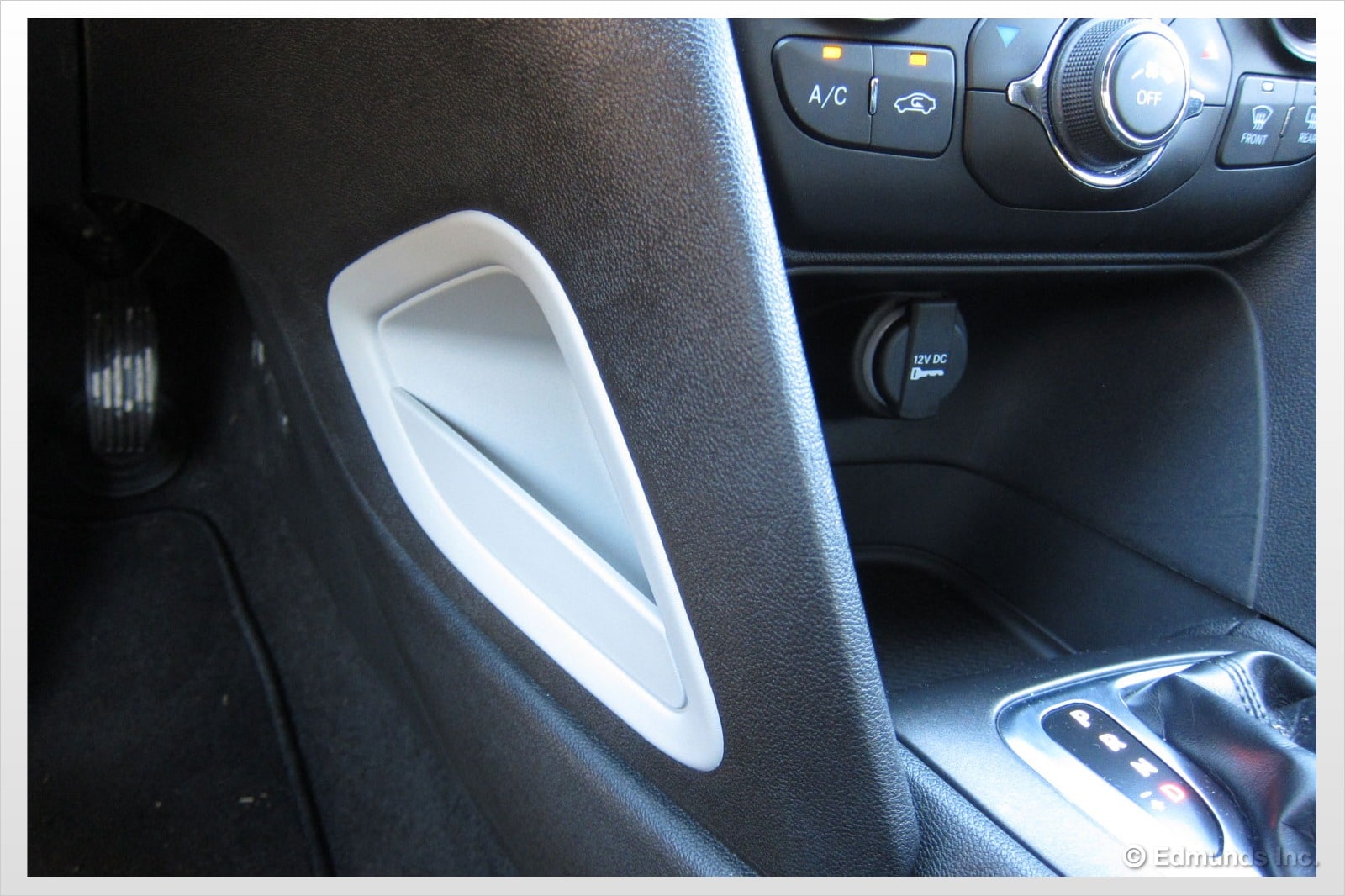
Both sides of the center stack have a bin for change or something similarly sized.
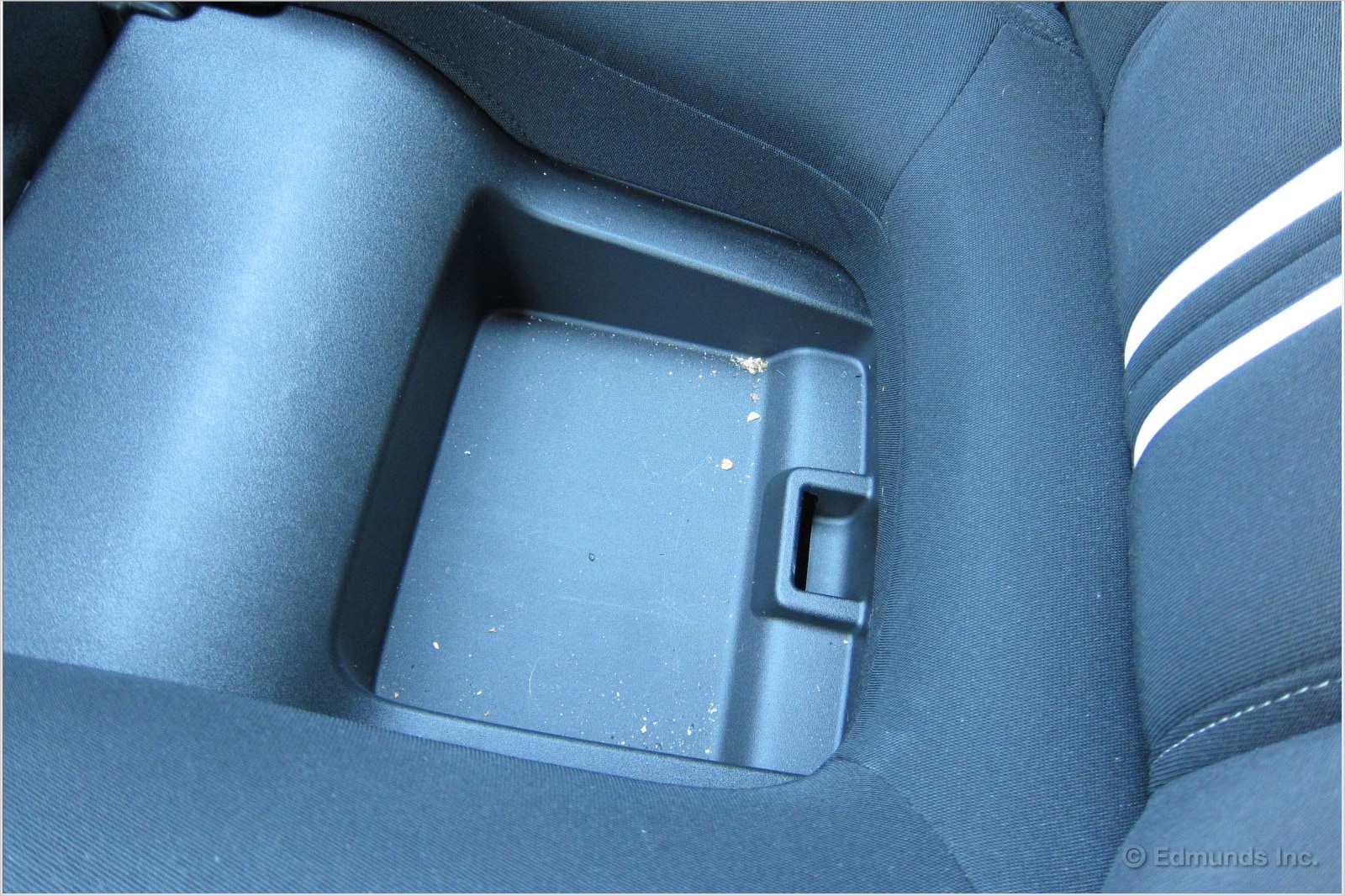
And let's not forget the hidden storage beneath the passenger seat. Weird, but good.
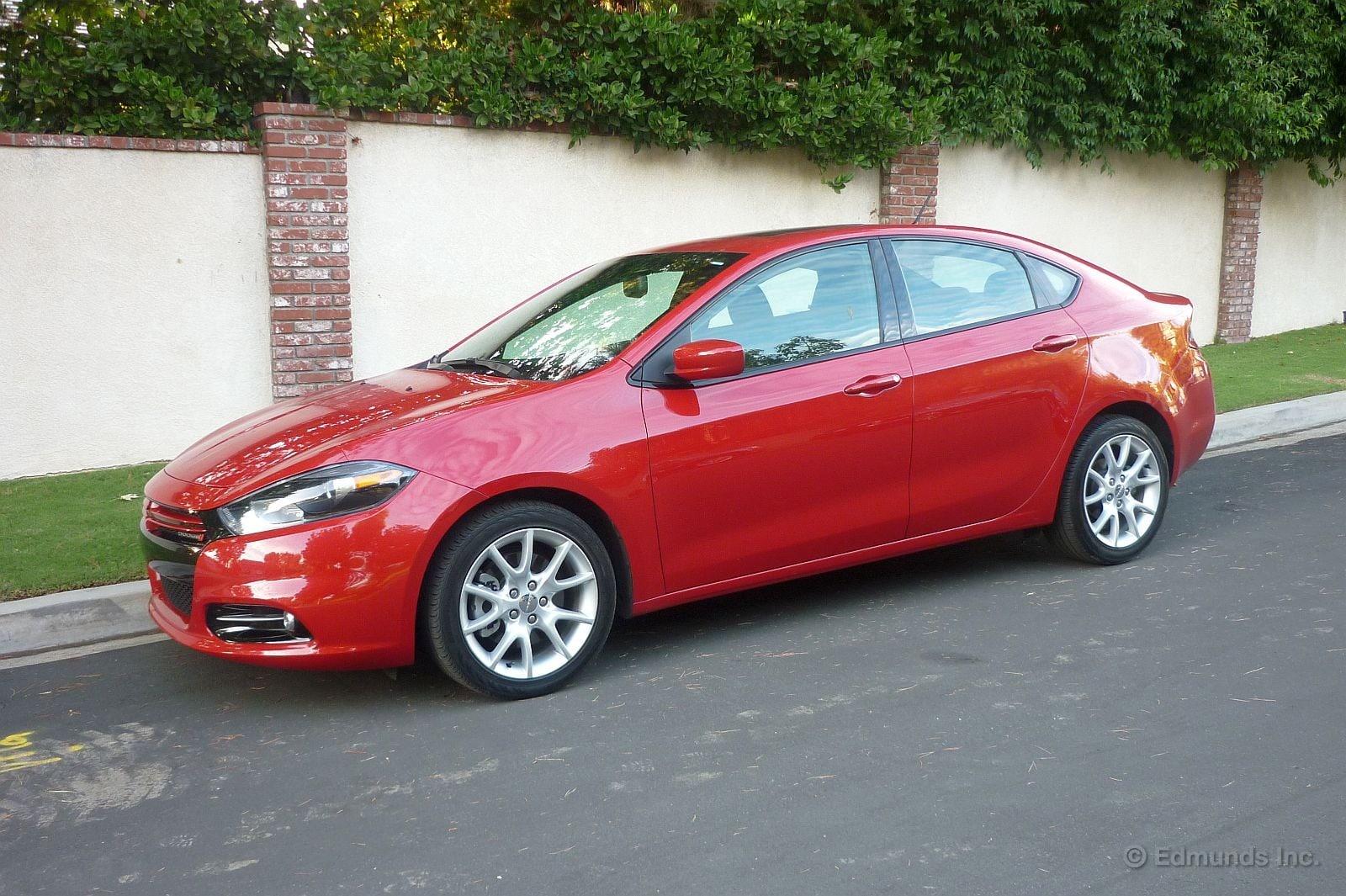
Our long-term 2013 Dodge Dart SXT Rallye and I have a history. A history of me breaking things on it, that is. First it was the outer door handle coming off in my hand, then the center armrest bin latch fell off.
But I'm trying to put those behind me because, I like driving this thing.
And no, it's not just the rumbly exhaust, although it does make me grin whenever I fire the Dart up.
But the seats fit me well, they're covered with grippy cloth and the interior doesn't feel confining.
The turbo power, although a little laggy, has good punch when it hits. I like a car with some personality.
And the handling is decent enough to make the occasional corner fun while the ride is perfectly comfortable for just motoring on down the highway.
What this Dart desperately needs, at least from my perspective, is to make it through the final 6,000 miles or so of our long-term test without any more parts falling off. Oh, and I would've preferred a manual transmission. But it's too late to change that now.
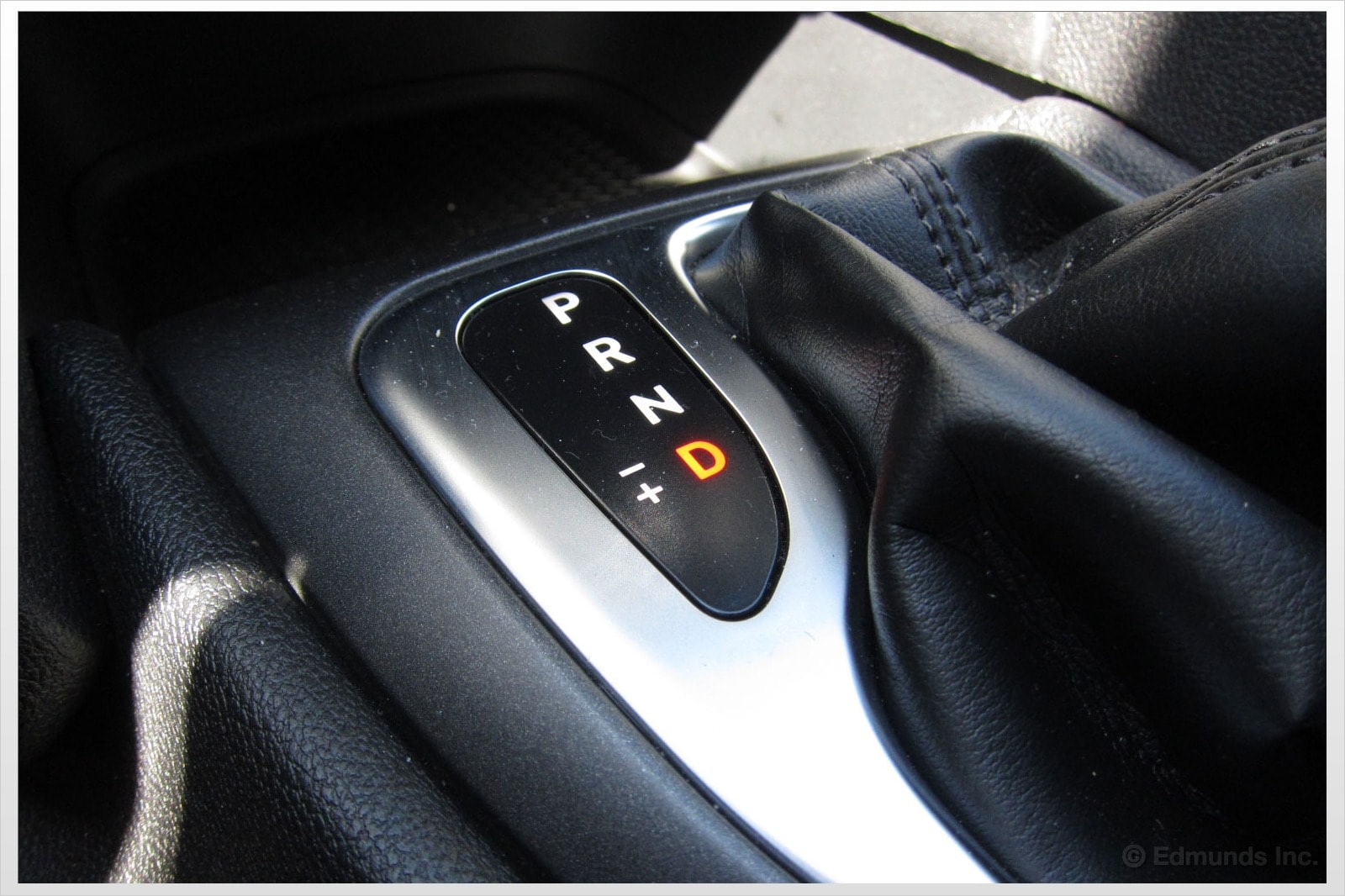
Push forward to downshift, pull back to upshift. Did Dodge get it right?
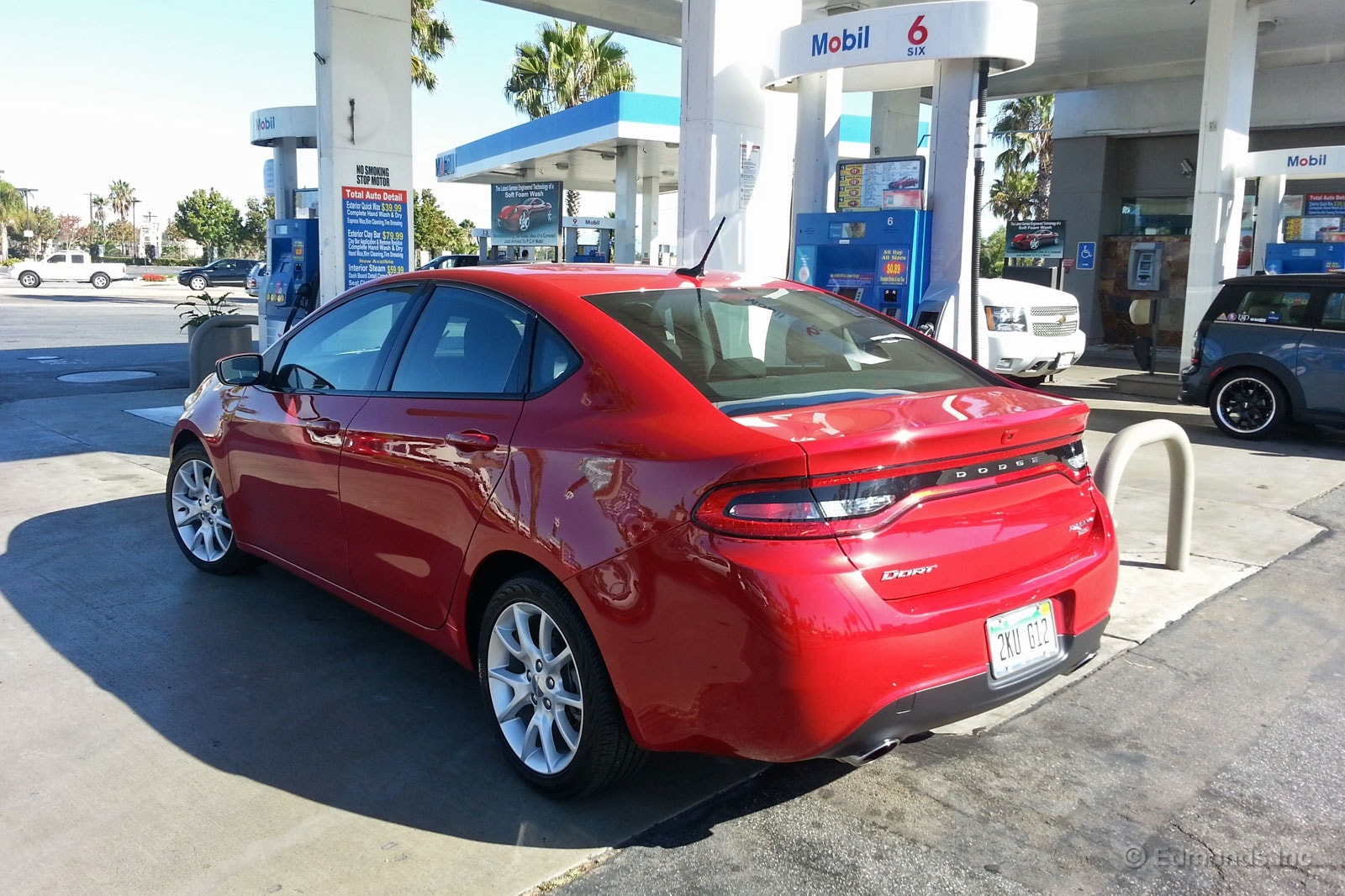
This morning's fuel stop to fill the 2013 Dodge Dart SXT Rallye year-long tester cost me a significant $55.33. I pumped 13.8 gallons, or 376 miles worth of fuel.
Even though our car carries the turbocharged 1.4-liter MultiAir engine which earns a respectable EPA rating of 31 mpg combined, I'm still always surprised when I do the full math.
Fifteen cents per mile may not sound like much, but after a busy weekend of necessary (and totally gratuitous) errands, I start to rethink how much running around I really needed to do.
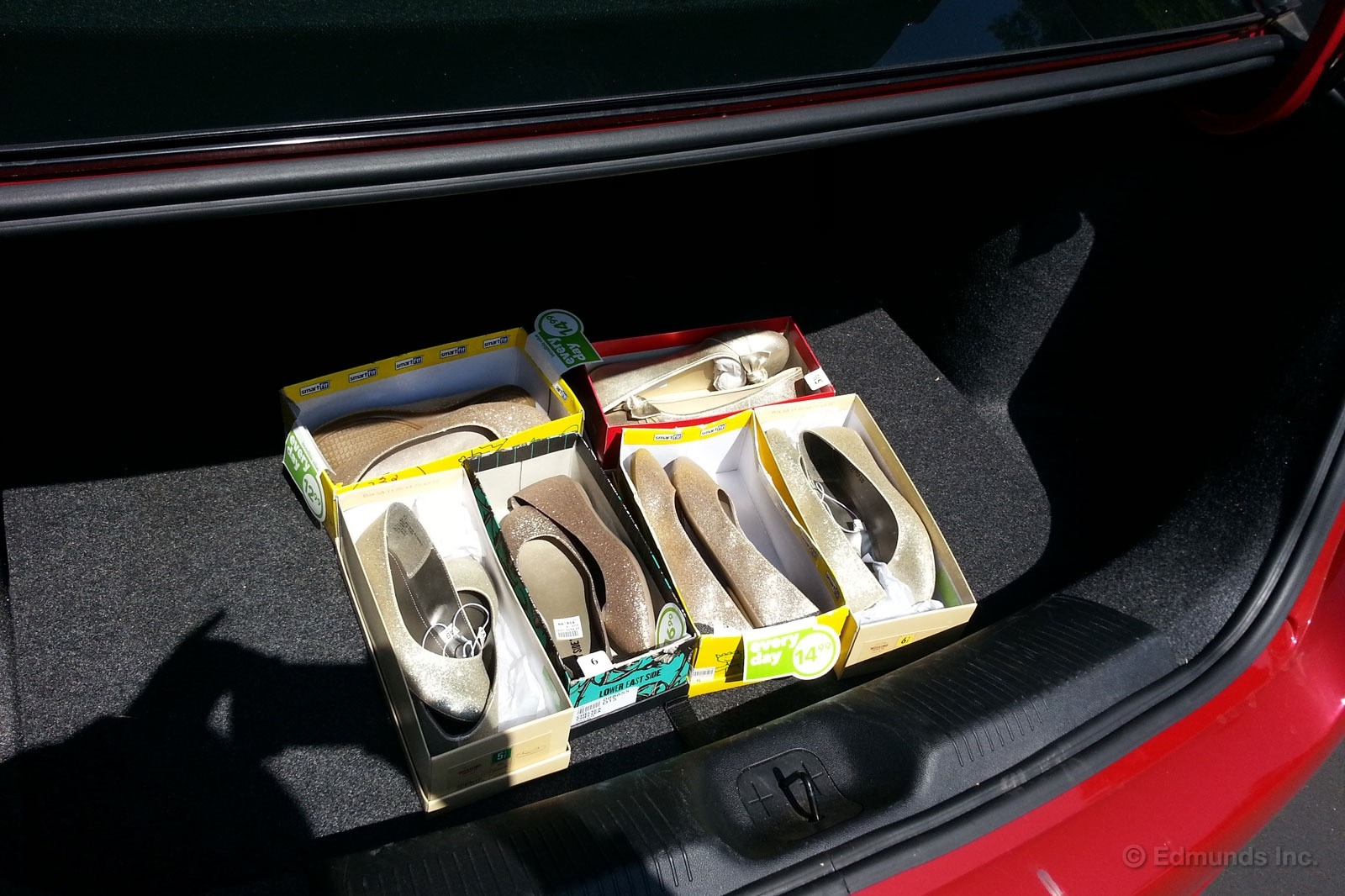
While six pairs of gold glitter ballerina flats may not exactly fill up the 2013 Dodge Dart's 13 cubic-feet of cargo capacity, they certainly help dress it up a bit.

It's possible I'm the only person on Earth who cares about my elevation. But I love it when I find this little nugget in a car's navigation system. The Dart has it.

Photo guy Kurt Niebuhr reserved a campsite at Mazda Raceway Laguna Seca a few months back, so I decided to tag along and check out the FIM Superbike race with him. Initially, I had the idea of renting a big ol' camper trailer and tow it up behind our long-term Silverado. Unfortunately, those plans fell through and we had to resort to tenting it.
A few days before we left, I checked to see what cars we should take. As it turns out, the long-term Focus ST and Dodge Dart needed miles and the 600-mile round trip would definitely help out with that. When I told Kurt our choices, he claimed the Focus before I could even finish saying Dodge Dart. No big deal, I thought. I haven't spent a lot of time in the Dart and this would make up for that.
With my tent and provisions packed in the Dart, I took the Highway 101 route. I figured if I had it in me, I'd detour to scenic and twisty Highway One, but the car simply didn't beg to be driven hard.
There have been numerous complaints about the transmission in the city, but as a few other editors have noted, the Dart is ok on the highway. Hills are still a bit of a nuisance, since it seems to be continually hunting for the right gear. Nudging the shifter to the left and into manual mode easily cures that problem.
I left L.A. with three-quarters of a tank, which yielded 29.6 mpg. Considering the EPA-estimated 31 mpg combined (27 City/37 Highway), I thought it was pretty decent.
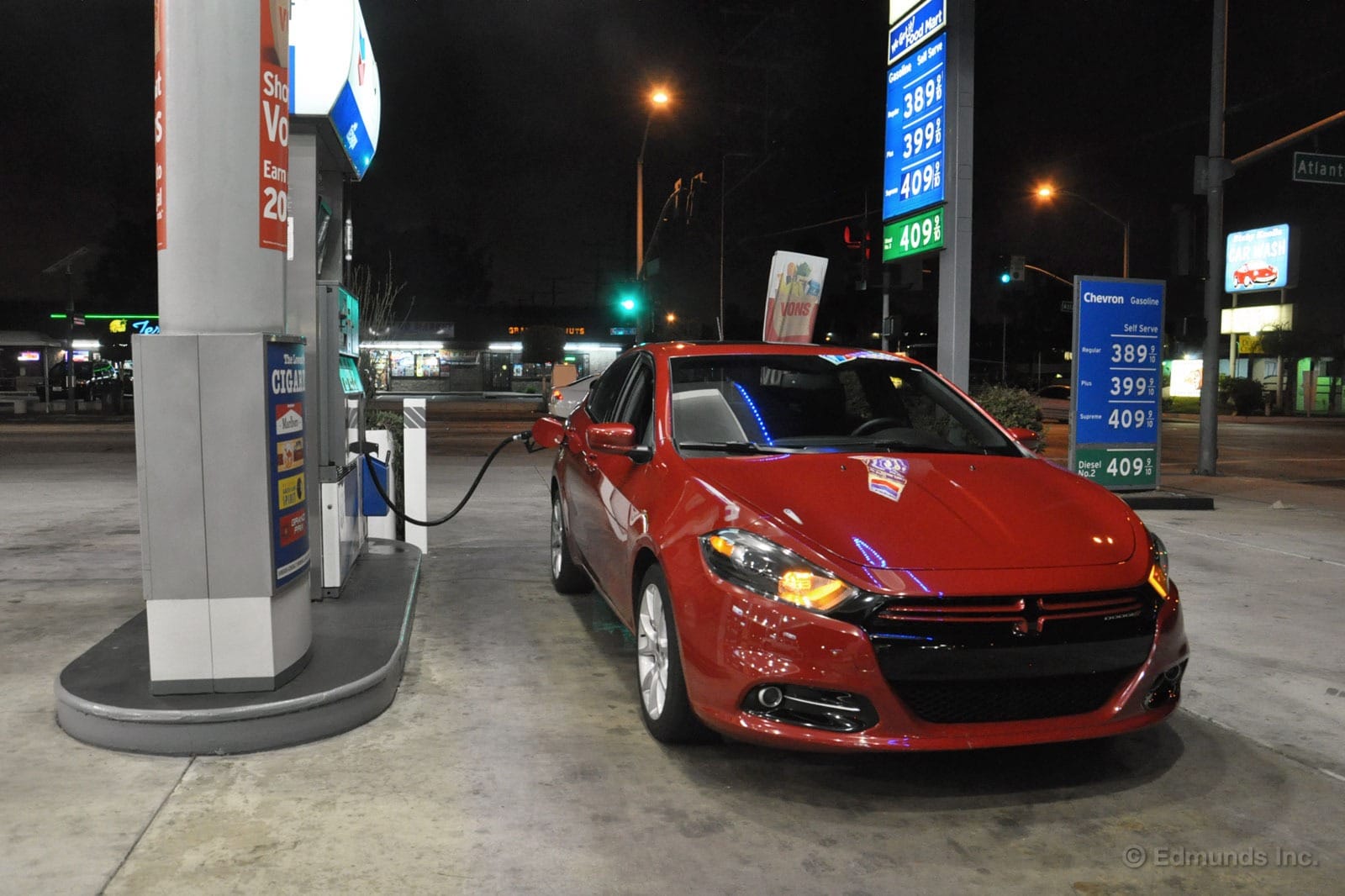
We put 1,713 miles on our long-term 2013 Dodge Dart in September. With the help of a road trip from Los Angeles to Monterey, California, our lifetime average crept up to 27.6 mpg (up from 27.4 a month ago), and we set a new high for mpg.
We can thank Mark Takahashi for this latest feat of frugality. On his return trip from Monterey, he drove 262 miles and then put in just 7.156 gallons of 87 octane. That works out to 36.6 mpg and tops our previous high of 35.6 mpg. Notably, 36.6 rounds to 37, which is the EPA highway rating on our Dart, which has a turbocharged, 1.4-liter four-cylinder engine and a six-speed automated manual transmission.
Worst Fill MPG: 16.8
Best Fill MPG: 36.6
Average Lifetime MPG: 27.6
EPA MPG Rating: 31 Combined (27 City/37 Highway)
Best Range: 486.7 miles
Current Odometer: 14,927 miles

Our 2013 Dodge Dart and I showed up at our campsite just above turn 6 at Mazda Raceway around 12:30 in the afternoon. It was pretty easy spotting the Tangerine Scream-colored Focus ST amongst the RVs trailers and tents. I had my tent habitable in no time and we wandered the track for a few hours. It was a little unsettling to see how light the crowds were for a Saturday, I must admit, but it did make getting around a lot easier.
About halfway through a Harley race, we decided to head into town to hit up my favorite place, The Crown and Anchor pub. A few Boddingtons and a prime rib later, I was feeling pretty good. Kurt said he had problems starting a campfire the night before, so I readily admitted that I was a pyromaniac as a child. It was actually the only thing I was good at when I was briefly a Boy Scout. My search for a hand ax at the local Walgreen's turned up nothing, though. I'd just have to make due with a leatherman multitool.
My firebug skills proved useful as we had a good fire going within 10 minutes.
Race day went well, with no big surprises in the races we watched. We pretty much bolted from the track after the second Superbike race, beating the RVs off the premises by a sizable margin.
When we hit Highway 101, the distance to Los Angeles was 318 miles and I had 325 miles of range estimated. I figured I'd be able to make it without refueling. 45 minutes later, I had built up a 30-mile buffer zone, so I definitely would not be stopping. Then Kurt said he needed gas. I decided to follow him anyway. I was pretty tired and a Red Bull would be helpful at this point. And it was.
We rolled into L.A. right around 8:00 p.m., after about five hours of drive time. As with the trip up, I really didn't suffer much and there were no unpleasant surprises. I averaged 36.6 mpg, which is right in there with the EPA's 37-mpg estimate.
But considering that the base Focus ST and our as-tested price for the Dart are really close, choosing between the two is a no-brainer. I'd pick the fun Focus in a heartbeat, as it's better in every way.

It felt like our 2013 Dodge Dart was running out of gas. There was no response to my throttle inputs and the car was losing speed. I was in the middle of a busy Los Angeles freeway and suddenly I was unable to keep up with traffic. I floored it. Nothing.
Traffic was light. I had been cruising in a pack at a steady 65 mph when I realized there was a problem. Now the Dart was down to 50 mph and it continued to slow. I floored it again. Nothing.
I checked the gas gauge. It read three quarters of a tank. All other gauges (there are only two) read normal, but there was a very red warning light lit on the instrument cluster. It looked like two backward parentheses and a lightning bolt. I had no idea what it meant.
I moved the car carefully to the right and onto the shoulder, but I kept it moving. I desperately wanted to make it to the next exit so I wasn't stuck on the freeway, which is very dangerous.
A quarter mile later I was on the off ramp and I could feel some throttle control coming back, like the Dodge's engine was once again getting fuel. Luckily there was no one else exiting at the time. At the end of the ramp I made a quickly right and pulled into the first parking lot.
I stopped. Suddenly the car felt normal again, but the warning light was still on. I opened the owner's manual. The light was telling me that the Dart's electronic throttle was malfunctioning. New cars no longer have a cable that connects the throttle pedal to the engine. It has been replaced by sensors, so there's no longer a mechanical connection between the two. And our sensors had done broke as they say in NASCAR.
So I threw it in Park and turned the car off. I waited a few seconds and fired it back up. No light. Normal throttle response. Reboot successful. And the rest of my drive to work was uneventful.
We'll keep an eye on this and let you know if it happens again.

When I see a branded stereo system in any car, I expect the sound quality to be decent, at the very least. Our Alpine audio system in the long-term Dart set us back $495, but I really don't think it was worth it.
It operates just fine, finding my iPhone without any issues, though it does seem to index my library for a few minutes every time I plug it in. This keeps me from browsing from the list or shuffling.
No, my issue is with the sound quality itself. Whether it's the speakers or system is irrelevant. It sounds muddy on both ends of the spectrum. Highs are pretty much nonexistent with the equalizer flat. As the picture above shows, I have to crank it way up to hear any detail. Down low, the bass just falls apart in a flatulent buzz.
In a big orchestral piece, where highs and lows push systems to their limits, the Dart's Alpine system is a huge disappointment. It's not much better with tracks that are more bass or treble specific, either.
My verdict: Skip the Alpine upgrade and maybe try buying better speakers instead
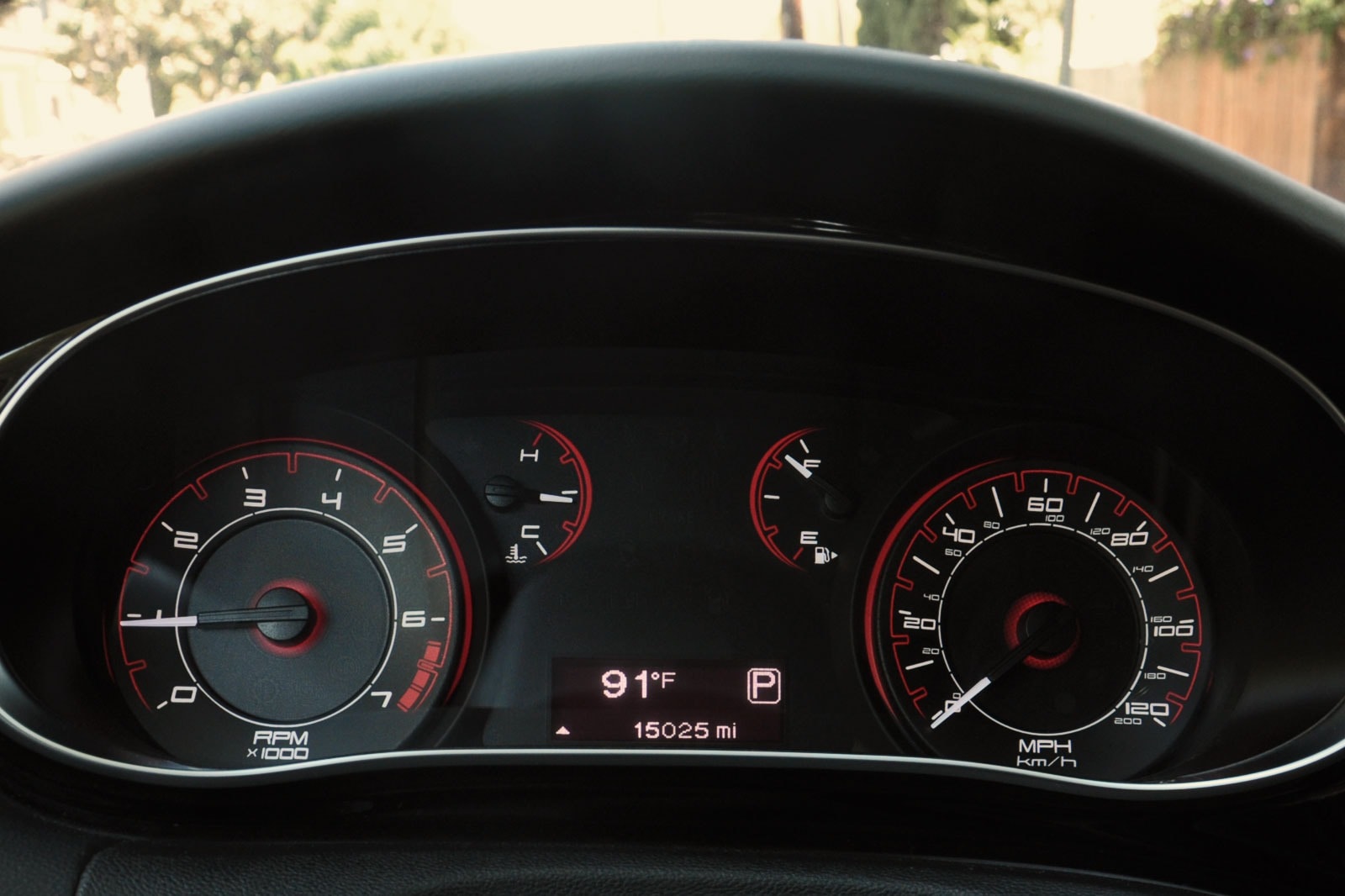
Our 2013 Dodge Dart SXT Rallye hit 15,000 miles last Saturday. I was driving in fast-moving freeway traffic at the exact moment of the milestone and had to settle for this 15,025-mile photo of the instrument panel.
The Dart and I spent a quiet weekend running errands and listening to post-season baseball on the radio. However, our red sedan's first 15,000 miles have not been as uneventful as we'd like.
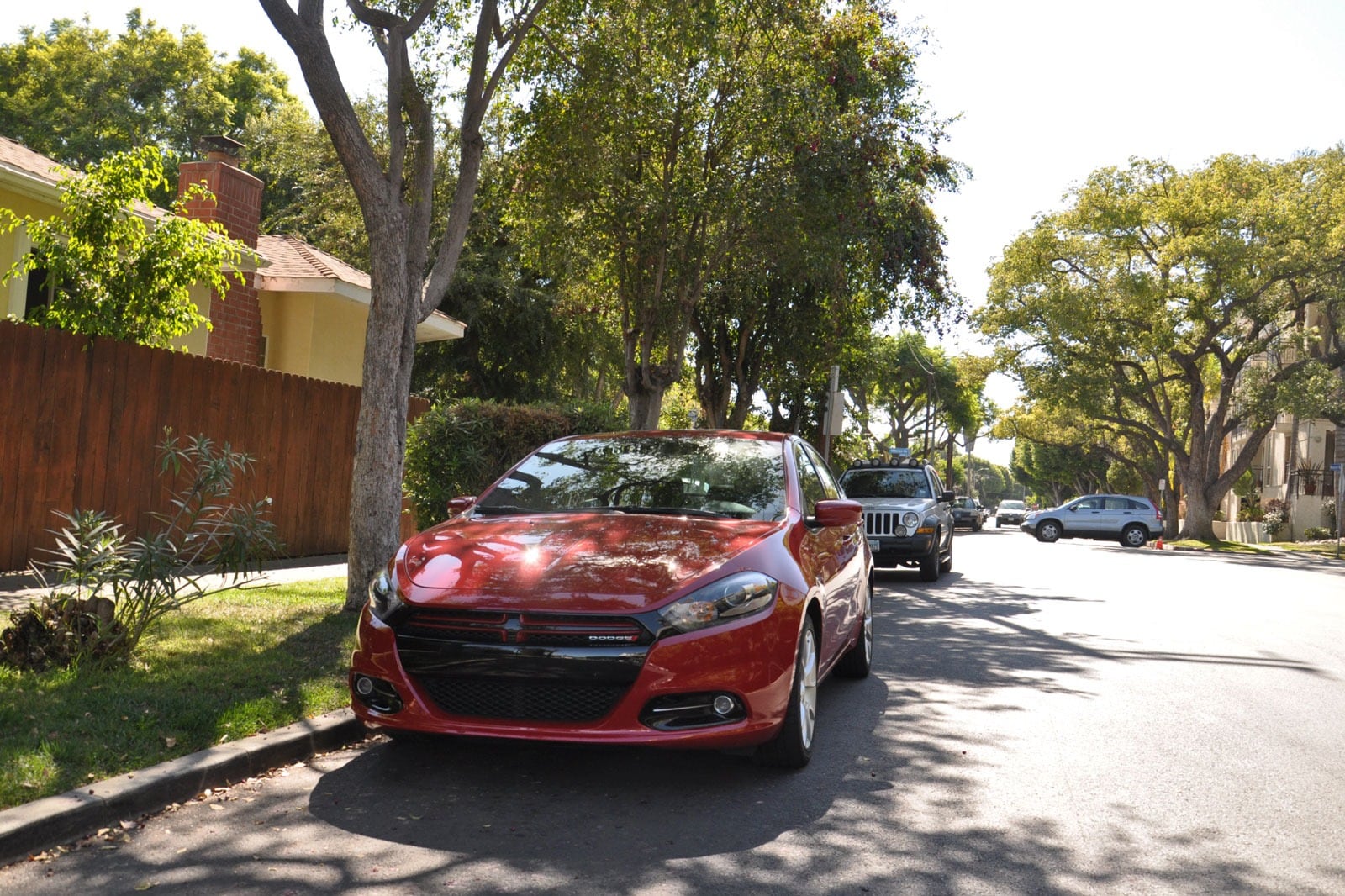
If you look at our maintenance-related updates on the Dart, you'll see that we've already dealt with a broken door handle and a windshield that spontaneously cracked from the inside out. More recently, though, the Dart randomly went into limp-home mode while our editor in chief was at the wheel, which was kind of a drag. It's too bad, because apart from these issues, the Dodge Dart has some real positives. I find it comfortable for commuting, there's ample storage, and the audio-navigation interface is easily best-in-class.
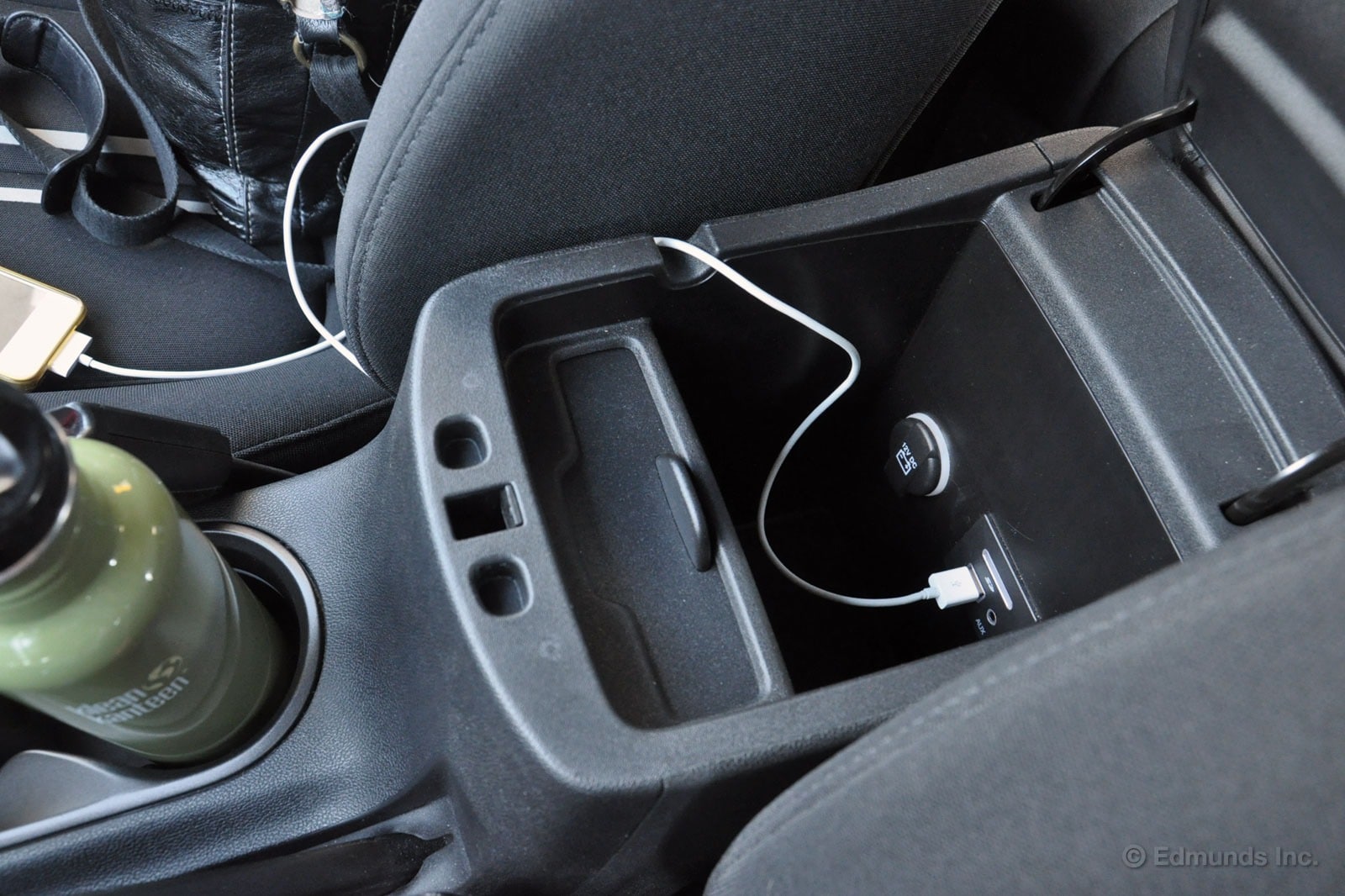
One small detail in our 2013 Dodge Dart SXT Rallye that I really like is this notch in the center console container. It provides a pass-through for USB or auxiliary cords hooked into the ports in the console box.
Obviously, there's no legally defensible reason to interact with a smartphone while driving, but sometimes you just want to have it out and accessible. And although the notch's location (right up against the Dart's passenger-seat seat-back bolster) is a little inconvenient, it effectively prevents the cord from being smashed when you close the lid of the console.

A while back, I found the source of my occasional migraines. Bright morning sunlight. Either that, or I'm part vampire, which might explain a whole host of other things, but I digress. One morning, I made a right turn onto a boulevard and got hit smack-dab in the retina by a brilliant flash of sunlight (as shown in the poorly Photoshopped simulation above).
It burns! It burns!
Alright, maybe I'm being a little dramatic.
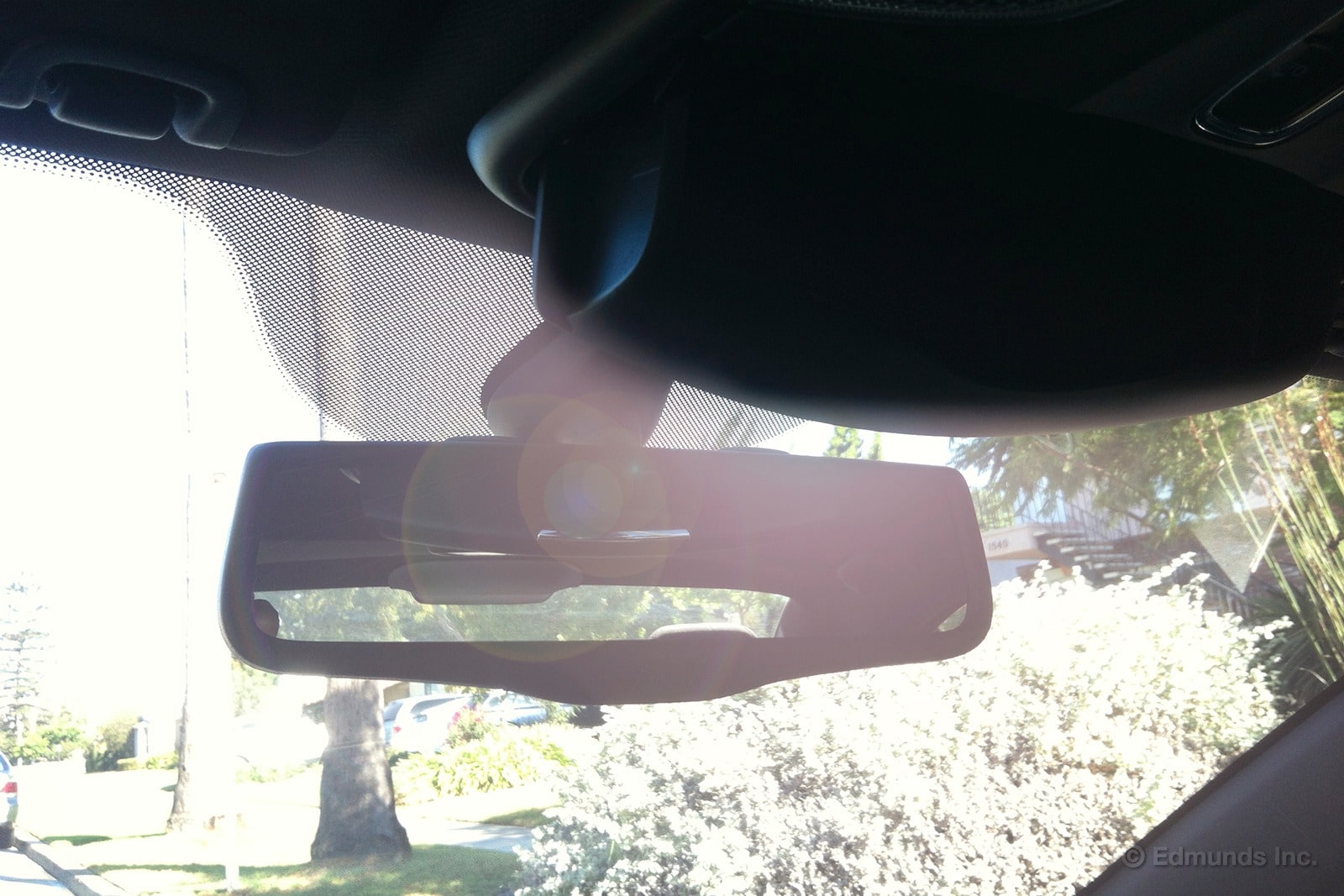
I immediately put my hand up to block the infernal light and in the process, accidentally hit the sunglass holder. It slowly and gracefully lowered from the headliner, providing just enough shelter from the sun without blocking the rearview mirror.
Salvation.
Those printed screens that a lot of manufacturers use on the windshield do little to block out that kind of intense light. I wish that we could get a little auxiliary visor that would flip down instead. I know a former girlfriend's Audi A4 had one, and if memory serves me right, so did our old Acura NSX. Dear car makers, please do more of this. Thanks.
By the way, just creating that lead image may have triggered another migraine. Ugh.
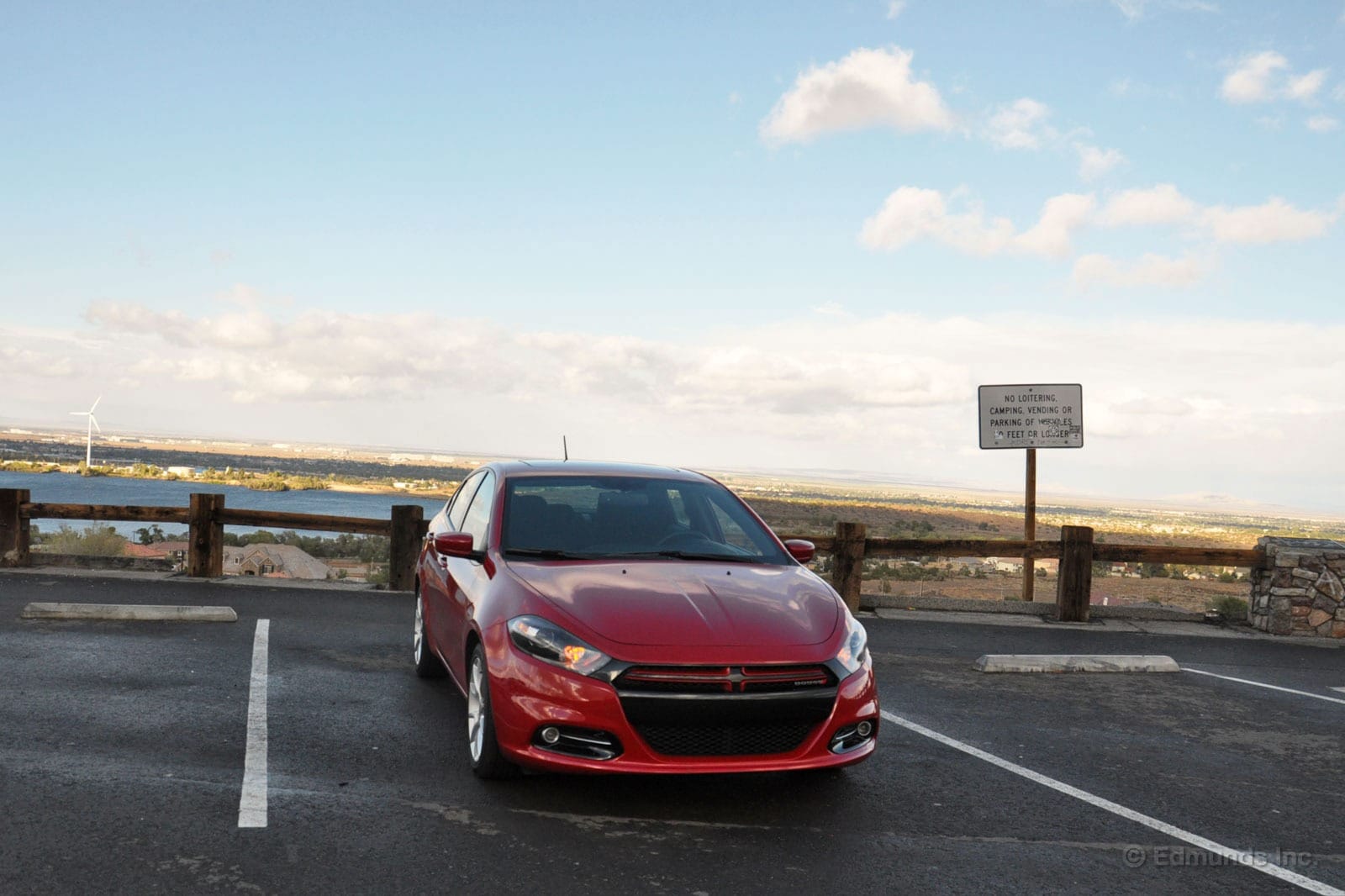
I've put about 1,000 miles on our long-term 2013 Dodge Dart SXT Rallye in October. One thing I've really come to appreciate about it is the excellent visibility from the driver seat.

As you sit in the cockpit, the dash and doortops feel relatively low around you, certainly by modern automotive design standards. And for me, there's a good view in all directions. I could get by without our car's back-up camera if I had to, and the small side mirrors (clearly some Fiat designer's small victory of form over function) rarely bother me anymore.
Visibility is a big deal to me (as I'm sure it is to any driver who really thinks about it), and good visibility makes up for some of the Dart's other foibles.
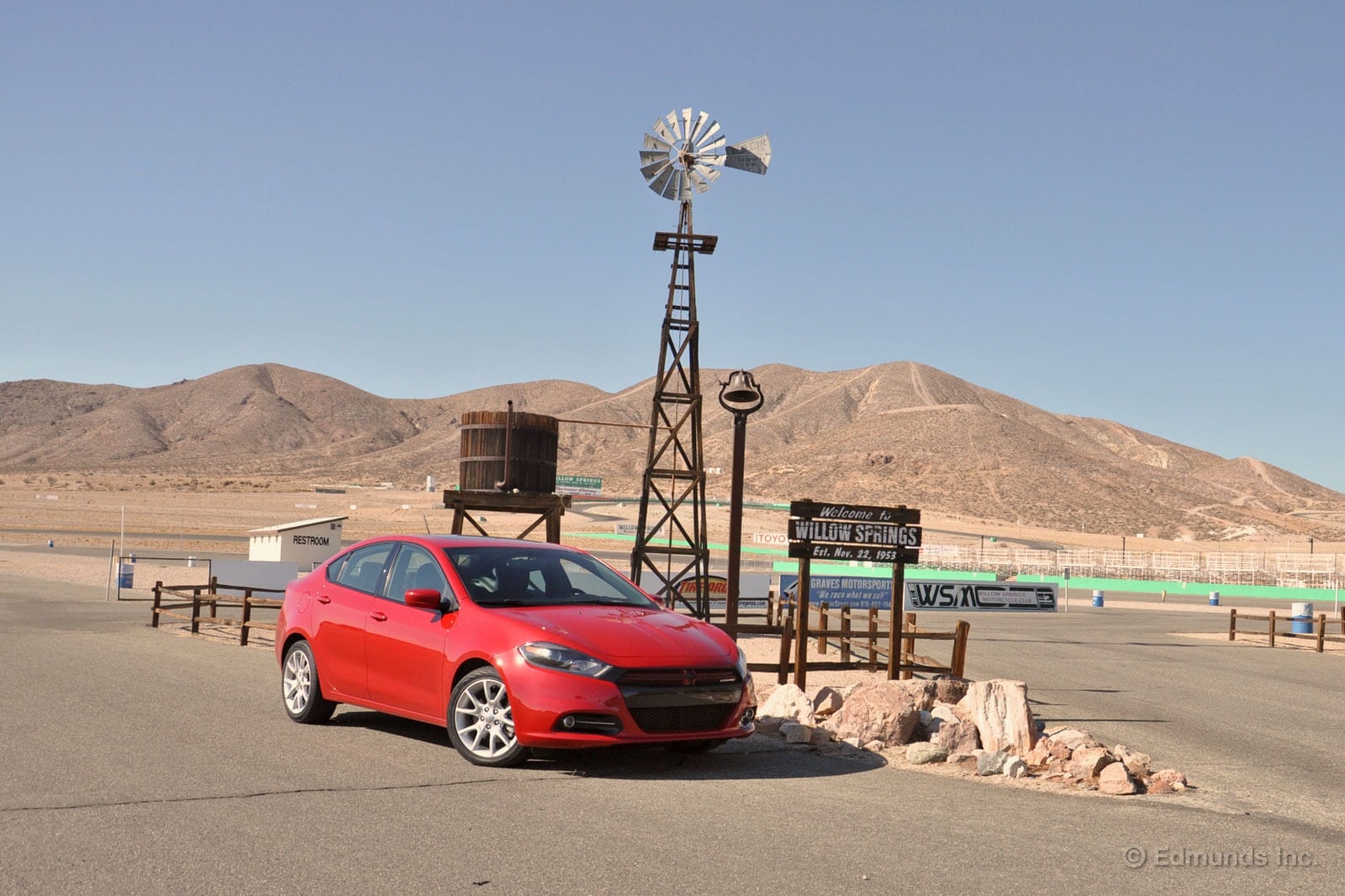
Last week I took my only real long drive in our long-term 2013 Dodge Dart. It's about 110 miles from my house to Willow Springs Raceway in Rosamond, California.
I hit a bunch of traffic on the return trip, which on its own took about three hours. Until everything ground to a halt, though, the Dart was unexpectedly serene at highway speeds.
Neither wind noise nor tire noise is especially noticeable at 70 mph on the highway. For its class, the Dart is acceptably quiet in my view.
To my ears, engine roar is the biggest contributor to cabin noise, and it's really only an issue when you ask the turbo 1.4-liter to dig deep for a passing maneuver on an uphill grade. I like small, turbocharged engines, but the Dart might just be too big and heavy to use an engine this small. I have a feeling the naturally aspirated 2.4-liter four-cylinder on the GT version (an equipment package on the Limited trim level) might be more my speed.

For several reasons, our long-term 2013 Dodge Dart SXT Rallye was my support vehicle during my recent house move. Actually, it was part of a fleet of vehicles that included a 17-foot U-Haul truck, MkVI Volkswagen GTI and a two-decades-old Toyota pickup.
Obviously, a small sedan would never be anyone's first choice for moving, but over the course of a very long weekend, the Dart provided reasonable utility.
Trunk capacity in this car is 13.1 cubic feet, which is average for a compact sedan. What this number doesn't tell you about, though, is the height of the Dart's trunk. The opening is pretty large and vertical clearance remains consistent in the trunk, and it's maintained by the pass-through created by flopping down the 60/40-split rear seats.

Accordingly, I was able to load this Amazon box, which is just under 17 inches tall and about three-and-a-half feet long. The rear seats don't fold perfectly flat, but once you have enough boxes piled on top of them, the slope really isn't an issue.
The gooseneck-style trunk hinges proved to be the only real annoyance. They don't intrude that much into the actual cargo space, but as Dan Edmunds discovered when loading dog food, they don't hold the trunk lid up with much authority. Merely brushing the lid while trying to finagle boxes into place would cause it to slam shut.
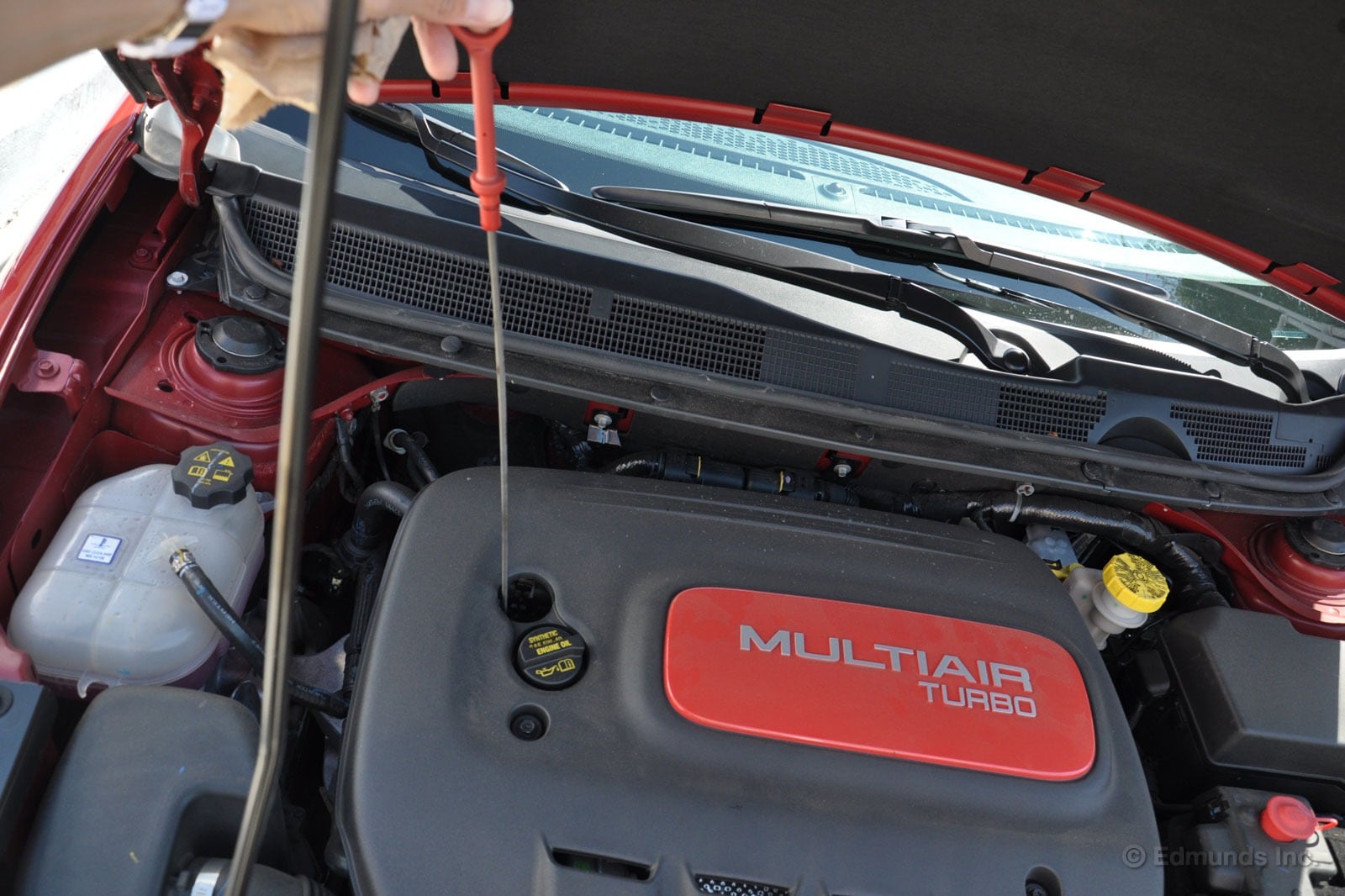
After putting quite a few miles on our 2013 Dodge Dart SXT Rallye, I decided to check the oil before handing the car over to another editor. This is actually a pretty pleasant experience, because the basic service points are well marked and the dipstick is easy for an average-size adult to reach.
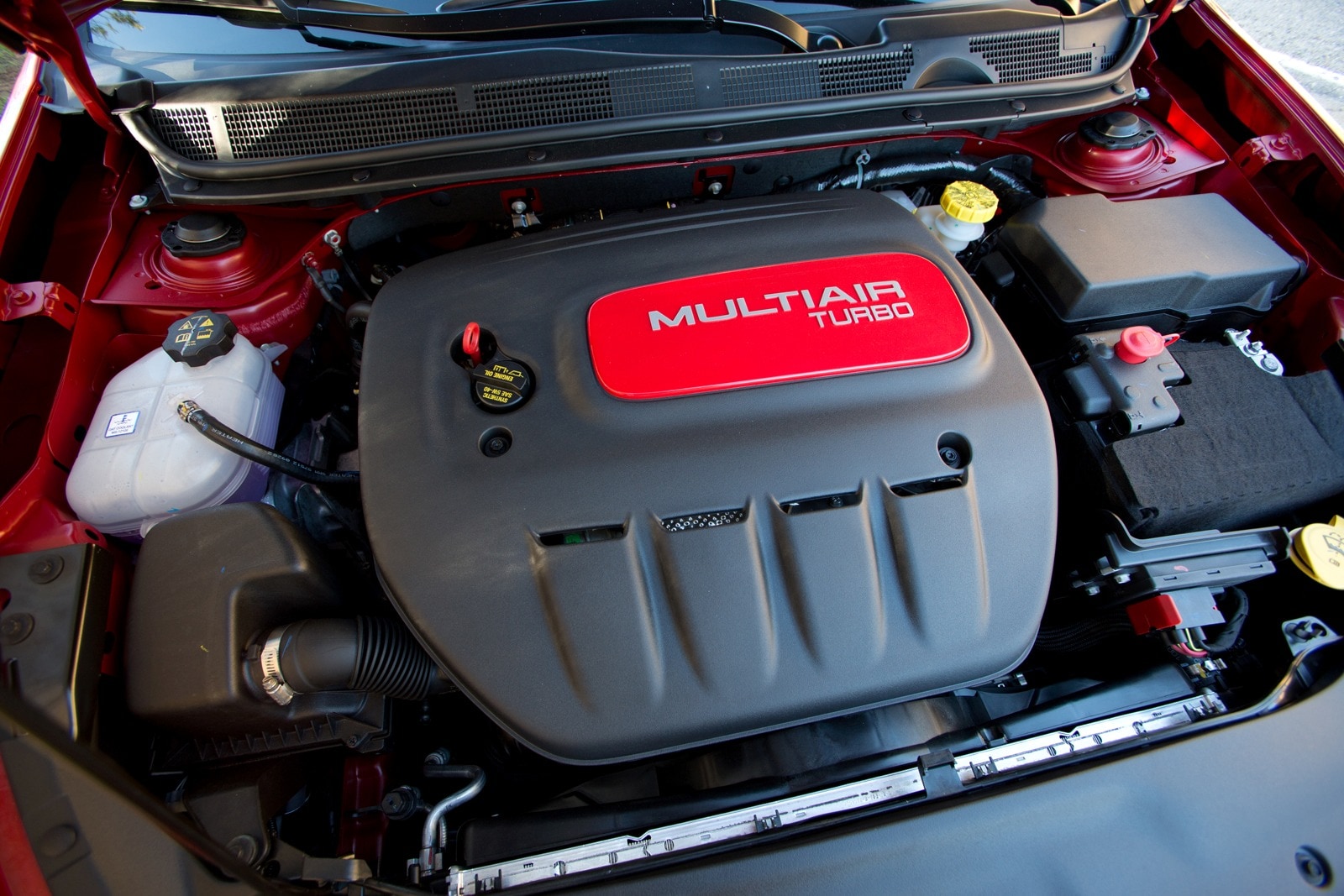
It's also a really sturdy piece of metal (thicker than the dipsticks you typically see in cars in this price range), and reading the oil level was no problem. It's a little tricky to reinsert into the tube, which is located a little farther below the plastic engine cover than I'd like. In all, though, this exercise took maybe 15 seconds, and the oil level was fine.

In the month of October, we added approximately 1,300 miles to our 2013 Dodge Dart's odometer.
We averaged 27.5 MPG during that time, which is just one-tenth off from our lifetime average.
We're still not matching the EPA estimated combined rating of 31 MPG, or coming anywhere near the highway estimate of 37. But we are bettering the EPA city estimate of 27 MPG, if only slightly.
Worst Fill MPG: 16.8
Best Fill MPG: 36.6
Average Lifetime MPG: 27.6
EPA MPG Rating: 31 Combined (27 City/37 Highway)
Best Range: 486.7 miles
Current Odometer: 16,220 miles
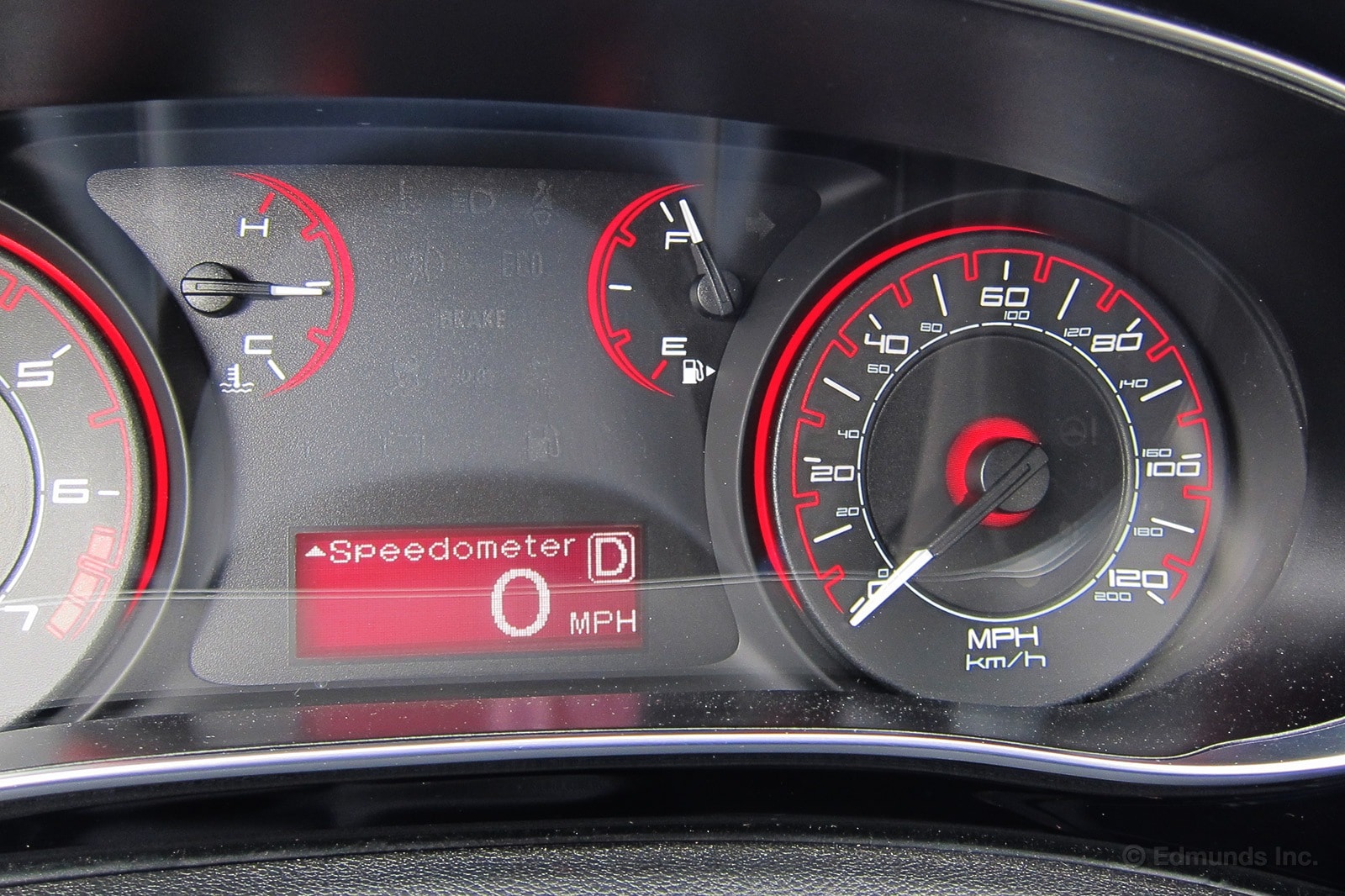
Good thing there is a digital speedo option in our long-term 2013 Dodge Dart, because I have trouble reading the regular dial.
The way the red pattern goes around the white lines and numbers combined with the white tip on the needle, makes it hard for me to read at a glance. Maybe if the needle was a different color like yellow or blue, it wouldn't play tricks on my eyes.
Scott thinks I'm nuts but Monty agrees with me. What do you say?
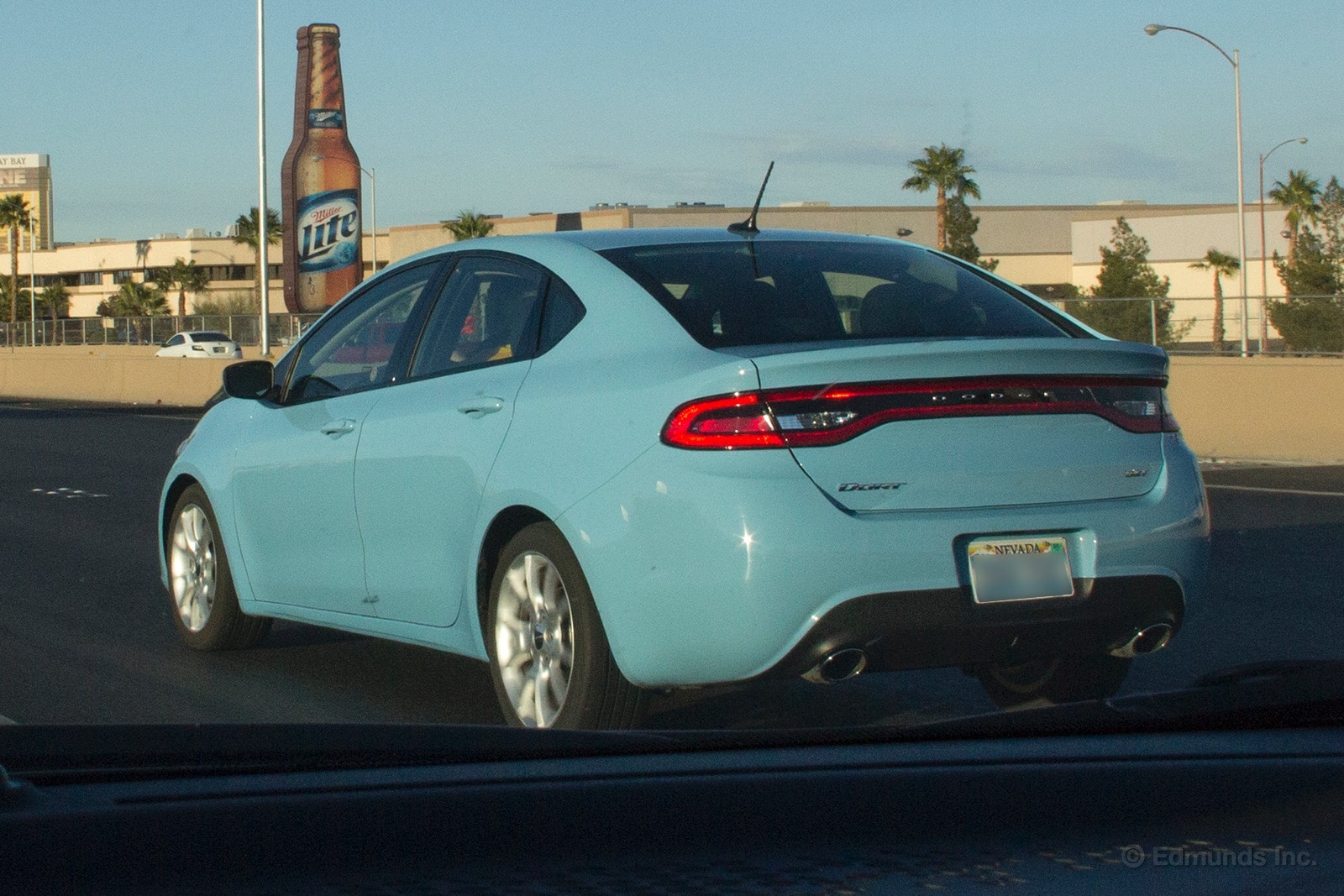
While driving our long-term 2013 Dodge Dart in Nevada, I spotted another Dart for the first time.
"Whoa, that's really blue. Must be custom," I thought. "Also, this guy must really like periwinkle."
Turns out, this isn't a custom color at all. It's one directly from Dodge: Laguna Blue. The infinite wisdom of the interwebs tells us that our Redline paint will garner more attention from law enforcement, but I'd take it over the super-pastel Laguna Blue any day.
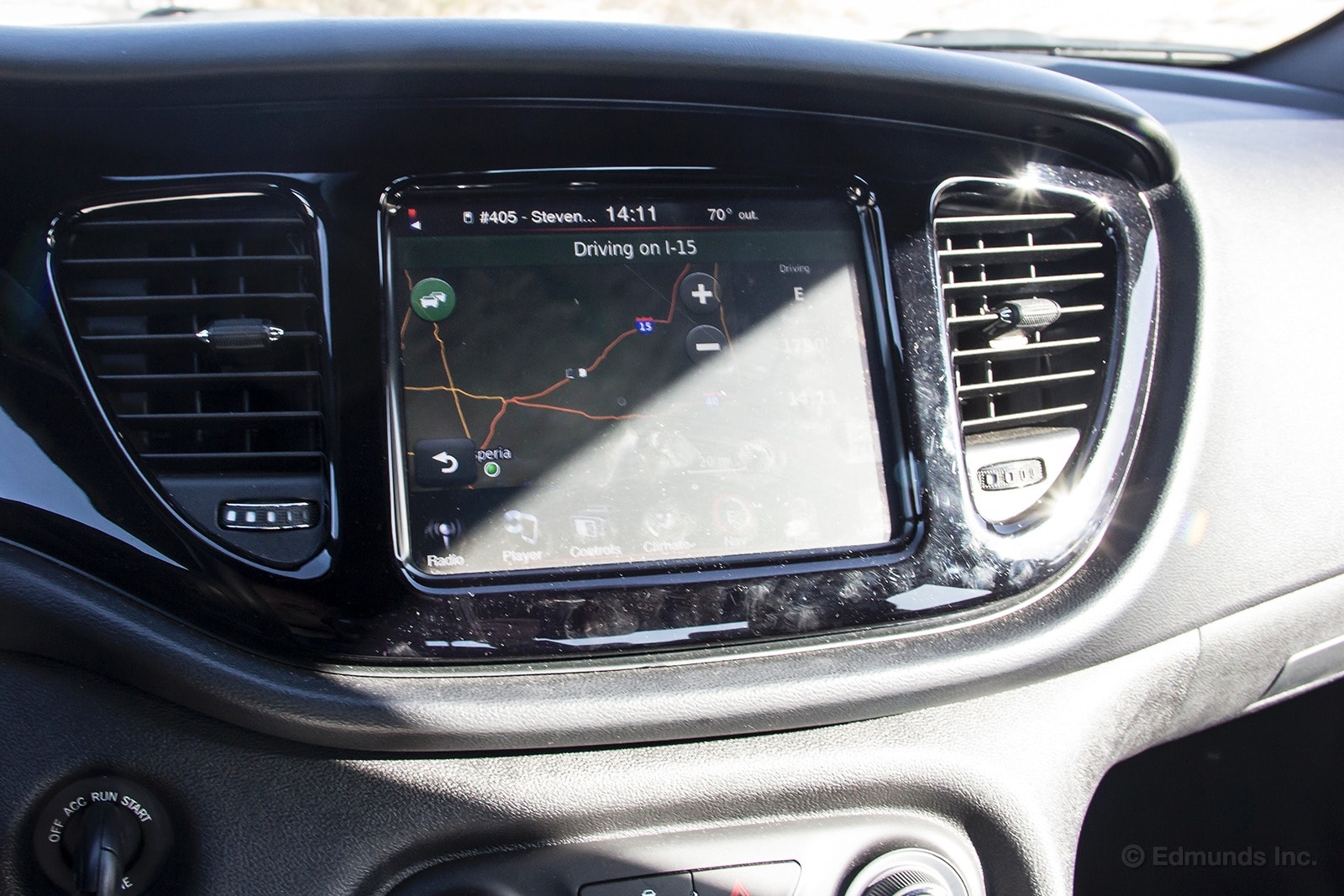
Our long-term 2013 Dodge Dart has a great navigation system. However, our staff has delivered mixed reviews on the optional Alpine audio system (I think it sounds pretty good, though) and the complicated controls for the air-conditioning.
The design of the controls is irrelevant when you can't see them at all, though.
With a setting sun behind you, the Dart's touchscreen display becomes nearly impossible to see. The shiny trim around the center console is pretty blinding, too. Depending on the direction of your commute, this could be pretty annoying each day, especially if you forget your sunglasses at home.
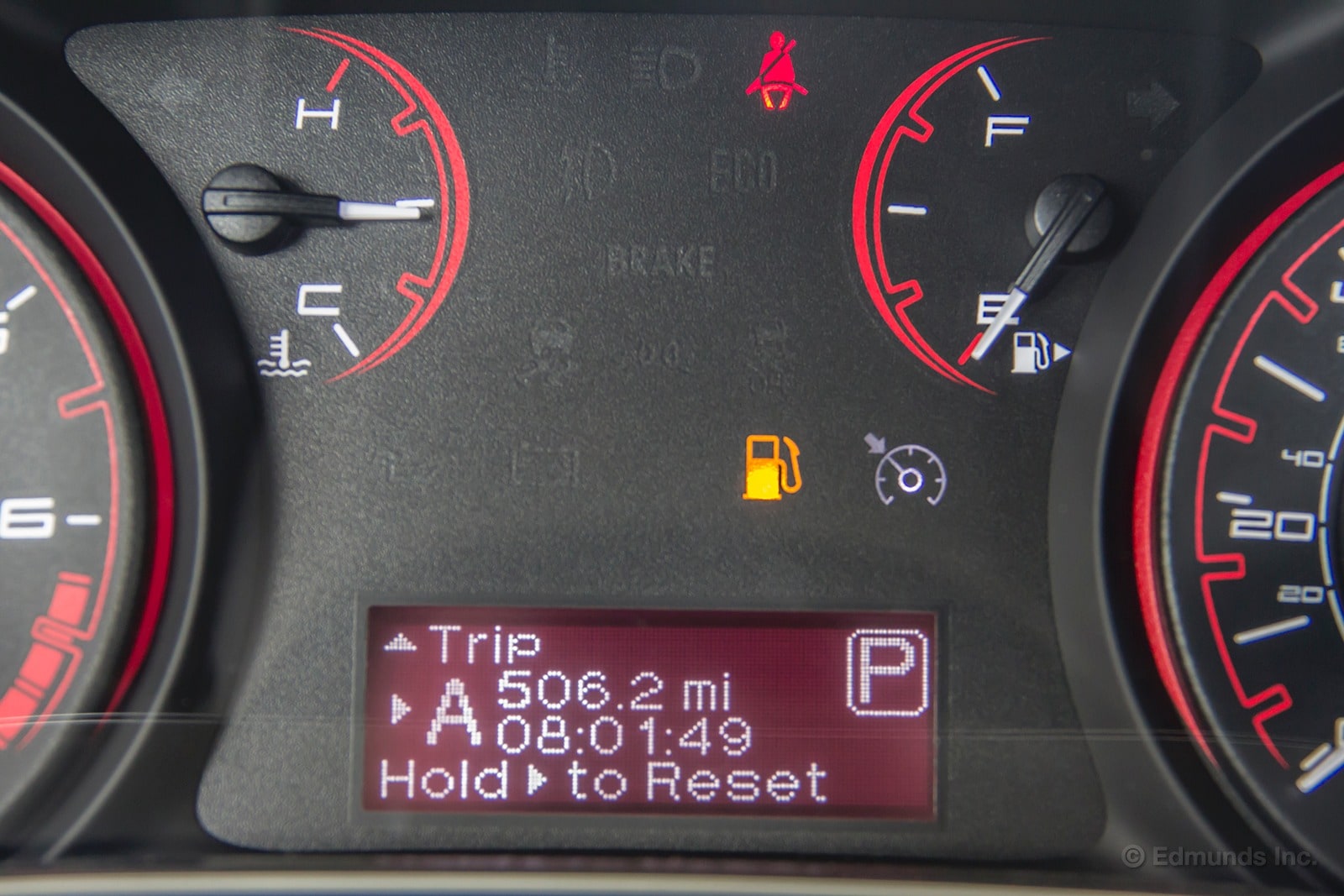
The Las Vegas Strip is 280 miles from the Edmunds.com offices. I probably could've squeezed an additional 60 miles of range out of our long-term 2013 Dodge Dart SXT Rallye by hypermiling on my road trip to Vegas. And I might've made it back from SEMA without stopping to gas up, but in the end, I still drove the Dart 506 miles on just one tank of gas.
Our best recorded mileage in the Dart is 36.6 mpg, and with a 15.8-gallon fuel tank, that puts the theoretical maximum range at 578 miles.
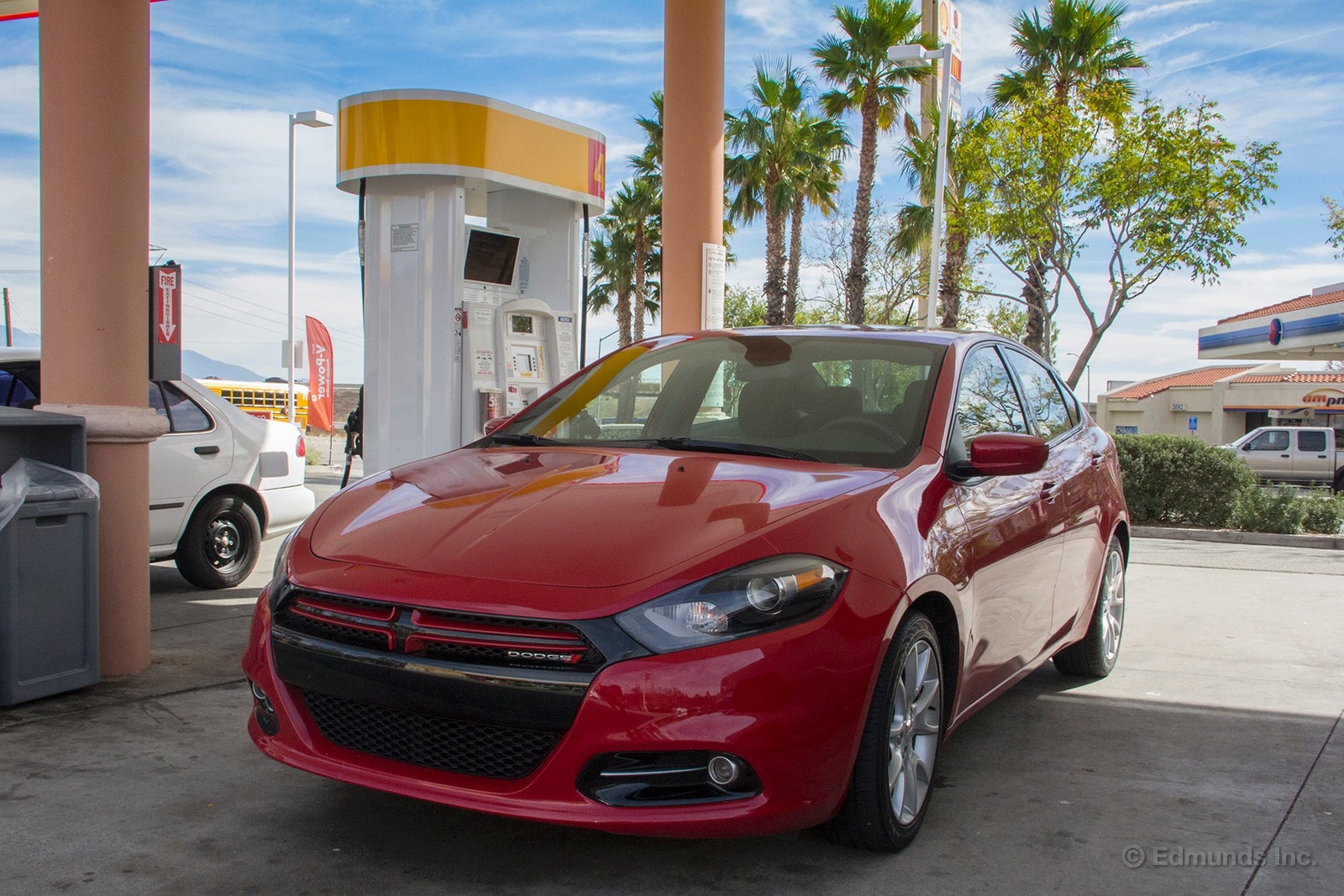
After 506.2 miles on the highway, the Dart consumed 15.067 gallons of fuel. With a little less than one gallon of fuel left, it had achieved approximately 33.6 mpg across the desert (which is 6 mpg better than our lifetime average for the car if you're wondering). I would walk 500 miles, but with the Dodge Dart, there's no need. I can just drive there.
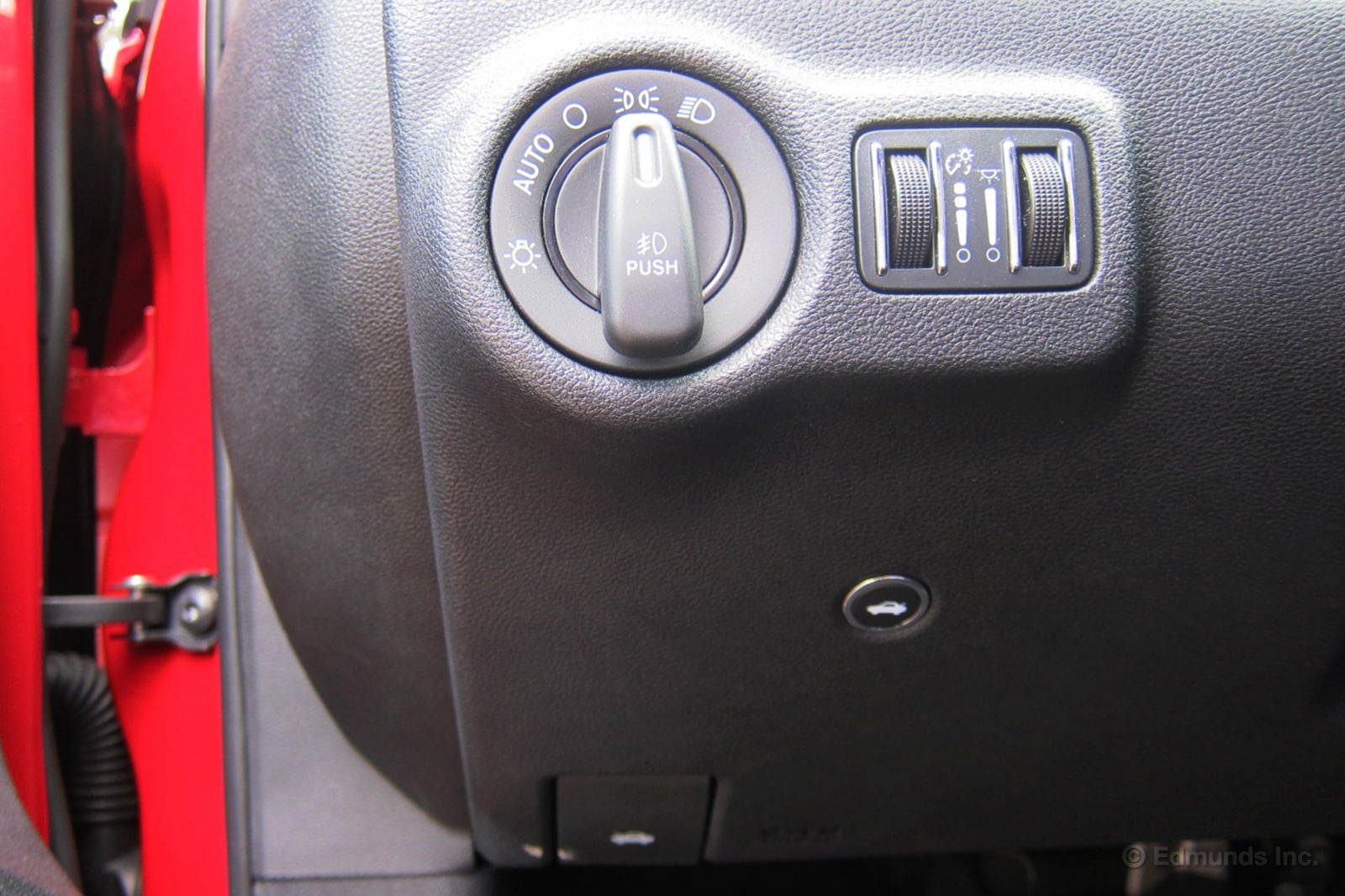
The trunk release button is one of the Dart's mysteries. What designer decided to hang it out there by itself in the middle of the lower dash panel? The fuel door release, also floating by itself, this time on the driver-side door panel above the door pocket, is a similar mystery.
Whether this is just an Italian or Dodge design quirk, or a real case of slap-dashing interfaces, it's a small reminder that the Dart isn't yet ready to hang with the Civic, Focus or Forte. It's competent and at least gives Dodge a presence in the segment, ideally something to mark time until an American design team can re-imagine it from the ground up. But with inferior materials quality and fit-and-finish, and that wheezy drivetrain, the Dart is limited to competing on price, incentive and loyalty given other choices for compacts.
Bonus points for trimming the buttons with a chrome ring, however.
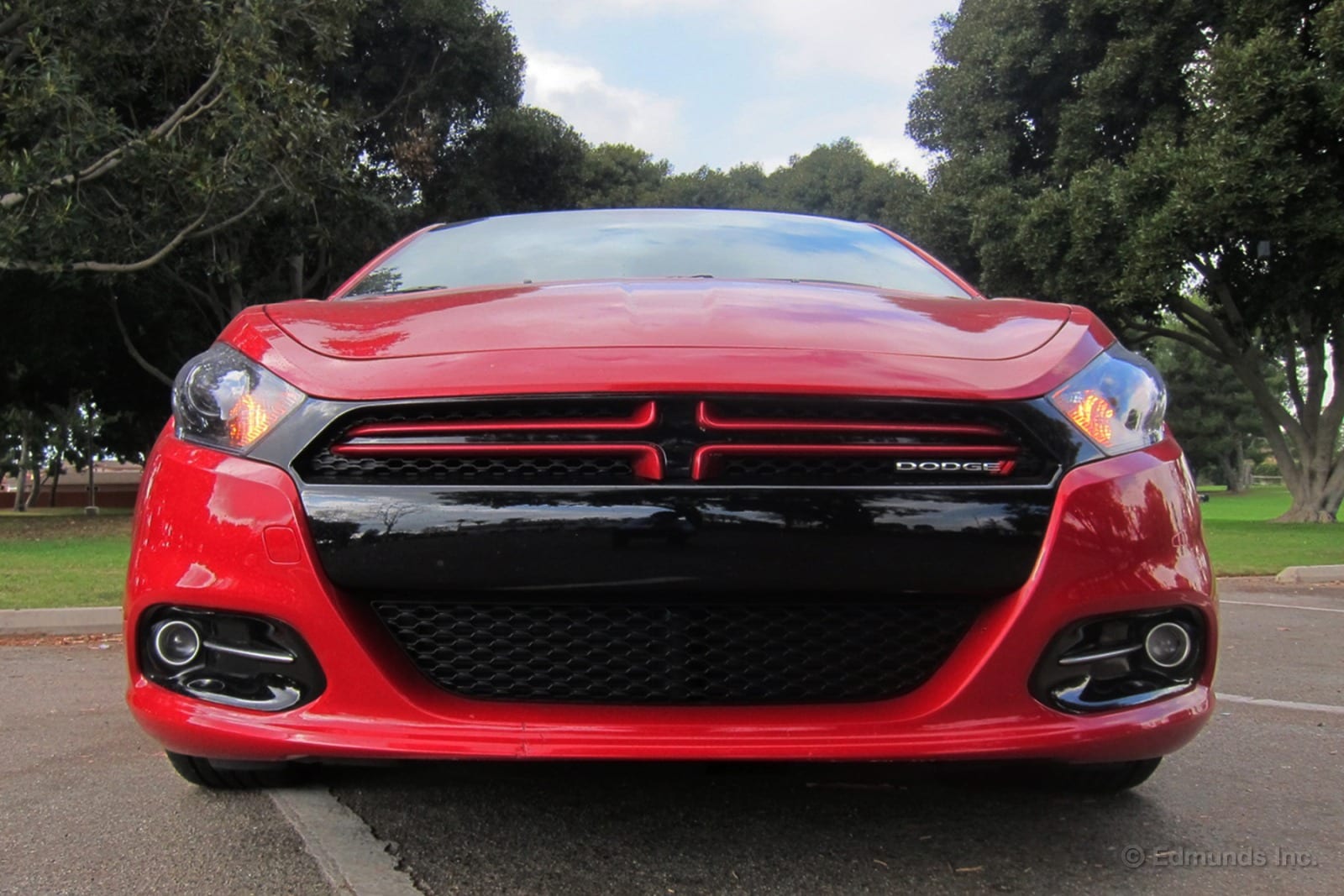
Granted, you'll only see the Dodge Dart like this right before it mows you down, but it's one of the car's more flattering angles. Actually, that's not totally true. The 2013 Dart looks pretty good overall with a more distinct front end than most in its class. But there's no making peace with the tail end. There's just a whole lotta rear-quarter fender out there.
My only beef is that with the exception of the grille and solid rear taillight panel, there's just not much Dodge here. Or rather, there's not much Charger or Challenger here. There's not even much, if any Avenger here, although one could reasonably assert that's a good thing. But at least those late '60s Darts, with the upright greenhouse and long-hood proportions, bore more than passing resemblance to the Chargers, and later Challengers, of the day. Today's Dart looks nothing like the pony car or muscle sedan with which it shares a badge.
Who knows if this affects sales. Probably not. Mine's an aesthetic complaint, and I'm the guy that Dodge marketers wish would go away. They don't care what I thought the Dart was or should be. They want buyers who respond to Tom Brady and Travis Pastrana. They want buyers with no preconceived notions, and those who don't believe the Patriots are the most soulless, unimaginative and desperate team in football.
We'll see how they feel when the redesign comes around in 2016 or '17.
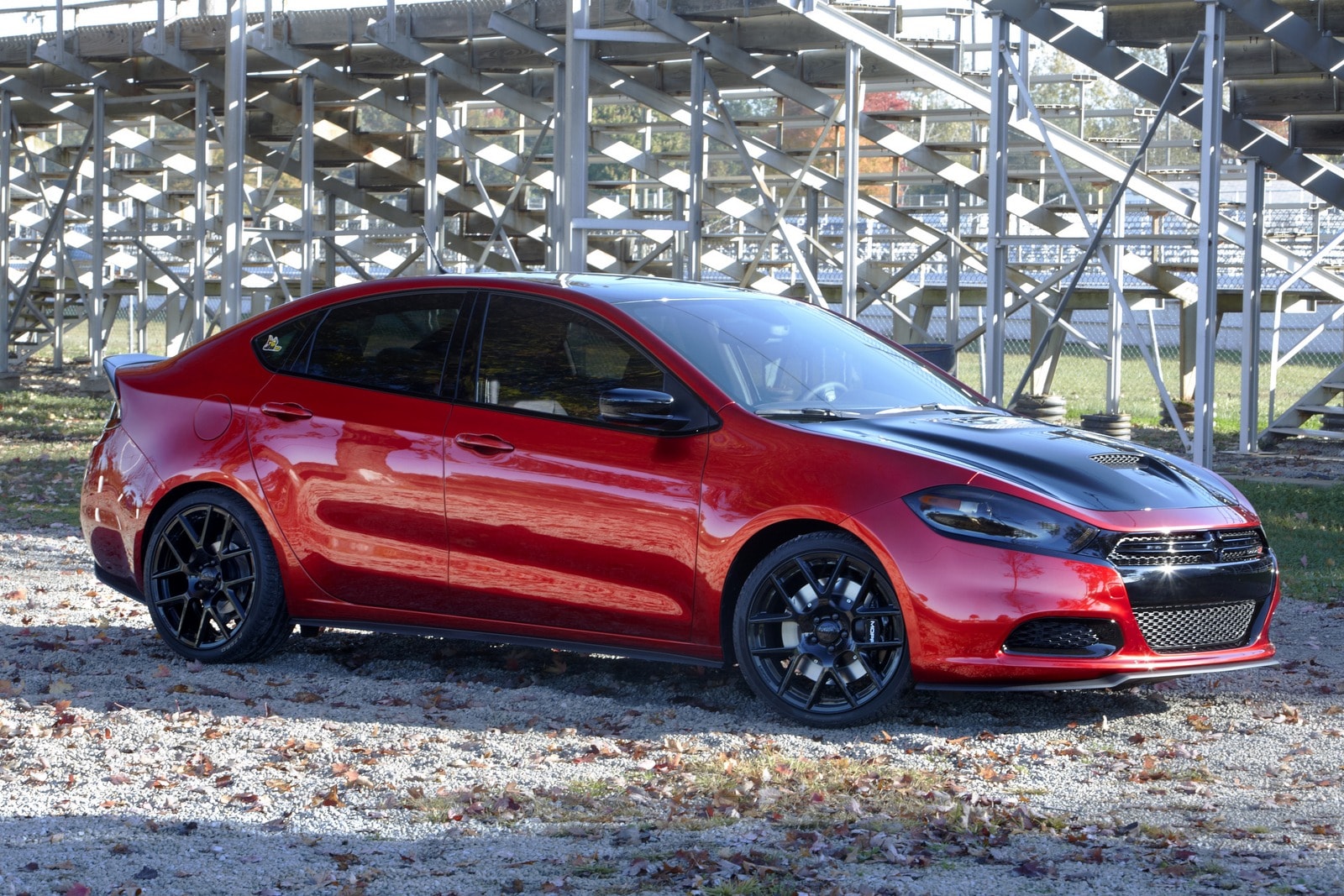
Swing by your local Dodge dealership late this year and it's likely you'll see some new 2014 Darts mixed in with some leftover 2013 models on the lot. Pricing will be lower on those 2013s, but the 2014 model receives some updates that should make them more tempting.
For 2013, an underwhelming 160-hp 2.0-liter engine came standard on every trim level except the GT. The turbocharged 1.4-liter engine, like on our SXT, was optional. The GT, which didn't debut until late in the model year, got exclusive use of a 184-hp 2.4-liter four-cylinder engine.
The big change for 2014 is that just about every Dart except the base level SE now has the 2.4-liter engine as standard. The SE still has the 2.0-liter, but the SXT, Limited and GT all now have the 2.4. Depending on the trim level, you can pair the 2.4 with a six-speed manual or six-speed automatic transmission.
The Aero, which is now an official trim level instead of a package, is the only version to get the turbo 1.4.
We've yet to test a Dart with the 2.4-liter engine, but we've got one coming in for just that in the coming weeks.
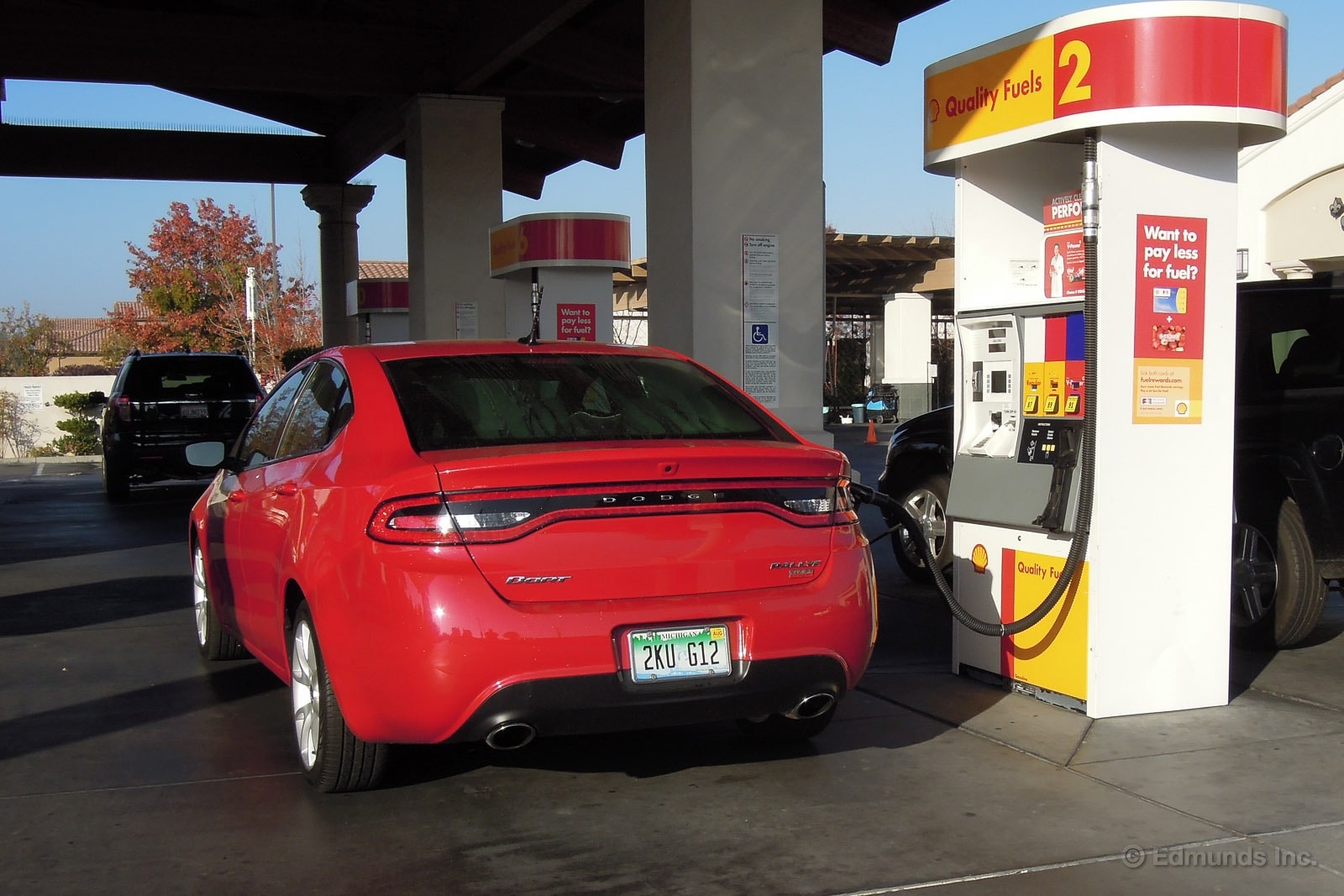
We added about 1,400 miles to our 2013 Dodge Dart Limited during November. Some of that mileage came from normal commuting, but we also made a trip from our Los Angeles offices to Las Vegas for the SEMA show.
For the month, we averaged 29.4 mpg. We also saw our best range from a tank so far: 502 miles.
That 29.4 mpg figure is better than our lifetime average, which stands at 27.8 mpg. But either way, we're still below the EPA combined average estimate of 31 mpg.
Worst Fill MPG: 16.8
Best Fill MPG: 36.6
Average Lifetime MPG: 27.8
EPA MPG Rating: 31 Combined (27 City/37 Highway Combined)
Best Range: 506 miles
Current Odometer: 17,579 miles
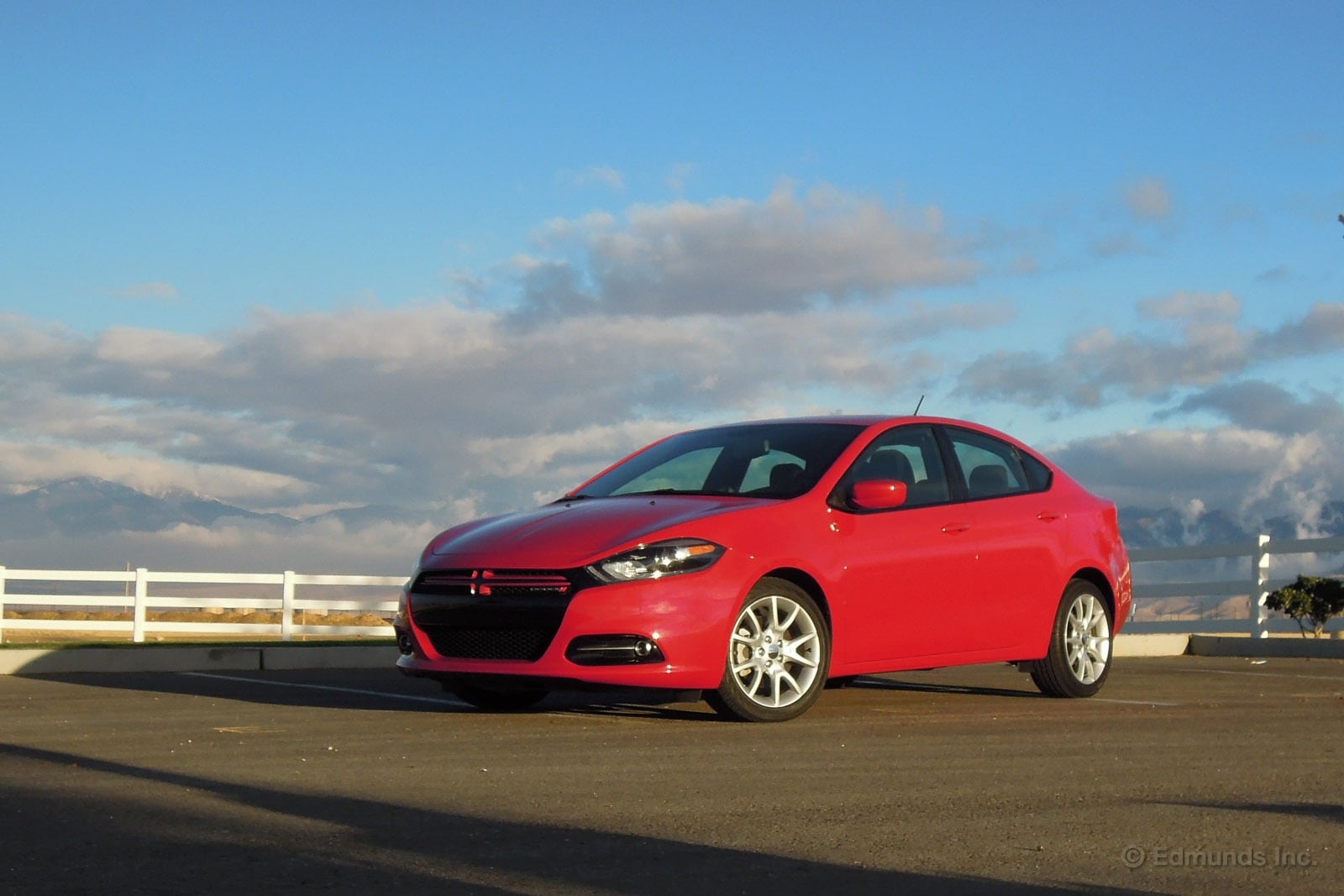
It's been about nine months since I've driven our 2013 Dodge Dart. After having not been in it for so long, it was interesting to get reacquainted with Dodge's compact car and see if any of my impressions would be different.
Certainly the car's styling continues to be one of its top attributes. Some cars look luster with familiarity. But looking sharp and purposeful without being overdone, I think the Dart's appearance will have some legs for years to come.
One other thing that struck me was how well the touchscreen electronics interface works. Here, I think I had just forgotten a little. But having driven a lot of other cars in the intervening months with less-than-stellar touchscreens, the Dart's really stood out to me. It's quick to respond, easy to use and arguably the best interface you'll find in this class.
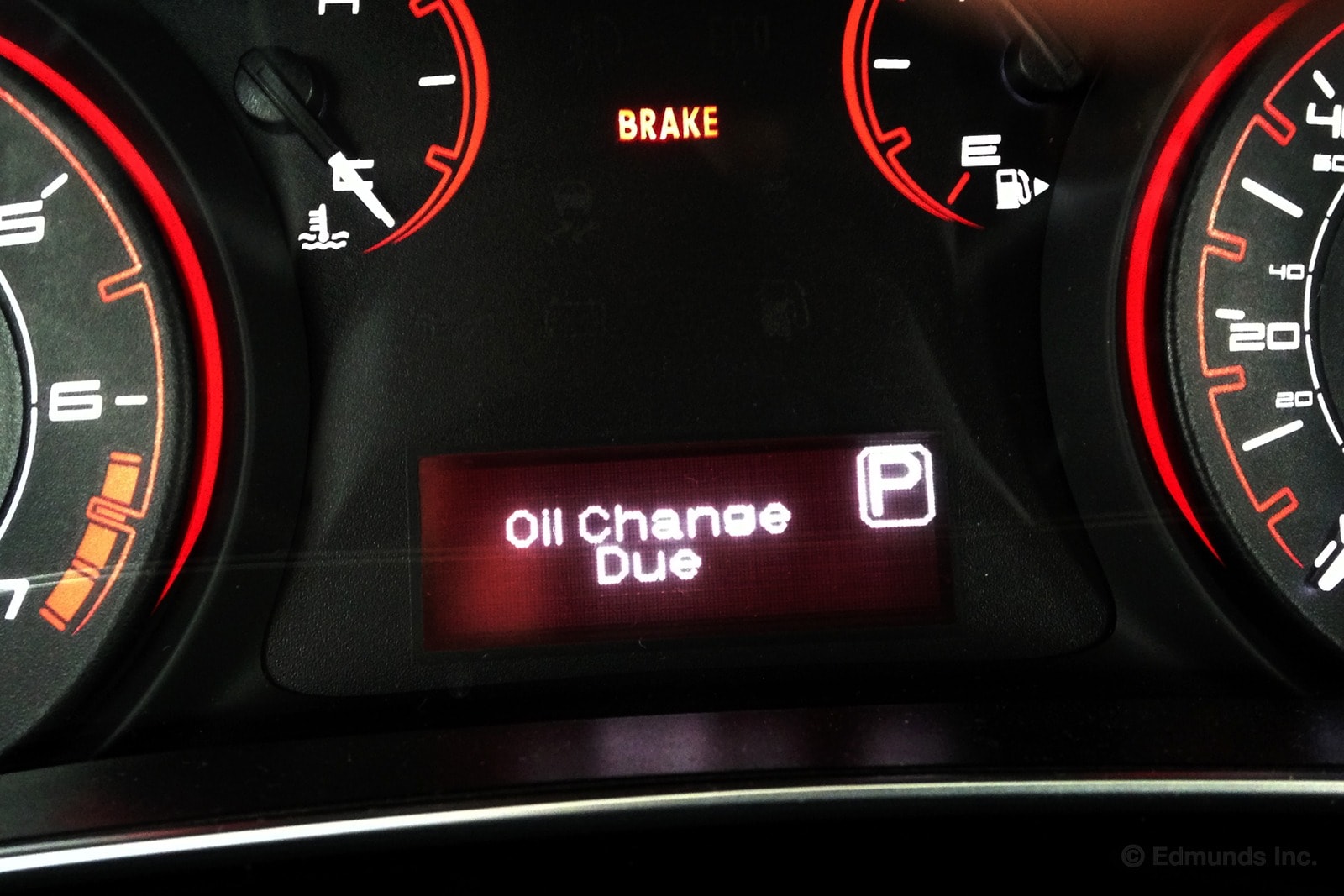
We're approaching 18,000 miles and the 2013 Dodge Dart is barking for oil. We last changed it at around 10,000 miles. That's a longer interval than most purists would tolerate, but not unusual among new cars that can go up to 15,000 without an oil service (our former Jaguar XF). I'm no purist, but even that interval seems a little long for a turbocharged engine.
Apparently, the Dodge Dart will throw up an alert anywhere between 6,000-8,000 miles depending on how hard the car's sensors judge the car has been driven. Clearly an exact science, then.
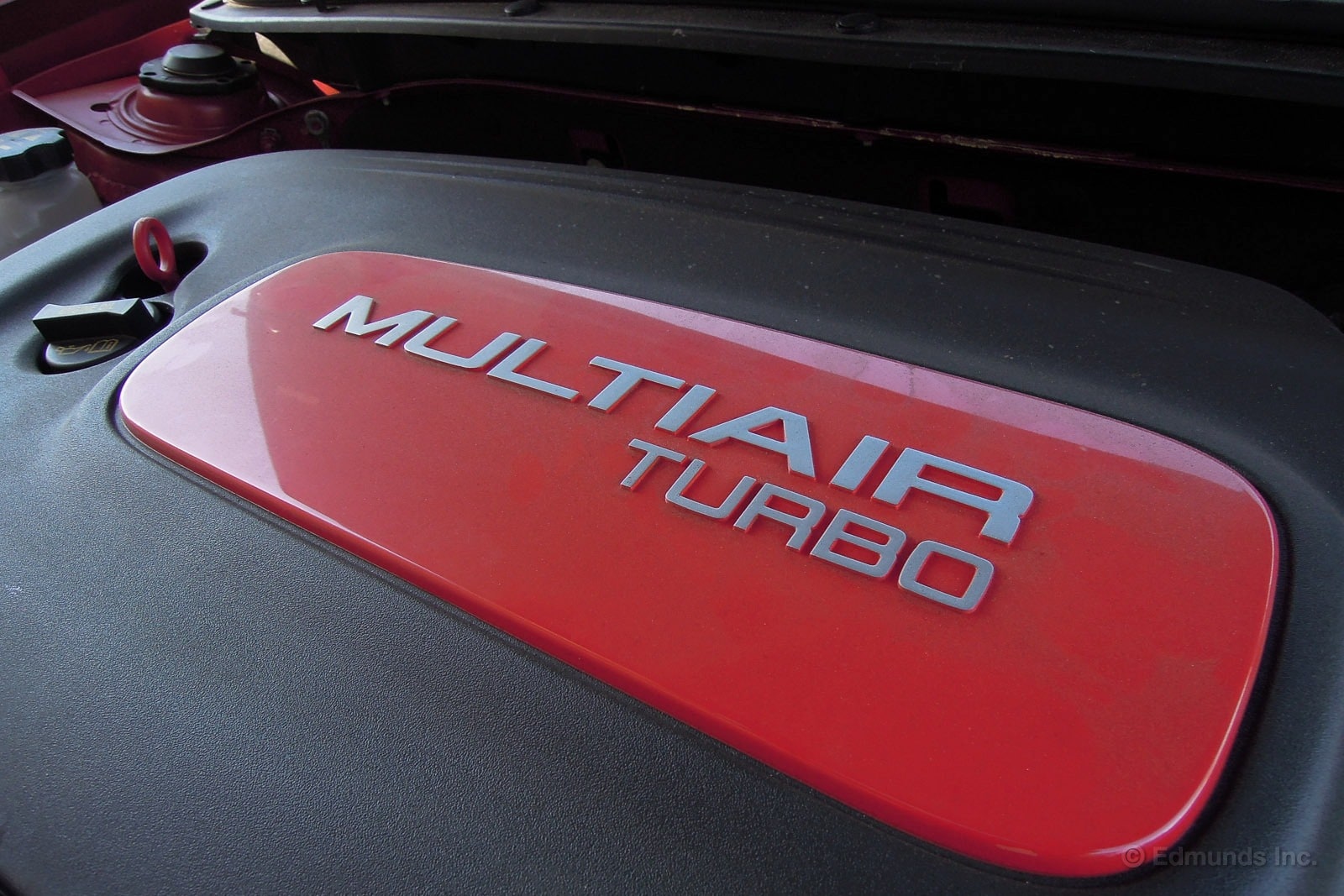
The "Oil Change Due" indicator came on recently on our 2013 Dodge Dart as Dan mentioned. So I made a service appointment at my local Dodge dealer.
In this case, it was Fresno Chrysler. The overall experience was pleasant and quick enough, and perhaps a little more worldly that I might have expected. Since the dealership has a Fiat component as well, there was an interesting mix of Jeeps, 500s, minivans and some Dodge Challengers and Chargers.
Total cost was $56.46 for the oil change. In hindsight, I think we should have had a tire rotation done as well, but my service advisor didn't mention it and it didn't occur to me at the time. But that should be easy enough to remedy.
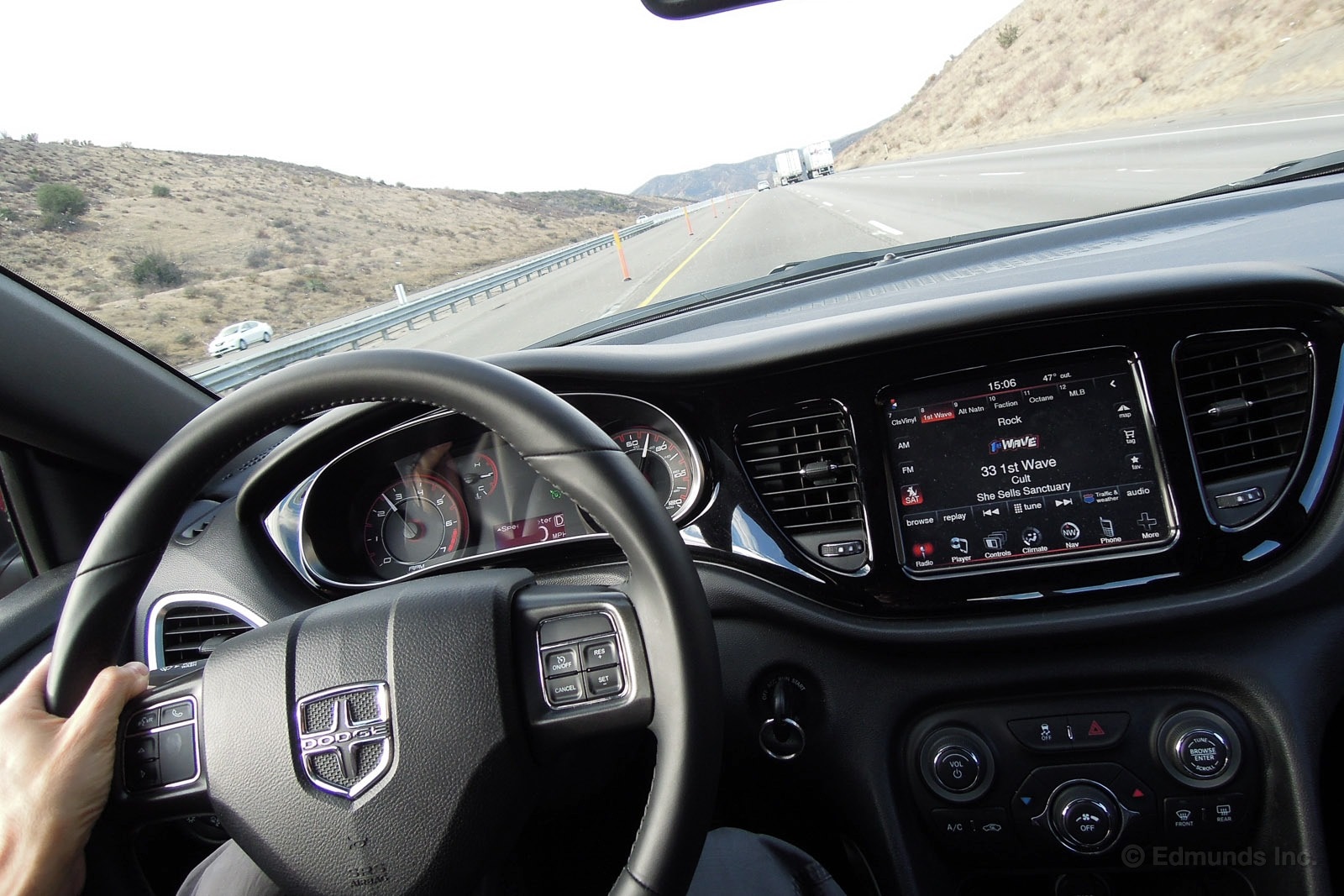
I do like our 2013 Dodge Dart. But I have to be honest. If I were buying a small sedan today, the Dart wouldn't top my list. The variety of negative points we've covered in our updates this year so far would keep me from making a purchase. But I also think the future could be bright for Dodge's small sedan.
The Dart has a lot of inherent goodness baked in. It looks sharp, it's pretty roomy and both fuel economy and performance can be respectable depending on what engine and transmission you get. The available big touchscreen interface is also one of the best you'll find in this segment.
Going forward, hopefully Dodge can work on the car's refinement and reliability. Having read through the consumer reviews of these first-year 2013 Darts, these would seem to be the notable issues for a lot of owners as well.
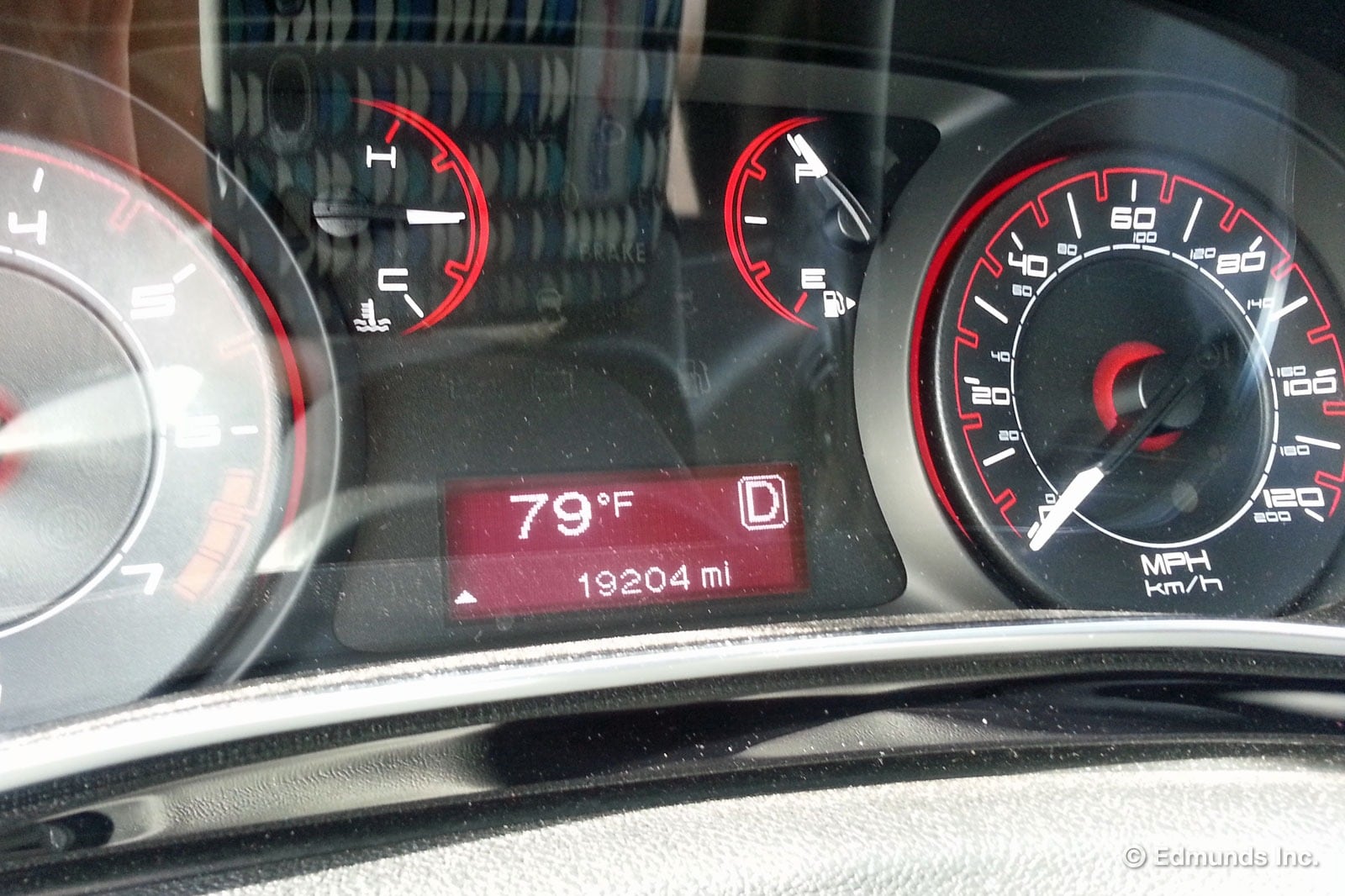
Here's one for you folks suffering through the winter storm blues. Not only is it sunny and 79 degrees here in Southern California, our Dodge Dart reports the high ambient temperature in an extra-large font.
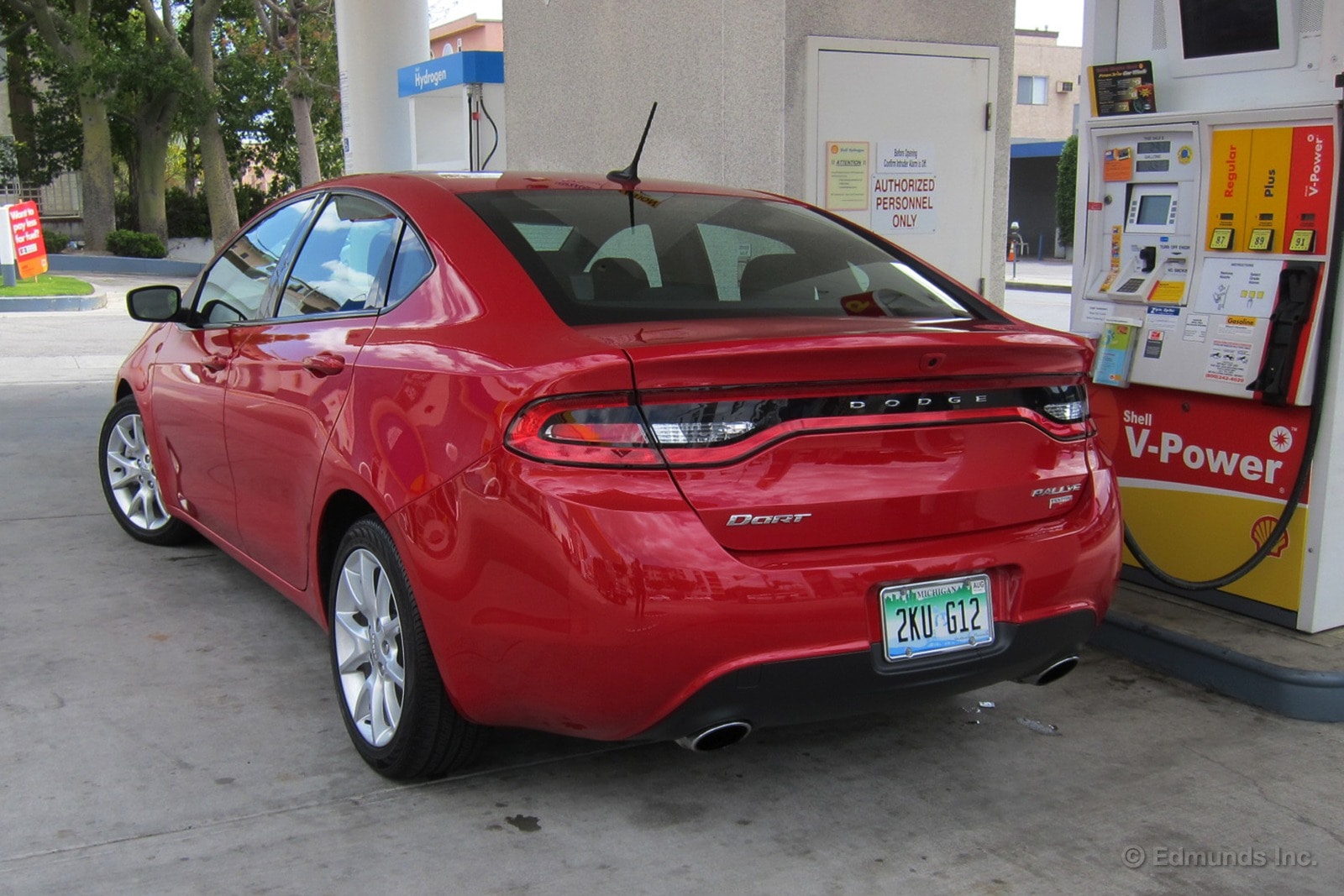
We added about 2,100 miles to our 2013 Dodge Dart before the year's end. We were looking to add about another 300 to push the odometer past 20,000 miles, but our time with the Dart came to a sad, abrupt end (more on that in a follow-up post).
We averaged 30.4 mpg for the month, aided by some long-distance miles to Reno, Nevada, as a pick-up/chase vehicle for our recent CL65 purchase, as well as a one-way trip to San Francisco. That's 1 full MPG better than we averaged last month, but still just short of the EPA combined average estimate of 31 mpg.
Our average lifetime MPG also slipped one-tenth this month, down to 27.7 mpg.
Worst Fill MPG: 16.8
Best Fill MPG: 36.6
Average Lifetime MPG: 27.7
EPA MPG Rating: 31 combined (27 City/37 Highway)
Best Range: 506 miles
Current Odometer: 19,683 miles
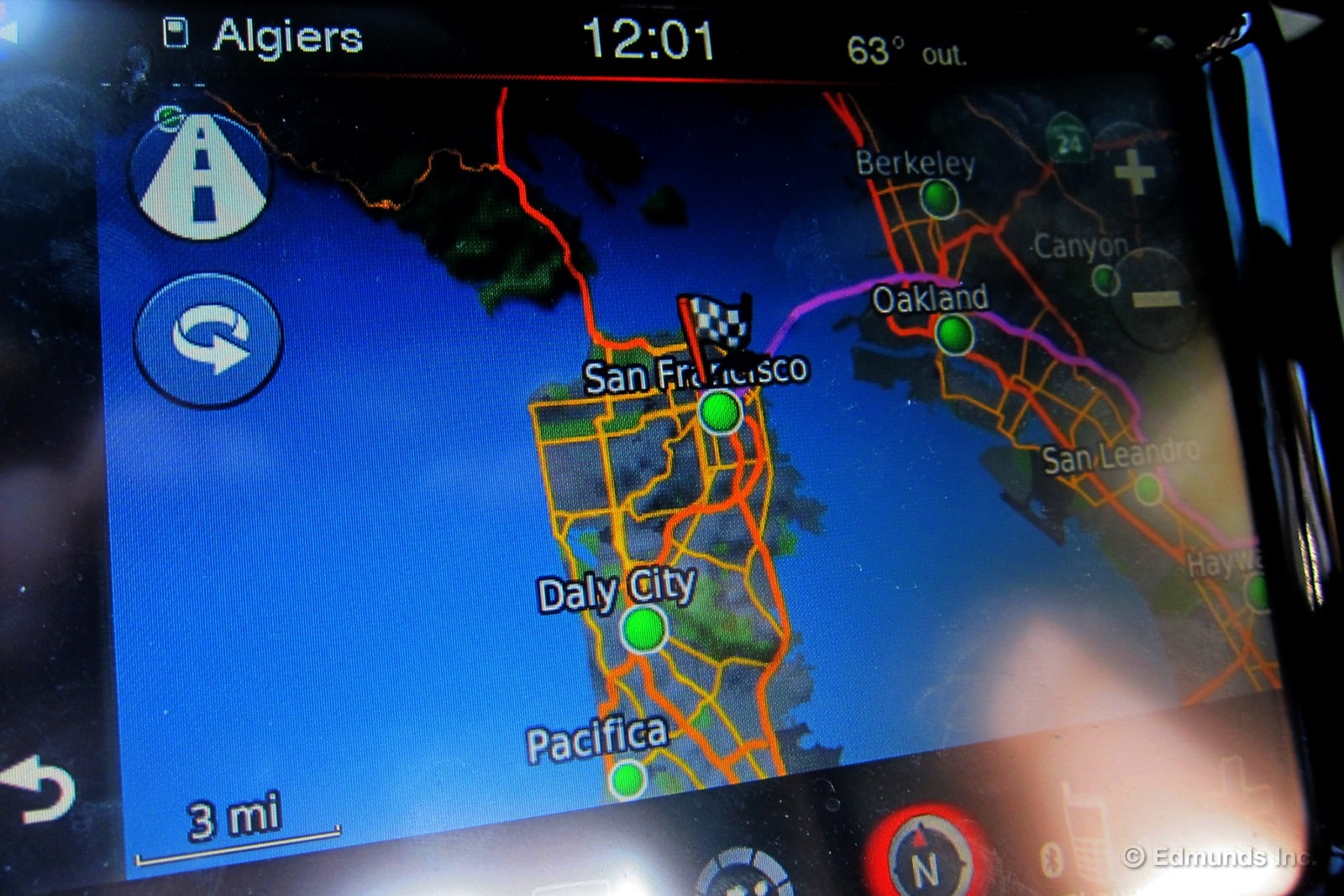
It's always a fun day when you start driving for the Bay.
I was getting a late start on my weekend plans in San Francisco, but figured with some luck, I'd be in the city by 7:00 p.m. I'd take the lazier US-101 route on the return trip, but I needed to make time on the arrival leg. The nav system chose the usual, technically shortest route across the East Bay into the city, but the Bay Bridge on a Friday night is no joke. Instead, I chose my preferred route up Interstate 5, west across Highway 152, then US-101 up through San Jose and Silicon Valley.
I made good time out of Los Angeles. I had an open sunroof, trail mix and jerky, and loaded playlists. Our 2013 Dodge Dart would be fine carriage for the 800-some round-trip miles. Once in the city, I'd park the car until Sunday afternoon.
Trouble began near Kettleman City, about halfway through the route in western California's agricultural badlands.
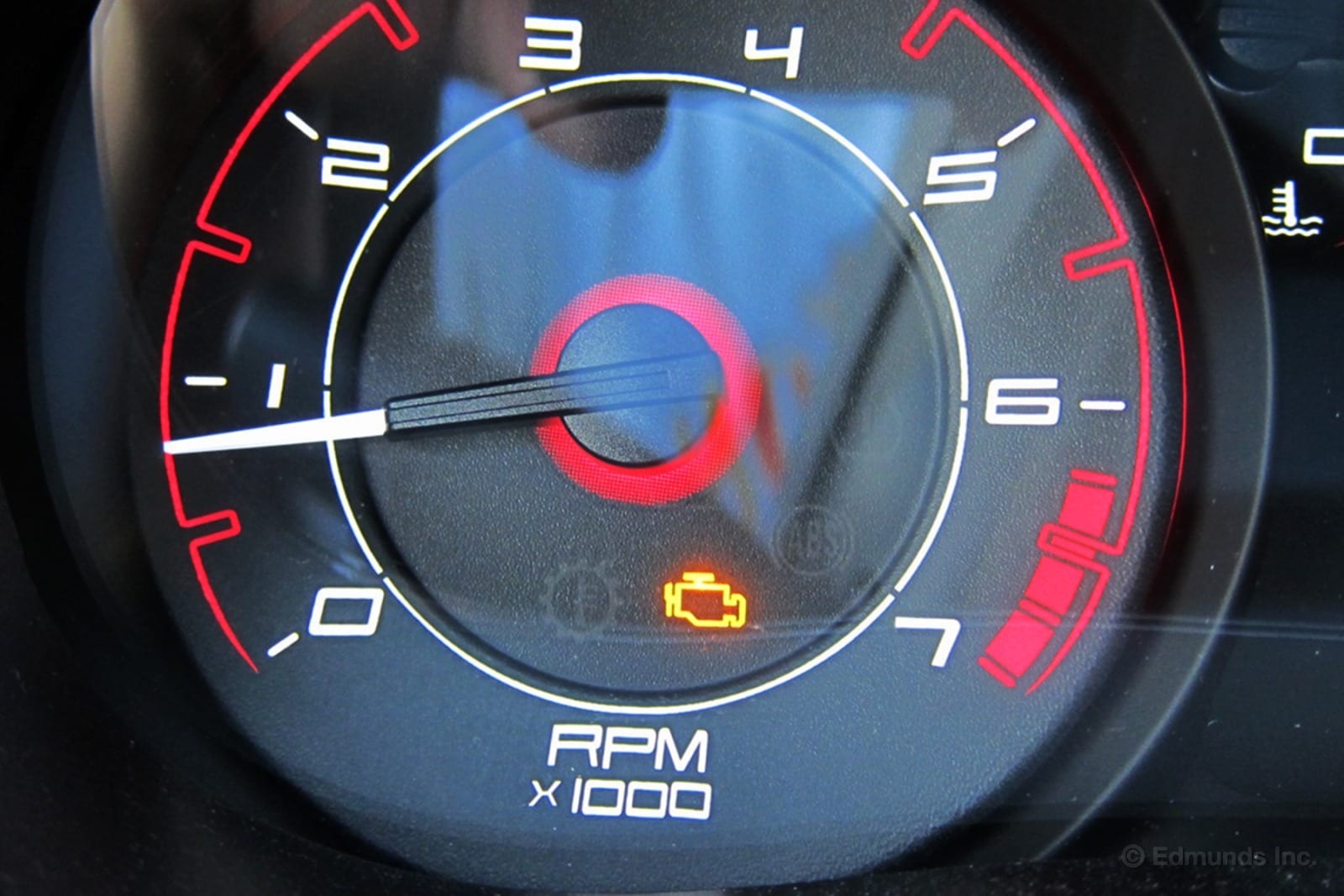
Dipped my foot into the throttle in sixth gear to pass a rig and felt the first hiccup. As revs built, it felt like a fuel cut, maybe a slipping clutch. When I had space again, I was able to replicate it. Cruising was fine, however.
I was on the phone with my Mom, giving her the CliffsNotes on the Dart and its current relationship to Fiat. She made the predictable reference familiar to those old enough to remember the Italian automaker's reputation in America: Fix It Again, Tony.
That must have hurt the Dart. Shortly after we shared the joke, no more than a few minutes later, the car threw a check-engine light. I accelerated to see if the problem persisted and it did. The next off-ramp was about a mile ahead. Call ya back, Mom.
Gliding to the off-ramp was no problem, but accelerating from the stop sign at the bottom was exciting. The Dart spun, sputtered and creeped its way to the nearby gas and fast-food plaza. I opened the hood and, yep, something smelled crispy. No oil spray anywhere, oil level was fine. Not brakes. Clutch? Maybe.
I tried re-booting the Dart. Let it sit, did the door lock/ignition cycling. CEL remained on. Let's see how bad this really is. Drove it around the back of the strip mall and it struggled to reach 25 mph. Drove it back out on to the road toward the on-ramp, but the sputtering shook my confidence in the Dart's highway worthiness. I made a U-turn back to the Burger King.
I sat there for a few minutes considering my options. I could leave the Dart and try to fetch a rental from a nearby town. I could call AAA or Chrysler's roadside assistance. This diagnosis was beyond my limited mechanical knowledge and I leaned on dual theories of a fuel delivery problem or impending transmission failure. Maybe a tech could come out with a scan tool, re-boot the ECU and offer a worry-free explanation.
More likely, they'd hitch the Dart to a tow hook and head for the nearest garage. At 4:30 p.m. on a Friday, I wasn't hopeful for a quick fix. At this rate, I'd almost resigned to missing the first of two concerts I'd planned this trip around. San Francisco was still more than 200 miles away.

After 20 minutes of indecision, I made up my mind. Our 2013 Dodge Dart would get me to San Francisco or I would abandon it on the roadside trying. After slipping, sputtering and smelling of burnt something, I pulled the Dart off the highway several miles from Kettleman City, an interstate outpost town in California's San Joaquin valley.
The problem started with what felt like a fuel interruption during a sixth-gear pass on a semi. Not much later, the check-engine light illuminated, and the Dart starting skipping a beat and losing power in its lower gears. After letting the powertrain cool, checking fluids, flipping through the manual, cycling the ignition, and repeating incantations to the guardians of road trips, I drove the Dart gingerly around the back of the strip mall where I'd parked. It struggled with acceleration through the first three gears, but seemed to hook up in fourth.
I made a furtive pass at the interstate on-ramp, but chickened out and U-turned back to the gas-and-snack complex. The car just didn't feel highway worthy. But after several more minutes of internal debate, more looking and sniffing around under the hood (something was smelling burnt, but I couldn't pinpoint the source or smell), and generally pretending my mechanical theories had validity, I had to do something. And that something was not waiting for a tow truck and a rental car to get me the rest of the way to San Francisco.
The Dart chugged up the on-ramp like an old Beetle and fortunately there was no semi closing in from behind. The car brightened up in fourth and fifth gears, feeling fairly normal and linear in its power delivery, but again bogged and sputtered in sixth. I resigned myself to fifth gear and the slow lane for the rest of the trip to the city, about 200 more miles.
This was a decent enough strategy for the remainder of Interstate 5's flat stretch. But the more winding elevation changes of Highway 152 required constant rowing of the manual-shift function and trying to stay in what remained of the powerband. Then there were the stoplights at the junction of the 152 and US 101 highways. Would the Dart die? Would it even accelerate from a dead stop?
It didn't die. Idle was anemic, but it didn't die. And pulling away from the stop was slow enough to frustrate the following car. But once on the 101 freeway, the Dart returned to long highway form. I worried about hitting stop-and-go traffic coming into town, but the final test would be the hills and stoplights of the city itself. By then, if the Dart died somewhere on 5th Street, I figured I could at least walk to my hotel.
The end was anti-climactic. Traffic coming into the city was light and soon enough I was off the freeway. Leaving from a few signals on inclines provided moments of soft prayer, but the Dart made it to the Sutter and Stockton parking garage seemingly no worse than when the problems began. I made it to my hotel with about an hour to spare before the event I'd come for. I actually had to pat the Dart on the dashboard. Even as wounded as it was, it got me there.
The cause I found out later was a misfire. There was a problem with a spark plug ceramic which would prevent the cylinder from firing. And the smell was unburnt fuel meeting an overheated catalyst, despite the fact that Chrysler does protect the catalyst by turning off the fuel to the misfiring cylinder if the temperatures get too high.
Wrap-Up
What We Got
A new 2013 Dodge Dart started at a competitive $15,995. After a score of options, our Dart SXT Rallye had an MSRP of $25,385. Here is how it added up.
First, we chose a trim level. The SXT offered 17-inch wheels, fancier cloth seats, a split-folding rear seatback and improved instrument panel display. The Rallye trim tacked on foglamps, a leather-wrapped wheel and unique trim pieces. Optional equipment included the Uconnect 8.4-inch display screen ($495), Alpine stereo ($495), satellite radio ($195), sunroof ($895), racetrack rear lights ($225) and an assortment of interior extras, dubbed the Popular Equipment Group ($295).
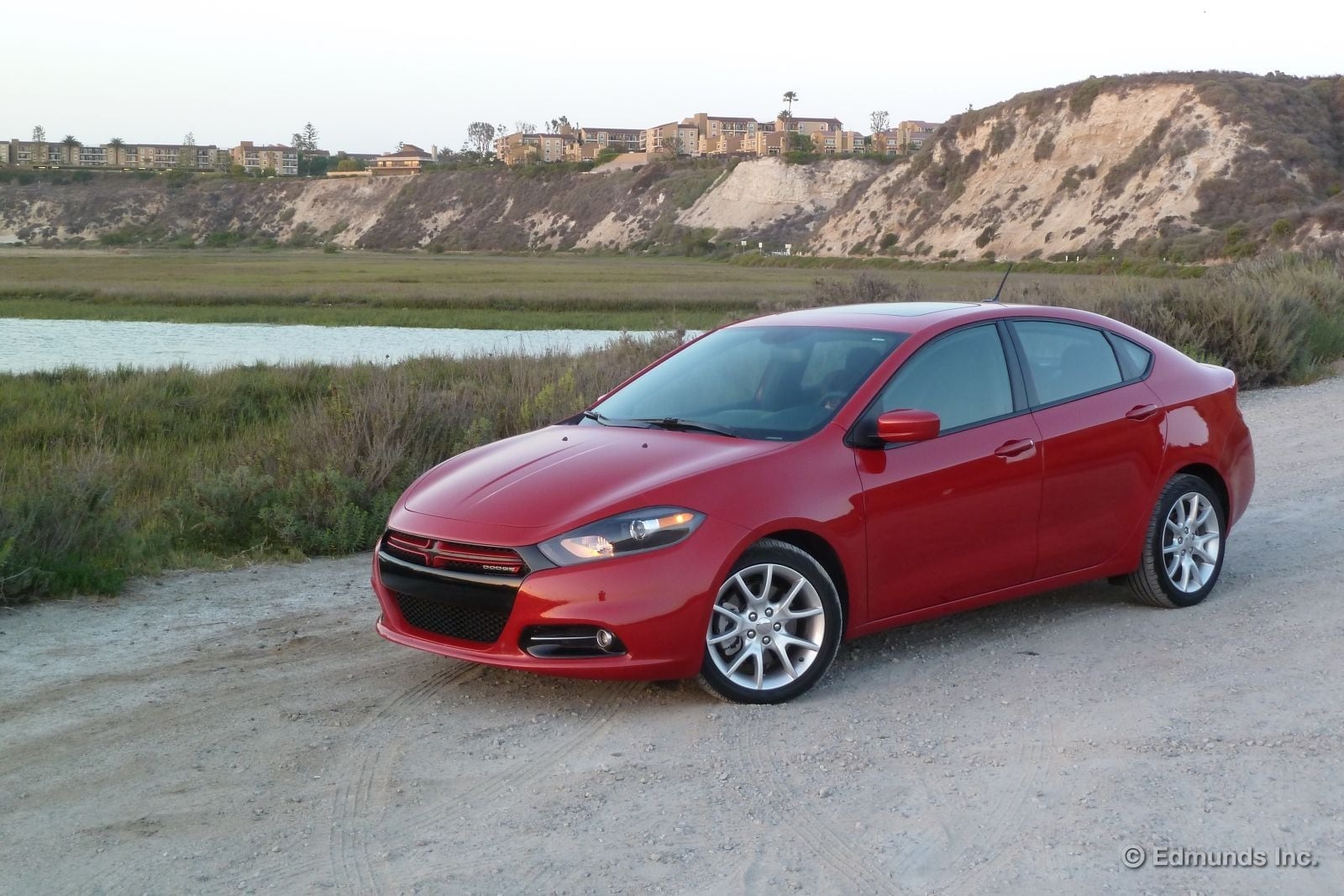
Finally, we upgraded the standard 160-horsepower, 2.0-liter engine. The optional 1.4-liter MultiAir engine was turbocharged. While it produced the same horsepower as the 2.0, torque was increased by 40 pound-feet, for a total of 184 lb-ft of torque. Paired to the 1.4 was a six-speed automated manual transmission, or DDCT (dual-clutch dry transmission) in Dodge-speak.
Dodge agreed to loan us the car for a year.
Our Impressions
"Last week I took my only real long drive in our long-term Dart.... The Dart was unexpectedly serene at highway speeds. Neither wind noise nor tire noise is especially noticeable at 70 mph on the highway. For its class, the Dart is acceptably quiet in my view. To my ears, engine roar is the biggest contributor to cabin noise, and it's really only an issue when you ask the turbo 1.4-liter to dig deep for a passing maneuver on an uphill grade. I like small, turbocharged engines, but the Dart might just be too big and heavy to use an engine this small." — Erin Riches
"Our Dart is equipped with the optional automated manual transmission. Chrysler calls it DDCT (dual dry-clutch transmission). It is the sole gearbox available with the 1.4-liter turbo engine other than the row-it-yourself manual. And it is... how do you say... not good. It's down to its molasses-slow (albeit very smooth) shifts and an easily confused calibration.... If you floor the gas, you're waiting a good couple of one-thousands until it finally realizes, 'oh, you wanted to go?' and goes on safari to hunt down a suitable cog. And it gets tripped up easily in conditions that involve slowing down and then briskly speeding back up. Taking matters into your own hands by slotting the lever into Manual mode doesn't solve it, either. Too slow to respond to commanded shifts, and then you still have those belabored gearchange speeds. It is unfortunate that the gearbox tends to overshadow the things the Dart does well." — Jason Kavanagh
"After my first night in our long-term Dart... I had the same reaction as Jay and James. This transmission simply doesn't feel well calibrated to the engine. This small-displacement turbocharged engine needs revs to make decent power. But between the transmission's early upshifts and slow gearchanges, it's hard to stay in the power.... Now four days on, I feel like I've made peace with the drivetrain's peculiarities and, overall, the experience isn't any worse than a commute in our CVT-equipped Subaru Impreza. Honestly, once you're up to 70 mph, the Dart feels better than our Impreza, because its engine has more midrange torque, so once you coax the transmission into the right gear, executing a passing maneuver is pretty much turnkey." — Erin Riches
"It's been about nine months since I've driven our 2013 Dodge Dart. After having not been in it for so long, it was interesting to get reacquainted with Dodge's compact car and see if any of my impressions would be different. Certainly the car's styling continues to be one of its top attributes. Some cars lack luster with familiarity. But looking sharp and purposeful without being overdone, I think the Dart's appearance will have some legs for years to come. One other thing that struck me was how well the touchscreen electronics interface works. Here, I think I had just forgotten a little. But having driven a lot of other cars in the intervening months with less-than-stellar touchscreens, the Dart's really stood out to me. It's quick to respond, easy to use and arguably the best interface you'll find in this class." — Brent Romans
"Pretty laggardly acceleration off the line. Not sure if it was more turbo lag or a hesitant dual-clutch transmission.... The slow upshifts come at 6,000 rpm. There's lag with each shift until the tach gets to 4,400.... Decent steering effort, although there isn't a ton of actual feel. What's cool is that the Dart responds well to throttle changes, although it's difficult to say fully to what extent because the ESC system spends a lot of time grabbing the brakes.... The Dart gets around the slalom cones reasonably well considering the soft suspension and large amount of body roll." — Mike Monticello
"After commuting to work in the Dart for the better part of a week, I think it lives up to that big footprint. Specifically, it rides like the small midsize car that it is and feels substantial going down the road. Together, the suspension calibration and 225/45R17 Continental all-season tires strike a good balance between compliance and control. The Dart soaks up impacts neatly without resorting to the floatiness you get in some competitors. At the same time, it rarely crashes over ruts and it copes with the rain-grooved/washboard sections of the I-405 freeway without feeling busy. It reminds me a bit of our long-term Chevy Cruze in this regard, and I prefer it to our Subaru Impreza. Along with that, the Dart's cabin stays quiet over most pavement, which makes it easier to enjoy my commute. Honestly, there are now several cars in the economy sedan class that offer a serene ride, but it's nice to see Dodge paying attention to this detail because the Neon and Caliber were noisy and unpleasant on the highway." — Erin Riches
"I just can't get comfortable in our new long-term Dart. The first problem is the driving position. Our car's six-way manual, height-adjustable driver seat is mounted too high or rather, it does not go low enough. I cannot push the seat down far enough, which would not only grant my long legs sufficient room, but also extricate my noggin from its current location of 2 cm from the roof. However, even if the seat could in fact go down more, the steering wheel's positioning would remain an issue.... The wheel doesn't tilt low enough. Then there's the seat itself. See the area above the side bolsters? The outer areas bubble forward and push into my shoulder blades.... As such, I end up either hunched over while driving like my Aunt Dianne or setting the seatback to the full Fat Joe (lean back)." — James Riswick
"With their spongy feel and basic trim, the seats in our Dart don't look, or feel, like much at first. In fact, fellow editor James Riswick doesn't think much of them at all. Oddly enough, although I'm about as tall as James, I don't find the seat in the Dart uncomfortable at all. And this is after driving the Dart for consecutive days that had me in and out of the car on and off for hundreds of miles. The cloth-covered seats are definitely not what you would call firmly contoured. Sure, there are noticeable side bolsters, but they're not the kind you lean on through corners. No, this is more of what I would call a universal seat, one that trades precise support for general comfort. It's a tricky line to walk, but these manually adjustable seats do a good job of providing support without needing to be in the perfect position. I might change my mind after a longer trip in the Dart, but so far I don't mind these seats at all." — Ed Hellwig
"A compact car is not the ideal vehicle to take on a long-weekend road trip with four people and their stuff. And yet... the trunk proved to be suitably ample without the sort of bulges or intrusions that can make a cargo area less useful than its cubic feet would indicate.... As far as compact sedans go, the Dart was very impressive and I heard no complaints from my passengers." — James Riswick
"That's a five-and-a-half-foot tall box filled with brand-new brake lines.... Did I think it was going to Dart in the trunk of our long-term 2013 Dodge Dart? Nope. But then I remembered the sedan has a 60/40-split fold-down rear seat. I dropped the smaller section easily and slid the box in place. Trunk closed without issue and the car could still hold four passengers. Very cool." — Scott Oldham

"I'm not sure where a factory navigation system falls in the order of priorities for real-life economy sedan buyers, but the system in our long-term Dart SXT Rallye is excellent. The interface is a large, high-resolution, 7-inch touchscreen, and it integrates various different functions, including navigation, audio, phone, climate and myriad settings.... This screen has large on-screen buttons and they exhibit appropriate sensitivity to human touch.... Processing speed is lightning-quick for a nav system in a budget car. Keying in addresses takes very little time and then the system is quick to calculate a route to your destination. I'm averaging about 30 seconds from address entry to the start of voice guidance, which feels quicker than every other nav-equipped car in our fleet.... Once you're en route to your destination, the Dart's nav zooms in when it's logical to do so, showing you which lane you need to be in, where to turn, etc.... When you deviate from the selected route, the Dodge's system is quick to recalculate and doesn't keep insisting that you make a U-turn." — Erin Riches
Maintenance & Repairs
Regular Maintenance:
Routine service on the Dart was exactly that. The onboard monitor requested fresh oil at about 10,000 and 15,000 miles and averaged $54 apiece. We also had very favorable dealer service experiences.

Service Campaigns:
There were maintenance issues beyond the routine, as well. The windshield was replaced under warranty when it was deemed that the crack it had developed was stress-induced. At 11,000 miles the passenger-side front door handle came off in our hand. It was also replaced under warranty.
Two problems arose during our test, possibly related. One was a throttle malfunction that nearly stranded us on the highway. A key-off, key-on restart of the car reset this one-time hiccup. The second mishap also occurred along the highway. What turned out to be a misfire was a bit traumatic, and nearly stranded us between Los Angeles and San Francisco. But the Dart held on, limping to our destination safely.
Fuel Economy and Resale Value
Observed Fuel Economy:
EPA estimates for our Dart SXT Rallye were 31 mpg combined (27 city/37 highway). After 19,522 miles we averaged 28 mpg. In its best showing, the Dart put a total of 506 miles behind it on a single tank of fuel.
Resale and Depreciation:
The MSRP on our Dart was $25,385. By the conclusion of our test, Edmunds' TMV® Calculator valued the SXT Rallye at $16,345 based on a private-party sale. That equated to 36 percent depreciation from its original MSRP. For comparison, our 2011 Chevrolet Cruze depreciated 23 percent.
Summing Up
Pros: Roomy interior; plenty of trunk space; excellent navigation system; quiet at highway speeds; impressive range on one tank of gas.
Cons: Balky transmission too slow to choose gears; seat comfort varied by body type; depreciation was high.
Bottom Line: Simple controls, a spacious cabin and one of the best navigation systems in the segment make the Dart easy to like in day-to-day driving. A lazy transmission and a few minor maintenance issues were the only things that kept us from being more enthusiastic about the Dart overall.
| Total Body Repair Costs: | None |
| Total Routine Maintenance Costs: | $109.24 (over 12 months) |
| Additional Maintenance Costs: | None |
| Warranty Repairs: | Door handle replaced, windshield replaced |
| Non-Warranty Repairs: | None |
| Scheduled Dealer Visits: | 2 |
| Unscheduled Dealer Visits: | 2 |
| Days Out of Service: | None |
| Breakdowns Stranding Driver: | None |
| Best Fuel Economy: | 36.6 mpg |
| Worst Fuel Economy: | 16.8 mpg |
| Average Fuel Economy: | 27.7 mpg |
| True Market Value at service end: | $16,345 (private-party sale) |
| Depreciation: | $9,040 (36 percent of original MSRP) |
| Final Odometer Reading: | 19,522 miles |
The manufacturer provided Edmunds this vehicle for the purposes of evaluation.